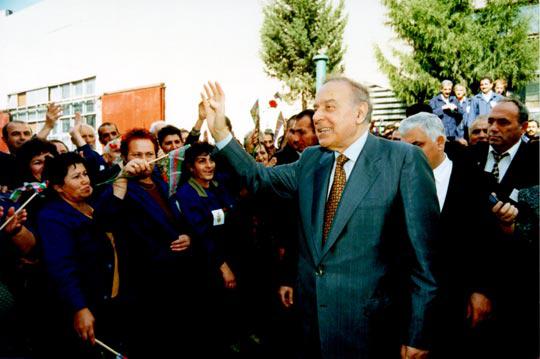
In 1991 the Azerbaijan Republic laid the foundation for the growth as an independent state. Turning a new page of its history, our republic made continuous efforts for the establishment of a democratic, legal and secular state based on national and humanitarian principles.
Since the first days of independence, the process of democratic and legal state development in Azerbaijan has faced various problems and obstacles. The republic faced a need to tackle problems resulted from ill consequences of the economic and political issues inherited from the Soviet totalitarian regime, Armenian separatism and military actions against Azerbaijan, sharp internal political confrontations and the danger of civil war, attempts of coup d’etat along with other severe political, social and economic problems and their implications.
Expressing the will of various circles of society and relying upon the determined support of the population the national leader Heydar Aliev made consistent efforts that created opportunities to halt the activities of the malevolent forces posing a threat to Azerbaijan territorial integrity and state independence. His leadership saved the republic from bloody civil confrontations and the danger of a complete collapse.
The return of Heydar Aliev to the leadership in Azerbaijan laid the foundation for the ideology based on such universal humanitarian values as independence, state formation, patriotism, justice, democracy, national progress, and secularity. Heydar Aliev’s internal politics was aimed at securing the right of any Azerbaijan citizen for freedom and stability. Among the leading priorities of the activities of the national leader was the implementation of economic reforms, the transition to a market economy, the foundation of economic development, integration of Azerbaijan into the world economy, privatization program, and implementation of agrarian reforms.
In the formation of civil society, political pluralism and accelerated development of the multiparty system plays a special role. The history of the independent development of Azerbaijan features the enhancement of political pluralism, the appearance of new political parties, and their increasing role in the state’s social and political life. This became possible due to the Azerbaijan state’s commitment to the creation of opportunities necessary for the activities of all political parties.
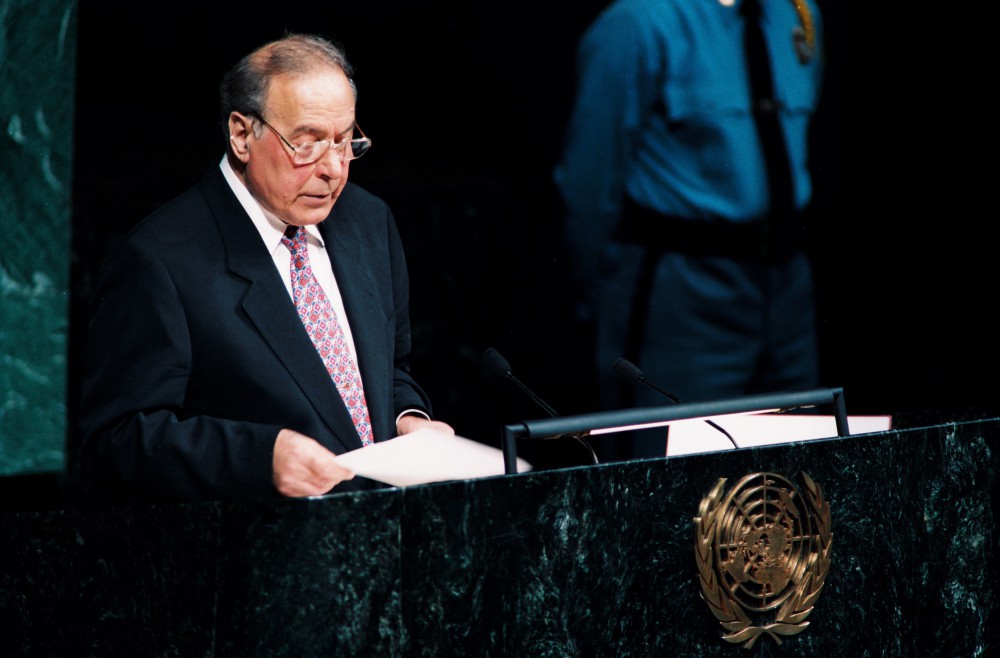
Protection of the freedoms of expression and conscience is an inseparable part of civil society formation processes. In the Constitution of the Azerbaijan Republic freedoms of expression, opinion and conscience are validly secured. The primary protectors of the freedoms of expression and information, recognized as the key attributes of democracy, political pluralism, and civil society, are mass communication media.
The decree « On the additional efforts in the protection of freedoms of expression, opinion, and information in the Azerbaijan republic » marked a new stage in the implementation of the state’s policy regarding the natural development of mass media and their dynamic transformation into a strong means of democratization. On the basis of the decree, the Chief Agency on the Prevention of State Secrets Spread to the Press and other Mass Communication Media at the Cabinet of Ministers was forfeit, and both the decree from 16 April 1992 on the introduction of military censorship and the decree from 15 April 1993 on the regulation of information spread was made void.
Like in the other fields, reforms of science and education have started since the second half of 1993.
After the historical return of Heydar Aliev, the elaborated and implemented policies aimed at the restoration of education facilities into normal operational mode, the transformation of education into the key attribute of the national progress, and the elaboration and implementation of the program regarding fundamental reforms in the area. In March 1998 the national leader signed the decree « On the establishment of State Committee on educational reforms in the Azerbaijan Republic »
One of the most fundamental innovations in general education was the transition to a new alphabet based on Latin symbols.
Azerbaijan National Academy of Sciences is a member of the International Association of Academies of Sciences founded in 1993 in Kyiv.
One the basis of the national leader Heydar Aliev’s decree from 15 May 2001 the Academy of Sciences was named Azerbaijan National Academy of Sciences marking the achievements of the academy in the development of our science, its role in Azerbaijan nation’s cultural and spiritual progress, its significance in the social life of the republic and the status of academic science as one of the guarantees of the state development.
In the years of independence, the Ministry of Health also underwent consistent and expedient reforms. At the first stage, most of the attention was focused on the improvement of the legislative framework of the public health care system to meet world standards.
One of the key achievements in the area of public health system reforms was the onset of private medical care. The legal and normative framework was developed in this area and the law « On the private medical services » was enforced.
Azerbaijan’s re-attainment of independence enabled the sovereign country to integrate into the international sphere, express its opinions on various current events, be represented in international organizations, and participate in those organizations’ authoritative meetings.
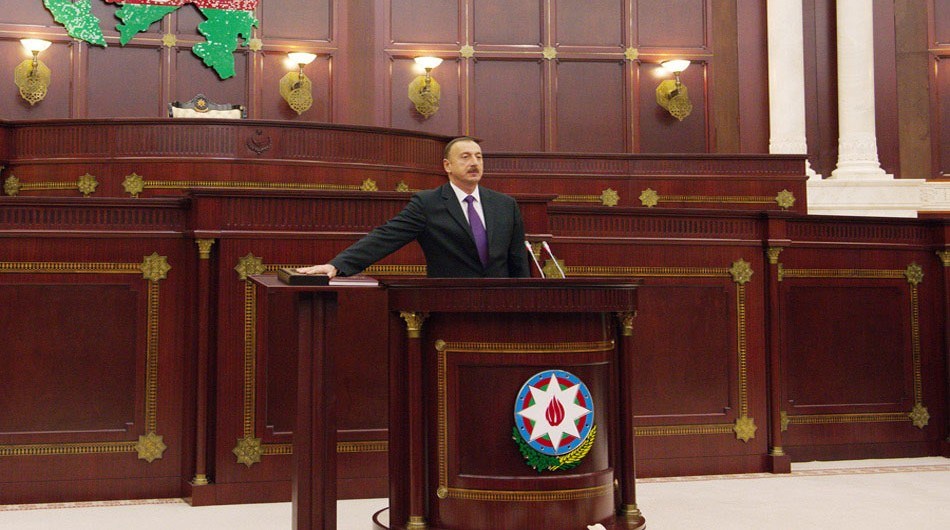
Azerbaijan was granted an opportunity to enter the international arena in various fields, including sport. Our sportsmen started participating in the World and European Championships under the flag of their country.
The contribution of the state to the development and brilliant accomplishments of sport, physical culture, and Olympic Movement, the areas with the key role in upbringing of physically and mentally healthy generations, fostering patriotism, the wider introduction of our republic at the international level, and the increase of its influence, is invaluable.
In the last years, with the purpose of the development of youth policy and modern youth movement sufficient works have been conducted at the state level to facilitate the establishment and operation of non-governmental children and youth organizations and implementation of relevant programs, with the legislative framework in this area also being improved.
The increase in the number of political parties, unrestricted operation of social organizations, elimination of censorship, the unrestricted publication of hundreds of titles, development of private radio and TV channels, political pluralism, freedom of opinion, democracy and civil society is in our country are evident.
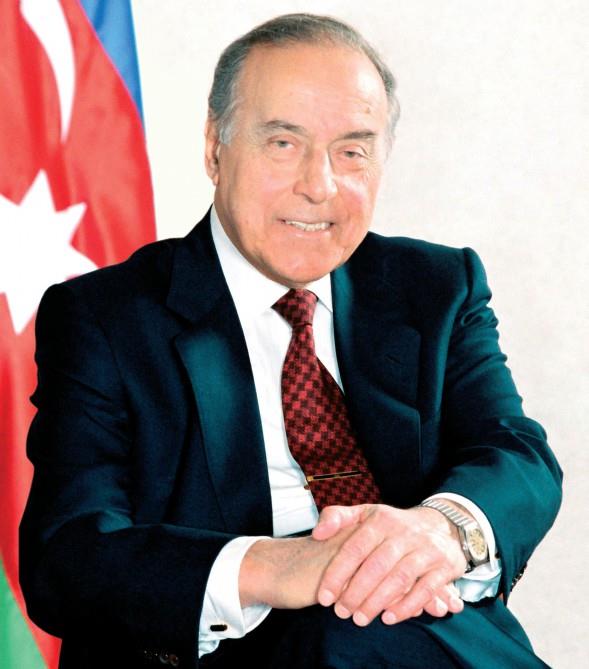
Heydar Alirza oglu Aliyev was born on 10 May 1923 in the city of Nakhchivan of Azerbaijan. In 1939, after graduating from the Nakhchivan Pedagogical School he studied at the architectural department of the Azerbaijan Industrial Institute (now the Azerbaijan State Oil Academy). The incipient war impeded to complete his education.
Since 1941, Heydar Aliyev heads the department at the People Commissariat of Internal Affairs of Nakhchivan ASSR and in 1944 was sent to work at the state security bodies. Heydar Aliyev, working since that time in the security bodies, since 1965 held the post of deputy chairman, and since 1967 — chairman of the Committee of State Security under the Cabinet of Ministers of Azerbaijan Republic, and he was conferred the rank of lieutenant general. In these years, he received special higher education in Leningrad (now St Petersburg), and in 1957, he graduated from the history department of Azerbaijan State University.
Being elected at the Plenum of the Central Committee of the Communist Party of Azerbaijan in July 1969 as the First Secretary of the Central Committee of the Communist Party of Azerbaijan, Heydar Aliyev heads the Republic. In December 1982, Heydar Aliyev has been elected as an Alternate member of the Politburo of the Central Committee of the Communist Party of the Soviet Union, and appointed at the post of the First Deputy Chairman of the Cabinet of Ministers of the USSR and became one of the leaders of the USSR. During twenty years, Heydar Aliyev was the Deputy of the Supreme Soviet of the USSR and for five years was Deputy Chairman of the Supreme Soviet of the USSR.
In October 1987, Heydar Aliyev, as a sign of protest against the policy pursued by Politburo of the Central Committee of the Communist Party of the Soviet Union and personally the Secretary-General Michael Gorbachev, resigned from his post.
Inbound with the tragedy, committed on 20 January 1990 in Baku by the Soviet troops, appearing on the next day at the Azerbaijan Representation in Moscow with a statement, demanded to punish the organizers and executors of the crime, committed against the people of Azerbaijan. As a sign of protest against the hypocritical policy of the leadership of the USSR, in connection with the critical conflict accrued in Nagorny Karabakh, in July 1991, he left the Communist Party of the Soviet Union.
By return in July 1990 to Azerbaijan, Heydar Aliyev has lived at first in Baku, then in Nakhchivan, and in the same year, he was elected as the Deputy to the Supreme Soviet of Azerbaijan. In 1991-1993s, he held the post of Chairman of the Supreme Mejlis of the Nakhchivan Autonomous Republic, Deputy Chairman of the Supreme Soviet of the Republic of Azerbaijan. In 1992, at the constituent congress of the « Yeni Azerbaijan » Party in Nakhchivan, Heydar Aliyev was elected as the Chairman of the Party.
In May-June 1993, when, as the result of extreme tension of the governmental crisis, the country was on the verge of civil war and loss of independence, the people of Azerbaijan demanded to bring to power Heydar Aliyev. The then leaders of Azerbaijan were obliged to officially invite Heydar Aliyev to Baku. On 15 June 1993, Heydar Aliyev was elected as the Chairman of the Supreme Soviet of Azerbaijan, and on 24 July — on the resolution of the Milli Mejlis, he managed to fulfill powers of the President of Azerbaijan Republic.
On October 3, 1993, as the result of nationwide voting, Heydar Aliyev was elected as the President of the Azerbaijan Republic. On October 11, 1998, having garnered at the elections, passed in high activeness of the population, 76,1 percent of the votes, he was re-elected as the President of Azerbaijan Republic. Heydar Aliyev, giving his consent to be nominated as a candidate at the 15 October 2003 presidential elections, Heydar Aliyev relinquished to run at the elections in connection with health problems.
Heydar Aliyev was conferred a number of international awards, the title of an honorary doctor of numerous countries, and other high honors. He was conferred five times with the Lenin Order, the Order of Krasnaya Zvezda, and many medals, and twice Hero of Socialist Labor was awarded by Orders and medals of many foreign states.
The historical destiny of Azerbaijan, covering the period of over the thirty latest years, was inseparably linked with the name of Heydar Aliyev. The revival of the people during these years in all spheres of its socio-political, economic, and cultural life is connected just with his name.
During the said period of his leadership, Heydar Aliyev helped his native land Azerbaijan, the progress that he persistently strived towards, the rich culture, great historical past with which he was proud of, and on the coming generations on whom he was concerned, to overcome as a state heavy and sharp ordeals of time.
Being an outstanding politician and statesmen, indisputable leader of the nation, he was a live legend, and therefore the Heydar Aliyev phenomena always attracted attention, the admiration rising political activity of this nationwide leader of the Azerbaijanis of the world was widely covered both in the Republican and world press.
In June 1993, when the people of Azerbaijan believed that the national statehood was on the edge of fall when there began the hardest days, it insistently demanded a change of the existing power, and since that time relied its destiny on Heydar Aliyev. Heydar Aliyev, seeing the misfortune of his nation, accepted the invitation and returned to great politics in Azerbaijan. The people met the return of Heydar Aliyev with hope and joy, and this day went down the history of independent Azerbaijan as the Day of National Salvation.
In the late 1960s, during his first assumption of power, Azerbaijan was experiencing a period of economic and cultural fall as well. At that time, just with coming of Heydar Aliyev there was observed intensive rise in all spheres of the life of society, development of national spirit and progress of morality.
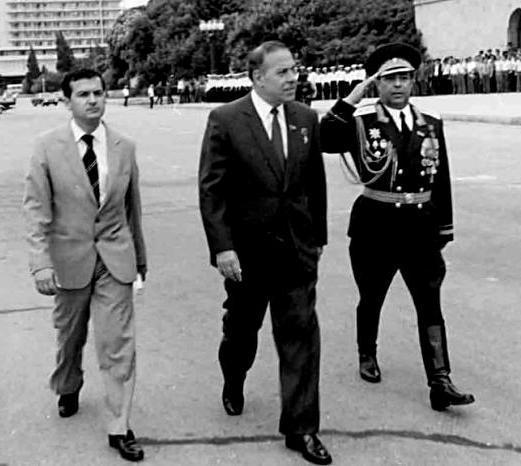
After return to power, Heydar Aliyev, due to his political ability could salvage the country from the threat of civil war, socio-political separation, and, embodied in him, in his strong personality the goal and idea of the society, he could unite his native people around common ideology, instil in it the sense of trust in morrow.
During these years, just Heydar Aliyev, as a true leader, could resolutely bring to the notice of world the truth on Azerbaijan. Only after the return of Heydar Aliyev to power, Azerbaijan could realize its geopolitical opportunities. Due to the political talent of Heydar Aliyev, the threat of isolation of Azerbaijan from the world community was overcome.
Head of Azerbaijan always distinguished with his word, authority, and influence from the standpoint of the impact on the processes proceeding on the world political arena. Inexhaustible energy of Heydar Aliyev, deserving nationwide love, inspired the people for new successes.
Thanks to the bright political talent of Heydar Aliyev — one of the historical personalities of Azerbaijan that in the junction of the two centuries and two Millenniums, preserving its national-moral values, confidently stepped down the Third Millennium. Having overcome all the obstacles, and despite the difficulties, the talent of Heydar Aliyev helped Azerbaijan to survive in the upheavals of the extremely complicated time and hold a worthy place both in the region and in the whole world.
Heydar Aliyev, as one of the unique statesmen of our people, along with his complicated life always thought on the people and Motherland. His heartbeat in the name of strengthening the independence of Azerbaijan, for the happiness of his nation. As the head of state, Heydar Aliyev, in the most complicated time for Azerbaijan showed unprecedented selflessness in the name of its salvation, could save his country from misfortunes.
Due to a number of unique nature-gifted features, Heydar Aliyev, as a farseeing personality, could foresee the course of the historical events, demonstrated a truly patriotic position while adopting decisions with extreme significance for the national history, could undertake resolute actions. The resoluteness, peculiar to his personality, often found its reflection in the ideas, extemporized during his appearances before the audience. Reports and speeches of Heydar Aliyev, which, being founded on iron logic, had an extraordinary impact, are a bright expression of the depth and width of his philosophical and political vision.
As head of the Azerbaijani state, President of the Republic of Azerbaijan, Heydar Aliyev holds an exceptional position in the centuries-old history of our statehood. Heydar Aliyev’s activity, from the point of view of its significance, goes far beyond the borders of Azerbaijan. The processes, proceeding currently not only in Azerbaijan and but also in the entire post-soviet space, as well as in the world, cannot be presented without the personality and activity of Heydar Aliyev.
The period covering over 30 years of state-building, economic rebirth, political consciousness, political life in modern Azerbaijan, is connected with the name and practical activity of Heydar Aliyev, with an inexhaustible talent, encyclopedic knowledge, large world vision, being a historical personality, prominent politician, and concrete deals realized by him. These complicated processes were reflected in his practical activity and philosophic ideology — the philosophy of national revival.

Heydar Aliyev was a great philosopher and thinker of the present. The philosophy of Azerbaijanism, founded and developed by him, determined the special role of Azerbaijan in the present world, rests on the basis of national statehood, created a firm base for the solidarity of the World Azerbaijanis. The problems of national revival, which in the last century seriously worried the Azerbaijani intelligentsia, thanks to Heydar Aliyev, in these years, turned to strategic state policy, from the science, sociology, and philosophy — to a practical and political plane.
Thanks to his bright political wisdom and talent, Heydar Aliyev created a new Azerbaijan, its current realities, and defined the path leading to the future. Just, therefore, the period of the history of Azerbaijan from 1969 up to date was closely connected with the name of Heydar Aliyev and went down our history as Heydar Aliyev’s epoch. The major content of this epoch, from the standpoint of the further historical destiny of Azerbaijan, is Azerbaijanism.
Path of Azerbaijan leading to the construction of an independent state, in essence, started in 1969 — after his coming to power. In this sense, the brightest pages of Azerbaijanism were written just in these years. In the frame of the then ideology, Heydar Aliyev could — let it be even in the form not contradicting the existing system — not only prevent full oppression of the national spirit of Azerbaijan, on the contrary, but also make maximum use of the opportunities on the way of his raise.
In this sense, the next period of coming by Heydar Aliyev to the leadership of the Republic is perceived as the start of the national self-consciousness, return to the origins. The major ideological-political trend of the philosophy of Heydar Aliyev management, history of which just begins from this period, contains the large extent of all forms and means of the national self-expression of the people, strengthening the sense of national pride and realization of quick strategy pf development, able to raise the national conscience. Since the beginning of his leadership in the Republic, it became a tradition to regularly celebrate the jubilees of the prominent personalities of Azerbaijan, which created a foundation to raise the national spirit, national self-conscience, closely connected with the nationwide problems of the Azerbaijani people, returning to the people its historical memory, the realization of the idea of independent statehood.
The work carried out by Heydar Aliyev while leading Azerbaijan in 1969-82 released national self-consciousness from the fetters of previous ideological system and ensured boundless rising of national sprit on the base of such fundamental principles as giving historical memory back to the people, and created favourable conditions for the idea of national statehood our people had been maturing for many years to turn into the great driving force.
Coming to power in Azerbaijan, which because of being attributed to one of the USSR’s provinces, was in late 60s behind others in all spheres of social and economic life, the republic where negative trends had taken deep roots, and where latent competition for power gradually intensifying had taken bad shape undermining national and spiritual unity of the people, the new leader first prevented collapse of economic effect potential of the republic, possibility of negative impact of the recession in social and political life upon moral and psychological state of the people. As cosmopolitan atmosphere prevailed in the Republic then, not only no serious steps were taken to train national personnel, develop and use national language, staff officials of Azerbaijani origin, on the contrary, such initiatives were resolutely suppressed putting obstacles to growing personnel having national consciousness and mentality.

There was a need to find a way out of this complicated situation in the Republic whose economy had entered the phase of a deep and long crisis, work out fundamentally new approaches to ensure its economic development, conduct cardinal structural reforms in the economy, apply new methods of economic management and encouragement. Heydar Aliyev was confident that the foundation of a nation’s political independence is conditioned by its economic freedom.
The negative factors prevailing at those times because of lack of the national idea and leading to both economic and cultural decay were eliminated with Heydar Aliyev’s coming to power. As a result of his unexhausted activity, the years 1970-1985 constituted the brightest pages in the chronicles of creation of Azerbaijan by the scale of change occurred, the character of cardinal reforms in social and economic spheres and transition to a qualitatively new stage of the people’s living standard.
Today’s state sovereignty and economic independence of Azerbaijan, the process of widening of its foreign economic links and deeper integration into the global economy are based on the potential whose foundation was laid by Heydar Aliyev as early as 1970-1980s.
Drawing attention in Heydar Aliyev’s strategic program of statehood is the following feature regarding the ideology of Azerbaijanism: moral, artistic and esthetic revival were realized here within the single flow combined with the progress achieved in economy, industry and construction, as well as improvement of the people’s living standard and mass enthusiasm.
Since the 70s, this progress — created owing to existing economic potential as the next phase of the economic development of Azerbaijan – had inwardly prepared the country for the historically necessary struggle for freedom. The large scale of the liberation movement in late 80s early 90s became possible due to the economic growth achieved at Heydar Aliyev times and formation of national fighting spirit ready to immediately take the historical chance.
While in many other republics of the Soviet Union were observed the totalitarian system’s strong pressure, threats and persecutions against workers of science and culture, intellectuals, Heydar Aliyev managed — owing to his fearlessness and firm will – to create in Azerbaijan favourable conditions for creative persons to freely think, fully realize their creative plans, and latently search for ways to national and moral principles ensuring sovereignty and independence in the history of Azerbaijan statehood.
Exactly in these years, the large-scale works were done in Baku on municipal improvements: a number of architectural complexes, administrative centres, palaces, institutes, publishing houses, schools and many other buildings beautified the city.

It was exactly Heydar Aliyev’s initiative due to which it became possible to restore a lot of monuments of architecture. He was well aware that immortalization in monuments of great persons in the history of Azerbaijan would have an extremely positive impact on the strengthening of the national self-consciousness of the people.
Thanks to the care Heydar Aliyev showed of our culture and history thus demonstrating deep respect to them, majestic monuments for outstanding persons bearing the idea of the national self-consciousness of our people were erected, and home-museums for each great historical persons were established in the most attractive sites of Baku.
One of the Heydar Aliyev’s far-seeing steps was his initiative to send young Azerbaijani people to study in prestigious higher educational establishments of the former Soviet Union for them to acquire knowledge and specialities necessary for the future independent country. With rising scientific and human potential in Azerbaijan, the realization of the national and spiritual values of our people became a reality.
One of the factors conditioned revival of Azerbaijan under the leadership of Heydar Aliyev in 1969-1982 was particular attention paid to the development of education in the republic giving preference to youth’s education in the native language.
In addition, to expand international ties of Azerbaijan in the scientific and technical, economic and cultural sphere, various related events used to be arranged on a Union and international scale, while in former Soviet republics used to be organized Days of Azerbaijan’s culture and arts. All this created a solid foundation for the establishment of links between Azerbaijan and foreign countries and Azerbaijanis living there and ensured self-consciousness of the Azerbaijanis as a nation having its own historical and cultural traditions.
It was the period when articles, which could not be appeared in print even in Moscow or St. Petersburg because of being the samples of active civil position, could see the light of the day in Baku periodicals under Heydar Aliyev’s personal auspices protecting them from any attacks and infringements. Favourable conditions provided in those years for representatives of culture and art to create works in the spirit of national traditions and connected to our historical past were the result of special care shown to the young masters of pen.
From the very fest days of Heydar Aliyev’s coming power, the Azerbaijani language was the focus of particular attention in his strategic program, which constituted a foundation for building a national state. As a result of the Heydar Aliyev’s activity, Azerbaijani was given State language status that was reflected in the Constitution of 1978. This step, which from the standpoint of those times may be described as true heroism, was taken exactly for the sake of future independent Azerbaijan.
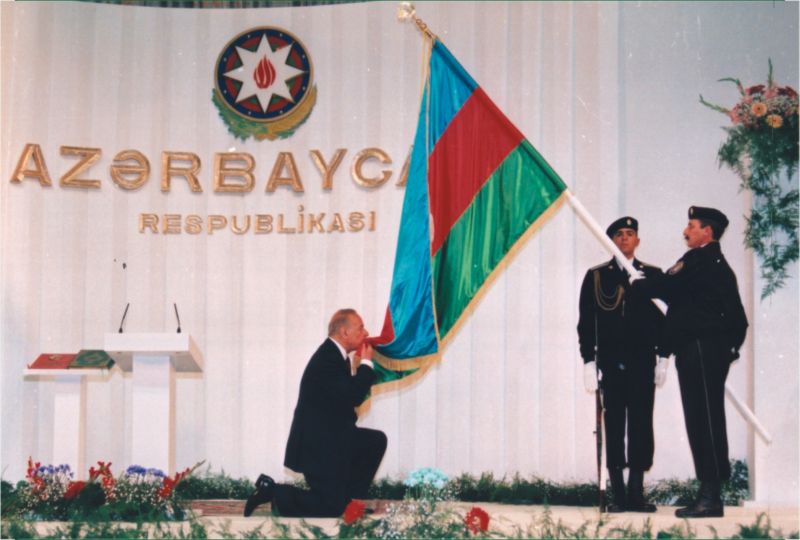
Heydar Aliyev’s return to power in Azerbaijan in 1993 was a turning point in the social, political, economic, scientific and cultural life of the country, and marked the beginning of the process of building an independent state in accordance with international norms and principles. As a result of the urgent measures taken by Heydar Aliyev – on one hand, forming National Army and regular Armed forces capable to guard national interests of Azerbaijan and defend our lands, on the other hand, stop the war by all diplomatic and political means – the ceasefire regime having vital importance to our country was established in May 1994.
Signing the first oil agreement called « Contract of the Century » in 1994 and its realization under conditions of relative stability within Azerbaijan and increasing interest and confidence to our country in the international arena, are the vivid evidence of realization of Heydar Aliyev’s oil strategy constituting a concept of economic development of Azerbaijan.
The extremely tense activity carried out under the guidance of Heydar Aliyev put an end to backstage games with Azerbaijani people’s destiny, political anarchy and experiment, crime, illegal armed groups that in all allowed to create necessary conditions for successful state-building in Azerbaijan. Heydar Aliyev’s decisiveness allowed preventing October 1994 and March 1995 coup d’etat which posed a serious threat to Azerbaijan statehood and independence. Strengthening of Azerbaijan’s statehood and establishment of democratic principles on the base of the first Constitution of independent Azerbaijan, successful and intensive realization of the process of building democratic, legal and secular state are bound up with the personality of Heydar Aliyev.
The domestic policy carried out by Heydar Aliyev implied providing each Azerbaijani citizen with the right to live freely and create conditions for improvement of his own living standard. Economic reforms, the establishment of the market economy, ensuring economic development, Azerbaijan’s integration into the world economy, implementation of the privatization program and agrarian reforms were priority directions of Heydar Aliyev’s activity.
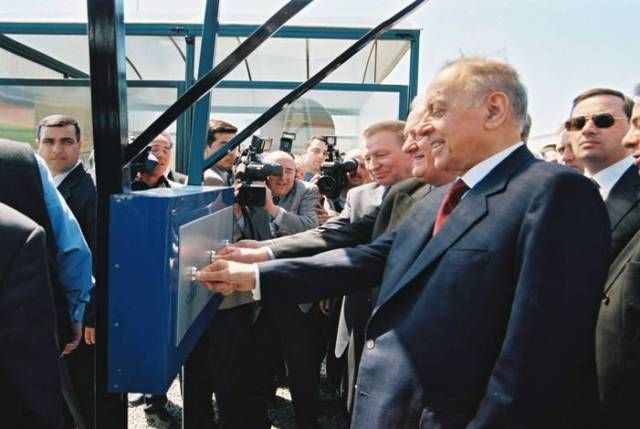
Due to the foreign policy of Heydar Aliyev, Azerbaijan’s relations with the world’s leading countries and international organizations began developing in accordance with the national interests far-sighted political perspective. His resolute steps, skilful use of the most authoritative rostrums in the name national goals, had extremely important significance from the standpoint of the present and future of Azerbaijan’s statehood.
Active diplomacy of Heydar Aliyev made democratic states and leading international public organizations to change their attitude to our country and the armed conflict it had been involved in forcedly. The Heydar Aliyev’s foreign policy was based on peace, respect to international legal norms, integrity and inviolability of borders, territorial integrity of states and principles of mutually beneficial cooperation.
Since 1992, Heydar Aliyev had been carrying out tense activity aimed at expanding and strengthening economic, political, literary and cultural links with Turkish speaking countries.
He did extremely intensive and fruitful work to prepare and realize large-scale international economic agreements on the utilization of natural resources and favourable geo-strategic position of Azerbaijan in accordance with the national interests.
Due to his huge political will and wise prescience, very important international contracts were signed and their implementation was launched. Heydar Aliyev was the initiator of Azerbaijan’s leading role in the realization of a number of world-scale economic programs of great political significance.
Heydar Aliyev has great merits in unity and solidarity of Azerbaijanis who had been scattered around the world during the merciless and severe trials of the history. He worked hard for the World Azerbaijanis to be organized, and unite closely around their only motherland, independent Azerbaijan, and made extremely important decisions to this end.
Heydar Aliyev is our contemporary of genius: the very fact is a source of pride for every Azerbaijani. At the same time, Heydar Aliyev is a great historical person presented to our people by destiny. He gave a powerful impetus to the process of the historical development of Azerbaijan. It was exactly Heydar Aliyev, the creator of the independent Azerbaijani state, who laid the ideological basis for our national statehood.
The colossal activity of Heydar Aliyev as a political and public figure devoted all his life to his people and left a deep trace in the history of the Azerbaijani people has become true school of public administration. There will be many generations of the Azerbaijan people to use this school and the rich heritage of Heydar Aliyev in the name of our country’s development and welfare of our people.
The highest top conquered by Heydar Aliyev is the soul of the nation.
Heydar Aliyev passed away at his 81. The intelligent life devoted to serving to his nation and state had come to the end. Along with the composite moments with slope, ascent, there were also years not empty with the unsuccessfulness lines. It is possible to emphasize a number of opportunities when viewing the way of life that Heydar Aliyev passed.
We may remember the tops on the way of the rich social-political life of Heydar Aliyev one by one in chronological order. However, having done it, we would repeat well-known views and considerations. Way of life of Heydar Aliyev, his personal features are well known with merits. Because Heydar Aliyev has always been connected with the Azeri nation and his way of life is a part of Azeri history. If we speak about the political portrait of Heydar Aliyev, it would be enough to say one thesis. Heydar Aliyev was a leader realizing the most complicated, conflicting historical processes taking place in the world, not losing his self-control in difficult situations and estimating realistically geopolitical changes taking place in the world could figure out outlays precisely and cleverly of the nation, a country he belonged to.

This is the unambiguous and definite conclusion of the world political scientists settling accounts with the views and considerations, numerous heads of the states, the greatest figures of the international policy. In our opinion, this conclusion doesn’t need any additional explanation, commentary. Already 34 years ago election of Heydar Aliyev to the post of the head of the party organization in Soviet Azerbaijan undoubtedly was an index of high estimation of his personal-intellectual capabilities and leadership features, organization ability in the Kremlin, centre. However, it would be necessary to specify another point here. Instead of this estimation and trust, Heydar Aliyev didn’t turn into ordinary organization man realizing orders and instructions of Moscow. Despite, instruction addressed to all ally republics from Kremlin « kitchen » provided such political management and technology. Heydar Aliyev had become a leader who was able to transform modelled Soviet management technology in the strategic interests, welfare and future of Azerbaijan (even in the well-known framework of the status of ally republic).
If we see these days of Azerbaijan, we can put a claim unconditionally that Heydar Aliyev had been a leader who could see the independence of Azerbaijan 20-30 years before it happened. Economical achievements in Soviet Azerbaijan headed by Heydar Aliyev, big projects, basis of which was being laid, we can speak a lot about the importance of these projects for the strategy of Azerbaijan nowadays. However, I would like to state only one fact. 30 years ago Heydar Aliyev was able to achieve the establishment of the school that would play a role of the basis for the national military personnel training in Azerbaijan in the hardest period of the Soviet regime. This was a school, which turned into one of the main educational institutes of the national army in Azerbaijan. The students of that school 30 years ago had become commanders, generals of Azerbaijan Armed Forces. Naturally, some people may think of the establishment of the military school named after Jamshid Nakhchivanski as simple as taking a decision on construction of the plant or factory. But volition, braveness and farsight were required to give such a decree.
It is enough to remind only one point that those years only higher military schools, mainly Russian, Ukrainian and Byelorussian schools operated according to the non-declared decree of the USSR government, Communistic Party. « When I was seeing this, I thought ok, if we were the ally republic of the Soviet Union with equal rights, we had great authorities. Why were we deprived of the army? As a result, we managed to establish this school…When we were establishing this school, I could never imagine that I would be celebrating its jubilee in 30 years. However, it is an honor for me and I am happy », – said Heydar Aliyev on 21 April 2003 at jubilee ceremony of the school named after Nakhichevansky at « Republic » palace. Yes, on that fatal day. Heydar Aliyev was very proud to take part in the jubilee ceremony of the school, the basis of which he laid 30 years ago. Because the history proved the necessity and importance of the brave step Heydar Aliyev took 30 years ago…In the years Heydar Aliyev was ruling Azerbaijan he took a number of such brave steps, which were (and will be) esteemed adequately by the history. Only now, when Azerbaijan gained its independence, we saw and realized the accuracy of the farsight steps taken by Heydar Aliyev 20, 30 years ago, their importance for the future development of Azerbaijan. The basis for the rich economic potential of Azerbaijan, intellectual treasure was established in those years. Heydar Aliyev was using Soviet management principles and economic system effectively and trying to provide development of Azerbaijan even among the union state as powerful and strong country.
Heydar Aliyev was a realistic politician. His political and management principles were far from the romanticism and dreaminess. The decisions he was taking could seem unusual from the first standpoint (for example, fire-cease in 1994) but they were the most optimal ones taking into consideration all realities and correctness in the end. Heydar Aliyev never gave populist and fantastic promises to the nation, on the contrary, was stating the results that could be achieved in the real and current situation. Cavils of Heydar Aliyev’s opponents addressed against him mostly were connected with the settlement of Nagorny Karabakh conflict. Some of them were accusing Heydar Aliyev of non-effective policy, concession and compromise-aimed actions. The authors of such accusations were those ones who meant speaking loudly in the squares, meetings by the effective policy. Heydar Aliyev has always been far from the populism. Contrary to the populists, he was carrying out a well-known consistent policy, which was very complicated in the direction of a solution. This policy couldn’t satisfy quick-tempered brains. However, nobody could doubt in successful consideration of the policy since its first step as well as successful realization.
…Usually, when giving objective estimation to great persons, the things that could be done in the period they lived are taken as basis in comparison. From this point of view, giving estimation in the periods when Heydar Aliyev was managing Azerbaijan and the period when he was quite far from his mission, we can say definitely that he was using all the opportunities in the name of interests and improvement of his nation in that period. Heydar Aliyev’s policy in Azerbaijan, his state organization line will continue. Because this policy is required from the standpoint of the future progress of Azerbaijan. Heydar Aliyev’s policy is a balanced policy, expresses the interests of all stratum of the society, creates harmony in the community, defends rights and freedoms of humans, national-state organization interests, highest values of the open society. Average-statistics Azeri could see all features of the national leader in the person of Heydar Aliyev – rationalism and wisdom, resolution, political farsight, realism and innovation.
The most important is that Heydar Aliyev’s policy doesn’t finish with today or tomorrow. There is a young leader who will be able to continue this policy successfully in future, who has a state team and a clear strategy.
Wisdom in the policy, pragmatic school in the life, skillfulness in the state governance – here are key lines of big policy. Neither of Azeri politicians was able to stay at the top of political Olympus for so long, serve to Motherland, nation and lay a monument being alive.
Heydar Aliyev is a historical even as a person. The history makes the person, such persons make history. He has always been a leader. He was a leader in the period of the empire, he was a leader in the period of our independence, he was under praise, laudation, criticism those years as well, and nothing have changed now – purpose, faith and morality didn’t let it change.
It is over thirty years since Mr Heydar Aliyev had become eminent, eternal in your, my, his eyes – in the eyes of Azeri nation. The greatest pride, the dignity of Heydar Aliyev was conquering the soul of his nation with everything he was creating, with the work he was carrying out. He will always live in the soul of the nation with this dignity, in the soul of this and next generation.
It is necessary to page chronicle of the life of this nice person, read, study and propagandize reading, studying it because the life of Heydar Aliyev is a history of Azerbaijan we lived through.
…He left us at his 81st year – at the top of wisdom, leadership. However, he had become apart only partially. Heydar Aliyev will always stay with us with his ideas, with the works, which he couldn’t finish, big plans, desires in 10, 20, 50, 100-year future of Azerbaijan. Heydar Aliyev was raised to this top by nation, its trust and belief. The highest top he was able to conquer was the soul of the nation. From that top along with yesterday and today of Azerbaijan, the future, prosperous tomorrow can be seen obviously. Let us be able to move in the light of that top thinking about tomorrow of Azerbaijan.
GENERAL INFORMATION
Civil society building in our country, as in all civil states that chose the path of democratic development, has passed a unique historical way of development. The goals and objectives and priorities considered necessary for the development of the public sector were determined and enriched as a result of the extensive discussions carried out on a continuous basis and the international experience in this field was carefully studied.
In 1997, cooperation between Azerbaijan and UNDP in the field of establishment and development of the NGO sector began. With the establishment of the national NGO Forum of Azerbaijan in 1999, this work was further stimulated. In 2000, the law” on non-governmental organizations (public associations and foundations) » was adopted. This law was the first law regulating the activities of NGOs in the CIS.
The adoption of the concept of state support to non-governmental organizations of the Republic of Azerbaijan, approved by the decree of the president of the Republic of Azerbaijan dated July 27, 2007 No. 2288, marked the beginning of a new stage in the development of the NGO sector in the country. The adoption of this document has created institutional and legal more favorable conditions for the development of the NGO sector. The concept envisages principles and forms of state support to NGOs, as well as priority areas of state support to NGOs and the main means of providing this support. These main tools are improvement of the legislative framework, cooperation mechanisms of state bodies, and civil society institutions.
The Council of state support to non-governmental organizations under the president of the Republic of Azerbaijan was established and its statute was approved by the decree of the president of the Republic of Azerbaijan dated December 13, 2007 No. 674 in connection with the implementation of the goals and objectives set forth in the concept. Specific rights and duties, as well as functions, were defined in the board’s regulations to take necessary measures in this direction for the development of NGOs in the country.
With the launch of the council, a new management model has emerged in Azerbaijan for the implementation of specialized state support to civil society institutions. As a result of the state policy, which follows from the concept of state support to non-governmental organizations and the regulation on the activities of the Council, the activity of NGOs in all spheres of public life, including beneficial cooperation relations with their government bodies as the main partner, is observed today. NGOs take an active part in the implementation of national, regional, and local public duties, which are considered important for the state and society as the main partner bodies in the state programs and strategies adopted in the most diverse spheres of public life, as well as contribute to the solution of numerous public problems.
At the same time, it is believed that there are serious tasks for the development of NGOs, which constitute the leading direction of civil society institutions, and necessary work is carried out in this direction. Our main goal is to ensure that NGOs have high potential and sustainable foundations in the country, as well as support for active activities in the state and social life.
At present, serious steps are being taken to strengthen civil society in the Republic of Azerbaijan. It is no coincidence that the number of non-governmental organizations in the country is steadily increasing. For example, if in 2001 the number of registered NGOs was 21, now their number is more than 3 thousand.
Non-Governmental Organizations (NGOs) are non-commercial organizations. Non-governmental organizations have a different and independent role in society. Non-Governmental Organizations (NGOs) are financed mainly through grants.
NGOs are divided into public associations and foundations.
A public Association is an institution created by individuals with the aim of implementing specific non – profit goals of public importance. Youth organizations and movements are such organizations.
Funds are created mainly for the purpose of assistance and financing of some projects.
HEYDAR ALIYEV FOUNDATION
Our material and spiritual heritage, which has a rich secular value, is the historical wealth of Azerbaijan and its greatest contribution to the human heritage. Tireless activities aimed at promoting Azerbaijan’s cultural and spiritual values, and secular assessment of Azerbaijan’s realities, which play a transitional role between East and West and have become a center for dialogue between civilizations, are being carried out by the Heydar Aliyev Foundation.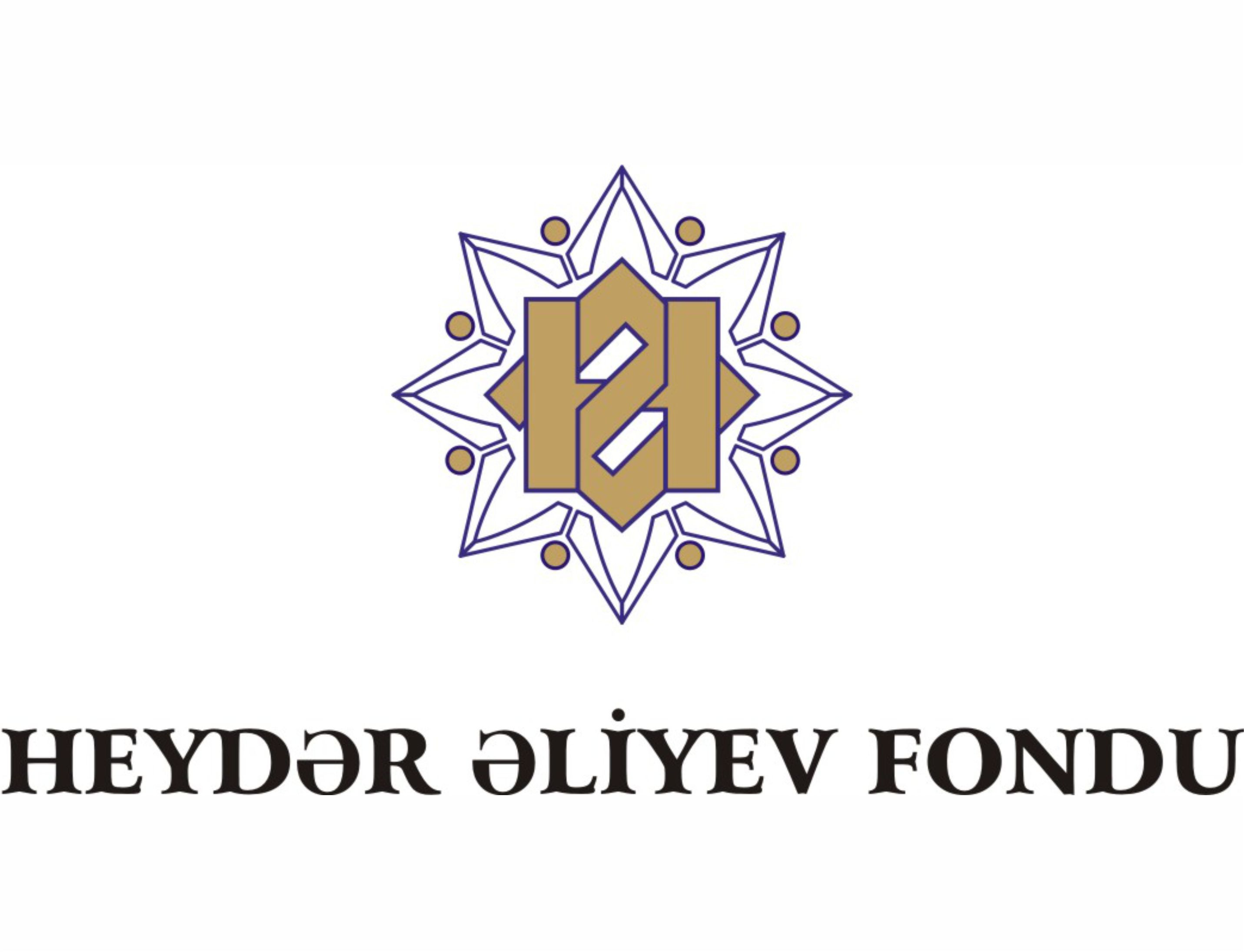
The Heydar Aliyev Foundation was established in accordance with the desire to express our people’s respect for the memory of Heydar Aliyev, who entered our history as the founder of an independent state, to reflect his rich spiritual heritage, to emphasize the importance of the philosophy of azerbaijanism for our country, to instill ideas of national statehood in new generations. The foundation was established in memory of great leader Heydar Aliyev in 2004, on May 10. Great leader Heydar Aliyev, who preserved the national and moral values, historical identity, the national identity of the people, as well as managed to pass it on to future generations, was always a great protector and protector of science, education, national and moral values. Heydar Aliyev Foundation has always demonstrated its loyalty to this with its purposeful activity. The role of President of the Foundation, First Lady of Azerbaijan, goodwill ambassador of UNESCO and ISESCO, Mrs. Mehriban Aliyeva is undeniable in our successes.
Music album named « Singers of Karabakh », collection of booklets « realities of Karabakh », « War and our historical-cultural monuments », « War against Azerbaijan: targeting of cultural heritage “in English in Paris », « collection of manuscripts about Mugham », music album « Singers of Karabagh », etc. the publication was an important tool in bringing Nagorno-Karabakh to the world community as one of the inseparable parts of Azerbaijan. Every year Khojaly genocide is celebrated in more than 100 points of the world with the support of the foundation. The International Campaign « Justice for Khojaly », launched in 2008 on the initiative of vice-president of the Heydar Aliyev Foundation, General Coordinator of the Organization of Islamic Labour (OIC) Youth Forum for intercultural dialogue Leyla Aliyeva, has created a favorable environment for exposing Armenian crimes on a global scale.
Caring for children and elderly people, numerous schools built, health centers, music lyceums, children homes, special care for children suffering from thalassemia and diabetes is an integral part of the activity carried out by the foundation. To serve the work of raising children and youth as citizens with comprehensive knowledge, to assist in the solution of social problems of local importance, to render assistance to people in need of special care, to reveal people’s creative potential, knowledge, and skills, to show and develop their abilities are the main goals set by the foundation. Construction of residential buildings for young graduates of children homes and boarding schools, restoration of religious institutions and communities, construction or restoration of kindergartens, creation of children’s entertainment centers, etc. the measures are taken from the essence of social activity. Projects such as « providing blind and visually impaired children access to information and communication technologies » initiated by Mehriban Aliyeva are benevolence and humanism that have no alternative.
As part of the « Support to Education » project, since 2004, at the beginning of the new school year, the distribution of bags and school supplies to first-graders from refugee and IDP families has become a tradition.
The main objective of the program « new school to New Azerbaijan » implemented by the foundation since 2005 is to assist in solving existing problems in the field of education, to create educational complexes meeting modern standards in the country, to eliminate problems directly affecting the level of education, it is aimed at identifying the possibilities of joint cooperation of various strata of society, local and foreign companies, international organizations in this area and directing them to the benefit of common work. The foundation’s » support to education » project is not only within Azerbaijan. Thus, a number of schools in Georgia, Egypt, Romania, the Russian Federation, Pakistan, and Holland have been reconstructed and overhauled with the support of the foundation. One of the most successful and important projects is the construction of a new school for girls destroyed after the earthquake in Rara, Pakistan’s Muzaffarabad city.
In 2017, according to the instruction of President of the Heydar Aliyev Foundation Mehriban Aliyeva, the project « provision of soldiers and officers wounded in the April 2016 battles with high-tech prostheses » was successfully implemented. Every soldier and officer who was wounded during the April 2016 battles and needed prosthetics was provided with high-tech prostheses within the project.
By supporting various projects in the fields of education, culture, education, science, technology, environment and sports, the Heydar Aliyev Foundation operates both domestically and internationally.
Carrying out social projects in foreign countries, the foundation has helped to eliminate the consequences of earthquakes in Haiti, Iran, Turkey, Pakistan, and natural disasters in Romania. In September 2011, with the support of French President Nicolas Sarkozy and the initiative of the French Terror Victims Association and the International Terror Victims Organization, financial assistance was provided to hold the 7th International Congress dedicated to victims of terrorism in Paris. In February 2012, the reconstructed « Park of friendship » in Sarajevo, the capital of Bosnia and Herzegovina, in 2013-« Center for visually impaired children and youth », in 2013-« Volgograd-Baku Friendship Park » in Volgograd, in September 2012-the Russian-Azerbaijani Friendship Bridge in Astrakhan, and in 2018-« Azerbaijan Business Center » was put into operation.
The philanthropic activity of Heydar Aliyev Foundation aimed at restoration of World Cultural Heritage covered Berlin Castle in Germany, ancient monuments in Versailles, church and Louvre Museum in Lower Normandy in France, ancient manuscripts and Catacombs of Saint Marcellino and Pietro in France, San Sebastian catacombs in the Vatican, philosophers Hall in Capitol Museum in Italy, Trapezitsa Museum in Bulgaria and many other countries.
Projects of the Heydar Aliyev Foundation are protected at the international level due to their global nature and quality. All this is a proud reality of our time. Representatives of the UN, Organization of Islamic Cooperation, UNESCO, ISESCO, and dozens of influential organizations have always appreciated the great projects implemented by the Heydar Aliyev Foundation. President of the Heydar Aliyev Foundation Mehriban Aliyeva was awarded the UNESCO Goodwill Ambassador in 2004, ISESCO goodwill ambassador in 2006, Family Health Foundation named after « Golden Heart » and World Health Organization named after Ihsan Dogramaci in 2007, Ruby Cross Order of the International Foundation » philanthropists of the ages », » Legion Of Honor « Order of France in 2010, » Golden Mozart » Medal of UNESCO, and Gold Medal of the Crans Montana Forum in 2011.
These projects implemented by the Heydar Aliyev Foundation differ in terms of benevolence, humanism, and moral wealth. The goal is to find the intersecting points between different cultures and ensure peaceful coexistence in a globalizing world. Azerbaijan is a clear proof of coexistence as a hub of different cultures, religions, values, Western and Eastern influences.
The Heydar Aliyev Foundation, trying to strengthen the ideals of the national leader based on mercy, nobility, and high humanism in the public consciousness, confidently implementing a number of important projects for the future of our people, has turned millions into a place of hope and refuge and proved its ability to fulfill the tasks set forth properly. Thanks to the unique services of the Foundation, the realities of Azerbaijan are broadcasted in the world today, the political, social, and cultural picture of our country is promoted at a high level.
IDEA PUBLIC UNION
Environmental Protection and solution to environmental problems are important factors for Sustainable Development. The Republic of Azerbaijan is taking appropriate steps in order to ensure ecological health and to transmit a clean ecological environment to future generations. The current natural and geographical conditions and rich natural resources of Azerbaijan require constant attention to environmental security.
A number of projects have been successfully implemented in connection with the implementation of the “Comprehensive Action Plan on the improvement of Ecology in the Republic of Azerbaijan for 2006-2010”.
Azerbaijan actively participates in the solution of global environmental problems and operates at the regional and international levels. Recently, the holding of conferences, local and international conferences dedicated to the solution of ecological problems is clear evidence of the inclusion of this field in the list of priority goals of the state. As the economic potential of our country grows, more attention is paid to the solution of environmental issues, and important steps are being taken to improve the environmental situation. Ratification of international conventions, expansion of cooperation in the international sphere, as well as the adoption and implementation of laws at the national level, are evident factors. Since Azerbaijan is located in an ecologically tense region from an ecological point of view, environmental care is always at the center of attention. For this purpose, 2010 was declared the « Year of Ecology », and during this year, the state of the ecological situation in the country, a wide range of activities were carried out to educate the younger generation.
The Wildlife Restoration and Rehabilitation Center in the South Caucasus was first established in Azerbaijan. In particular, our republic is the only country among the Caspian littoral states that takes comprehensive measures to clean the sea and its waters from pollution. 9 out of 11 climate types in the world can be found in our country. Azerbaijan is famous for its subtropical trees and fruits in the south and alpine glaciers in the north. This is a key factor in ensuring the rich biodiversity of flora and fauna of the wild in the Caucasus.
Recently, the activity of IDEA (International Dialogue for Environmental Action) Public Union in the direction of Environmental Protection is undeniable. The organization started its activity on July 12, 2011, at the initiative of the vice-president of the Heydar Aliyev Foundation Leyla Aliyeva. The main objective of the organization is to educate the public about environmental issues and activities, cooperate with the youth, educate them in the field of environmental problems, and find the right realization methods for them. It is noteworthy that each project is being implemented on the initiative, participation, and leadership of the younger generation. The mission of the organization is to ensure that every member of this society grows as a leader in order to create real and virtual societies of youth at the regional and international level, to develop the society through open dialogues on environmental protection, to carry out ecological enlightenment work on the ground.
Within a short period of time, the organization achieves success with its activities in the country, as well as abroad, serves to form ecological consciousness and increase ecological education through various projects and events. Thus, tree planting activities for young ecologists and ordinary students, including the international children’s photo contest « Earth through the eyes of children » with the participation of 1,200 participants from 5 continents and 90 countries, the project « Let’s change every piece of paper into a leaf » and the 1st Azerbaijan Environment Forum various other projects are among the achievements of the association. Also, numerous conferences and meetings attended by international experts such as the conference in Gabala in 2011 and the series of “Green week” conferences held in 2012 in cooperation with UNEP have expanded international cooperation and provided a network of young ecologists from around the world.
At the initiative of the IDEA Public Union, the first International Summit on Biodiversity of the Caucasus was held on May 7, 2014, and the issue of leopard protection in the region was widely discussed.
In 2015, Leyla Aliyeva, founder and head of the IDEA Public Union, was awarded the title of Goodwill Ambassador of the Food and Agriculture Organization of the United Nations (FAO).
An event dedicated to World Food Day was held in Baku on October 16, 2017, jointly organized by the IDEA Public Union, the Ministry of Agriculture, and the Food and Agriculture Organization of the United Nations (FAO).
On the initiative of Leyla Aliyeva, a project on « Planting fruit trees » was launched in April 2017. Within the framework of the project, orchards have been planted and provided free of charge in regions of Azerbaijan for low-income families, including families affected by the Karabakh war, veterans, and martyrs.
The « Our Yard » project is also being successfully implemented in order to model ecologically clean and well-maintained yards, restore greenery, form a healthy lifestyle, and create safe and comfortable living conditions for residents.
Starting from April 2018 on the initiative of IDEA, it is planned to plant trees in accordance with the soil and climatic conditions of Absheron and Baku within the framework of the project “Let’s restore the greenery”.
Currently, more than 5 million trees have been planted in the Republic on the initiative of IDEA Public Union. In particular, projects are being implemented to prevent deforestation, organize shelter for stray animals, conduct ecological events and competitions, and reduce industrial and domestic waste.
AZERBAIJANI NATIONAL OLYMPIC COMMITTEE
The National Olympic Committee of Azerbaijan was established in 1992 and recognized by the International Olympic Committee in 1993.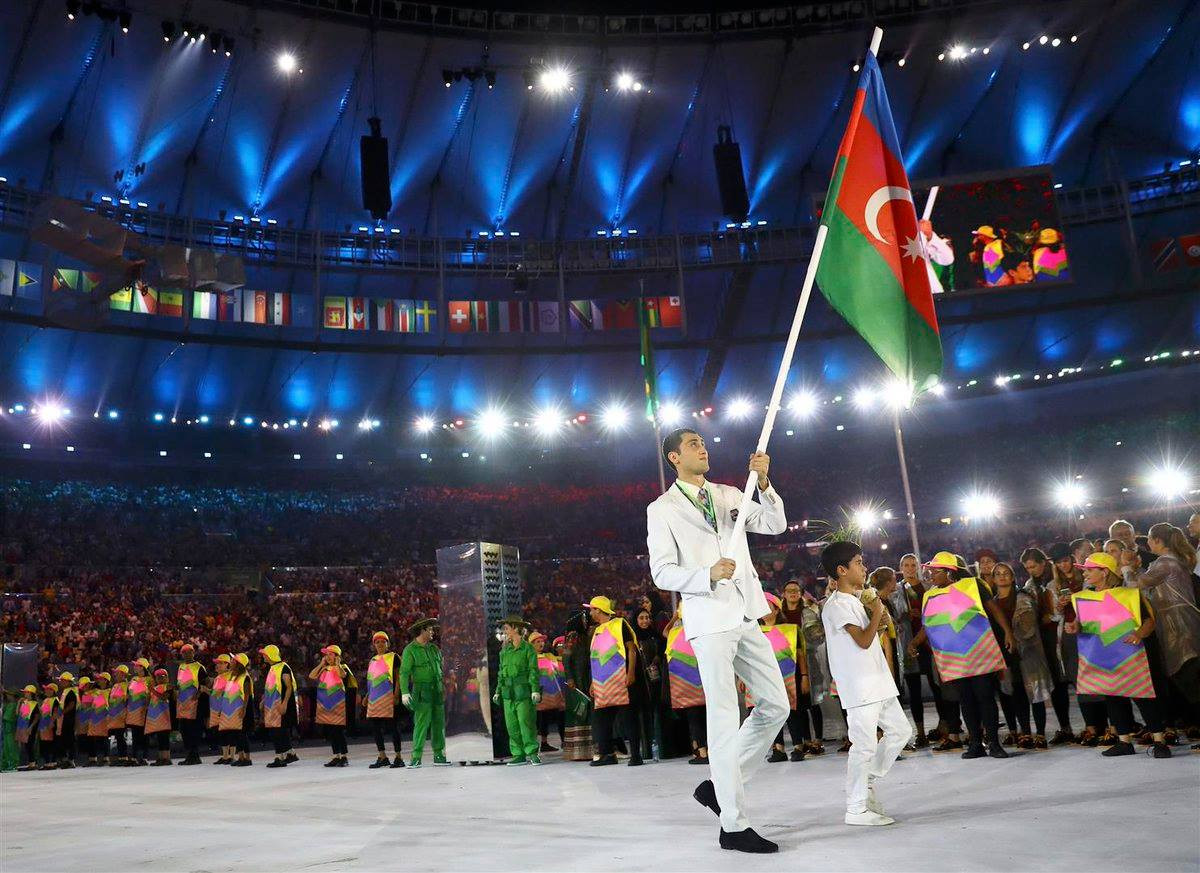
Azerbaijani Olympic movement can be conditionally divided into three periods:
1) Participation in the Olympic Games as part of the USSR national team (1952-1992);
2) Participation in the Olympic Games as part of the national team of the Commonwealth of Independent States under the flag of the International Olympic Committee (1992);
3) Azerbaijan joined the Olympic movement as an independent state (after 1992).
In 1996, Azerbaijan participated in the Olympic Games for the first time as an independent state. Azerbaijan was represented in Atlanta by 23 athletes and won one silver medal.
During the first five years of the activity of the National Olympic Committee of Azerbaijan, in general, it was not established at the proper level and could not be considered satisfactory. It was necessary to make a radical turn. The next General Assembly of the National Olympic Committee held on July 31, 1997, determined the new composition of the committee. Ilham Aliyev was elected President of the National Olympic Committee. The directions of the committee’s activities were determined.
NOC President Ilham Aliyev was able to turn the activities of the committee in a positive direction, give impetus to the rapid development of the Olympic Movement in our country and ensure its active participation in the International Olympic Games Movement. The NOC of Azerbaijan has achieved successful results in a short period of time by working purposefully and consistently on the development of the Olympic Movement and sports in our country. In order to prepare our athletes for the XXVII Summer Olympic Games in Sydney at a high level and ensure their participation in official international competitions, the decree of the President of the Republic of Azerbaijan dated January 20, 1998, opened wide opportunities for the NOC to work more purposefully. As a result of timely and state-level preparations for the Games, 31 Azerbaijani athletes participated in the XXVII Summer Olympic Games in 10 types of sport (2000).
Azerbaijani athletes won 2 gold and 1 bronze medal at the XXVII Summer Olympic Games held in Sydney, Australia. Azerbaijan’s 34th and 23rd place among European countries was a great victory for our athletes at The Sydney Olympic Games attended by 199 countries.
The order « on preparation for the XXVIII Summer Olympic Games » signed by the president of the Republic of Azerbaijan Ilham Aliyev laid the foundation for the organization and provision of the Azerbaijani athletes at a higher level and in an organized form for the XXVIII Summer Olympic Games (05.06.2003). 38 out of 130 athletes who started preparing for the XXVIII Summer Olympic Games in Athens were able to participate in the Games. Our republic was represented at the XXVIII Summer Olympic Games with 38 sportsmen in 12 types of sports. Compared to the XXVII Sydney Olympic Games, our country participated in competitions with 3 new types of sports — rhythmic gymnastics, taekwondo, fencing, and more.
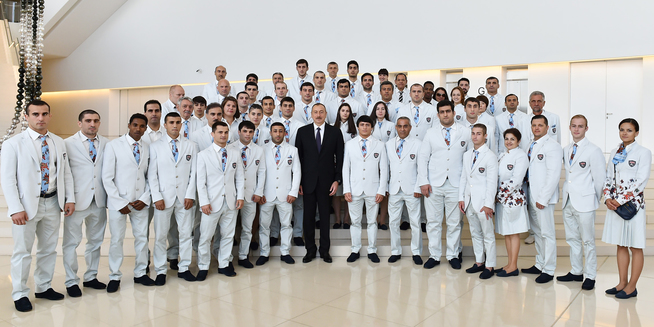
At the XXVIII Summer Olympic Games, the National Olympic team of Azerbaijan won 1 gold and 4 bronze medals and took 37th place among 202 participating states for the number of medals and 50th place for the quality.
At the XXIX Summer Olympic Games held in Beijing, the National Olympic team of Azerbaijan was represented by 44 athletes in various sports. Our representatives differed from other Olympic Games in terms of the number of athletes and medals. Our team won medals at the Olympic Games for the first time in all three games. It is interesting that for the first time our athletes tested their strength in the Olympic equestrian competitions and group exercises in rhythmic gymnastics. In addition, Beijing-2008 went down in history as the first Olympics in which our female wrestlers will compete. At the XXIX Summer Olympic Games, the Azerbaijani team took 27th place among 204 countries with 7 medals (1 Gold, 2 silver, and 4 bronze) for the number of medals, and 39th for the quality.
53 members of the National Olympic team of Azerbaijan were represented in 16 types of sports at the XXX Summer Olympic Games held in London. For the first time, our athletes tested their strength in cycling, rowing, women’s boxing, gymnastics. 10,957 athletes from 204 countries participated in the XXX Summer Olympic Games. The Azerbaijani Olympic team ranked 30th with 2 gold, 2 silver, and 6 bronze medals. At the XXXI Summer Olympic Games, 56 members of the national Olympic team of Azerbaijan were represented by 57 licenses in 17 types of sports. For the first time, our athletes tested their strength in triathlon, archery, canoe slalom, track cycling.
At the XXXI Summer Olympic Games held in Rio de Janeiro in 2016, the Azerbaijani Olympic team ranked 15th among 206 countries in total with 1 gold, 7 silver, and 10 bronze medals, and 39th for the quality.
The first European Games were held in Azerbaijan in 2015. 10,000 athletes from 50 countries competed in the competitions. 11 sports facilities of Baku and 1 Mingachevir were used in the competitions. 30 types of sports were included in the calendar of the 2015 European games. 24 of them are Olympic and 6 are non-Olympic sports. Athletes competed in 253 sets of medals. Participating in the competitions with 289 athletes, Azerbaijan won 21 gold, 15 silver, and 20 bronze medals, a total of 56 medals, and took second place in the competition table in terms of the number of medals and for quality.
In 2017, our country hosted another prestigious sporting event, the IV Islamic Solidarity Games.
During the 18th session of the Islamic Solidarity Sports Federation held in Jeddah, Saudi Arabia in October 2012, the Azerbaijan National Olympic Committee nominated itself for the Islamic Solidarity Games. The 8th report-election General Assembly of IHIF held in Jeddah in 2013 approved the hosting of Azerbaijan.
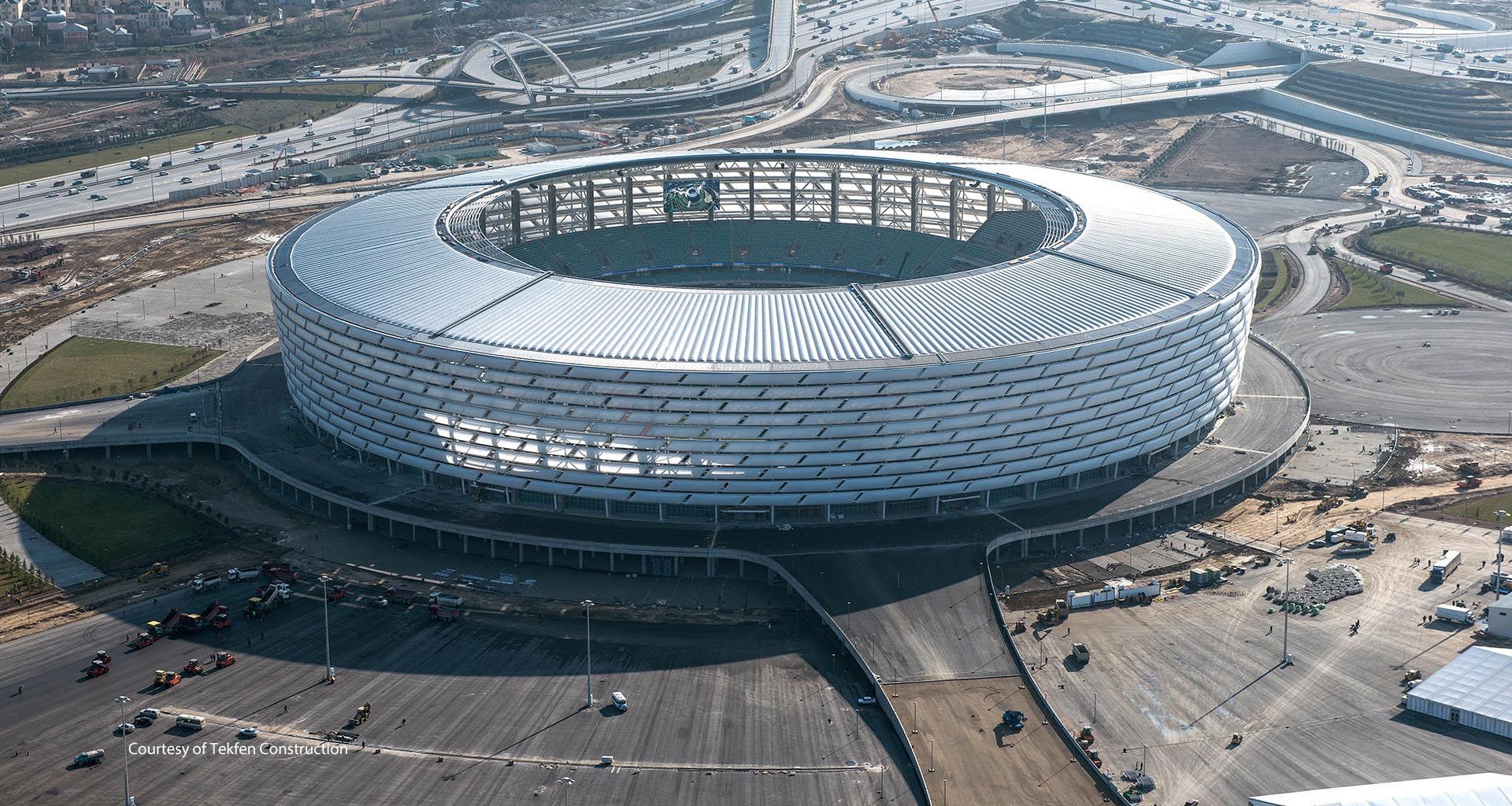
On May 12-22, 2017, at the 4th Islamic Solidarity Games in Baku, the Azerbaijani team was represented in 9 types of sports with 142 athletes. Azerbaijani athletes won 162 medals (75 gold, 50 silver, and 37 bronze) at the 4th Islamic Solidarity Games and took first place for medals.
The Republic of Azerbaijan, which has become a worthy member of the world community, is also known as an international sports country.
Azerbaijani sportsmen have made a worthy performance in the prestigious competitions held in our country and international arenas over the past years. This has led to a significant increase in Azerbaijan’s international prestige. As a result, the world’s leading sports organizations have recently entrusted Azerbaijan with a number of competitions.
As a result of the care and attention paid to the development of sports in Azerbaijan, Olympic complexes and numerous sports facilities have been built and put into operation in the capital Baku, as well as in different regions of the country. The development of sports in the Republic of Azerbaijan is expanding year by year. Caring for sports in our country is one of the priorities of state policy.
At present, more than 40 Olympic Sports Complexes operate in Azerbaijan. In addition, Baku Olympic Stadium with a capacity of 68,000 spectators, Baku Water Sports Palace, Baku European Games Park, Sports and Concert Complex named after Heydar Aliyev, Republican Olympic Center, Baku Shooting Center, Republican Velotrack, Republican Stadium named after T. Bahramov, Sports facilities such as Baku Crystal Hall, Velopark, Baku Tennis Academy, National Gymnastics Arena, Paralympic Sports Complex, Baku Sports Palace, Kura Olympic Training and Sports Center in Mingachevir create good opportunities for the development of sports in our country.
« REGIONAL DEVELOPMENT » PUBLIC UNION
“Regional Development” Public Union has been established at the initiative of the Heydar Aliyev Foundation on February 12, 2016.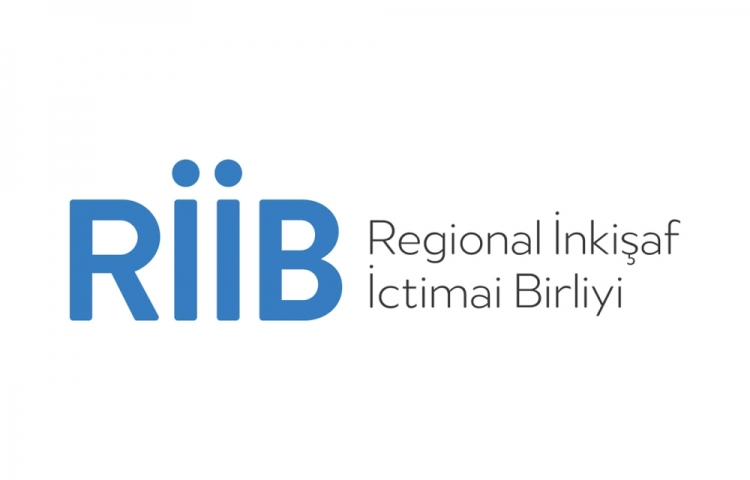
The activity of the organization covers the entire territory of the Republic and has regional centers in the regions.
In the Republic of Azerbaijan, every natural and legal person (except for state authorities and local self-government bodies) can be a member of the public union.
The main goal of the “Regional Development” Public Union is to contribute to the social, economic, and cultural development of society.
In order to achieve the goals of the Public Union, it performs the following tasks:
- To study the existing problems of the population in the regions in the field of science, education, health care, sports, tourism, ecology, social protection, culture, art, business development, and other areas and to establish mutual dialogue and cooperation between citizens and state and municipal bodies, to assist in expanding existing contacts and ensuring the flow of information;
- To work to strengthen the mechanism of public control;
- To support the work of relevant government agencies in the implementation of regional state programs;
- To support the creation of the necessary conditions for the exercise of the rights and freedoms of the people established by legislative acts;
- To take measures to identify talented people with special abilities in the regions and ensure their sustainable development;
- To prepare proposals in the field of environmental protection in the regions, as well as the formation and strengthening of environmental awareness and culture, to take measures in this direction together with the relevant agencies;
- To increase the outlook and practical knowledge of young people deprived of parental care, in need of special care, as well as with limited health care in the regions, to improve the educational opportunities, to support the work of ensuring active integration into society;
- To make proposals in the field of protection and development of ethnic and cultural diversity, multicultural and tolerant environment in the regions;
- To participate together with relevant agencies in the development of targeted programs serving the development of entrepreneurship and tourism in the regions and support their implementation;
- To participate in the preparation and implementation of territorial and state employment programs together with relevant agencies in the regions, to prepare proposals;
- To study, analyze and evaluate the living standards of the population in the regions, as well as to support the preparation and implementation of measures to improve the living standards of the population;
- To take measures in the direction of youth’s growth in the spirit of national and moral values, traditions, and historical past, as well as to increase knowledge and information about our country and world culture in the regions;
- To formalize and develop strong human resources in the regions;
- Implements measures to educate the population in the regions independently or together with government agencies, municipalities, and public organizations;
- To cooperate with international organizations and similar bodies of foreign states in the field of activity;
- Cooperate with humanitarian, commercial, and non-profit organizations, mass media, state and municipal bodies, non-governmental organizations, local and foreign educational institutions, and other organizations;
- To initiate improvement of legislative acts if necessary;
- To carry out other duties defined by the legislation.
« Regional Development » Public Union pays special attention to the organization of work with volunteers in the implementation of the tasks set, the effective use of their potential and initiatives in the construction of civil society, socio-economic development of the regions. Everyone, especially young people, is invited to take part in the work of the Public Union in all meetings with the residents of the region.
The active participation of volunteers in local projects and national events implemented by the Public Association is ensured.
In order to increase the effectiveness of work with volunteers, as well as to support their personal development, the RDPU is implementing a sustainable “Volunteering Program” project covering a 3-month period.
Committed to the values of national-moral, statehood, patriotism, and modernity, RDPU volunteers are closely involved in solving the problems of citizens in different spheres in the regions, as well as supporting the reforms carried out by the state in the field of socio-economic development of the regions.
On October 27, 2017, the first conference of the “Regional Development” Public Union (RDPU) was held.
The regional centers of the “Regional Development” Public Union of Daghlig Shirvan, Guba-Khachmaz, Lankaran, Aran 1, Aran 2, Sheki-Zagatala, Ganca-Gazakh, and upper Garabagh are functioning.
Like all modern political systems, Azerbaijan’s political system is also multi-party and pluralism. Political parties gain the opportunity to participate in the exercise of state power through representation in legislative and local self-government bodies.
The rights of citizens of the Republic of Azerbaijan to activities in political parties or various public associations are enshrined in Article 58 of the Constitution.
Extract from the Constitution of the Republic of Azerbaijan:
Article 58. Right for association
I. Everyone has a right to unite with others.
II. Everyone has a right to join any association including any political party, trade unions, and other social unions as well as existing units. The free activity of such associations is ensured.
III. No one can make any other person join or remain a member of any association.
IV. The activity of the associations aiming at the forceful overthrow of the legal state power on the whole territory of the Republic of Azerbaijan or its part is prohibited.
The activity of the associations violating the Constitution and the Law can be ceased only through the court.
The New Azerbaijan Party, currently the ruling party in the Republic of Azerbaijan, is a center-right political party with over 700,000 citizens.
The main tasks set in the Program of the New Azerbaijan Party are to strengthen state independence, build a democratic, legal, secular state, and ensure a peaceful and prosperous life for citizens. The principles of independent statehood, the rule of law, Azerbaijanism, creative evolution, civil solidarity, and social justice, which form the basis of the party’s ideology, in fact, are the basis of the idea of the political future of Azerbaijan as a guarantee for the implementation of the tasks facing the EAP.
Currently, there are 56 political parties registered in the Republic of Azerbaijan.
Information about political parties registered in the Republic of Azerbaijan
No | PARTY | Registration date | Address |
1. | Azerbaijan National Independence Party | 17.07.1992 | 4, Azadlig Avenue, Baku |
2. | Azerbaijan Revival and Progress Party | 24.07.1992 | Apartment 23, Nakhchivan Street 1, Baku |
3. | « Motherland » Party | 11.08.1992 | 3, Aliyar Aliyev str., Narimanov district, Baku |
4. | National Democratic Cognitive Party | 11.08.1992 | Apartment 40, 4th m/c, Taghizadeh str. 68, Baku |
5. | Civil Solidarity Party | 03.11.1992 | 9, A. Alizadeh str., Baku |
6. | Musavat Party | 08.12.1992 | The building of the Complex No.2, block 3097, Darnagul settlement, Binagadi district, Baku |
7. | “Birlik” Party | 18.12.1992 | Apartment 53, S. Rustamov Street, 35, Baku |
8. | New Azerbaijan Party | 18.12.1992 | 13, Bulbul Avenue, Baku |
9. | United Azerbaijan National Unity Party | 13.01.1993 | 62/11, A.Topchubashov str.., Baku |
10. | United Azerbaijan Party | 13.01.1993 | Apartment 16, R. Baghirov str. 28, Baku |
11. | Democratic Azerbaijan World Party | 10.02.1993 | 25, Rafiyev str., Baku |
12. | Independent Azerbaijan Party | 10.02.1993 | 17, A.Abbaszadeh str., Baku |
13. | National Salvation Part | 03.03.1993 | Apartment 25, Nakhchivanski str. 58, Baku |
14. | Azerbaijan Hope Party | 05.05.1993 | 1929 block, Khalilov str., Narimanov district, Baku |
15. | “Gorgud” Party | 10.11.1993 | Apartment 214, Ingilab str.1, Baku |
16. | Azerbaijan Communist Party | 02.03.1994 | BApartment 27, Khosrov Ruzbeh str. 44/46, Baku |
17. | Azerbaijan National State Party | 12.10.1994 | 88a, H.Zardabi str.., Baku |
18 | Azerbaijan Patriots Party | 12.10.1994 | 153, Dilara Aliyeva str., May 28, Baku |
19. | Alliance Party for the Sake of Azerbaijan | 22.06.1995 | 93, A. Alakbarov str., Baku |
20. | Azerbaijan Democratic Enlightenment Party | 04.08.1995 | 3/20, 105, G. Mammadov str., Baku |
21. | Azerbaijan Social Prosperity Party | 04.08.1995 | 92, Tabriz str., Baku |
22. | Azerbaijan Liberal Party | 14.08.1995 | 370001, 1/15 H. Hajiyev str., Baku |
23. | Azerbaijan Social Democratic Party | 01.09.1995 | 200, Azadlig Avenue, Binagadi district, Baku |
24. | Azerbaijan Popular Front Party | 01.09.1995 | 33, Khagani str., Baku |
25. | Social Justice Party | 11.12.1998 | Apartment 13/15, Y.Mammadaliyev str. 9, Baku |
26. | National Congress Party | 11.12.1998 | Apartment 10, Nizami str. 48, Baku |
27. | Unity Party | 11.12.1998 | Apartment 52/54, Z.Aliyeva str. 23, Baku |
28. | The Republican Party of Azerbaijan | 09.07.1999 | 86, Tabriz str., Baku |
29. | Azerbaijan People’s Party | 09.07.1999 | Apartment 47, Nakhchivan str. 27, Baku |
30. | The Liberal Democratic Party of Azerbaijan | 09.07.1999 | Apartment 4, Azim Azimzadeh str., Baku |
31. | Azerbaijan Democratic Party | 03.02.2000 | 13, Aliashraf str., Baku |
32. | “Azerbaijan Fights” Party | 27.05.2000 | 12,20, rasul Rza str., Baku |
33. | « Justice » Party | 08.05.2002 | 2, J. Hajibeyli str., Baku |
34. | The National Unity Party | 08.05.2002 | 195, B. Safaroglu str., Baku |
35. | Modern Musavat Party | 08.05.2002 | Apartment 71, 8 m / r, house 23a, Baku |
36. | Free Republican Party of Azerbaijan | 08.05.2002 | Apartment 68, H.Aliyev Street, 15, Baku |
37. | The Great Party | 12.08.2005 | 4, A. Azimzadeh str., Nizami district, Baku |
38. | Freedom Party | 12.08.2005 | 24, Metbuat Avenue, Baku |
39. | Azerbaijan Democratic Reform Political Party | 12.08.2005 | Apartment 5, Neftchiler Avenue 65, Sabail district, Baku |
40. | The All-Azerbaijan Popular Front Party | 12.08.2005 | 70a, Ashyrim str.12, Baku |
41. | Azerbaijan Progress Party | 12.08.2005 | Apartment 61, Lermontov str. 113, Sabail district, Baku |
42. | Great Azerbaijan Party | 12.08.2005 | 27/121, S.Mustafayev str., Baku |
43. | Azerbaijan Evolution Party | 12.08.2005 | Apartment 112, M.Hadi str. 65, Baku |
44. | Civil Union Party | 12.08.2005 | House 29, S.Bahlulzadeh str. 89, Bulbula settlement, Baku |
45. | Classic Popular Front Party | 31.01.2007 | 18, A. Nematullah str., Narimanov district, Baku |
46. | Citizen and Development Party | 10.08.2007 | 69, S. Bedelbeyli str., Nasimi district, Baku |
47. | The National Democratic Party of Azerbaijan | 24.12.2008 | House 10, A.Alakbarov str., Yasamal district, Baku |
48. | Party of Intellectuals | 19.11.2009 | House 70, apartment 188, Azadlig Avenue, Nasimi district, Baku |
49. | National Revival Movement Party | 31.05.2011 | 5/7, Mammadzadeh str., Narimanov district, Baku |
50. | New Time Party | 16.04.2020 | |
51. | Free Democratic Party | 16.04.2020 | |
52. | Republican People’s Party | 07.05.2020 | |
53. | Independent People’s Party | 07.05.2020 | |
54. | « White » Party | 07.05.2020 | |
55. | National Front Party | 31.08.2020 | |
56. | Republican Alternative Party | 31.08.2020 | Ismail Gutgashinli street 97, Baku |
MASS MEDIA IN AZERBAIJAN
Today, independent media are being formed in Azerbaijan that meets modern world standards. In terms of the number of media outlets, the Republic of Azerbaijan occupies one of the leading places among the CIS countries and Eastern Europe. More than 5,000 media outlets in Azerbaijan are registered with the relevant state body. The official media are owned by various political and public organizations, private organizations, and individuals. The country publishes about 40-daily, more than 200-weekly and monthly newspapers. More than 80 scientific-practical, socio-political, socio-economic issues, children’s and women’s problems, and entertainment magazines are published. About 20 news agencies in Azerbaijan regularly and comprehensively disseminate information about the events taking place in the country and the world. The first news agency of Azerbaijan is AZERTAC, created on March 1, 1920. About 100 newspapers and magazines are published in the regions.
Since 1998, new private TV and radio channels have been opened in Azerbaijan, and the scale of cable television has expanded in recent years. Currently, Azerbaijan operates 11 nationwide, 4 satellites and 17 cable television, 8 regional and 12 radio stations. In 2005,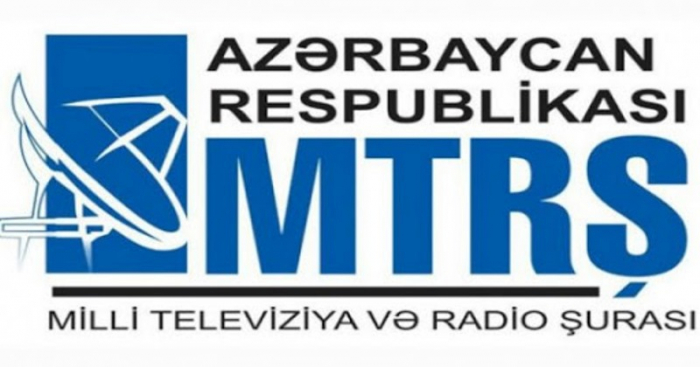
« Azerbaijan television and Radio broadcasting » Closed Joint-Stock Company was established based on Azerbaijan state television. In the same year, public television and Radio Broadcasting Company was established on the base of the second state channel and started its activity. According to the decision of the Cabinet of Ministers of the Republic of Azerbaijan dated 2001, digital broadcasting started in the country. The transition to digital broadcasting in Azerbaijan was completed in 2014.
More than 50 journalist organizations are registered in Azerbaijan, about 30 organizations are actively engaged in the development of freedom of speech and information, strengthening the economic independence of the press, protection of journalists ‘ rights, expansion of access to information by mass media, regulation of relations between society and mass media and other issues. The number of independent commercial companies operating in the country has increased. At present, more than 20 media companies are operating in the capital and regions.
The rapid development of information and communication technologies in Azerbaijan facilitated the expansion of the internet and the formation of a modern internet network in the country. The president of Azerbaijan approved the « National Strategy on Information and Communication Technologies for the development of the Republic of Azerbaijan (2003-2012) » by the decree of February 17, 2003, and thereby identified the directions of development of information and communication technologies in the upcoming period. Within the framework of the strategy, state programs « electronic Azerbaijan — 2005-2008 » and « electronic Azerbaijan-2010-2012 » were adopted and implemented. According to the report of the World Economic Forum, the number of internet users in the country currently accounts for 80% of the population. The number of internet provocateurs has reached 40.
There are no restrictions on the free access of ethnic and religious minorities to the media. Newspapers are published in the languages of ethnic minorities or brought from abroad.
Freedom of thought, speech, and information is an important component of democratic achievements in the Republic of Azerbaijan. The Azerbaijani government is determined to continue to fulfill its responsibilities in the development of democracy.
National legislation
The state has created all conditions for the free development of the media, which is called the » fourth government ». There are unlimited opportunities for publishing journalistic research, facts, and opinions, respecting legal and ethical norms. In 1998, censorship was abolished by the Order of the nationwide leader. Freedom of expression, speech, and information is a key component of Azerbaijan’s domestic policy, and the state consistently provides possible support in this area.
The Constitution of the Republic of Azerbaijan, the Law on Freedom of Information adopted in 1998, the Law on Mass Media adopted in 1999 and improved in consultation with international organizations in subsequent years, as well as the Law on Freedom of Information adopted in 2005 The Law on Access to Information fully ensures freedom of speech and press, and the independence of journalists in our country.
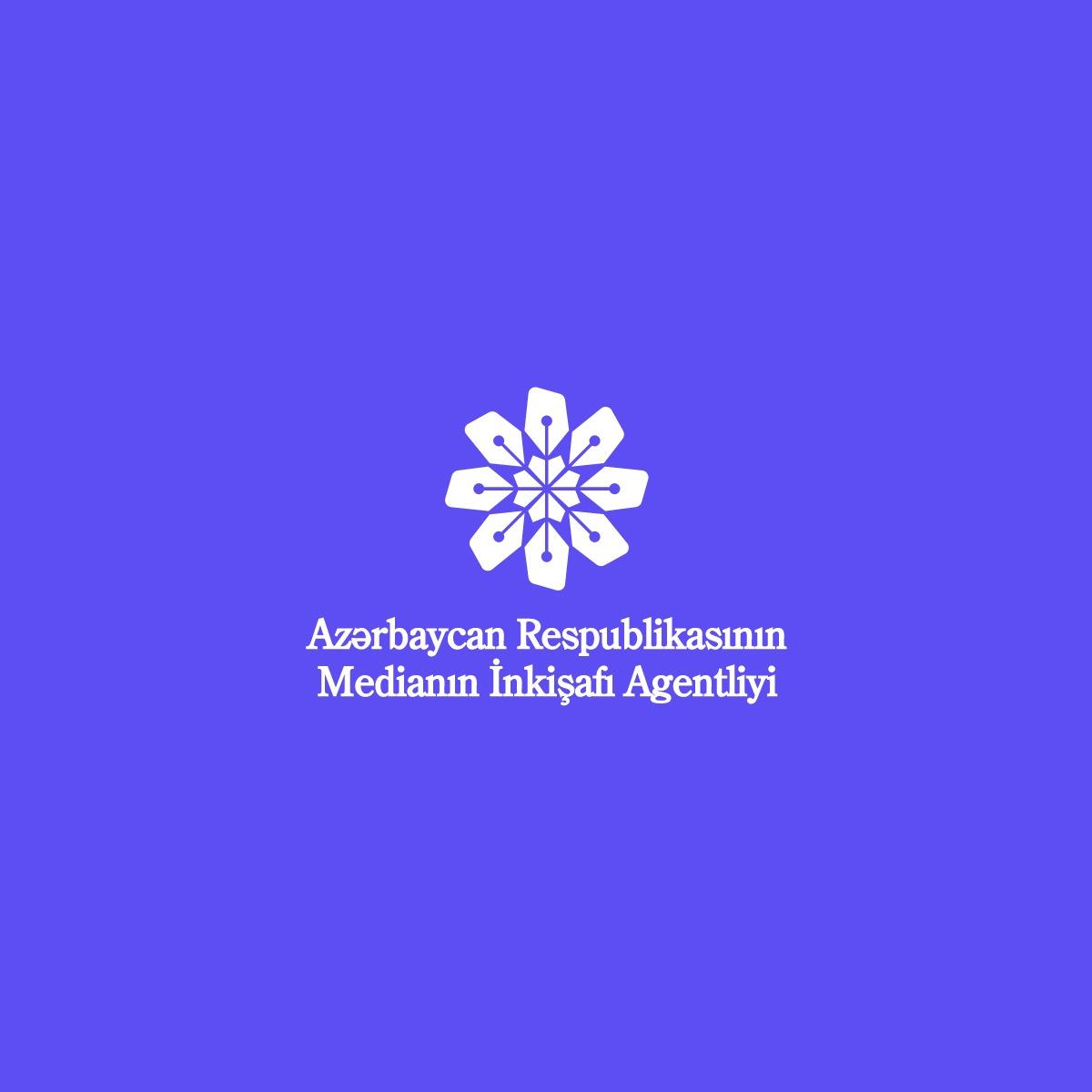
Important legislative measures have been taken in the field of broadcasting. The law » on television and radio broadcasting » was adopted in June 2002 and entered into force in October of the same year. On October 5, 2002, the president of the Republic of Azerbaijan signed a decree on the establishment of the National Television and Radio Council in full compliance with the standards of the Council of Europe. The council was established in January 2003.
The next important step towards ensuring freedom of expression and information was the establishment of the Press Council at the first congress of Azerbaijani journalists on March 15, 2003. This body was created by journalists themselves independently, without any interference from the state. The main function of the Press Council, which is an independent body, is to resolve disputes between individuals and the media, as well as between the media and private companies until the court. The council also carries out the functions of monitoring the newspapers and implementing the provisions of the code of journalist ethics prepared and adopted by it.
To develop the independence of the media, on August 31, 2008, the president of the Republic of Azerbaijan signed an order on approval of the « concept of state support to the development of mass media in the Republic of Azerbaijan ». In 2009, the State Support Fund for Mass Media under the president of the Republic of Azerbaijan was established. At the same time, on June 22, 2010, the president of the Republic of Azerbaijan signed a decree « on social protection of the press employees of Azerbaijan ».
The National Action Plan for the Promotion of Open Government for 2012-2015 was approved by the Order of the President of Azerbaijan dated September 5, 2012, to increase the transparency of the activities of state bodies, ensuring accountability, expanding public participation, and the use of new technologies. The document is intended to facilitate access to Information, provide regular information to the public about its activities, improve the functioning of a single electronic database of normative legal acts, expand public participation in the activities of state bodies, improve electronic services, etc.
In recent years, certain measures have been taken to remove defamation from the list of criminal acts and to adopt the Law on Defamation. In 2009, articles 147 (slander) and 148 (insult) of the Criminal Code of the Republic of Azerbaijan were on a moratorium. On May 11, 2011, a conference entitled « Decriminalization of Defamation » was held by the former OSCE Office in Baku (the OSCE Project Coordinator in Baku under a new mandate since January 2014) and the Press Council. The Venice Commission was asked to help draft a defamation law in our country. The plenum of the Supreme Court of the Republic of Azerbaijan held on February 21, 2014, adopted a decision to appeal to the Milli Majlis of the Republic of Azerbaijan in exceptional cases of criminal liability for slander and to submit a proposal to the legislative initiative in this regard.
On January 12, 2021, President Ilham Aliyev signed a decree « On deepening media reforms in the Republic of Azerbaijan. » According to the decree, the Media Development Agency of the Republic of Azerbaijan was established as a public legal entity based on the State Support Fund for the Development of Mass Media under the President of the Republic of Azerbaijan, and the Charter of the Media Development Agency of the Republic of Azerbaijan was approved.
GENERAL INFORMATION
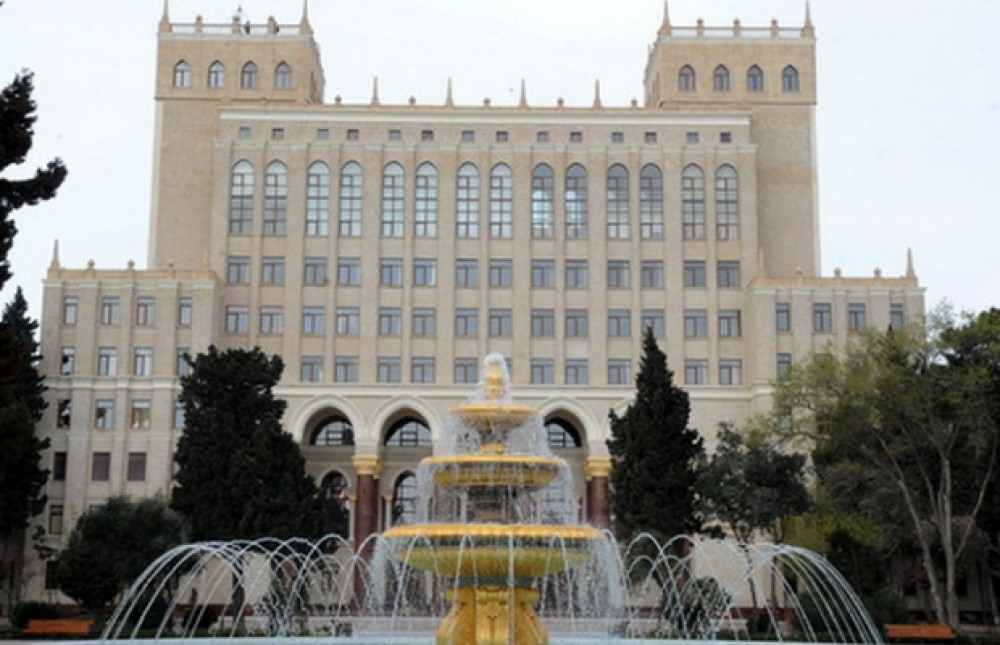
Azerbaijan National Academy of Sciences was established in 1945. During this period, the Academy of Sciences has become a huge organization, a major center of fundamental research. The establishment of the Academy has been a natural result of the formation of scientific thinking in Azerbaijan for centuries. Material cultural monuments and many scientific sources show that mathematics, astronomy, medicine, philosophy, and other sciences were still highly developed in ancient Azerbaijan.
The scientific results obtained at the Academy for 60 years, numerous inventions, trained highly qualified personnel have played a decisive role in the formation of the independent Republic of Azerbaijan as a democratic and legal state.
At present, ANAS has 6 departments: physical-mathematical and technical sciences (Institute of Physics, Institute of Mathematics and Mechanics, Institute of Control Systems, Institute of Radiation Problems, Institute of Information Technology, Shamakhi Astrophysics Observatory named after Nasraddin Tusi, Institute of Biophysics); chemical sciences (Institute of Petrochemical Processes named after Academician Yusif Mammadaliyev, Institute of Catalysis and Inorganic Chemistry named after Academician Murtuza Nagiyev, Institute of Chemistry of Additives named after Academician Ali Guliyev, Institute of Polymer Materials); Earth Sciences (Institute of Geology and Geophysics, Institute of Geography named after Academician Hasan Aliyev, Institute of Oil and Gas, Republican Seismological Service Center); biological and medical sciences (Institute of Botany, Institute of Zoology, Institute of Physiology named after Academician Abdulla Garayev, Institute of Microbiology, Central Botanical Garden, Institute of Dendrology, Institute of Molecular Biology and Biotechnology, Institute of Soil Science and Agrochemistry, Institute of Genetic Resources); Humanities (Institute of Literature named after Nizami Ganjavi, Institute of Linguistics named after Nasimi, Institute of Architecture and Art, Institute of Manuscripts named after Mohammad Fuzuli, Folklore Institute, National Museum of Azerbaijan Literature named after Nizami Ganjavi, Huseyn Javid’s House Museum), Department of Social Sciences (named after Abbasgulu Aga Bakikhanov Institute of History, Institute of Archeology and Ethnography, Institute of Economics, Institute of Philosophy, Institute of Law and Human Rights, National Museum of History of Azerbaijan, Institute of History of Science, Institute of Caucasus Studies, Institute of Oriental Studies named after Academician Ziya Bunyadov). There are 2 regional departments and 2 regional scientific centers at ANAS: Nakhchivan Scientific Department (Institute of History, Ethnography and Archeology, Institute of Art, Language and Literature, Institute of Natural Resources, Institute of Bioresources, Manuscripts Fund, Batabat Astrophysics Observatory), Ganja Department ( Nizami Ganjavi Center, Institute of Humanitarian Research, Institute of Ethnography, Institute of Bioresources, Institute of Ecology and Natural Resources, Institute of Agrarian Problems, Botanical Garden); Sheki Regional Scientific Center and Lankaran Regional Scientific Center.
In addition, a number of institutions operate under the Presidium of ANAS: « Azerbaijan National Encyclopedia » Scientific Center, Central Scientific Library, Museum of Natural History, « Cybernetics » Scientific Production Association, « Elm » Publishing House, Republican Scientific Research Coordination Council, Free Trade Union, Veterans Council, Council of Young Scientists and Specialists, House of Scientists, « Nafta » Scientific Production Association, « Ashqar » Scientific Production Association, Interdisciplinary Analytical Center and « High Technology Park of ANAS » Limited Liability Company.
By the order of the President of the Republic of Azerbaijan Ilham Aliyev dated January 12, 2004, the Encyclopedia of Azerbaijan was subordinated to ANAS and according to another order dated May 5, 2004, the “Azerbaijan National Encyclopedia” Scientific Center was established.
At present, the Azerbaijan National Academy of Sciences employs about 10,000 employees, including 4,939 researchers, 664 doctors of sciences, and 2,026 doctors of philosophy. The Academy has 73 full members and 114 corresponding members.
GENERAL INFORMATION
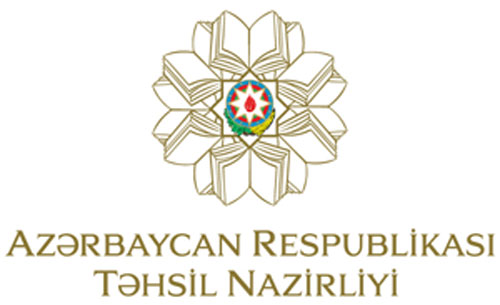
The first Ministry for enlightenment and education in Azerbaijan – the Ministry of Public Enlightenment was established by the Order of the Government of the Azerbaijan Democratic Republic on 28 May 1918. Its structure consisting of three departments (general secondary education, higher and secondary special education, and vocational schools) was approved by the Order of the Council of Ministers of 30 June 1918.
The Ministry of Public Enlightenment was renamed and reorganized as the Commissariat of Public Enlightenment by the Order of the Council of Ministers of Azerbaijan SSR of 28 April 1920, and all education institutions operating in the country were placed under its control.
In 1940, the Department for Labor Reserves was established by the Order of the Council of Ministers of Azerbaijan SSR, and vocational education institutions were put under the control of the Department. In 1959 there was founded the State Vocational Education Committee, which operated until 1988. Moreover, in 1959, by the Order of the Council of Ministers was established the Committee of Higher and Secondary Special Education was, and all institutions operating in the Republic were put under its control. In 1964, the Committee was reorganized as the Ministry of Higher and Secondary Special Education. Overall, two ministries (Ministry of Public Enlightenment and Ministry of Higher and Secondary Special Education) and one committee on education (State Vocational Education Committee) operated in Azerbaijan during the period 1959 -1988.
In 1988, by the Order of the Council of Ministers of Azerbaijan SSR, all three departments were abolished and the Ministry of Public Education was established on their base. The Ministry of Public Education was renamed the Ministry of Education by the Order of the President of the Republic of Azerbaijan on 3 September 1993. The Regulations of the Ministry were approved by the Presidential Decree dated 1 March 2005.
On June 19, 2009, the President of the Republic of Azerbaijan signed a Decree on the application of the Law on Education.
In 2007-2015, the State Program was adopted to ensure that Azerbaijani youth receive education in various countries, the most prestigious universities, in various specialties, bachelor’s, master’s, and doctoral degrees.
The education system in the Republic of Azerbaijan is defined in the following structure:
Preschool education:
- General education:
- Primary education;
- Basic education;
- Secondary education.
Vocational education:
- Technical vocational education;
- Secondary special education;
- Higher education.
Postgraduate training (internship, residency, etc.):
- Master’s degree;
- Doctorate;
- Extracurricular training and education;
- Free education;
- Professional development and retraining.
LIST OF HIGH SCHOOLS OF THE REPUBLIC OF AZERBAIJAN
STATE HIGH SCHOOLS
Baku State University
Address: 23, Z.Khalilov str., Baku
Website: bsu.edu.az/ru
Gazakh branch
Address: 150, Heydar Aliyev Avenue, Gazakh
Azerbaijan State Oil and Industry University
Address: 16/21, Azadlig Avenue, Baku
Website: asoiu.edu.az/ru
Azerbaijan Medical University
Address: 23, Bakikhanov str., Baku
Website: amu.edu.az/ru
Azerbaijan Technical University
Address: 25, H.Javid Avenue, Baku
Website: aztu.edu.ru
Azerbaijan State University of Economics
Address: Main building (I building) 6, Istiglaliyyat str., Baku
II building: 135, Hasan Aliyev str., Baku
III building: 135 A, Hasan Aliyev str., Baku
IV building: 45 A, A. Sahhat str., Baku
Website: unec.edu.ru
Darband branch
Address: 26, S.Stalski, Darband, Russia
Zagatala branch
Address: 4, G.Kərimov str., Zagatala
Azerbaijan State Pedagogical University
Address: 34, U. Hajibeyov str., Baku
Website: adpu.edu.az/az
Aghjabadi branch
Address: 210,U. Hajibeyov str., Aghjabadi
Jalilabad branch
Address: 20, M.Huseyn str., Jalilabad
Guba branch
Address: 4, Fatali Khan str., Guba
Shamakhi branch
Address: 1, Azadlig Avenue, Shahriyar settlement, Shamakhi
Sheki branch
Address: 305, M. Rasulzadeh Avenue, Sheki
Azerbaijan Architecture and Construction University
Address: 5, A.Sultanova str., Baku
Baku Slavic University
Address: 33 S.Rustam street, Baku.
Website: bsu-uni.edu.ru
Azerbaijan University of Language
Address: 134, R.Behbudov str., Baku
Website: adu.edu.ru
Baku Engineering University
Address: 120, Hasan Aliyev str., Khirdalan city
Baku Music Academy named after Uzeyir Hajibayli
Address: 98, S.Bedelbeyli str., Baku
Azerbaijan State University of Culture and Arts
Address: 39, Inshaatchilar Avenue, Baku
Sumgait State University
Address: 43rd block, Sumgait
Website: www.sdu.edu.ru
Lankaran State University
Address: 50, General Hazi Aslanov Avenue, Lankaran
Ganja State University
Address: 187, Shah Ismail Khatai Avenue, Ganja
Azerbaijan Technology University
Address: 103, Shah Ismayil Khatai Avenue, Ganja
Website: uteca.edu.ru
Mingachevir State University
Address: 21, D.Aliyeva str., Mingachevir
Nakhchivan State University
Address: University campus, Nakhchivan city
Azerbaijan State Academy of Artist
Address: 26, Heydar Əliyev Avenue,
Website: azra.edu.ru
Azerbaijan National Conservatory
Address: 7, Alekperov Yasamal District, Baku
Website: conservatory.edu.ru
Nakhchivan Teachers Institute
Address: 1, Heydar Aliyev Avenue, Nakhchivan
Azerbaijan State Academy of Physical Education and Sport
Address: 98, Fatali Khan Khoyski, Baku
Azerbaijan State Agriculture University
Address: 450, Ataturk Avenue, Ganja
Website: adau.edu.ru
The Academy of Public Administration under the President of the Republic of Azerbaijan
Address: Sabail district, 74
Website: dia.edu.ru
Azerbaijan State Marine Academy
Address: 18, Zarifa Aliyeva str., Baku
Website: adda.edu.ru
National Aviation Academy
Address: 30, Mardakan Avenue, Baku
Website: naa.ru
“ADA” University
Address: 11 Ahmadbay Agha-Oglu Street, Baku
Baku Higher Oil School
Address: 30, Khojaly Avenue, Baku
Website: bhos.edu.ru
Baku branch of Moscow State University named after M.V. Lomonosov
Address: 133, Husein Javid Avenue, Baku
1, University str., Khojasen settlement
Website: msu.az
Baku branch of the First Moscow State Medical University named after I.M. Sechenov
Address: 131, Husein Javid Avenue
Website: mma.edu.az
Baku Choreography Academy
Address: 75 Rashid Behbudov, Baku
Website: bxa.edu.ru
SPECIALIZED HIGH SCHOOLS
Azerbaijan Military Academy named after Heydar Aliyev
Address: Khatai district, Nakhimov str.
Academy of the State Security Service of Republic of Azerbaijan named after Heydar Aliyev
Address: 14, Parliament Avenue, Baku
Police Academy of the Ministry of Internal Affairs
Address: 3 Almaz Yildirim str., Shuvalan settlement, Baku
The Higher Military School of the Internal Troops of Azerbaijan Republic
Address: 4 G.Musabəyov str., Baku
Academy of the Ministry of Emergency Situations
Address: 501 M.Mushfig str., Baku
Academy of the State Customs Committee of the Republic of Azerbaijan
Address: Mashtaga settlement, Sabunchu district, Baku
Mashtaga highway, 2 left, Zabrat
NONGOVERNMENTAL HIGH SCHOOLS
Western Caspian University
Address: 31, Istiglaliyyat str., Baku, Azerbaijan
17A, Ahmad Rajabli str., III Parallel, Baku
2, Ahmad Rajabli str.
Website: new.wcu.edu.ru
Azerbaijan University
Address: Nasimi distr., Jeyhun Hajibeyli str., 71 Baku
Khazar University
Address: 41 Mahsati str., AZ1096, Baku
Website: khazar.org/az
« Odlar Yurdu » University
Address: 13 Koroghlu Rahimov str., Baku
Website: oyu.edu.ru
Baku Eurasian University
Address: Ac.Hasan Aliyev str, 135 A, Baku
Website: baau.edu.ru
Azerbaijan Academy of Labor and Social Relations
Address: 181 Azadlig ave., Baku
Website: aesma.edu.ru
Private University of Nakhichevan
Address: Babak avenue 1, Nakchichivan AR Azerbaijan
Baku Business University
Address: 88a H. Zardabi St. Baku
Website: bbu.edu.ru
Cooperation University of Azerbaijan
Address: 93 N.Narimanov str., Baku
Baku Islam University
Address: 7 M.Fatali str., Baku
HEALTH IN AZERBAIJAN
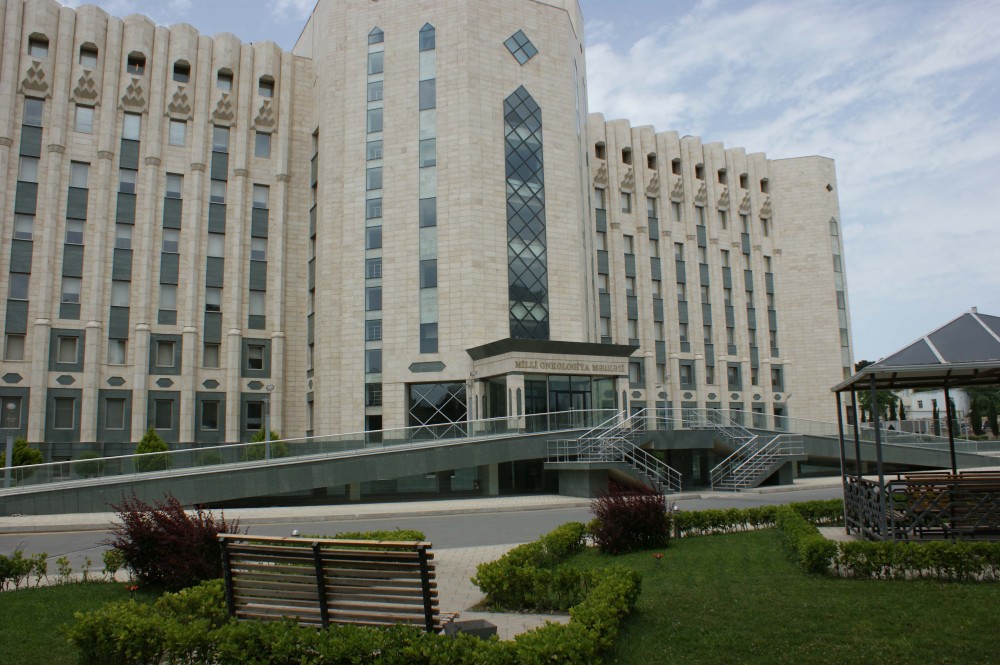
The socio-economic development of the Republic, as in all spheres of society, has yielded positive results in the health system. In our time, large-scale measures have been taken to manage health care and strengthen the material and technical base of medical institutions. All these successes contribute to the development of health care by world standards, its consistent integration into the health system of the advanced countries of the world.
The reforms carried out in the country in the field of health care, according to the orders and instructions of President Ilham Aliyev, the built and reconstructed medical institutions indicate that the development of health care in Azerbaijan today continues at the highest level. Successful health reforms in various aspects are aimed at ensuring the health of the population and its establishment at the level of world standards. The use of about 700 health facilities equipped with modern medical equipment and devices in Azerbaijan is a clear example of the attention paid to human health. Today, in our country, the Thalassemia Center, the Children’s Clinic of the National Cancer Center, the Republican Urological Clinical Hospital, diagnostic centers equipped with the latest technologies, etc. it serve the population as necessary. Hospitals equipped with all kinds of modern medical equipment and accessories are adapted to world standards. Equipment from countries such as Germany and Switzerland, which are developed countries of the world, is being supplied to newly commissioned, repaired and rehabilitation health facilities.
Currently, in our country up to 33 thousand doctors, up to 54 thousand medical workers are in the protection of public health.
The development of the healthcare system, strengthening of the material and technical base, personnel potential, and updating the infrastructure are always in the spotlight. As a result of the country’s social policy, the annual increase in funds allocated from the state budget to health care contributes to the improvement of the activities of medical institutions and to the improvement of the level of services in general.
The Heydar Aliyev Foundation, headed by First Vice-President of the Republic Mehriban Aliyeva, has exceptional services in the implementation of a number of state programs in the field of health. Thus, the foundation has signed a number of major projects in the organization of care and treatment for patients with diabetes and thalassemia, blood donation actions, improving the health of mothers and children.
Laboratory tests, some medical equipment, and supplies necessary for diagnosis and treatment were brought to the country during the coronavirus pandemic, which covers the whole world today. Numerous laboratories operate in the country to conduct tests. During the coronavirus pandemic, the resilience of the Azerbaijani health system, the ability, and the dedication of our doctors was once again proved. During the pandemic, financial and humanitarian assistance was provided to more than 30 foreign countries from Azerbaijan, as well as to international organizations, including the World Health Organization, with a voluntary donation of $ 10 million.
At the same time, the most reliable vaccines have been brought to Azerbaijan against COVID-19, and vaccination of the population on an unpaid basis is underway.
At present, in order to improve the quality of medical services in the country, compulsory medical insurance is being applied in order to ensure the accessibility of the population to these services. To this end, the state agency for Compulsory Health Insurance “public legal entity was established by the Decree No. 1125 of the president of the Republic of Azerbaijan dated November 24, 2016.
In connection with the introduction of compulsory medical insurance, a public legal entity “Azerbaijani Management Union of Medical Territorial Units” was established in order to manage medical institutions and carry out control in this field.

The public legal entity “Management Union of Medical Territorial Units” was established according to Decree No. 418 of the president of the Republic of Azerbaijan dated December 20, 2018. In order to implement the decree, on April 12, the Cabinet of Ministers of the Republic of Azerbaijan adopted a decision to approve the list of medical institutions subordinated to the medical staff. The decision came into force on January 1, 2020.
The main task of the “Management Union of Medical Territorial Units” manage medical institutions related to the application of compulsory medical insurance and carry out control in this field.
The main purpose of the activity of the “Management Union of Medical Territorial Units” is to provide the organization of medical services for the protection of the health of the population in the subordinate medical institutions and to take measures to improve the quality of medical services.
“Management Union of Medical Territorial Units” will create favorable conditions for the population in the field of Health Protection, adapt the activities of medical institutions to the requirements of the compulsory health insurance system. It will monitor the quality of medical services in medical institutions in accordance with modern requirements.
On January 1, 2020, the phased implementation of compulsory medical insurance began in the country.
Within the framework of compulsory health insurance, citizens can obtain the following services:
Emergency and emergency medical care (including ambulance service);
Primary health care (family doctor) service;
Examination and treatment in outpatient settings;
Inpatient treatment;
Functional-diagnostic examinations;
Physiotherapeutic services;
Laboratory examinations;
Pregnancy and childbirth service;
Emergency vaccines;
Planned vaccination based on the vaccination schedule of children;
Surgical operations (including vitally important open and closed cardiovascular operations with high cost).
SPORT HISTORY

Just like the ancient history of the people of Azerbaijan, the history of physical education and sports has also started a long time ago. There have been a number of inventions significantly affecting the development of society in the Stone Age. The invention of the “bow and arrow” among these discoveries is a clear example.
We can come across writings and dances reflecting various physical movements of people yet two thousand years BC when bronze instruments were being used in Azerbaijan (Bronze Period). Ancient petroglyphs of Gobustan are a bright example of this. Numerous images and drawings on rocks depict hunting scenes, animal figures, dances, and other physical movements of people.
The great poet of Azerbaijan Nizami Ganjavi, who lived in the 12th century, had described the braveries of the heroic sons of the people of Azerbaijan and particularly the mastery of wrestlers in his famous poems. There is plenty of information about physical movements in the cultural monuments related to written and verbal folk creativity of the ancient East.
Such types of sports as gymnastics, swimming, athletics, heavy athletics, and football started to develop in Baku at the beginning of the 1900s. A school of swimming was established in Baku in 1910 by a teacher of Baku Gymnasium V. Gricbovski. The life of another teacher from Baku Gymnasium Leonid Romanchenko is also remarkable in this regard. In 1912 a teacher from Baku Gymnasium Leonid Romanchenko swam 48 kilometers in the Caspian Sea in 24 hours 20 minutes. This was an unseen result for open sea marathon participants of that time. Thus Romanchenko passed the record of the former record holder Burgess, who had swum across the English Channel. However, till 1917 such results belonged to individual sportsmen and nobody was helping these amateur sportsmen to improve their mastery. After this event, the number of people going to Baku swimming school was more than 200. In 1920 such societies as “Sokol” and “Unita”, “Automator”, “Vodnik”, “Rechnik” etc (these societies were transformed to centers of physical education after the revolution) existed in our country. Championships between cities on different types of sports started to be organized starting from 1921. Trade unions of Azerbaijan started to support physical education and sports activities (1922). For the first time in Baku a school for training teachers of physical education was opened (1923). Country boxing (1920), football (1921), weightlifting (1925), Greek-Roman (1924), and free-style wrestling (1928) were held in Azerbaijan. In the May session of 1936, the USSR People’s Commissars Union made a decision about creating voluntary sports societies. According to the order of the Soviet Union Trade Unions Central Department, voluntary sports societies of trade unions were established in 1936. Different children’s sports schools were organized attached to sports societies were established with the order of Azerbaijan LKGI CC. There was 8 children’s sports schools (1941) and 15 voluntary sports society (1958). Currently, there are 14 sports societies in our country.
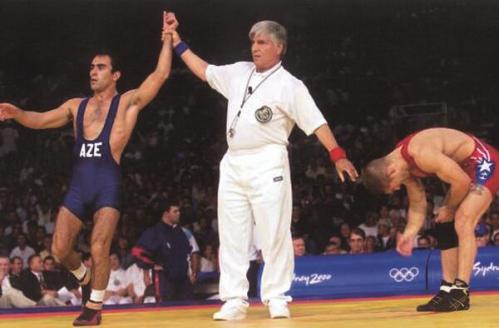
The history of the Olympic Movement (OM) in Azerbaijan can be conventionally divided into three parts: the period of the sportsmen of Azerbaijan participating in the Olympic Games as a part of the USSR national team (1952-1988), a part of the national team of Commonwealth of Independent States (CIS) (1988-1992) and the period after Azerbaijan joined the International Olympic Movement (IOM) as an independent country. As a part of the USSR Olympic team, 46 athletes of Azerbaijan participated in 9 Olympic Games and won 10 gold, 11 silver, and 7 bronze medals. The silver medal that the free-style wrestler R. Mammadyarov won in Helsinki Olympic Games in 1952 can be evaluated as the first success of Azerbaijani athletes in the Olympic Games. The successful performance of Y. Konovalov, A. Kornelyuk (athletics), I. Riskal, V. Lantratova (volleyball), V. Mineyev (modern pentathlon), A. Ibrahimov (free-style wrestling), R. Shabanova, L. Shubina, L. Savkina (handball), I. Mammadov, B. Koretski (fencing), I. Ponamaryov (football) and others increased the prestige of Azerbaijani athletes. Even though Azerbaijan was represented with only 5 athletes in the team of the Commonwealth of Independent States (CIS) in the 1992 Barcelona Olympic Games, two of our sportsmen N. Huseynov (judo) and V. Belinski (gymnast) gained very high results and were honored with the name of Olympic champions. The establishment of NOC and its recognition by IOC in 1992 also started a new period in the Olympic Movement history of our country. For the first time in 1996, Azerbaijan performed under the tricolor flag of the independent Republic of Azerbaijan in the Atlanta Olympic Games with its national Olympic team consisting of 23 people. Taking 61st place in these Games with 197 participants can be considered a sports success of the young Republic of Azerbaijan. And the silver medal that the free-style wrestler N. Abdullayev won in these games is the first medal of the National Olympic Team of the Republic of Azerbaijan in the Olympic Games.
The President of the NOC Ilham Aliyev managed to make a significant positive breakthrough in the activities of the Committee, stimulated the rapid development of the Olympic movement in our country, and maintained its active participation in the movement of the International Games. With its purposeful and consistent performance about the development of the Olympic movement and sports in our country, Azerbaijan NOC gained important achievements in a short time. The Decree of the President of the Republic of Azerbaijan on January 20, 1998, aims to train our athletes for XXVII Summer Olympic Games to be held in Sydney on a high level and ensure their participation in international competitions opened new horizons for more expedient activities of the NOC. As a result of timely and state-level preparation works for the Games 31 sportsmen from Azerbaijan on 10 types of sports participated in XXVII Summer Olympic Games (2000).
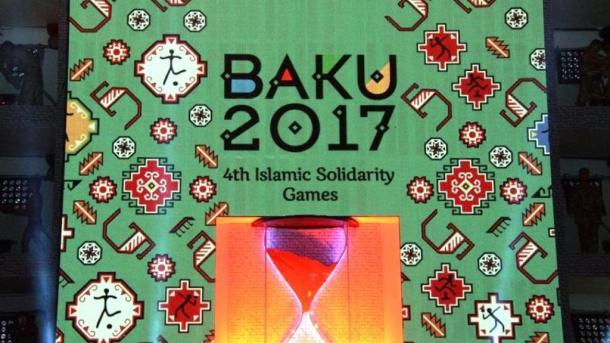
The sportsmen from Azerbaijan demonstrated a very high level in XXVII Summer Olympic Games in Sydney, Australia (15.09.2000). Z. Meftahaddinova (trapshooting) and N. Abdullayev (freestyle wrestling) got gold medals and V. Alakbarov (boxing) got a bronze medal. Taking 34th place among 199 countries from around the world and 23rd place among the European countries in Sydney Olympics was a big victory for our sportsmen. The Decree of the President of the Republic of Azerbaijan Ilham Aliyev about “Preparation for XXVIII Summer Olympic Games” laid the foundations for organizing and ensuring the training of the sportsmen from Azerbaijan for XXVIII Summer Olympic Games on a higher and more organized level (05.06.2013). 38 out of 130 sportsmen who started training for the XXVIII Summer Olympic Games got the honor of participating in the Games. 36 of them were given the right to participate in the Games with a license and 2 sportsmen got special permission with the Order of the International Federation of Swimming (wild card). Our country was represented in the XXVIII Summer Olympic Games with 38 sportsmen on 12 sport types. Compared to XXVII Sydney Olympic Games our sportsmen had joined the Games 3 new types of sports — Rhythmic gymnastics, taekwondo, and fencing, and even more sportsmen had participated in the Games.
With 1 one gold and 4 bronze medals, the national team of Azerbaijan got 37th place for the number of medals and 50th place for the quality among 202 participating countries in XXVIII Summer Olympic Games. Among our national team members were the gold medal of F. Mansurov (Greek-Roman) and the bronze medals of I. Ashumova (sport shooting), Z. Meftahaddinova (trapshooting), A. Mammadov, and F. Aslanov (boxing) played a special role in achieving these results. At the XXIX Summer Olympic Games, the national Olympic team of Azerbaijan 12 — wrestling (freestyle wrestling (7), Greco-Roman wrestling (6) and women’s wrestling (3)), taekwondo (1), gymnastics (group exercises team 6, individual competitions 2), boxing (2), shooting (1), equestrian (1), swimming (2), judo (6), athletics (2) and weightlifting (5) were represented by 44 athletes. In this competition, our representatives differed from other Olympic Games both in the number of athletes and the number of medals won. For the first time at the Olympic Games, our team won medals in all three disciplines. It is interesting that our athletes for the first time tested their strength in the Olympic equestrian competitions and group exercises in rhythmic gymnastics. In addition, Beijing 2008 became the first Olympics in which our female wrestlers will compete. At the XXIX Summer Olympic Games, the national team of Azerbaijan with 7 medals (1 gold, 2 silver, 4 bronze) took 27th place among 204 countries in terms of the number of medals and 39th place in terms of the medal tally. At the XXX Summer Olympic Games, 53 members of the national Olympic team of Azerbaijan were represented in 16 sports. For the first time, our athletes tested their strength in cycling, rowing, women’s boxing, gymnastics. 10,957 athletes from 204 countries participated in the XXX Summer Olympic Games. The Azerbaijani Olympic team is in 30th place with 2 gold, 2 silver, and 6 bronze medals. At the XXXI Summer Olympic Games, 56 members of the national Olympic team of Azerbaijan were represented by 57 licenses in 17 sports. For the first time, our athletes tested their strength in triathlon, archery, canoe slalom, track cycling. At the XXXI Summer Olympic Games, the Azerbaijani Olympic team ranked 15th among 206 countries in terms of the number of medals and 39th in terms of medal count with 1 gold, 7 silver, and 10 bronze medals.
gh.jpg)
295 Azerbaijani sportsmen have participated in XV-XXXI Summer Olympic Games (1952-2012). At present, there are 43 Olympic sports complexes in Azerbaijan. One of the most important international competitions that introduced Azerbaijan to the world and did not cease to be discussed for a long time was the European Games, which we hosted in 2015. This is the first sports competition in its history, and 10,000 athletes from 50 European countries competed in 30 kinds of sports. The 17-day competition ended on June 28 at the Baku Olympic Stadium. The first place in the unofficial medal table was taken by the athletes of the Russian Federation.
After that, Azerbaijan signed an agreement to host a new Formula 1® Grand Prix in Baku in 2016 and hosted this major sporting event. It is planned to hold Formula 1 races in our country every year until 2023. In 2017, we watched another big tournament in our capital. The Islamic Solidarity Games was a multinational, multi-sport tournament. After gaining independence, the number of medals won by Azerbaijani athletes in European, world, and cup competitions continue to grow, and the main reason for this is the attention and care of the state towards sport.
SPORT COMPLEXES
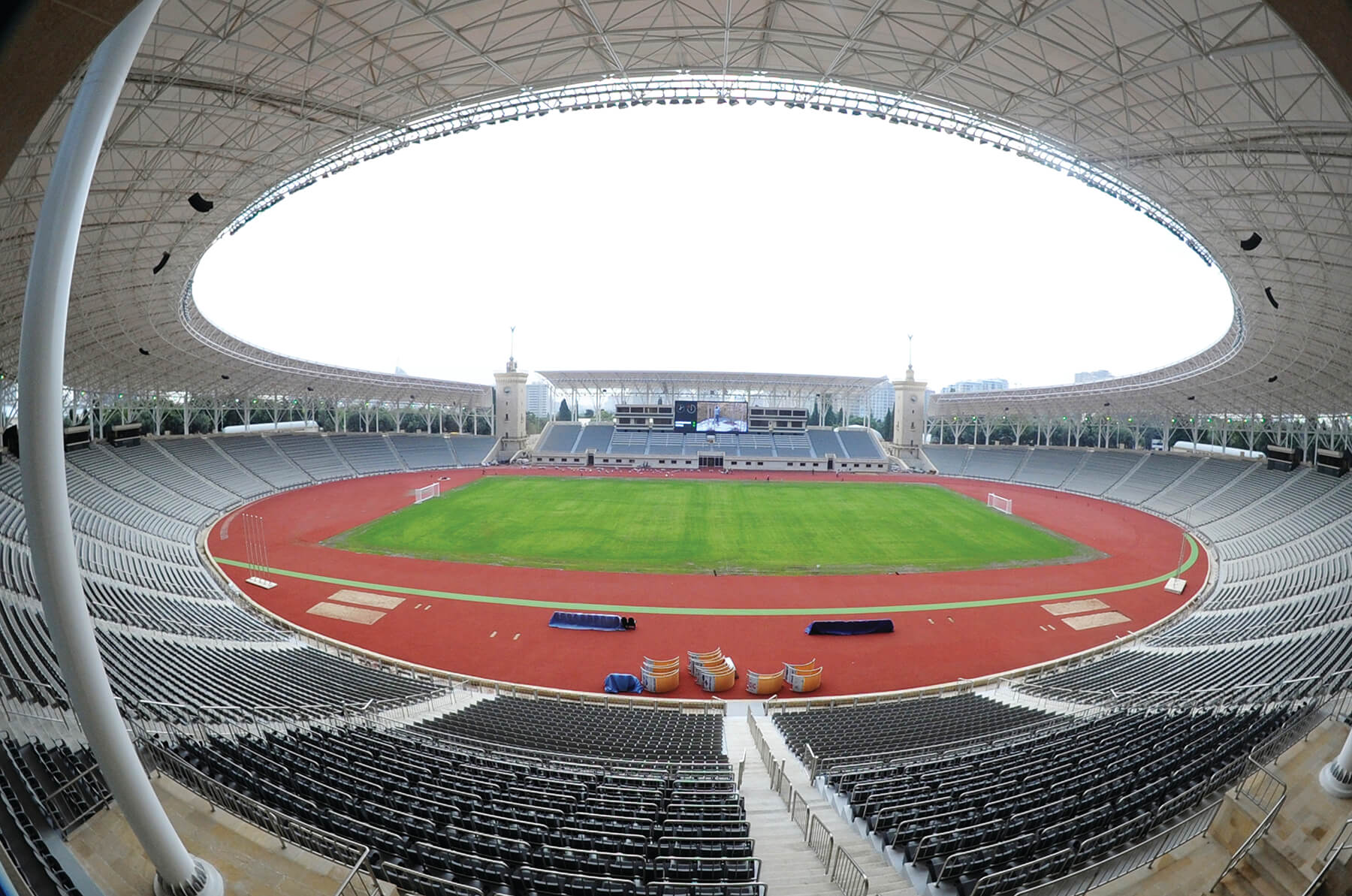
Republican Stadium is named after Tofig Bahramov.
Republican Stadium named after Tofig Bahramov was put into use on the 16th of September 1951.
The total area of the stadium is 20 hectares. The main football field of the stadium is 105×72 meters. The athletic track of 8 paths set around the field is 400 meters long. There are several additional sports halls at the stadium. It includes a wrestling hall of 25 m wide and 50 meters length and a boxing hall (25mx10m), 2 mini-football halls, 1 outdoor football pitch.
Republican Stadium named after Tofig Bahramov started functioning on August 16, 2012, after major repair and reconstruction work. The number of seats was increased to 31,200. A ticket office was built at the entrance of the stadium. A tollgate system, which allows the passage of 50 people simultaneously, was installed in the stadium. An electronic monitor in a length of 30 meters was set up on the front facade of the building.
Formerly this stadium was named after I. Stalin and V.Lenin then in1993 it was named after Tofig Bahramov, the worldwide football referee.
Baku Sport Palace
The Baku Sports Palace located in Seaside National Part was built in 1974. In 2015, it was reconstructed in accordance with modern requirements. The badminton and table tennis competitions of the First European Games were held in this palace. To increase the number of spectators in the hall, a bilateral platform was constructed additionally. If the number of seats was 1100 before reconstruction, consequently this figure reached 1736. A special wooden cover was installed in the main gym. Taking into consideration disabled spectators and full-scale usage of all areas of the building by Paralympians, 6 lift shafts and modern lifts were installed inside. A cafe for spectators and athletes also functions in the Baku Sports Palace. In addition, the lottery room, press room, VIP rooms, and other ancillary rooms meet high standards.
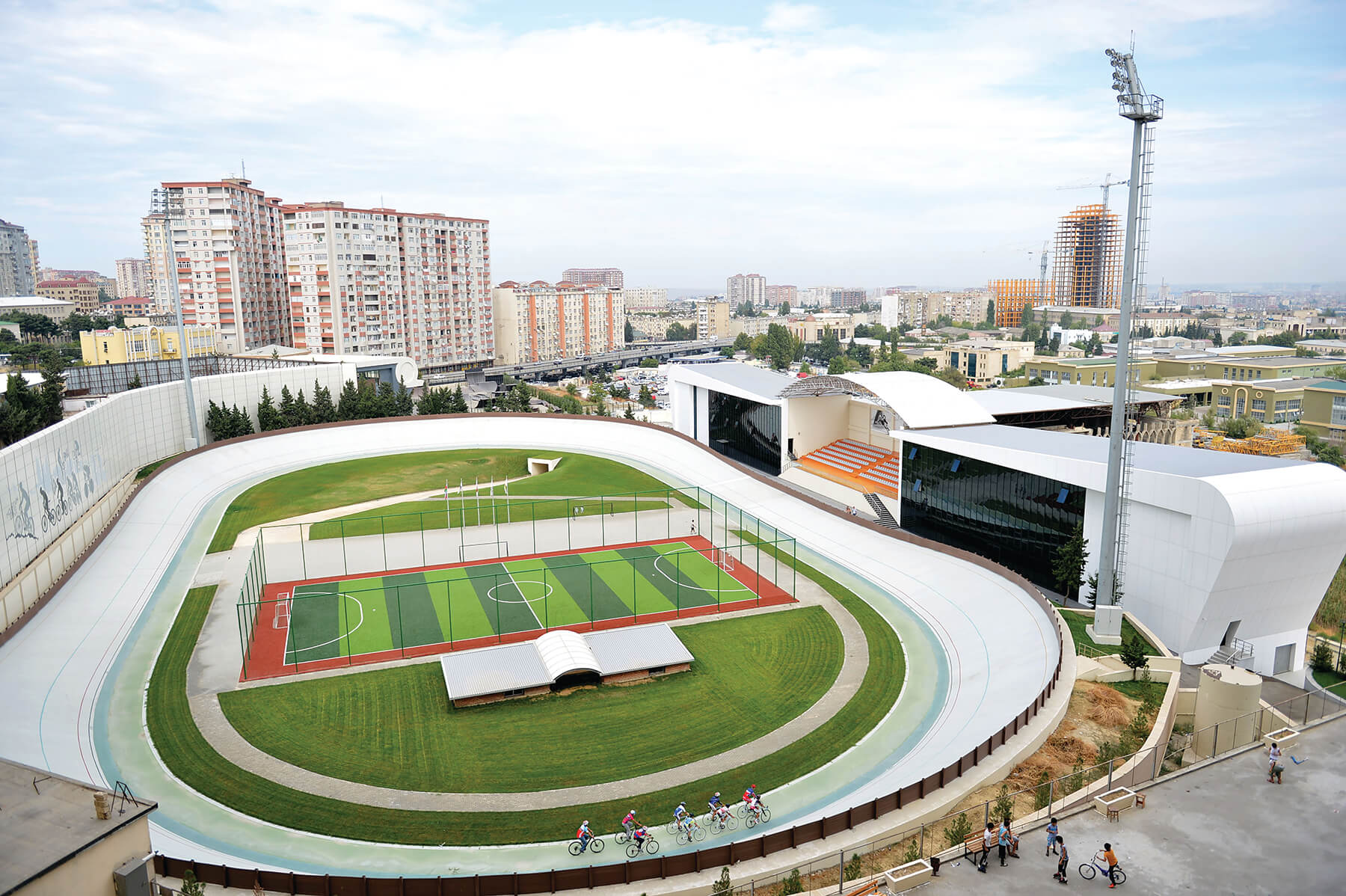
Republic Velodrome
Republic Velodrome in Baku started functioning in 1980. The Velodrome, which is situated near the metro station “20 Yanvar”, has been reconstructed recently. The concrete cover of the track is 333 meters and 33 centimeters, and its total area is 13 hectares. At the moment, in addition to the main cycling track, there is a mini-football pitch, “Pamp park” for the training of BMX bikers, bike store, and instruction rooms for cyclists in the Republic Velodrome, which meets the latest standards.
In the administrative building of the Velodrome, with a total area of 4,620 m2, there is a small hotel, apartments for coaches, and training rooms for cyclists.
Republican Olympic Center
Republican Olympic Center is located in the central part of Baku city — in Narimanov district, near “Ganjlik” underground station. The center is surrounded by the Youth and Sports Ministry of the Republic of Azerbaijan from one side and by the National Olympic Committee from the other side. It has been functioning since 1982. However, it was completely reconstructed in 2007 and again was put into use.
The total area of the center is 0.22 hectares. The athletics hall of the center is 96 m in length and 30 m wide. New running tracks with 6 paths (3 round paths, 3 straight) are established around the athletics hall. Round paths are 2000 m, 207 m, and 217 m correspondingly. Straight paths are 100 meters.
The hall was also supplied with modern equipment for practicing hurdles, pole vault, and high jumping disciplines of athletics. The newly established ventilation and lighting system of the center meet international standards.
Heydar Aliyev Arena
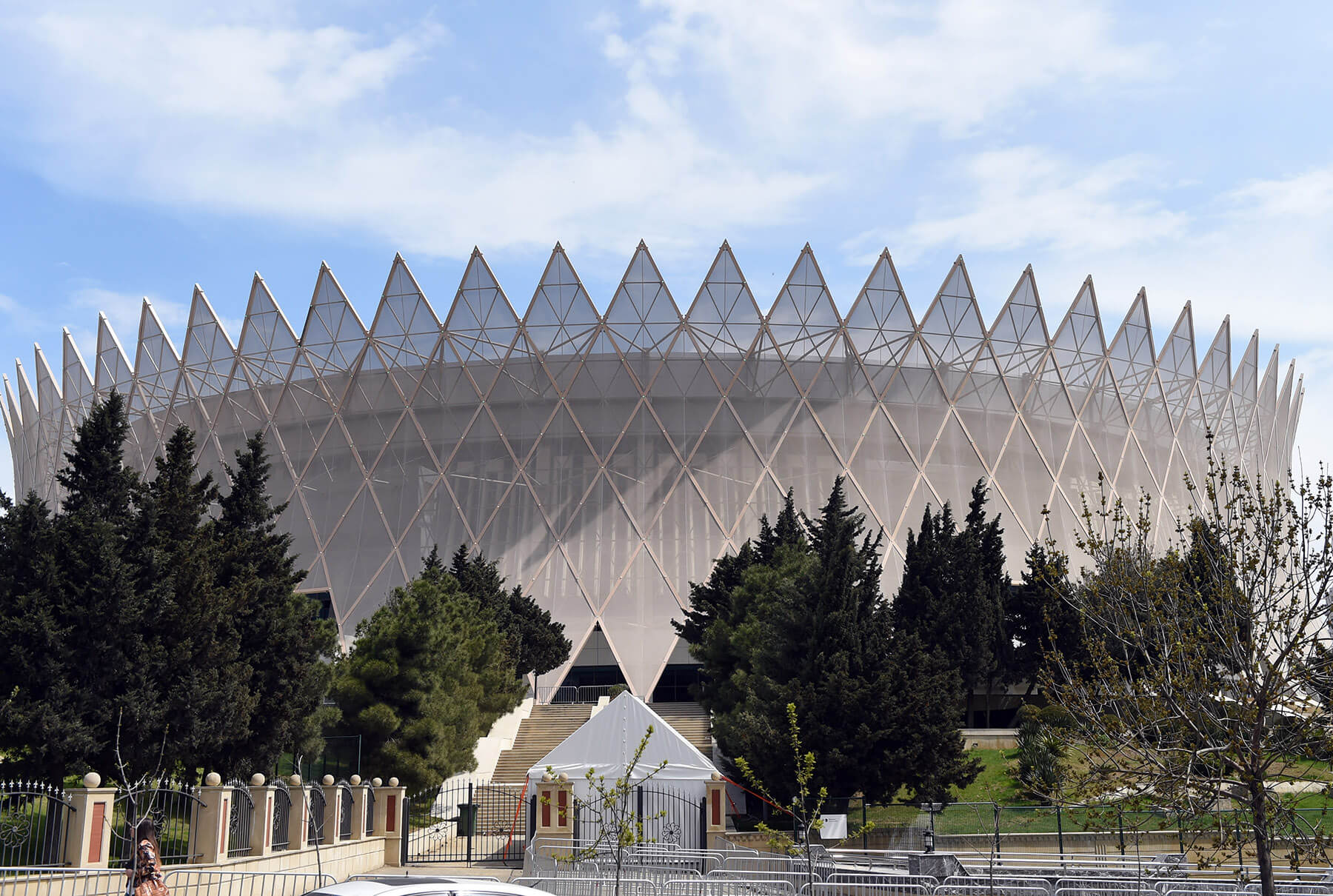
The Heydar Aliyev Sport and Concert Complex is one of the largest closed sports centers in Azerbaijan. The sports facility is considered one of the architectural masterpieces of the capital — Baku. The construction of the building started in 1976 — under the leadership of the great leader of the Republic of Azerbaijan, Heydar Aliyev. It started functioning in November 1990.
The construction area of the complex, with a total area of 6.1 hectares, covers 3.5 hectares. The size of the main hall of this huge sports facility is 70×40 meters; a total area of which is 2,800 square meters, while the stands have a capacity of 7,800 spectators. There are also gymnastics and fitness rooms, each with an area of
650 square meters (37×17), as well as a basketball room with an area of 1,600 square meters (35×45 meters). The complex also includes ice hockey and figure skating halls.
In 2015, the Complex was reconstructed in accordance with modern requirements. 16 sports competitions, as well as various exhibitions, concerts, circus performances, and public forums, can be held on the main ground of the Complex.
Baku Olympic Sport Complex
Baku Olympic Sports Complex is the first sports facility of this type in the country.
In the opening ceremony of the complex, which opened its doors to athletes with the blessing of the great leader of Azerbaijan Heydar Aliyev, on October 2000, 21, the current president of the International Olympic Committee, Mr. Jacques Rogg, also attended.
The complex was opened on October 21, 2000. The complex consists of 2 halls. The great hall has a capacity of 560 people and is mainly intended for team sports. In the second half with 430 people of capacity, the conditions have been created for combat sports. At present, rhythmic gymnastics and volleyball sports are being developed at the complex.
Mashtagha Olympic Sports Complex
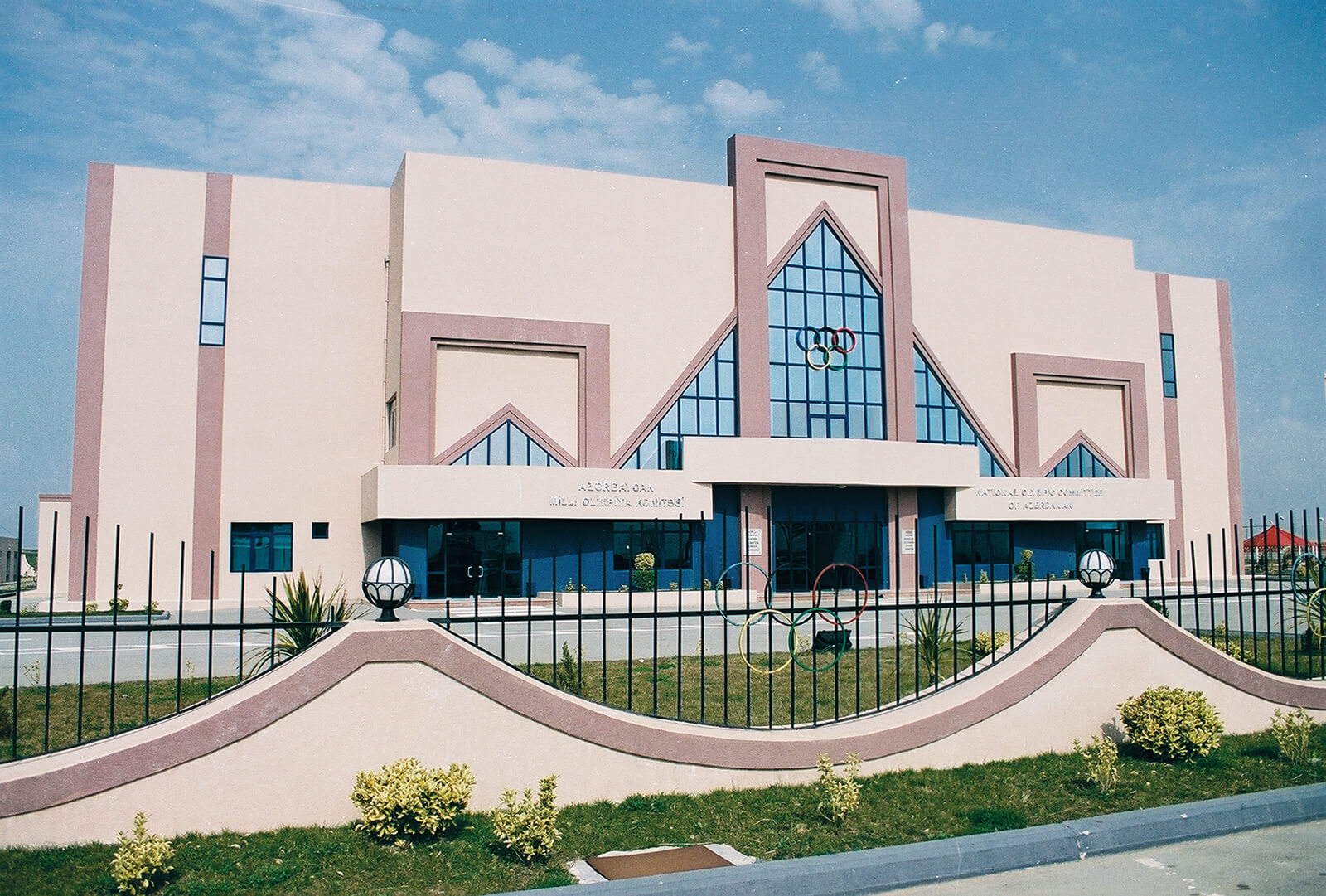
The complex was put into operation on December 29, 2001. This complex is designed engagement of young people living on the edge of the city in physical training and sports. However, this place became more common for the organization of sports competitions at the republican level.
In the hall with 600 people of capacity, one can be engaged in handball, football, volleyball team sports, as well as individual sports like wrestling, judo, weightlifting, karate, etc. There is a tennis court, light athletics stripe, and playground for volleyball.
Currently, judo, kickboxing, and karate sections are functioning at the Olympic-Sport Complex in Mashtagha.
Paralympic Sport Complex
Paralympic Sports Complex was put into use on the 28th August 2008 in Sumqayit city. All conditions for holding republican and international scale competitions, organization of training are created in this complex. The total area of the complex is 2,25hectares area. Equipped with modern equipment, the complex includes an assembly hall for 130 people, a gym, a hand games hall, big and small shooting halls, outdoor football and volleyball fields, and an indoor swimming pool. Necessary conditions have been created for unrestricted movement of the disabled and modern elevators are set here. The indoor swimming pool is 25 meters long and 10 meters wide.
The main sports hall is intended for judo, wrestling, and hand games competitions. The special ventilation system set here makes it possible to refresh the air and to keep it at a stable temperature. 210 spectators can watch competitions in the hall of 32 meters long and 24 meters wide.
The complex has shooting ranges. The shooting ranges are 25 m x 12 m and 10 m x 12 m each. Conditions for holding training and international competitions are created here. Eight shooters simultaneously can train in shooting ranges. The complex is located in Sumgayit city, the third-largest city of Azerbaijan.
Baku Tennis Academy
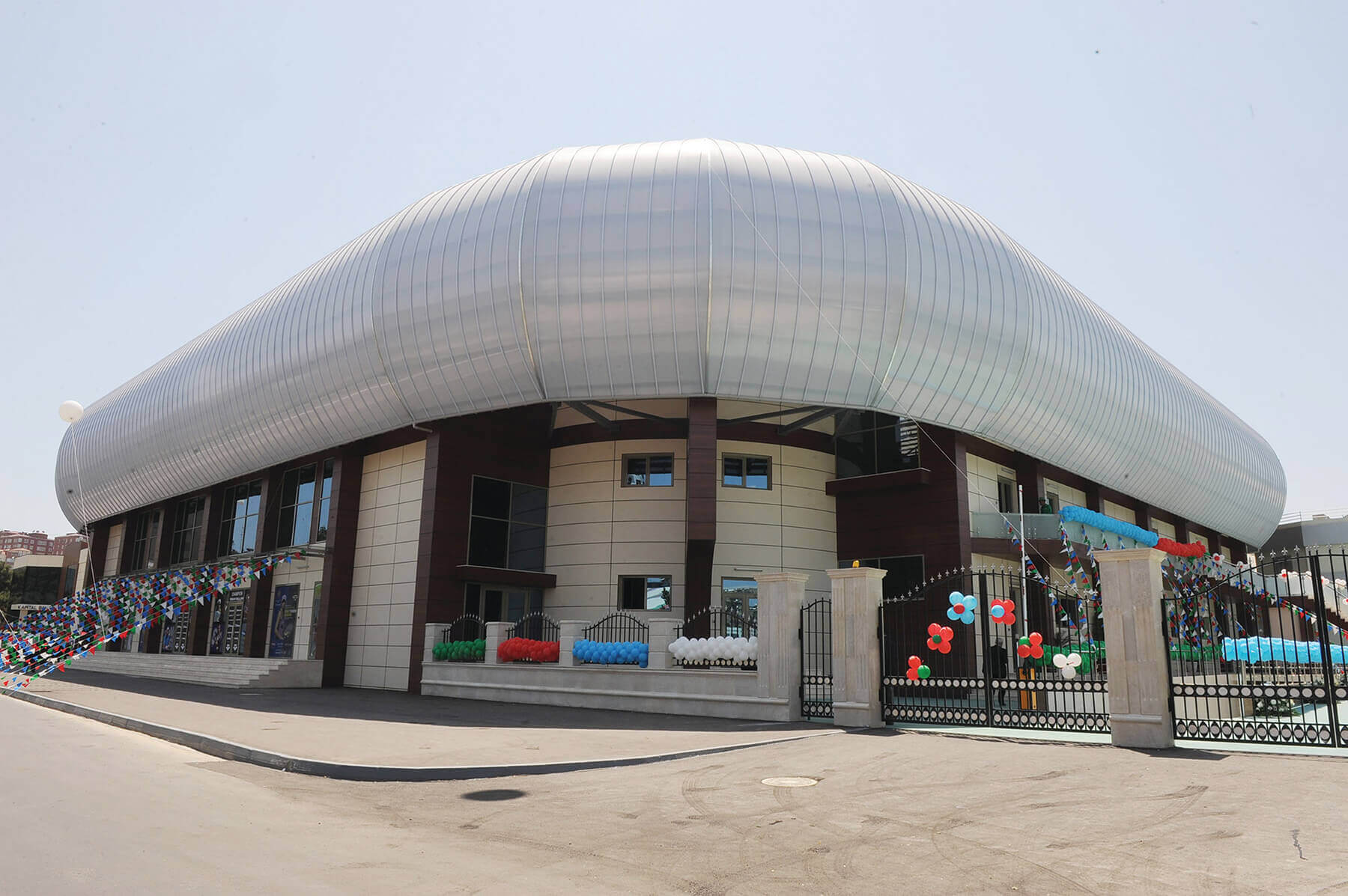
Baku Tennis Academy was put into use on the 5th may, 2009 and it is the first sports facility of such type constructed in Azerbaijan. The total area of the academy, located in the 8th district, is 2,7hectares.
There are all conditions for practicing this discipline in the center occupying 4070 m2 including the main court.
Conditions meeting international demands are fostered in the indoor hall with 407 spectator capacity, which is 126 meters long and 36 meters wide. The area of each court corresponds to 670 m2 international standard.
Heating and ventilation systems of modern requirements make it possible to host here local and international scale competitions in all seasons of a year.
A swimming pool and a training hall were put into exploitation in the territory of Baku Tennis Academy.
In addition, a central universal stadium with a total area of 2,510 square meters with a capacity of 3 thousand spectators has been built in the complex.
Championships and tournaments can be hosted here not only in tennis but also in volleyball, mini-football, basketball, handball, beach volleyball, wrestling, boxing, and other sport disciplines.
« Sarhadchi » Sports Olympic Centre
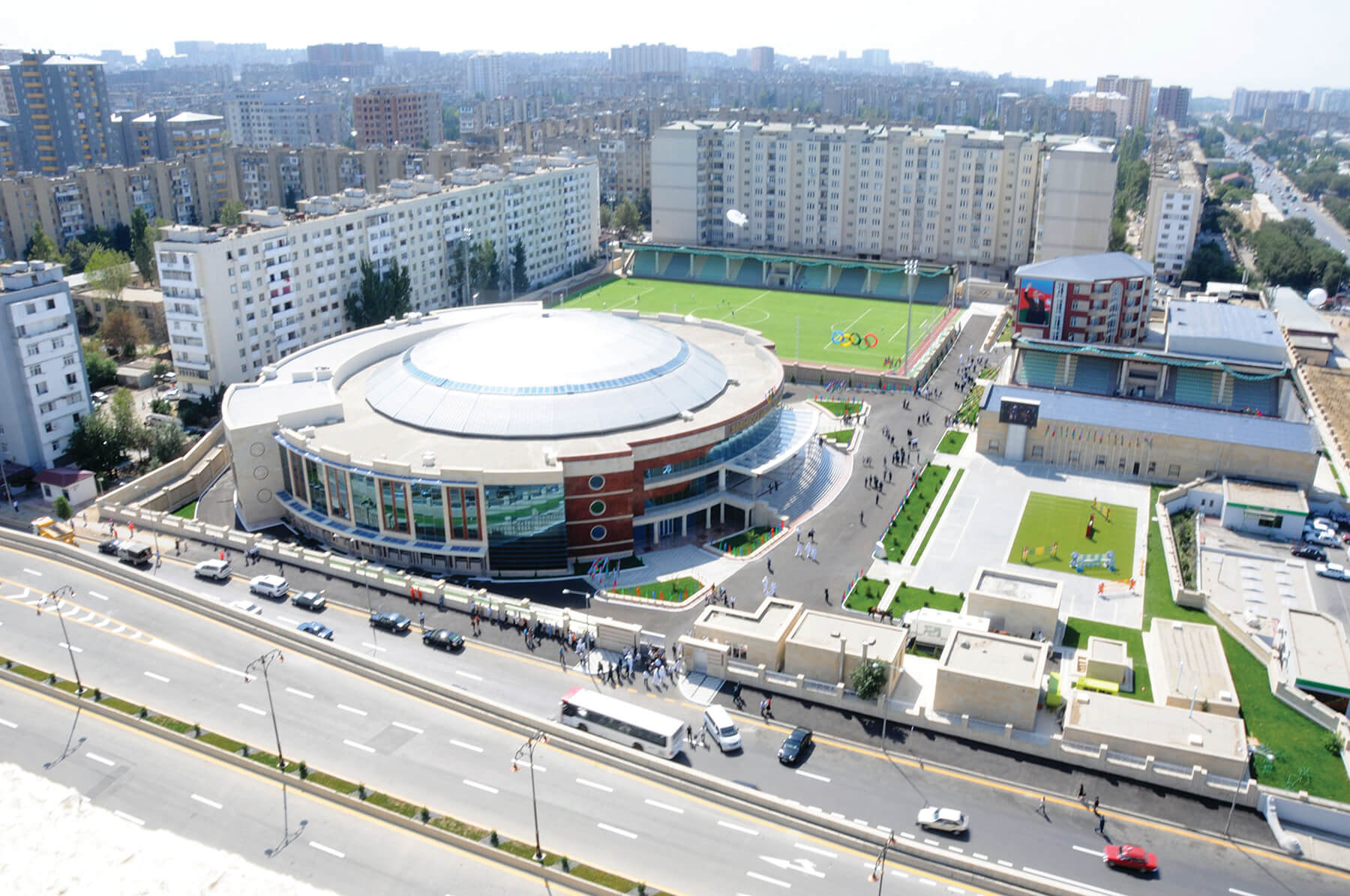
The « Sarhadchi » Sports Olympic Centre run by Azerbaijan Republic State Border Services (ARSBS), has been open since 31 August 2009. Located in the Khatai district of Baku city, the sports center surrounds a 37.300sqm area. The construction of the sports facility, which began in 2007 and was completed in a short time, consists of a three-storey universal hall, 2 outdoor areas for various sports, a swimming pool, a parking lot, ancillary buildings, and a hotel.
The universal hall in the center was built on the basis of a special project. There is a non-support coating consisting of a unique metal structure. This dome has a diameter of 53 meters and weighs 360 tons. With its own weight, it can carry up to 900 tons. Natural air is automatically supplied to this hall through a dome equipped with German equipment. The windows in the dome open automatically at any time and fresh air enters.
In addition to the universal hall with a capacity of 2,500 spectators, the Sarhadchi Olympic Sports Center has a swimming pool, a fitness room, weightlifting, rhythmic gymnastics, training halls for various martial arts, coaching rooms, saunas, warehouses, and laundry on the first floor.
The international competitions held here can be watched by 2,500 spectators.
The five-storey hotel has 32 rooms equipped with furniture and other household appliances. There is also a cafe-restaurant here. All conditions have been created here for the athletes to rest after the training and training process and competitions of various levels. Special devices installed in the swimming pool control the constant maintenance of water temperature. At the same time, appropriate devices have been installed to constantly update the water in the pool. The stadium’s Square, built in the center, is covered with high-quality artificial grass cover. The capacity of the stadium is 1850 people.
Along with border guards, the services of the center are also used by ordinary citizens who are members of the Sports Club “Sarhadchi”. It is possible to engage in 32 sports at the same time.
Hovsan Olympic Sports Complex
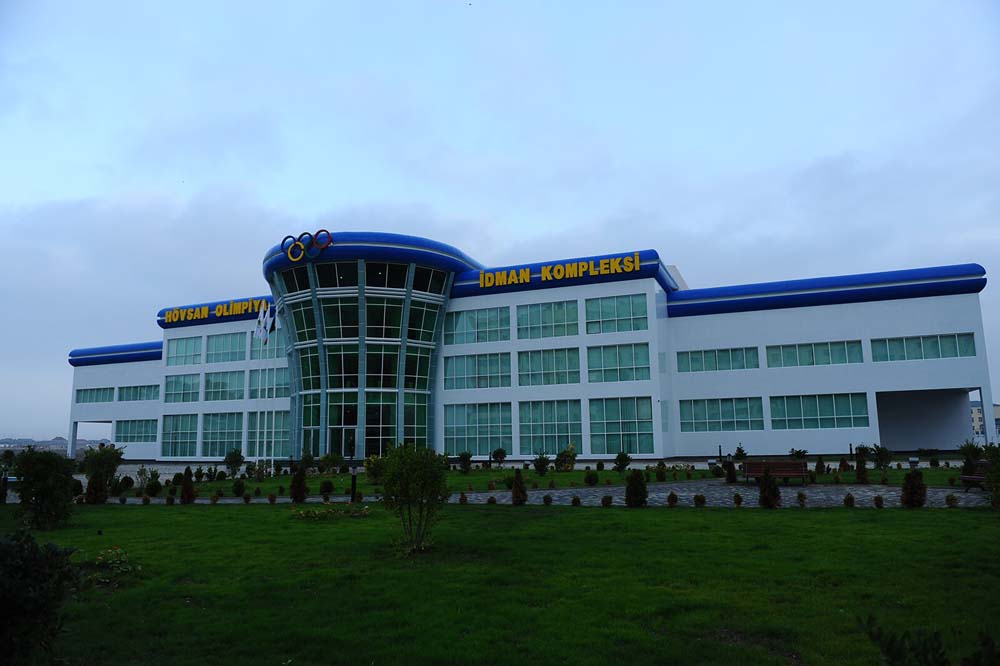
Hovsan Olympic Sports Complex was put into operation in October 2009, 15. The total area of the three-storey main building of the complex is 4.5 hectares and is 19 thousand square meters. The size of the gym is 47.5×41.20m. There are 1730 seats for spectators watching the races here. The swimming pool in size (25×12 m) has 122 seats.
A small sports hall is designed for wrestling, boxing, and other types of sports, and 200 seats have been installed here. In addition, the main building has locker rooms for athletes, commentator and coach rooms, and other service rooms. In the game rooms of the complex, it is possible to hold mini-football, basketball, volleyball, as well as international competitions in gymnastics, boxing, and wrestling. On the second floor of the building, there are training rooms and administrative rooms. On the third floor, there are rooms for athletes.
There is a Archery Hall with 100 seats in the open air (130x40m), tennis court (44x22m), mini football (44x22m), basketball and volleyball grounds (44x22m). An indoor shooting range (45×13.5m) has also been built.
Baku Olympic Stadium
Baku Olympic Stadium was founded in 2011 and it started functioning on March 18, 2015. The stadium constructed in an area of approximately 50 hectares, with a height of 62 meters, consists of 6 floors. The pitch has 4 and the stands have 26 entrance gates. The stadium with a capacity of 68,000 seats is designed in accordance with Olympic standards to ensure easy access of spectators by public transport and on foot. Therefore, it includes a parking venue of 3,100 car places.
This huge sports facility is distinguished with modern architectural style, special beauty, and functional availability. Multifunctional stands, running tracks, and other infrastructure were established in the stadium that is in accordance with international standards. The stadium, which consists of the main and ancillary stadiums, as well as ancillary building, includes sections for the disabled, VVIP, VIP, CIP, and media.
The Opening and Closing Ceremonies for the First European Games, as well as Athletic competitions, were held in this stadium.
Baku Crystal Hall
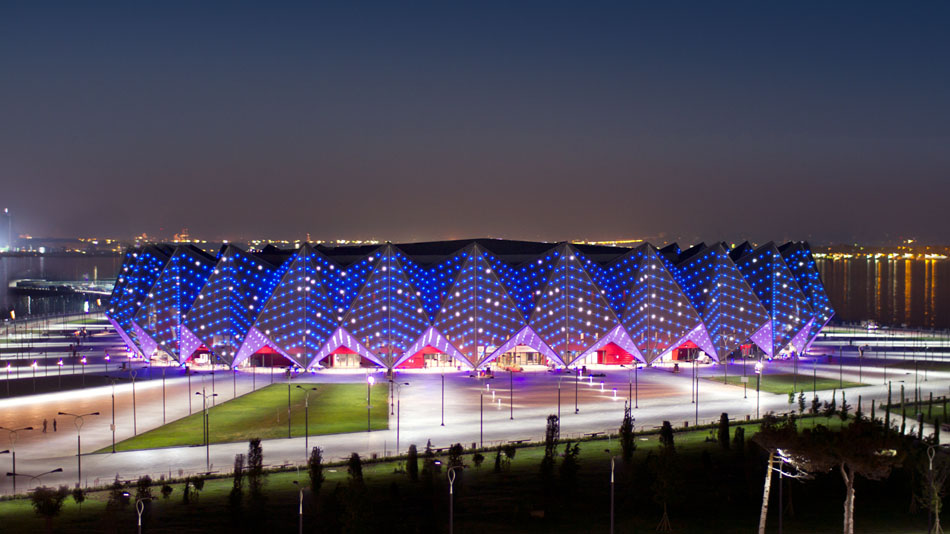
Baku Crystal Hall, which started functioning on May 7, 2012, is mostly used as a sports facility. This enormous facility is located on the Baku coast of the Caspian Sea, near National Flag Square.
The presentation of “V1 Challenge Azerbaijan” automobile sports competition, volleyball, boxing, karate, taekwondo and fencing competitions of the inaugural European Games, world chess Olympiad, Champions League games among women volleyball teams, as well as other country-wide competitions were held in this arena. Some competitions of the IV Islamic Solidarity Games will be held in Baku Crystal Hall consisting of three parts.
The 25-thousand-seat complex is distinguished with its original architecture and contributes to the special architectural structure of the capital.
The Eurovision Song Contest was held in Baku Crystal Hall in May 2012.
National Gymnastics Arena
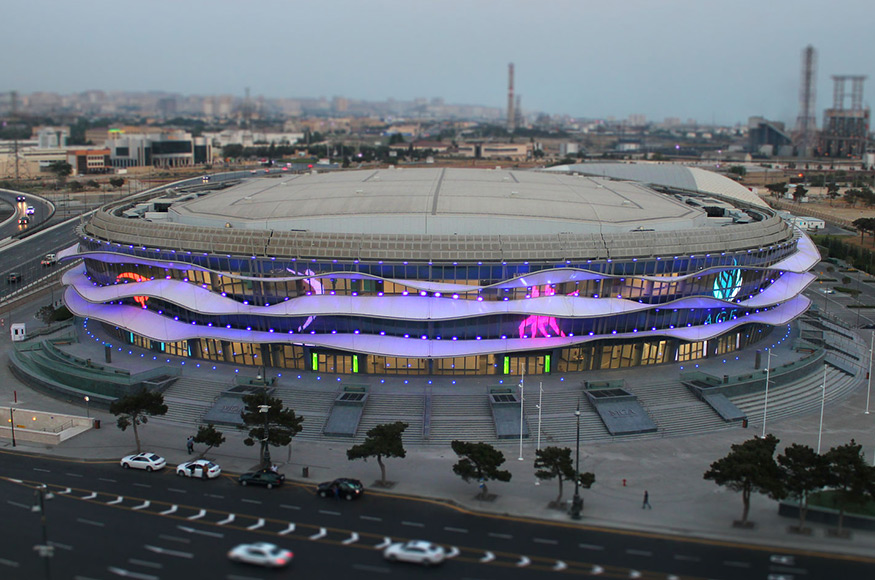
The National Gymnastics Arena in Baku started functioning on April 16, 2014. The arena is located in Heydar Aliyev highway, near the “Koroghlu” metro station. The highway connecting Heydar Aliyev International Airport to the city is the main way of access to Baku.
The facade of the building has a special form. One of the most important features that increase the importance of the arena, which is mainly designed for gymnastics competitions, is the fact that it can be adopted for other sporting events and competitions.
The gym consists of a major competition and ancillary training parts. Depending on the scale of the competition, the number of seats in the arena can be increased from 5,000 to 9,000. The complex built in accordance with the international standards includes the press center, first aid station, choreography, fitness rooms, doping control rooms, administrative offices, shops, cafes, and other ancillary facilities.
This sports facility, which is one of the best gymnastic complexes in the world, includes its own hotel, as well.
Baku Shooting Center
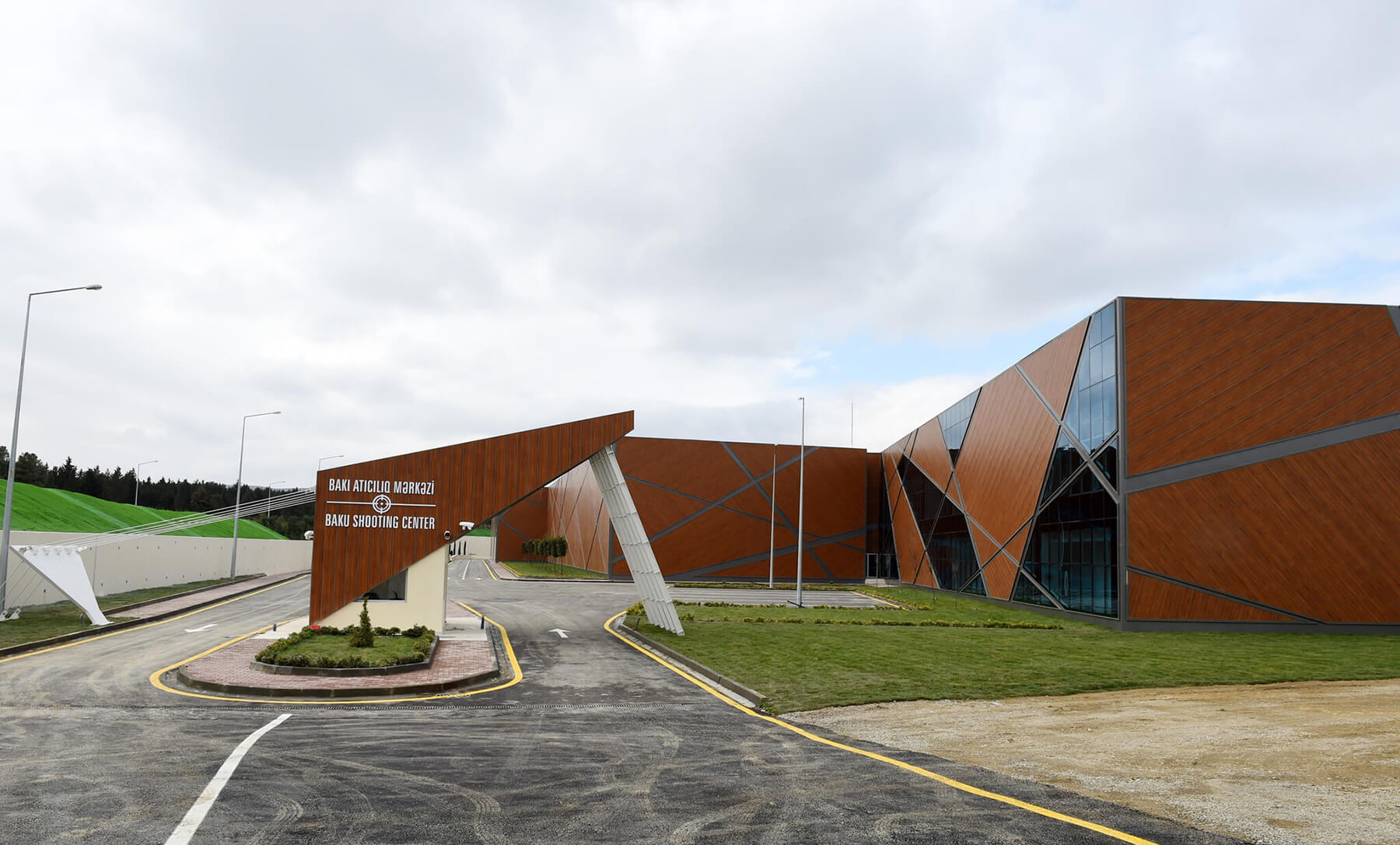
Baku Shooting Centre started functioning on March 9, 2015. This center is one of the largest shooting complexes in Europe and it is located in the Bilajari settlement of Baku. The area of the functional zones of the center is more than 123,000 square meters. The building includes various functional areas, a cafe, a VIP waiting and recreation, management, training, doping control, weapons storage, 55-seat 2 conference and media rooms, a medical center, and a fitness hall. Shooting competitions at distances of 10, 25, 50 and 300 meters can be held in the center. The firing line allowing 80 athletes to compete simultaneously was constructed in a ten-meter indoor shooting range. 50 athletes can compete simultaneously in a twenty-five-meter half-open shooting range. 346 seats were constructed in the center. The line of fifty-meter half-open shooting range allows 80 athletes to test their ability simultaneously. Three-hundred-meter half-open shooting range provides huge opportunities for high-level organization of competitions. 40 athletes can test their ability simultaneously in this range. In closed shooting ranges at the distances of 10, 25, and 50 meters designed for final competitions, 15 athletes can compete simultaneously.
5 shooting grounds for trap shooting were constructed in the building. 75 target throwing machines for trench shooting were installed on these grounds. There are 10 target-throwing machines in 5 towers constructed for circular shooting actions. The center has a hotel building consisting of four floors and a terrace.
Baku Aquatics Palace
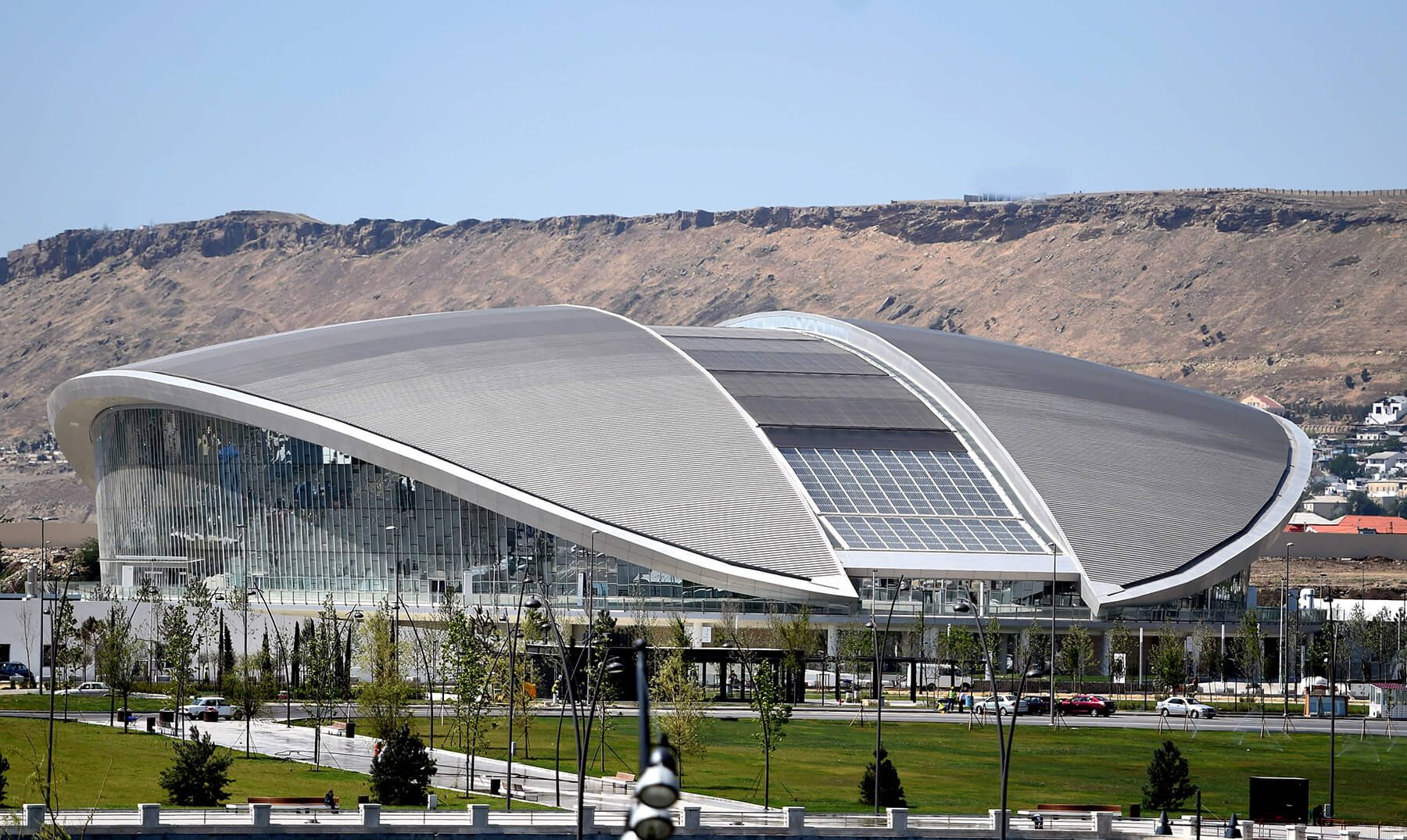
Aquatic Centre located in Bayil settlement of Baku, in the newly built part of Baku Boulevard started functioning on April 20, 2015. The sport center with the area of 6 hectares covers in total 72,000 square meters. It is in compliance with the requirements of the International Swimming Federation. The center includes three swimming pools. The main pool, 50 meters in length, 25 meters in width, and 2.5 meters in-depth, is designed for different types of water sports competitions at local and international levels. The length of the pool for diving in the main hall is 25 meters in height. Five stage platform was built for high board diving from a height of 1, 3, 5, 7,5 and 10 meters. The swimming pool constructed for training in the second hall of Aquatic Centre is 51 meters in length and 20 meters in width. More than 6,000 spectators can watch sports competitions at the palace simultaneously. Moreover, the center includes a 150seat restaurant, the sectors for VVIP, VIP, the disabled and media. The building has fitness acrobatics and weightlifting halls with special training platforms and equipment for swimmers. In a part of the roof of the building “SKY LIGHT” special panoramic glass panels were used. These glass panels convert solar energy into electricity.
Baku European Games Park
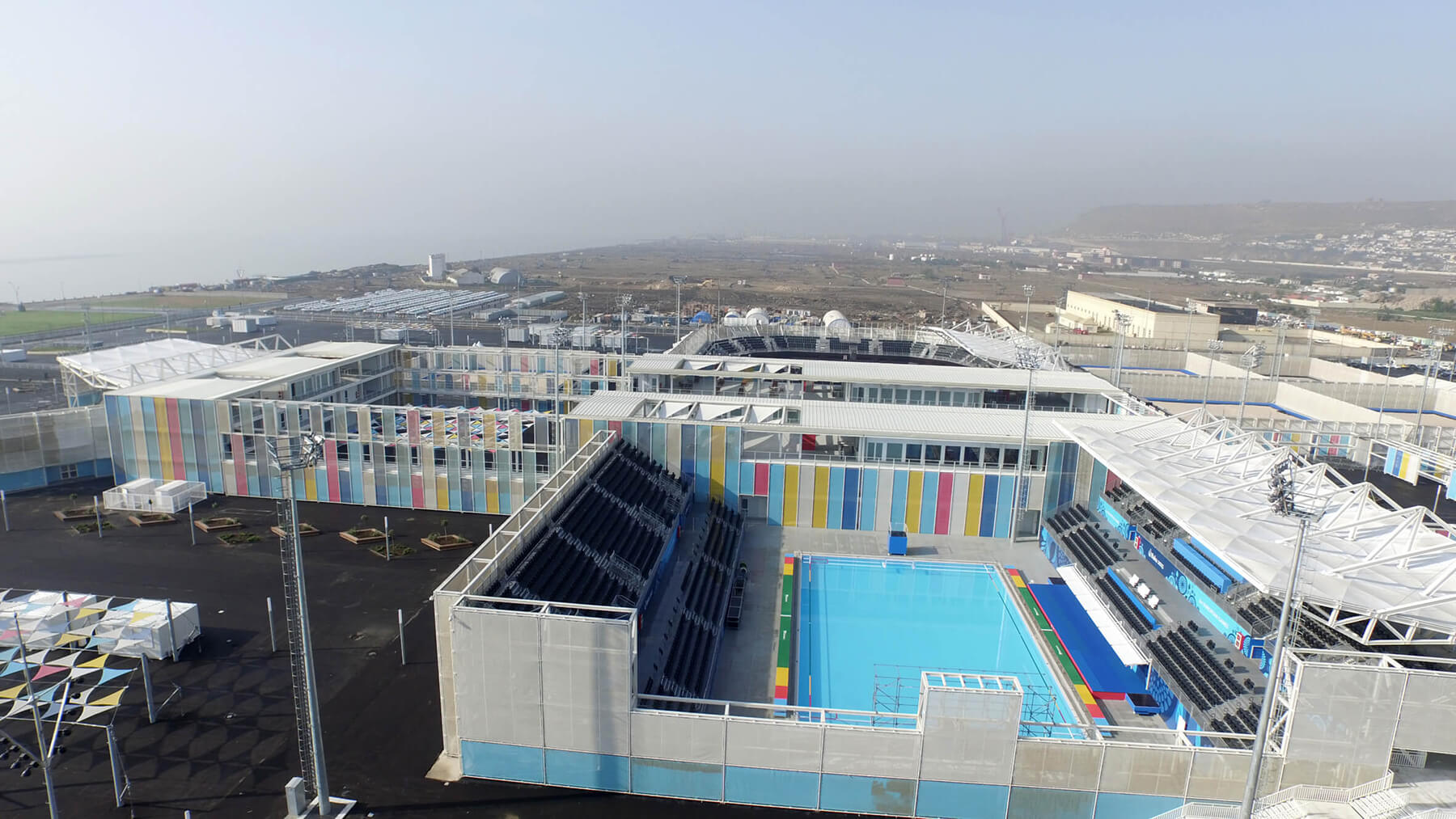
European Games Park started functioning on May 13, 2015. This sports park was designed for water polo, beach volleyball, beach soccer, and basketball competitions. The park consists of three sports facilities and four functional zones. The total area of the facility is 18 hectares; the construction area is close to 70,000 square meters.
Functional rooms located in the water polo competitions complex of the European Games Park are of high quality. There are meeting and pressrooms, café, and VIP areas in the building. 1,836seat and 560seat two swimming pools meeting international requirements were built in the complex. The regulating water pool was constructed, as well.
Two-storey functional transition was built between water polo and beach volleyball, and beach football competitions complexes.
The basketball complex of the European Games Park was also constructed in accordance with international standards. There are favorable conditions for the 3×3 type of basketball. The 2,008 seat stand 11 meters in width and 15 meters in length designed for final competitions were constructed. Furthermore, three pitches were provided for athletes in the complex. Each of them has a capacity of 376 spectators. The park’s beach volleyball and beach football competitions complex has all the conditions to practice these sports. There are 2,931 seat pitches designed for final competitions, every 302 seats three ordinaries and two training pitches in the complex.
Velopark
Velopark started functioning on May 13, 2015. Large-scale renovation work was carried out in an area of 40 hectares in 2014-2015, thousands of trees were planted, 4 bike race routes, including mountain cycling road, were constructed. Relevant competitions if the First European Games were held in BMX Velopark located in the Velopark with a total area of 30 hectares. A ground with barriers, the area of which 6700 square meters, was constructed in BMX Velopark with an area of 28 thousand square meters. In BMX Velopark equipped with all necessary facilities for competitors and fans, 1197 seats were installed for spectators. The registration center business, doping control, doping sample analysis rooms, 25-seat conference hall, and other ancillary rooms were constructed in the two-storey office buildings built in the area of Velopark. Start pitch with special surface and 20 tents for the training of athletes were set up in the roof of the office building.
Nakhchivan Olympic Sports Complex
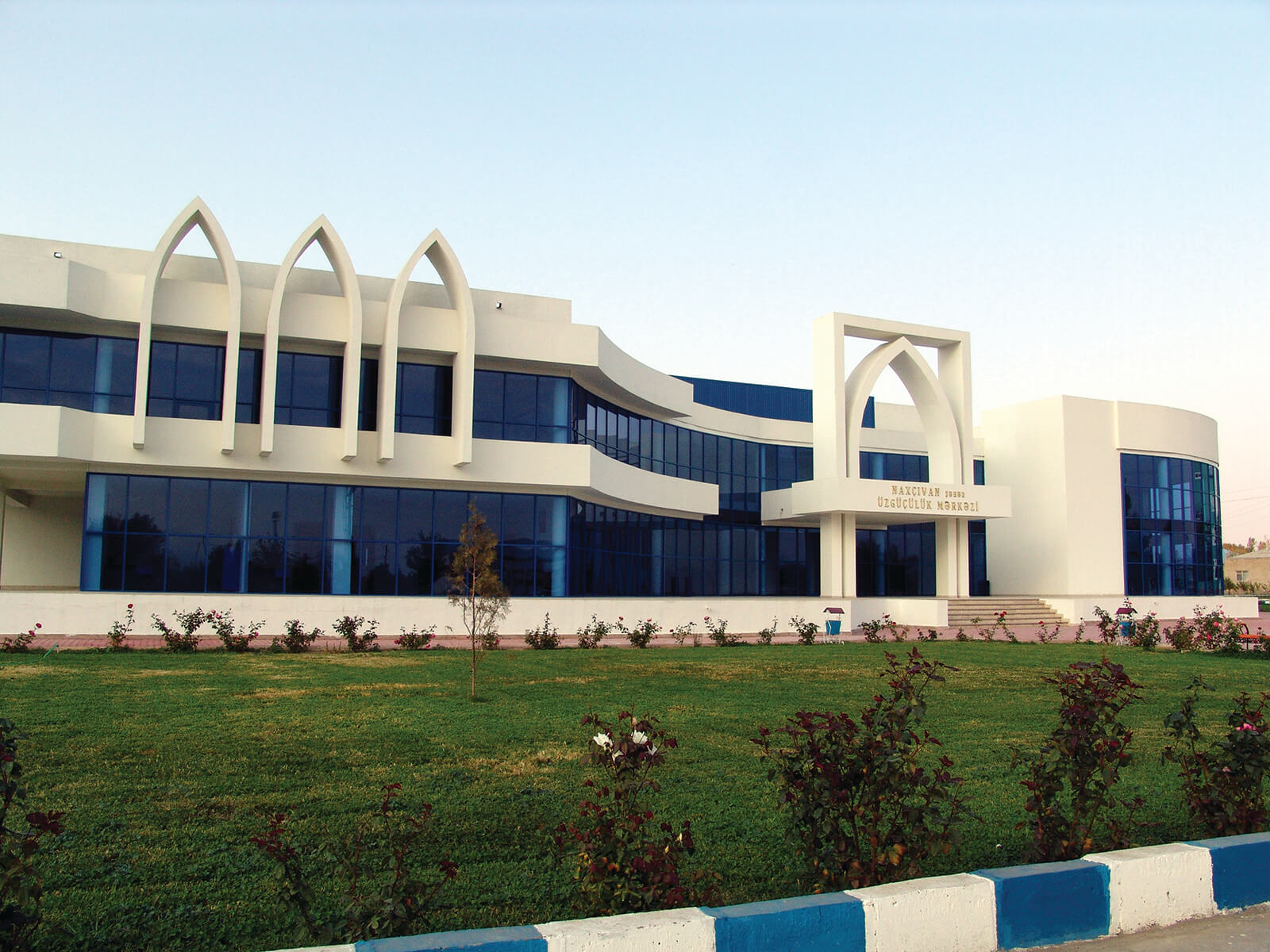
The Nakhchivan Olympic Sports Complex, which has been operating since June 15, 2002, is the first large sports facility to be commissioned outside the country’s capital. The opening ceremony of the complex was also attended by Heydar Aliyev, who opened his eyes to this land, became a world-famous statesman, and ensured the transformation of Azerbaijan’s independence into our national pride as an eternal torch.
There are suitable conditions not only for the development of species but also for holding big competitions here. 4600sq.m. 13 administrative and ancillary rooms, as well as 4 dressing rooms, 4 shower cabins, and 1 Cafe, are examples. The complex was renovated and modernized in 2007 and 2010 and was given to the use of athletes again.
In 378 gyms, each of which has a capacity of 2 spectators, there are all the conditions suitable for the development of both team and individual sports. At present, volleyball, basketball, and futsal types have become popular here. In the other hall, there is training for boxing, karate-do, freestyle wrestling, kickboxing, and table tennis fans.
Sheki Olympic Sports Complex
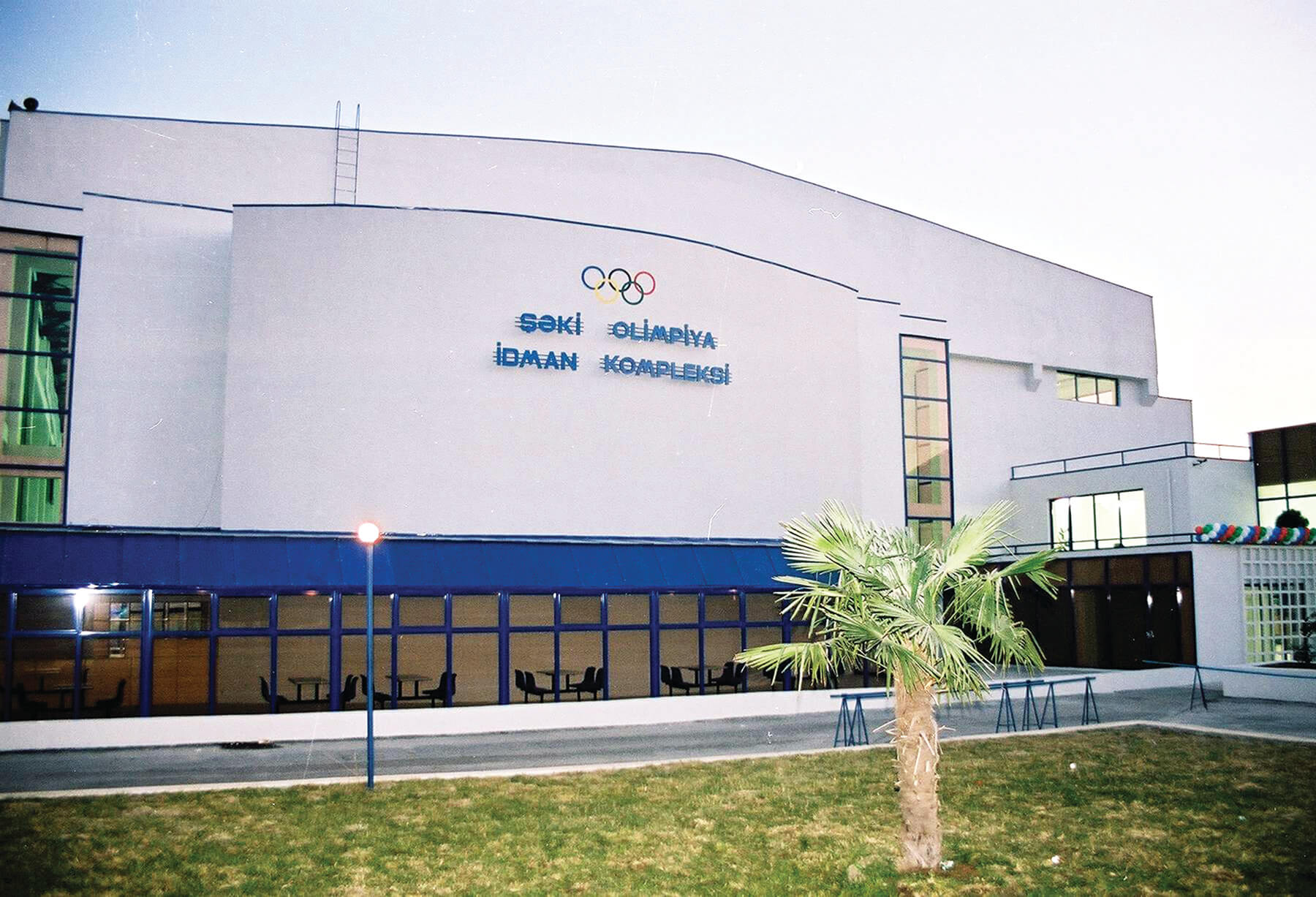
Sheki Olympic Sports Complex, one of the largest sports centers in the region, was put into operation on November 9, 2002, with the blessing of great leader Heydar Aliyev.
Since then, the complex has hosted many sports competitions, training sessions, and other social events. Recently, the territory of the complex has been expanded to modern standards as a result of reconstruction work.
Reconstruction works started in 2008. The complex covers an area of 8 thousand square meters and has a sports hall of 2.2 thousand square meters. The area of the small sports hall is 1800 square meters. Sports halls allow holding large-scale competitions of international and local importance here. The Olympic Complex, which has all infrastructure for sports and health, has an 800-square-meter swimming pool and SPA center, and a 240-square-meter gym, and necessary sports equipment.
As a result of the reconstruction, a 1,400-square-meter water park has been created in the complex. There is a restaurant and a bowling alley in this complex with all kinds of entertainment.
The Sheki Olympic Sports Complex, which has a conference hall and an internet club, also includes a hotel section with an area of 1,500 square meters. A football field with an area of 8 thousand square meters has also been created on the territory of the complex. 27 cottages on the territory have all the conditions for athletes to relax. These cottages, including the hotel, can provide accommodation and rest for athletes who come to participate in competitions organized in Sheki. The complex also has all the conditions for children to engage in sports. A 380-square-meter children’s entertainment building has been built here.
Barda Olympic Sports Complex
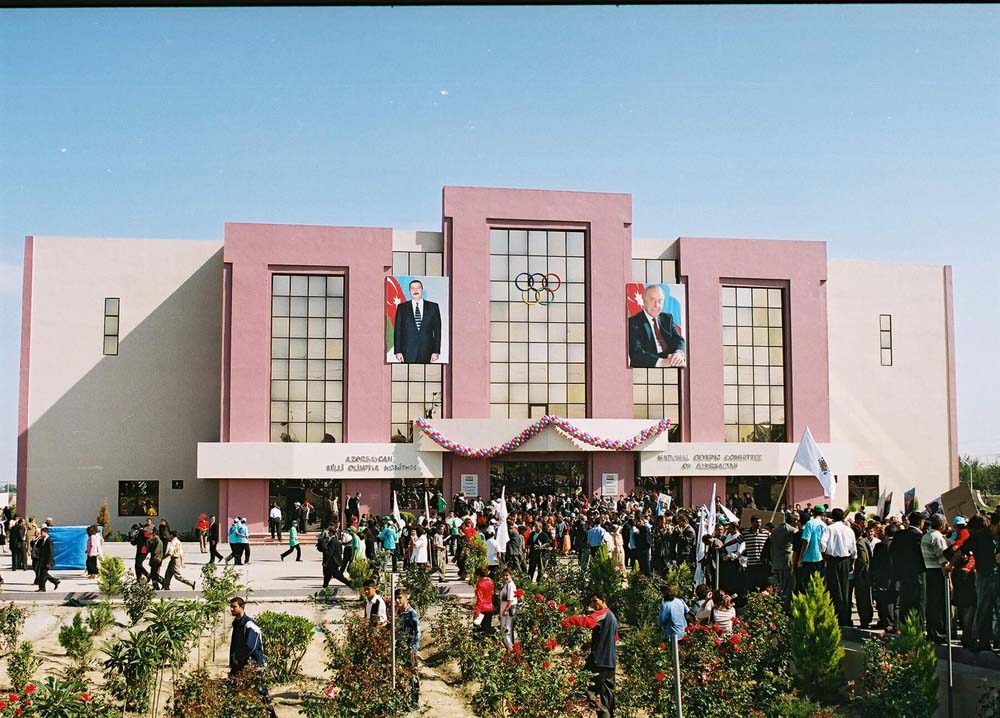
Barda Olympic Sports Complex was put into operation on October 2003, 7. With a total area of 3.8 hectares, the main building of the complex has a sports palace (size 50x30m, performance capacity 548 people), open mini football (size 40x22m), and volleyball grounds (size 40x22m, performance capacity 192 people), tennis court (size 40x22m, performance capacity 192 people) and running strip.
On the 1st floor of the main building, there are 4 coaches, 2 locker rooms, 1 guard, 1 wardrobe room, 4 sanitary units, and 10 shower rooms; on the 2nd floor there are 2 administrative rooms, a buffet, and a sanitary facility; on the 3rd floor, there are 2 administrative rooms.
In addition, in 2004, a swimming pool (dimensions 25x12m, capacity 144 people) was built and put into operation on the territory of the complex. On the 1st floor of the building, there are 3 dressing rooms, 10 shower cabins, and 3 sanitary units; on the 2nd floor, there are 3 Administrative, 1 Coach, 1 medical, 1 massage room, a buffet, and a sanitary unit.
Lankaran Olympic Sports Complex
The complex was put into operation on October 9, 2003. The total area of the complex is 9.2 hectares with huge football ground (size 100x68m, audience capacity 2240 people), and the natural coated small football ground (size 20x40m there is a dressing room), artificial coated playground (size 20x40m), tennis courts (audience capacity 180 people, there are dressing and shower rooms), volleyball court (dressing and shower rooms, audience capacity 180 people) are located here.
On the 1st floor of the main building of the complex, there is a hall for sports games (size 20x40m, spectator capacity 783 people, dressing and shower rooms), administrative, duty, office and worker rooms, a sanitary facility; on the 2nd floor there is a gym (there is a dressing room), a sanitary facility; on the 3rd floor, there are rooms for senior staff, a Taekwondo Hall and a sanitary facility.
Guba Olympic Sports Complex
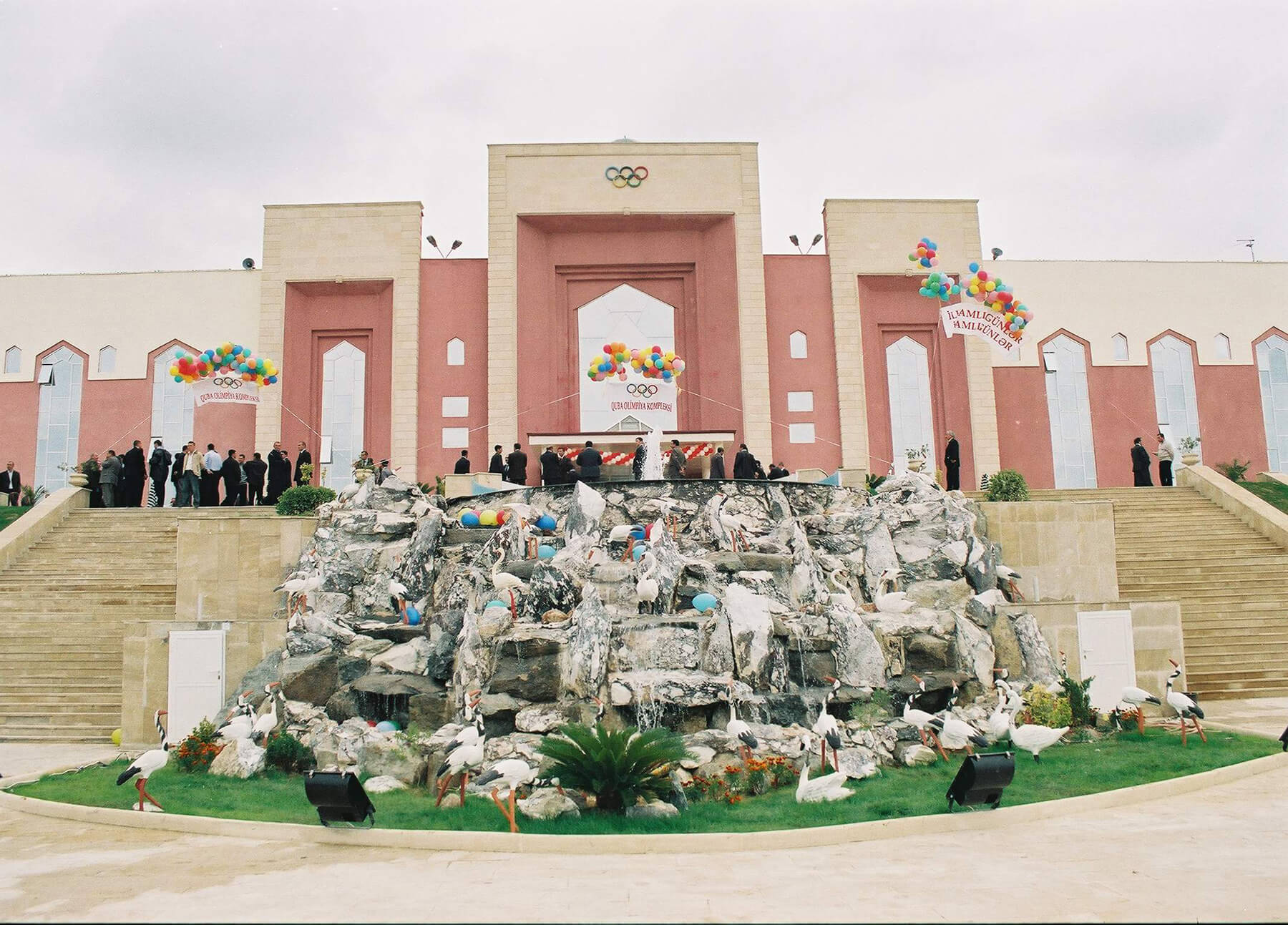
Guba Olympic Sports Complex was put into operation in October 2003, 11. Located on an area of 16 hectares, the large recreation and Sports Center is also distinguished by its great opportunities. There are all conditions for the development of team sports such as football, mini-football, basketball, volleyball.
In addition to hotel rooms, the complex has 2-storey cottages, spacious apartments, as well as a conference hall for 200 people. The largest of the 5 halls in the area holds 2,000 spectators. One of the two small halls is equipped with a gym and the other with a boxing court. Wrestlers can benefit from the ancillary hall. The complex has all the conditions for organizing many sports competitions. 10 rooms such as dressing, medical center, commutator room, security room, operator, technical department help to increase the level of service.
The football field with a capacity of 5,100 spectators is also equipped with all the conditions that meet the requirements of this sport. The 50-meter swimming pool is also suitable for both training and competitions. Here there is a 10-lane swimming strip, 1010 spectator tribune for 3 people. The 3-storeyed 24-room hotel (11 rooms for 2-seater, 9 for 3-seater, 4 for 4-seater), as well as 24 single-storied, 6 two-storied cottages, 2 apartments are distinguished with a high level of service.
Shamakhi Olympic Sports Complex
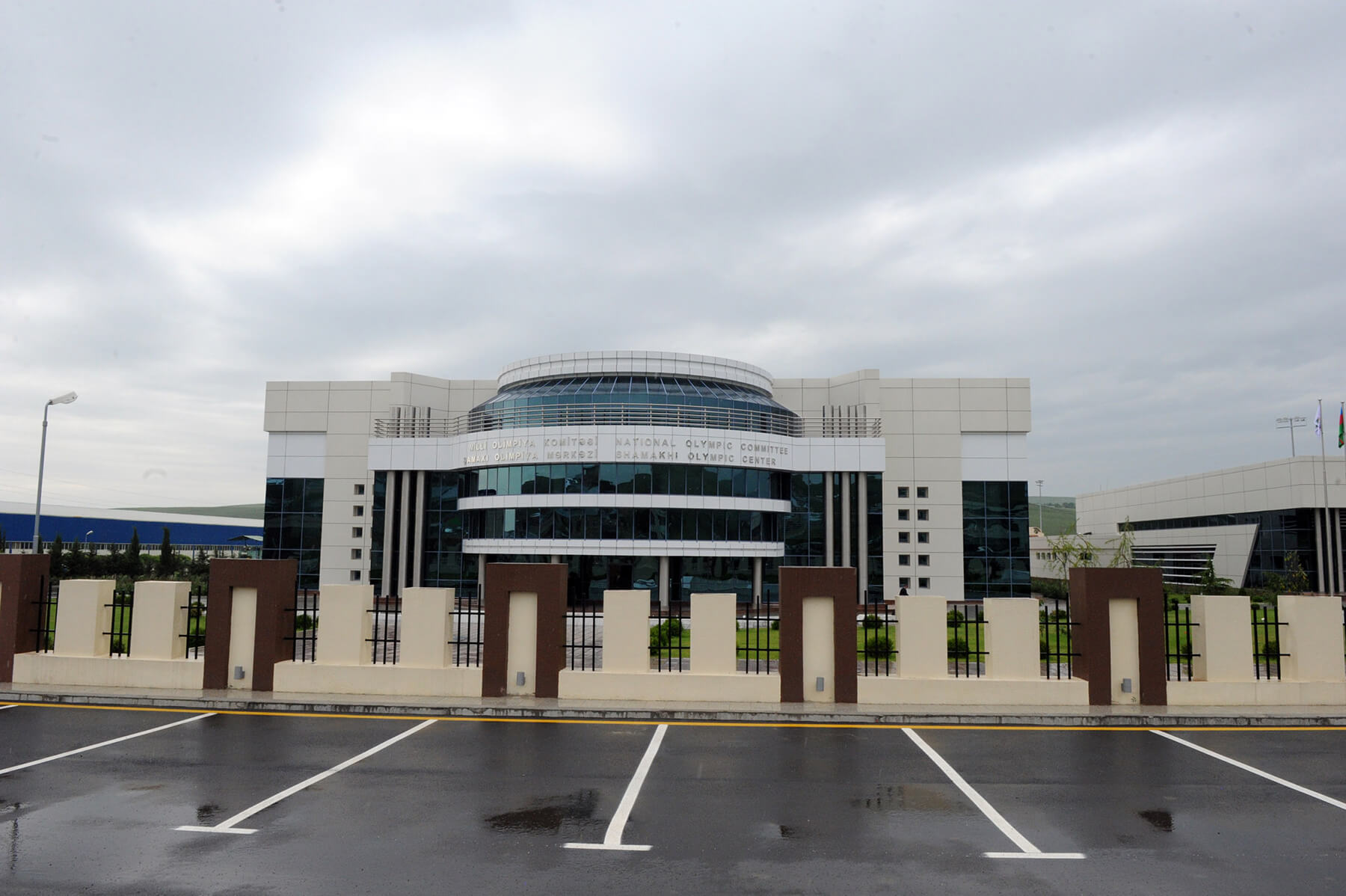
Shamakhi Olympic Sports Complex was built and put into operation in April 2005, 26. With a total area of 3.5 hectares, the main building of the complex has 1 Sports Hall (sizes 50x30x9m, audience capacity 725 people) and 2 gyms. In addition, the main building of the complex has 2 wardrobes, 2 dressing rooms (shower rooms), 2 reserve teams, 2 coaches-teachers, 1 doctor, 1 judge, director, administrative staff, and 2 ancillary rooms, 3 warehouses.
The complex has open football, basketball (28x18m, spectator capacity 180 people), volleyball (24x11m, spectator capacity 192 people), tennis court, running track, and playground (6×4), swimming pool (25×12, 5m, spectator capacity 144 people). There are 15 one-storey cottages (12 one-room, 3 two-room) and a canteen in the complex. The complex has 2 shower rooms, water and fuel storage, a boiler room, and laundry.
There are groups in 5 sports in the complex: swimming, weightlifting, freestyle wrestling, football, taekwondo. 5 coaches work in these departments on a contract basis. The complex has 11 staff units.
Zagatala Olympic Sports Complex
The Olympic Sports Complex was opened in Zagatala on April 12, 2006. The first building of the complex has an office building, the second building has a 25-meter swimming pool and a gym for 130 spectators, and the third building has a large gym with 350 seats. There are also training rooms, dining room, and service rooms. A new stadium with 3,500 seats in front of the complex has been built and put into operation in accordance with international standards.
In the future, it is also planned to build a 3-storey hotel building and tennis courts on the territory of the Sports Complex.
Masalli Olympic Sports Complex
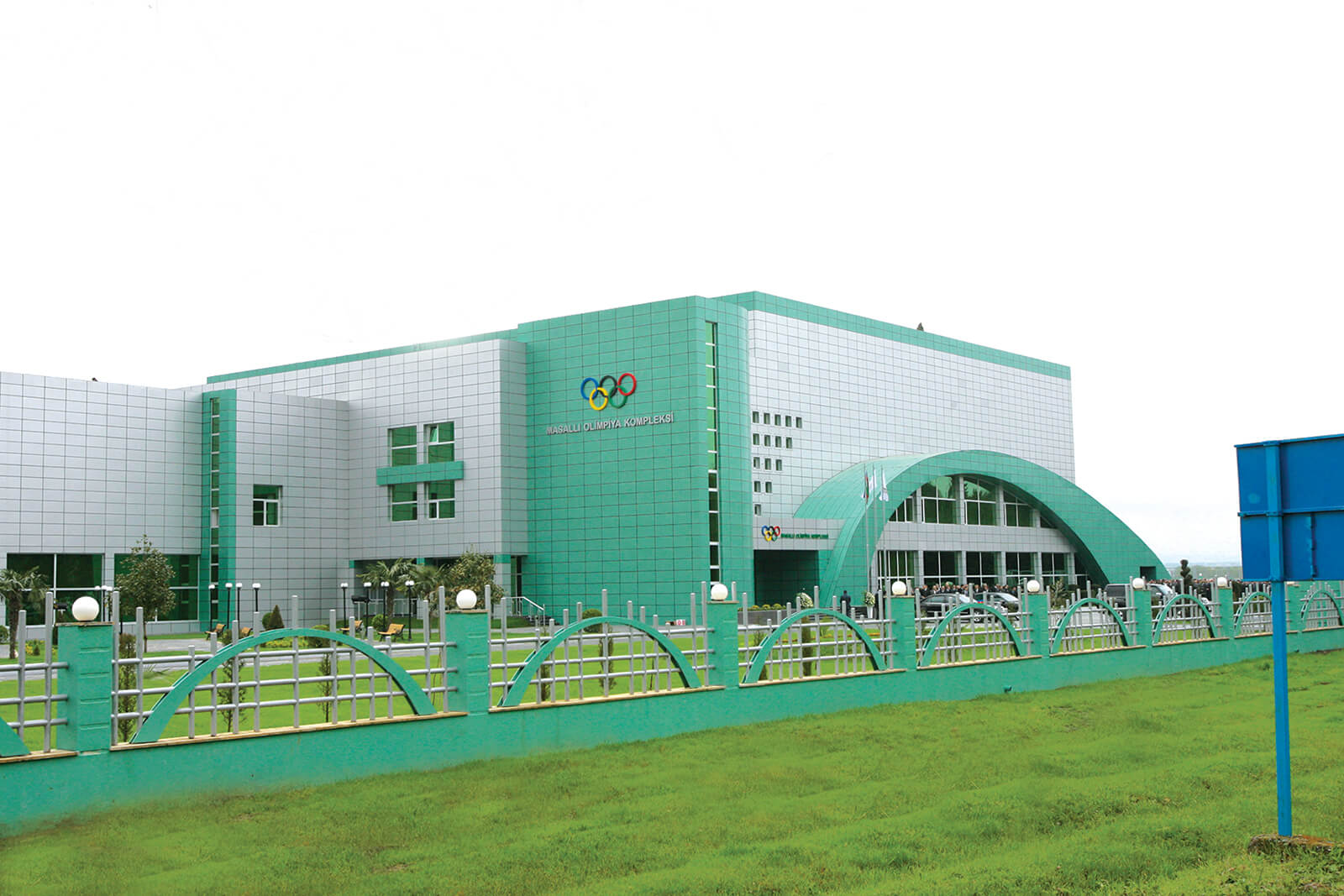
Masalli Olympic Sports Complex was put into operation on April 2007, 9. The complex includes halls for sports games, wrestling, boxing, weightlifting, and gymnastics, an indoor swimming pool, volleyball and basketball courts with artificial grass cover, two tennis courts, a mini-football field. Car parks and other service facilities have also been built at the Olympic Complex, and all conditions have been created for athletes. At the level of four-star hotels, there are ten cottages and a canteen for 60 people.
In the large hall of the complex with more than 700 spectators, it is possible to hold international competitions in all kinds of hand games, mini-football, wrestling, and other sports. The swimming pool with a length of 25 meters has been built on the basis of the project of European countries and meets international standards. The total area of the complex is 3.5 hectares. The total area of the 3-storey building of the complex is 6,230 square meters.
Gymnastics and boxing are located on the second floor of the complex, and wrestling and fitness rooms are located on the third floor. The complex includes an outdoor field hockey stadium that meets modern standards. The 6,300-square-meter stadium has a grandstand for 210 spectators.
Gazakh Olympic Sports Complex
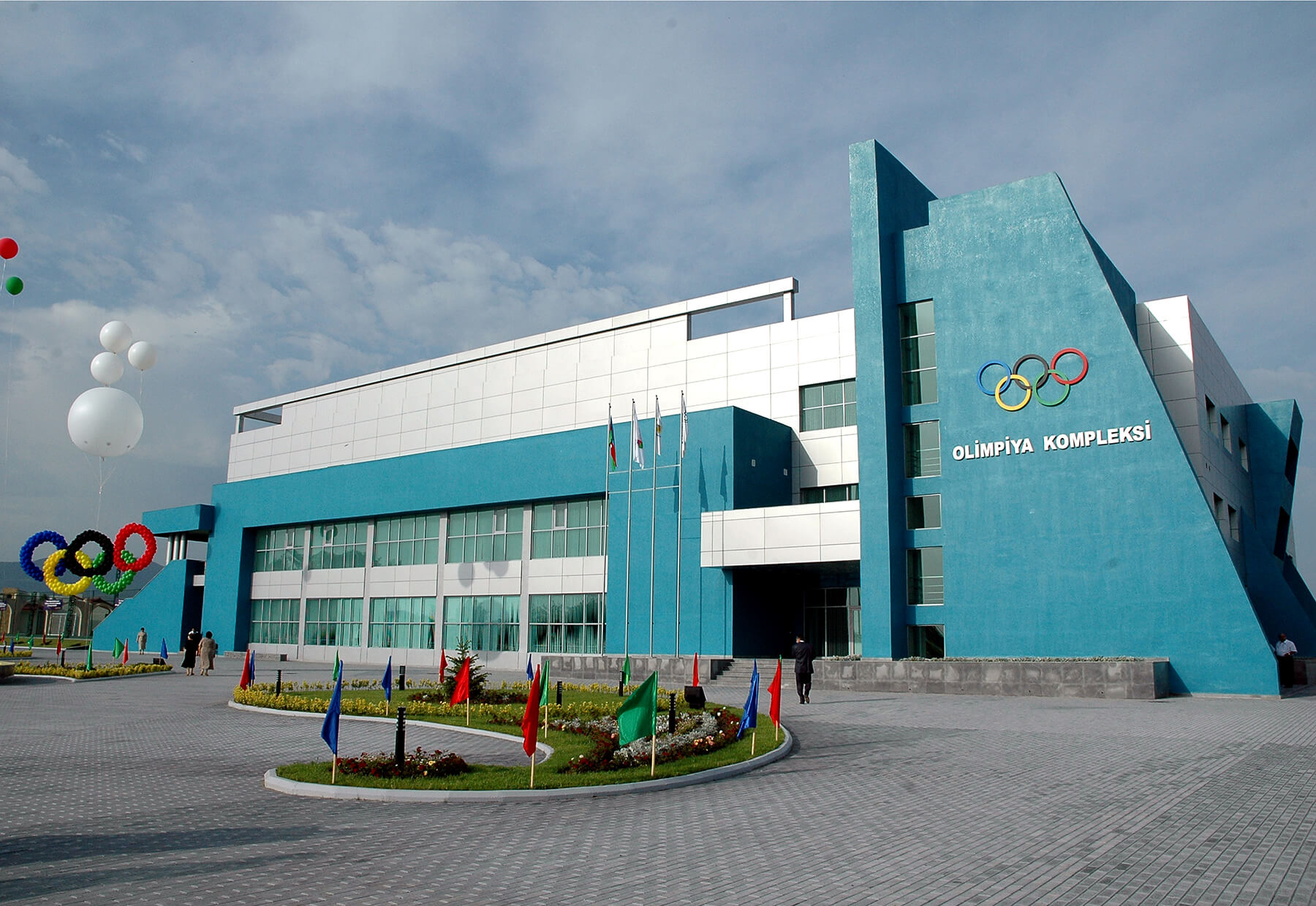
Gazakh Olympic Sports Complex was put into operation in 2007, May 30. The main building of the complex with a total area of 15.5 hectares has a hand games hall (sizes 61,5×46,5m, the capacity of spectators 1010 people, 2 locker rooms, 2 doctors, 2 judge rooms, 2 shower rooms, 2 bathrooms), gymnastics (sizes 17,6×13,1×3,5m, tatami, gymnastics balls and tools, 2 training halls, 2 locker rooms, 2 shower rooms, 2 bathrooms), wrestling hall (sizes 17,6×13,1×3,5m there are 1 trainer, staff, barbell, dumbbell, 1 coach room, 1 locker room, 1 shower room and 1 sanitary box), training hall (sizes 17, 8×13,1×3,5m,22 training hall, 1 reception, 1 coach room, 1 locker room, there is a shower room and 1 bathroom) and boxing halls (dimensions 17,2×15,4×3,5m, 1 boxing ring, 6 punching balls, exercise equipment, 1 coach, 1 dressing room, shower, and toilet).
In addition, swimming complex (size of pool 25x15x2, 2m, audience capacity 160 people, 1 receptionist, 3 coaches, 2 locker rooms, 1 doctor’s room, 2 shower rooms, 2 chlorine baths, 2 bathrooms), outdoor football (dimensions 50x25m, spectator capacity 252 people) and tennis court (dimensions 36x36m, spectator capacity 96 people)are located on the territory.
Aghdam Olympic Sports Complex
The Aghdam Olympic Sports Complex built in Guzanli settlement of Aghdam region was put into operation on January 2008, 17. The two-storey building of the three-hectare complex has a 500-seat sports hall (20×40 m), as well as a small sports hall, a gym, and training halls. On the territory of the complex, there is a football stadium with natural grass cover (2×75 m) withstands for 115 thousand seats, volleyball and basketball grounds meeting international standards. There is also a hotel with 10 rooms and 30 beds in the territory of Aghdam Olympic Sports Complex.
Salyan Olympic Sports Complex
Salyan Olympic Sports Complex was put into operation on September 7, 2008. Located on an area of 10 hectares, the modern sports complex has a 2,000-seat football stadium, a 264-seat mini football field, a tennis court, basketball and volleyball courts, a swimming pool, boxing, wrestling, and handball halls. The complex has all the conditions for athletics, acrobatics, and rhythmic gymnastics.
The three-storey five-star hotel in the area has a bar, restaurant, administrative center, and a large conference hall. Cottages have also been built around the complex.
Gusar Olympic Sports Complex
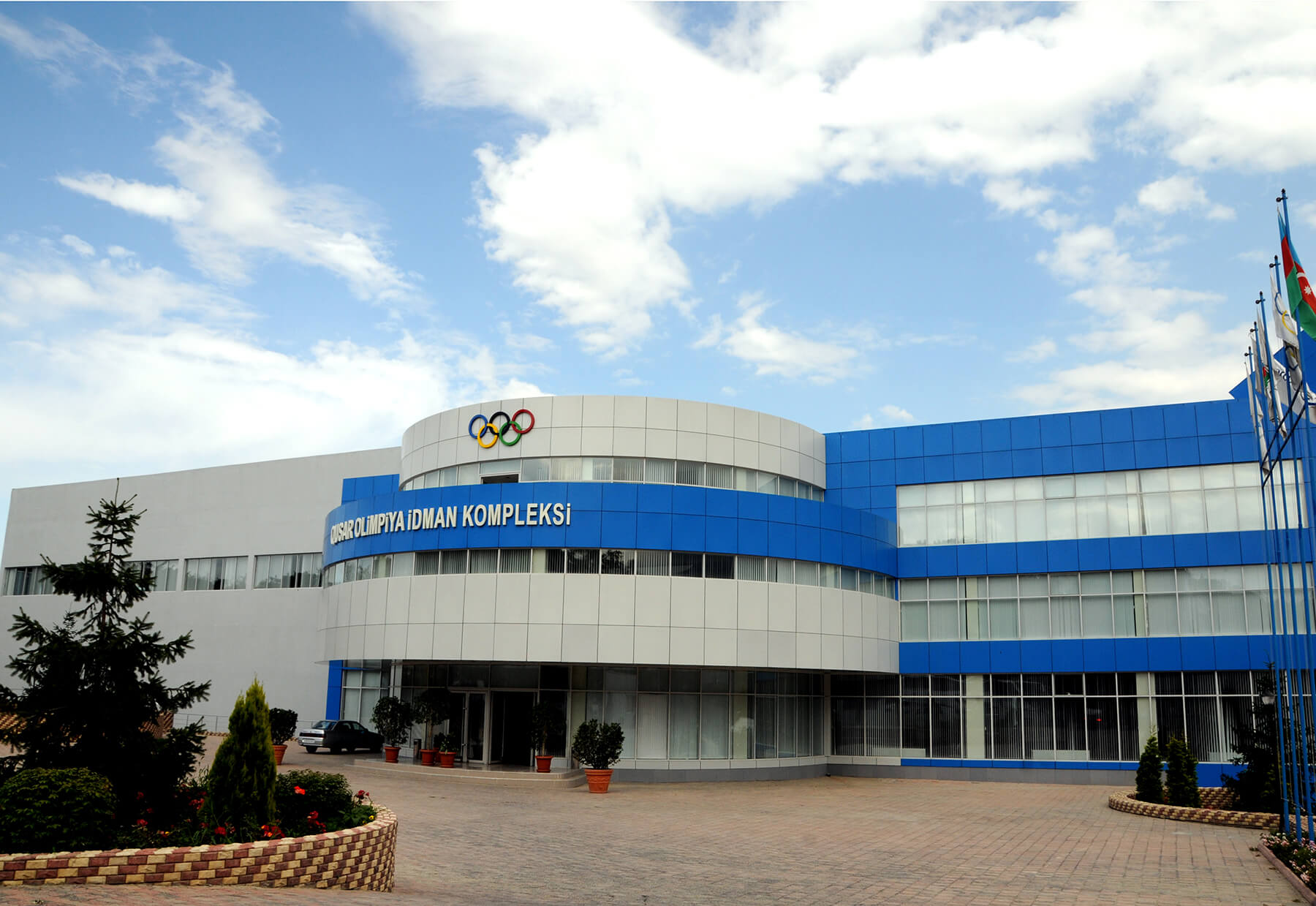
The Olympic Sports Complex was put into operation in Gusar on September 2008, 27.
Built-in the most picturesque place of the city, on the edge of the forest, this complex occupies an area of 14 hectares and the total area of its main building is 5 thousand square meters. In this building, there are two sports halls with universal stands for 1530 and 450 seats, a 25-meter swimming pool, rooms for table games, a fitness room, a canteen, and ancillary rooms. 316 people can watch the swimming pool competitions.
There are three-storey sports buildings, an indoor recreation park and a recreation area:
Boxing (with ring and all conditions), wrestling, gym, aerobics, and billiard halls operate in the 1st building.
In the 2nd building, there is a hall for hand games (volleyball, handball, futsal, basketball, wrestling, etc. There are all conditions for competitions and training, spectator capacity is 1531 people).
There is a swimming pool in the 3rd building (size 25x15m, spectator capacity 316 people).
The recreation area of the complex includes an outdoor swimming pool, 7 garden attics, 40 cottages for 1 and 2 families.
Oghuz Olympic Sports Complex
Oghuz Olympic Sports Complex was put into operation on September 2008, 20. The main building of the complex, which occupies an area of 4.5 hectares, includes a universal sports hall (408×60 m) that withstands 40 seats, a gym, 100-seat conference rooms, a restaurant bar, as well as administrative rooms. The other building has a 25×12 m swimming pool. A football stadium with 1728-seat (60×110 meters), volleyball, basketball, and tennis courts have been built on the territory of the complex. 5 cottages with 6 beds each were built for athletes to stay and rest. The stadium has an artificial grass cover brought from Turkey.
The sports facility has a pumping station, boiler house, 2 reserve water reservoirs with a capacity of 400 cubic meters each, and a fire protection station.
Sabirabad Olympic Sports Complex
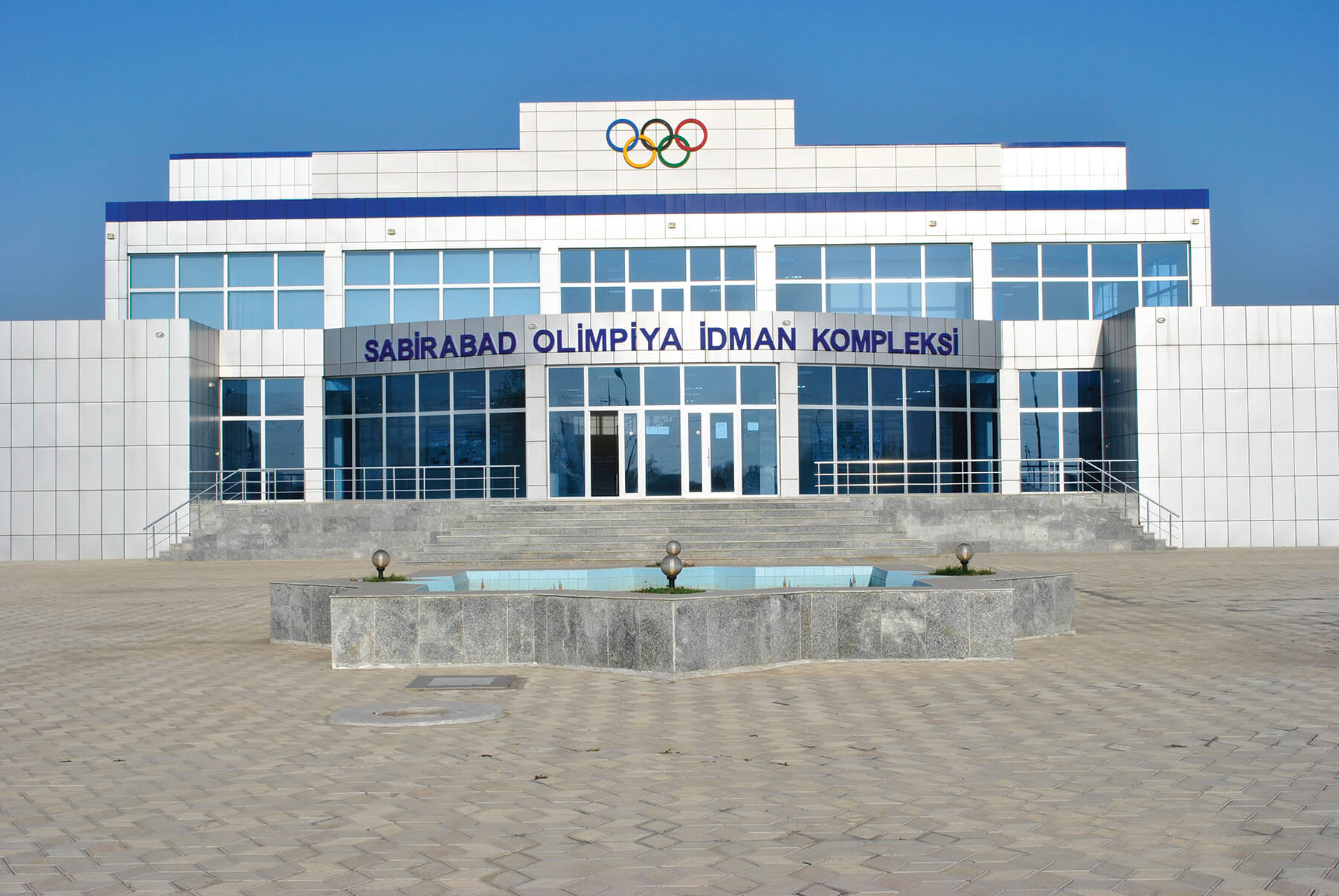
Sabirabad Olympic Sports Complex was put into operation on September 2008, 26. The main building of the complex, which occupies a total area of 6.4 hectares, has a sports hall with a capacity of 600 people, 2 gyms, 4 administrative, 2 technical, 1 doctor’s room, and a cafe. In addition, there is a 150-seat Swimming Hall (25×11.5 m).
28 local, 14-room hotels and 4 cottages for 3 persons each were built on the territory of the complex. The swimming complex has a swimming pool (capacity of 196 people), a gym, 4 administrative, 2 Technical, 1 doctor’s room, and a cafe. The size of the main gym is 40×60 m, the capacity of the audience is 432 people. The size of the gym is 13x9m. On the territory of Sabirabad Olympic Sports Complex, there is an open indoor volleyball (21×12 m) and a mini football field (28×16 m), as well as a running track.
The complex has all the conditions for the development of mini-football, volleyball, basketball, swimming, table tennis, wrestling, and athletics. There are sections for freestyle wrestling, boxing, mini-football, sambo-wrestling, karate, fitness, gym, and table tennis.
Bilasuvar Olympic Sports Complex
Bilasuvar Olympic Sports Complex was put into operation on October 2008, 7.
The complex, which occupies an area of 6.5 hectares, has the main gym (910×50 m) with grandstands, and a swimming pool of 20×12.5m meters. The complex includes small and large gyms with modern sports equipment, exercise rooms, a chess room, a table tennis hall, and ancillary rooms. The complex has a dining room for a hundred people. A 23-room hotel with 46-bed, as well as two two-storied cottages, have been built on the territory of the Bilasuvar Olympic Sports Complex. Each cottage has 3 sleeping places.
The complex, which meets modern standards, has the necessary conditions for conducting national and international competitions.
Shamkir Olympic Sports Complex
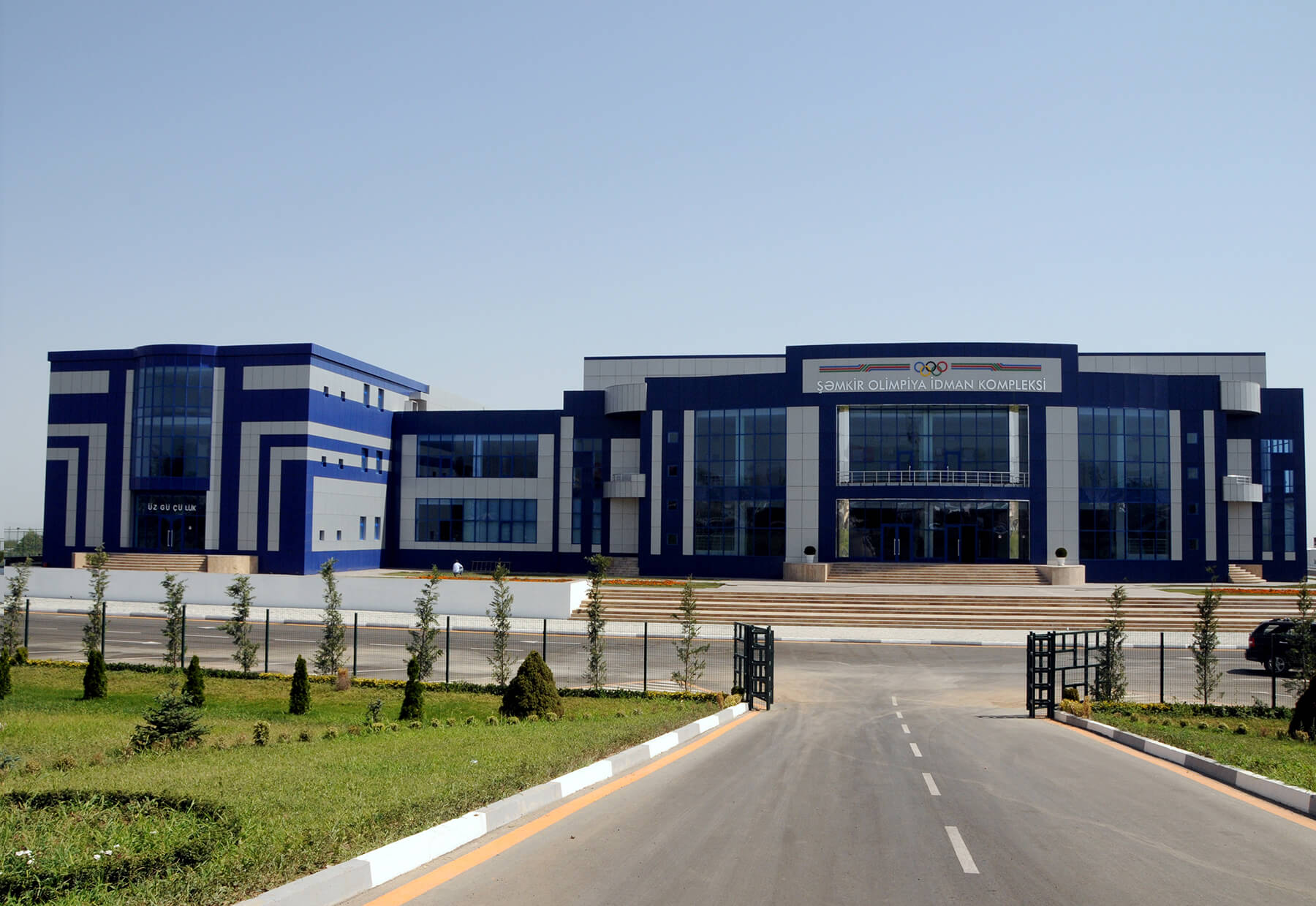
Shamkir Olympic Sports Complex was put into operation on May 2009, 25. The territory of the complex is 9 hectares, and the main building is three-storied. The main building has a main hall for handball, futsal, volleyball, and basketball games. The hall, which holds 700 spectators (45×22 m) has an electronic scoreboard. There are also playgrounds for other sports here. The indoor swimming pool is equipped with a special antimicrobial coating, a filter, and a chlorine bath. In addition to sports halls, the main building has a gym (12×6 m), sections for table games, a canteen, and other ancillary rooms. There are 2 tennis courts, 2 volleyball courts, and 1 basketball court in the complex.
The complex has sports halls, wrestling, boxing, weightlifting, and gymnastics halls, a hotel for 30 people, and a dining room for 73 people. The complex includes a 2,000-seat football stadium (110×70 m), parking, and one-storey cottages. The Shamkir Olympic Sports Complex, built in accordance with modern standards, has all the conditions for holding local and international competitions and physical training of athletes.
Sharur Olympic Sports Complex
Olympic Sports Complex was put into operation in Sharur city on August 2009, 3.
The total area of the complex is 9 hectares, greenery planting works have been carried out in an area of 4 hectares. The area of the building is 12.086 square meters. It includes a hotel, a sports complex, swimming pool with 142 spectators. In addition, the complex has an artificially coated stadium for 2,400 spectators, tennis courts, mini football, basketball, and volleyball courts. The three-storey hotel for 60 people has 30 rooms with all amenities, a meeting room, and a dining room for 68 people. It is possible to hold mini-football, boxing, wrestling, and basketball competitions in the game hall of the two-storey sports complex. The complex also has two gyms.
A stadium with artificial grass cover for 2,400 spectators has been built on the territory of the complex.
Ismayilli Olympic Sports Complex
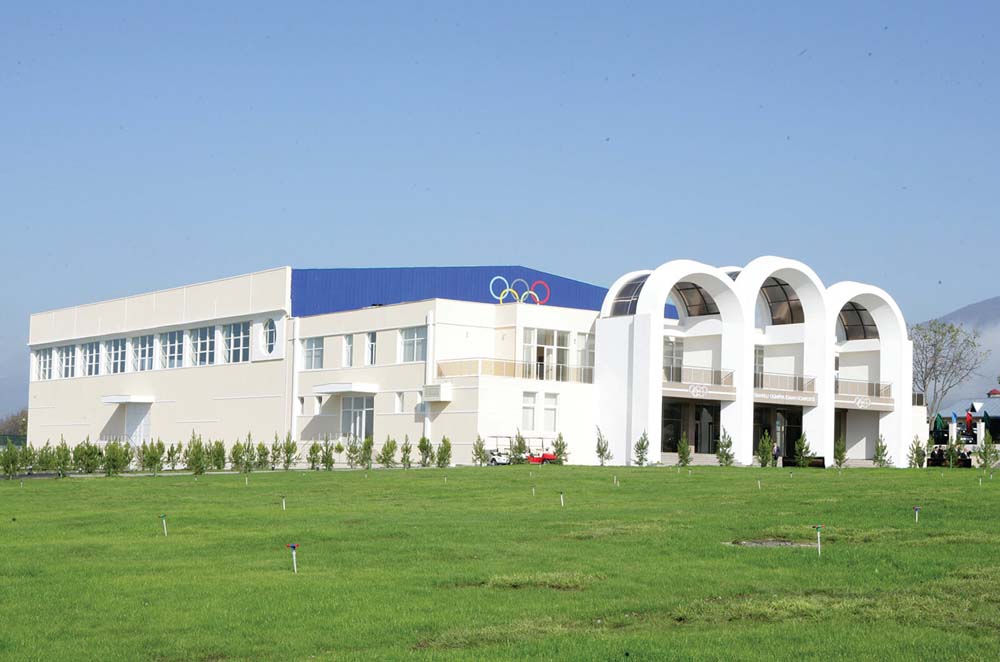
Ismayilli Olympic Sports Complex was put into operation in October 2009, 29. The main building of the complex with a total area of 7.5 hectares and a construction area of 12 thousand square meters consists of two floors. On the ground floor, there is a gym (500×50 m) with 30 seats for various competitions and training, as well as rooms for coaches, doctors, and others.
On the second floor, there are gym and judo halls, as well as a conference room equipped with the most modern equipment, a canteen, administrative and other ancillary rooms.
Artificial coated football ground for 940 seats, 184-seat swimming pool, 2 tennis courts, 4 two-storied cottages, basketball (31×17 m) and volleyball (25×13 m) playgrounds, 3 thousand square meters with an area of 500-parking space has been built in the yard of the complex.
The artificial grass cover of the stadium meeting FIFA standards meets the most modern requirements. Even during the strongest rains, puddles of water do not form on this facility. The special drainage system installed here immediately removes rainwater. The total area of the stadium and the track for athletes is more than 13,000 square meters. Water for the complex is taken from 2 artesian wells drilled here.
Shagan Olympic Sports Complex
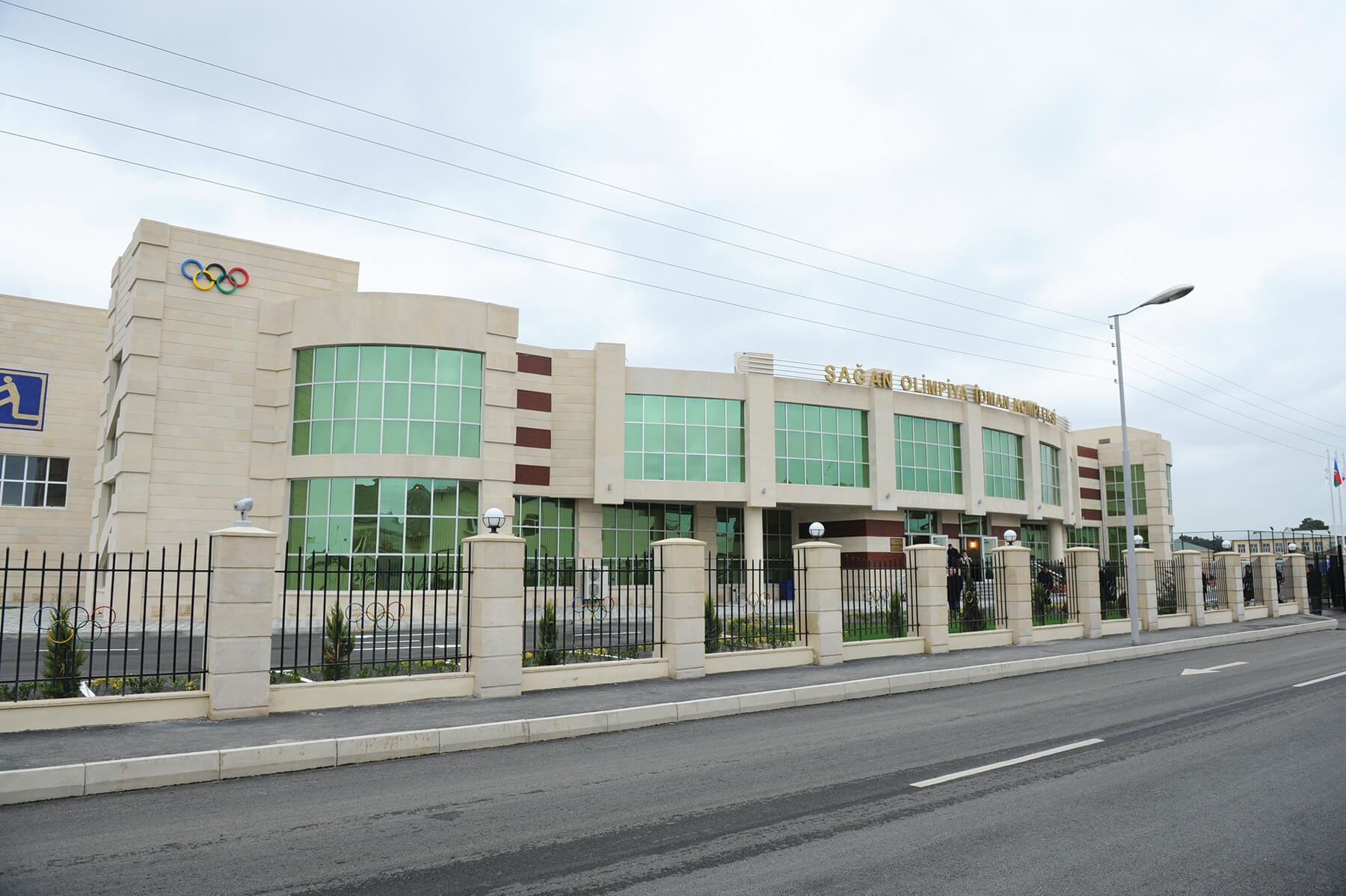
Shagan Olympic Sports Complex was put into operation on December 2009, 25. Located in the Shagan settlement of Baku, the complex has been built on an area of 3.25 hectares. The main building is two-storied. On the first floor of the building, there are universal sports, wrestling, and fitness rooms, referees’ room, locker rooms, and other service rooms.
The universal gym of the complex (36.9×54.2 m) has conditions for football, handball, volleyball, basketball, and competitions, and 630 seats have been installed in the grandstand of this hall.
The hall (36×36 m) designed for wrestling, boxing, and other types of sports has 615 seats for spectators. In the halls of the complex, it is possible to hold international competitions in mini-football, basketball, volleyball, gymnastics, boxing, and wrestling.
On the second floor, there is a dining room, a conference room, a doctor’s room, and other service units.
In the building where the indoor swimming pool is located, it is 25 meters long and 12.5 meters wide, also 132 seats have been installed around the pool. The administrative part of the building is two-storeyed. On the second floor, there are rooms for coaches and commentators, a chess room, as well as lodges for watching the competitions.
The two-storey hotel built on the territory of the complex is designed for 25 people. There are 12 standard and one luxury room here.
There are tennis courts, mini football, and volleyball grounds in the open air.
The artificially coated stadium with 1132 spectators on the territory of the complex (105×68 m) has a pavilion with all conditions for athletes, coaches, and service staff.
Aghdash Olympic Sports Complex
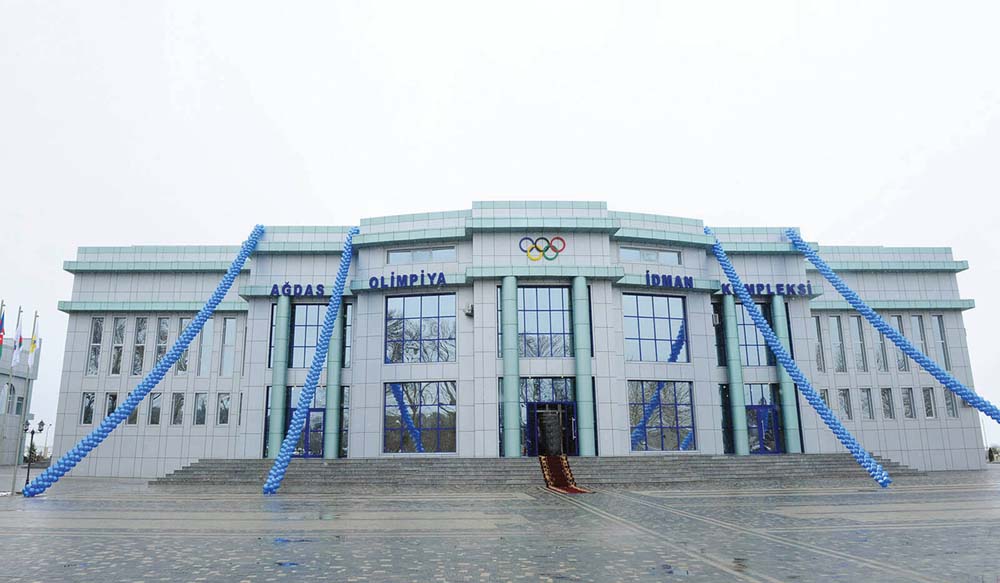
Agdash Olympic Sports Complex was put into operation on February 12, 2010.
The complex consists of 1 universal gym and 4 ancillary-extension parts. The gym is designed for 1020 spectators (the size of the hall is 55×40 meters). 1 buffet, living room, lodge VIP, 2 small lodges and etc. is available. There are billiard, wrestling, and table tennis halls, weightlifting gym, as well as taekwondo gym in the 2nd and 3rd ancillary-extension parts.
The size of the swimming pool is 25 x 12.5 m, and there are seating areas for 96 people. Also, 2 gym, dining rooms, doctor’s room and etc. are available.
Two-storied 3 pieces 4-bed cottages were put into operation in the territory of Aghdash Olympic Sports Complex. There is also a bridge for passage to cottages and a green area.
Aghdash Olympic Sports Complex has a 260-seat football pitch with artificial grass cover (60×40 meters). The stadium also has a track for the long jump. Artificial coated tennis court (36×17 m), volleyball court (24×15 m), and basketball court (33×20 m) were put into operation.
Goychay Olympic Sports Complex
Goychay Olympic Sports Complex was put into operation on February 2010, 12. The size of the gym is 51x36m and has a capacity of 608 people. There is a gym equipped with modern equipment.
There are halls for table tennis and billiards, as well as a conference hall in the complex. The administrative building of the swimming pool also meets modern standards. The size of the pool is 25×12.5 m. 252 spectators can watch the process of the competition in the swimming pool. There is also a sauna and other ancillary rooms here. On the second floor, there is a restroom, doctor’s and coach’s rooms. The complex has a tennis court (18×36 meters), mini-football, basketball (18×36 meters), volleyball (18×28 meters), and other sports fields, as well as a football stadium. The stadium (100×50 m) is designed for 270 spectators. A 56-seat, 23-room hotel meets the most modern standards and two two-storied cottages have been built for the recreation of the athletes. Each cottage has 5 beds.
Balakan Olympic Sports Complex
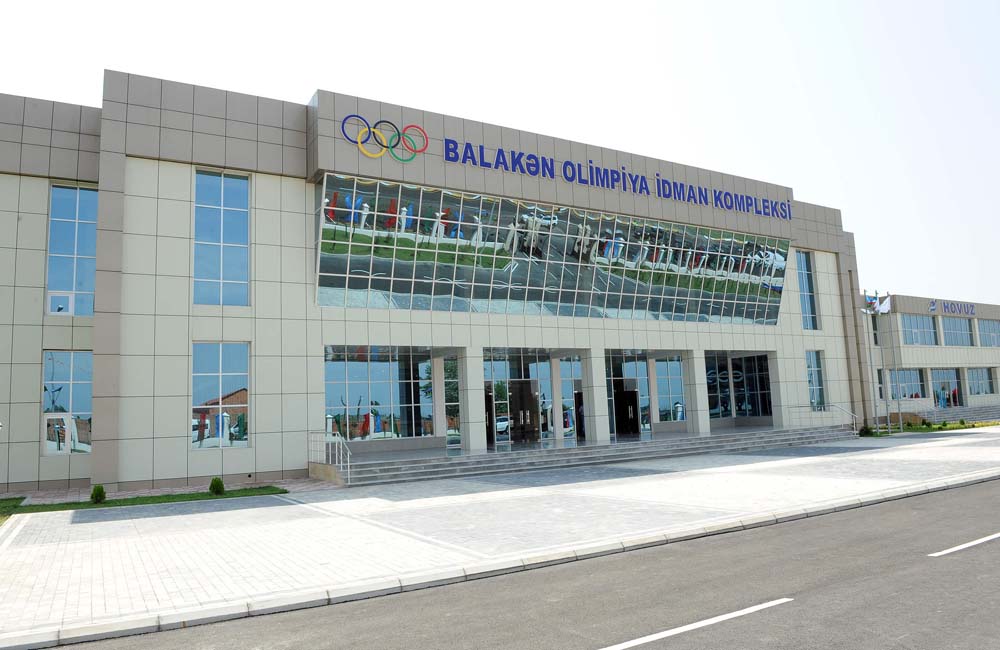
The complex was put into operation on July 8, 2010. The total area is 5 hectares, and the construction area is 8900 square meters. It includes a football stadium, basketball, volleyball, mini football, and tennis grounds, swimming pool, hand games room, as well as table games and gyms, including the cottages.
The two-storied main building of the complex has a sports hall for 680 spectators (46×32 m). The complex also has halls for hand games, chess, checkers, fitness equipment, board games, billiards and oriental fighting halls, a cafe, and a five-lane swimming pool. The swimming pool provided with an electronic scoreboard (25×12,5 m) is equipped with water heaters “Ekostar” system. There are doctors and coaches, bathing and dressing rooms, and a sauna. The building has a central ventilation system.
The complex has an artificial coated Stadium with 930 seats (105×68 m), mini-football, volleyball (20×24 m) and basketball courts (20×24 m), and a large tennis court. The stadium has a 400-meter running track.
Due to the lighting system of the area, there are ample opportunities for doing sports at night.
For the accommodation and recreation of athletes and guests of the complex, 6 cottages with 34 beds with all amenities have been built here.
The small Olympic sports complex has a boiler room, a swimming pool with 500 tons of water.
« Kura » Olympic Training and Sports Center
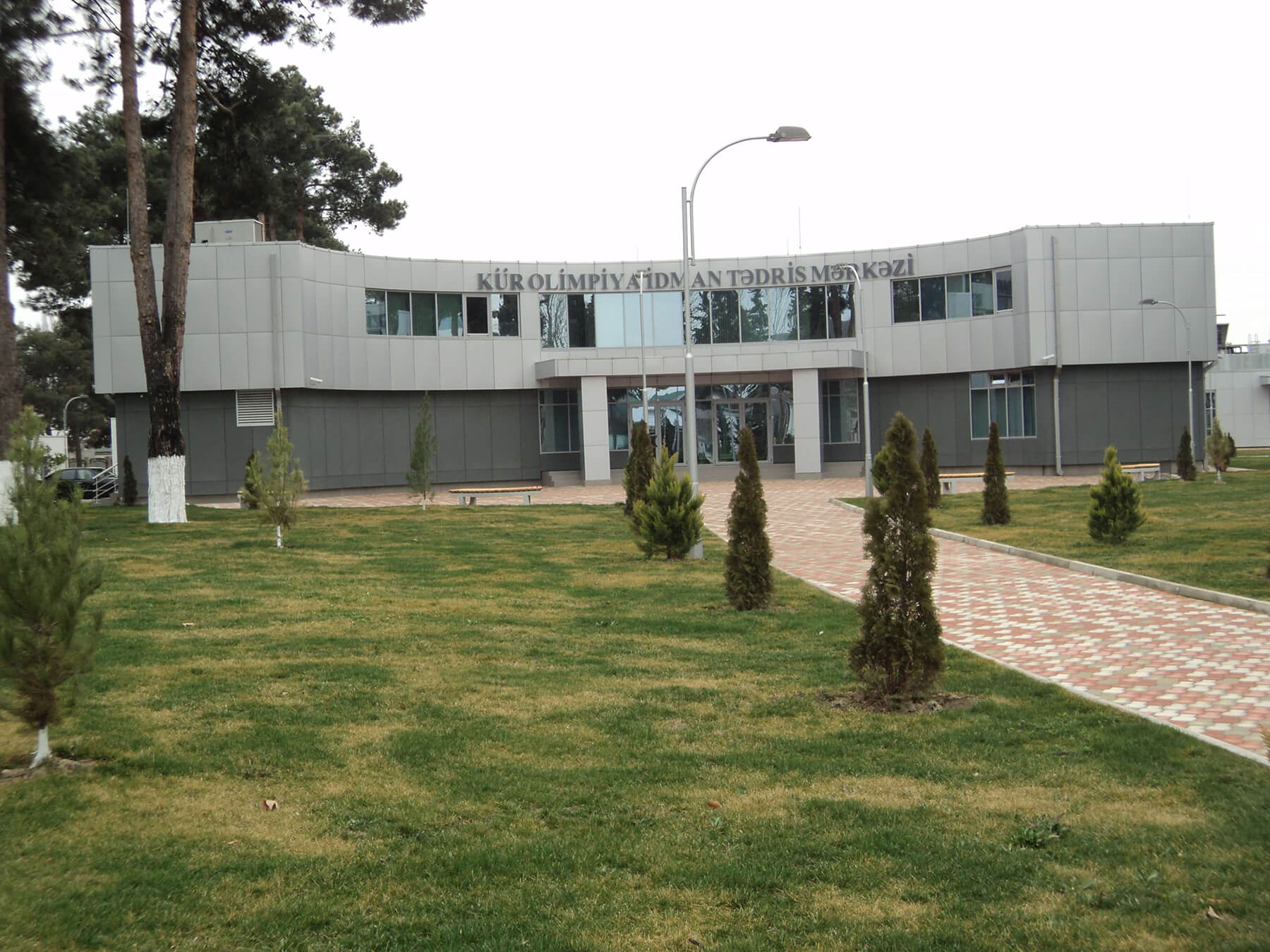
« Kura » Olympic Training and Sports Center was put into operation in October 2010, 14.
With a total area of 7.2 hectares, “Kura” Olympic Training and Sports Center is a unique rowing base in Europe, as well as in the CIS.
According to the project, the complex has an administrative building, a 7-lane swimming pool, a six-storey 250-bed four-star hotel reminiscent of a ship. Two of them are luxury rooms measuring 104 square meters and 92 square meters. In addition, the center has a 2-storey cottage, which has 2 rooms on the 1st floor and 4 rooms on the 2nd floor. The administrative building is 2-storey.
The capacity of the sports hall (size 57.6×45.6 meters) is 500 people, and the swimming complex (size 50×21.06 meters) is 280 people.
In addition, the center has a rowing club, cottages, 2 tennis courts (36×18 meters), a gym. There is a hangar (size 51.5×32 meters) for storing boats. The four-storey building with a terrace has an observation hall, rooms for journalists and judges, a cafe bar, and other ancillary rooms.
Fuzuli Olympic Sports Complex
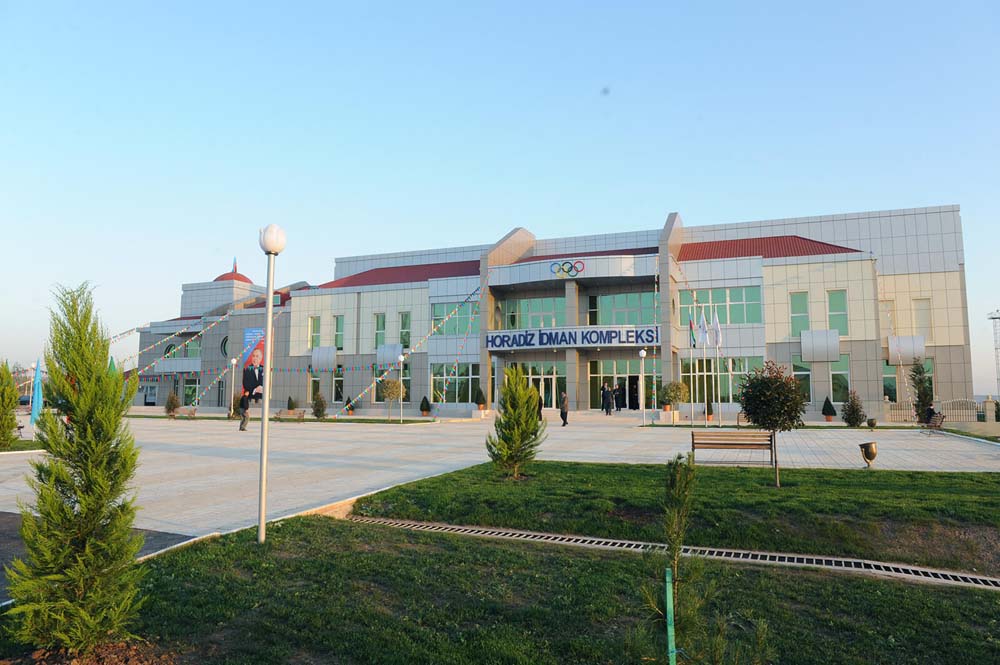
Fuzuli Olympic Sports Complex was put into operation in November 2010, 12. The complex which construction began in February 2009 covers an area of 5 hectares.
The size of the 494-seat hall for spectators is 52×24 m. There is also a 6×13 m gym in the complex. The Olympic Sports Complex also includes locker rooms, showers, saunas, and massage rooms, a medical center, a cafeteria, administrative rooms, and bedrooms.
There is also a 10-room and 30-bed local hotel in the complex. The hotel’s facilities and services meet high standards.
A 78x110m stadium for 1860 spectators was put into operation at the Fuzuli Olympic Sports Complex. The stadium is provided with natural grass cover.
18×29 m open volleyball and 18×9 m open basketball courts were put into operation in the territory of Fuzuli Olympic Sports Complex.
Tovuz Olympic Sports Complex
Tovuz Olympic Sports Complex was put into operation in Tovuz on February 2011, 9. The foundation of the complex was laid in 2007 with the participation of President Ilham Aliyev on May 30.
The complex, built by the order of the Ministry of Youth and Sports, consists of 3 buildings located at the entrance to the city of Tovuz — on the left bank of the Tovuz River on an area of 7 hectares. In the first building of the complex, there is a swimming pool (25×12.5 m) and a canteen. The second building consists of a five-storey hotel with 34 double rooms and one VIP room. In the third building, there is the main gym with 814 seats (24.4×42.5 m). In addition, there are training halls, mini football (21.4×34.9 m), volleyball (8.9×18 m), basketball (16.4×22.96 m), handball (21.4×34.9 m), small gym (17.6×23.5 m), gym, and ancillary rooms. There is an open football stadium (104×68 m), open volleyball (24×15 m), and basketball (28×16 m), as well as an outdoor tennis court (40×20 m).
Imishli Olympic Sports Complex
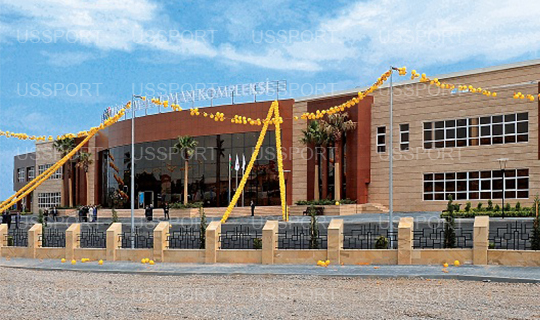
Olympic sports complex located in the center of Imishli city was put into operation in 2011, May 5. The main building with a construction area of 12 thousand square meters is two-story and consists of 5 parts. On the first floor, there are spacious halls for boxing (17×25 m) and wrestling (17×25 m). The halls are equipped with all the necessary sports equipment.
The swimming pool is 25 meters long and 12.5 meters wide. A special dehumidification unit was installed here, and 160 seats were installed around the pool.
On the second floor, there is a gym, a chess room, and administrative rooms.
The universal sports hall is 47.4 meters long and 24.3 meters wide. 822 seats have been installed here for the spectators watching the competitions. The hall has all the conditions for holding international competitions in mini-football, basketball, volleyball, as well as gymnastics, boxing, and wrestling.
The 60-seat conference hall is located on the second floor.
Football (68×46 m), basketball (36×18 m), and volleyball (36×18 m) pitches have also been built in the yard of the complex.
The 14-room hotel of the complex has 32 beds. All conditions have been created here for the comfortable rest of both athletes and guests. The hotel is equipped with a special ventilation system.
The canteen of the complex can be used by 100 people at the same time.
With a total area of 5 hectares, the yard of the complex covers an area of 11 thousand square meters. The sports facility has been provided with a boiler house, a transformer substation, a water reservoir, artesian wells, and a security and fire-fighting system installed. Separate gas, electricity, water, and sewage lines have been built in the complex.
Gabala Olympic Sports Complex
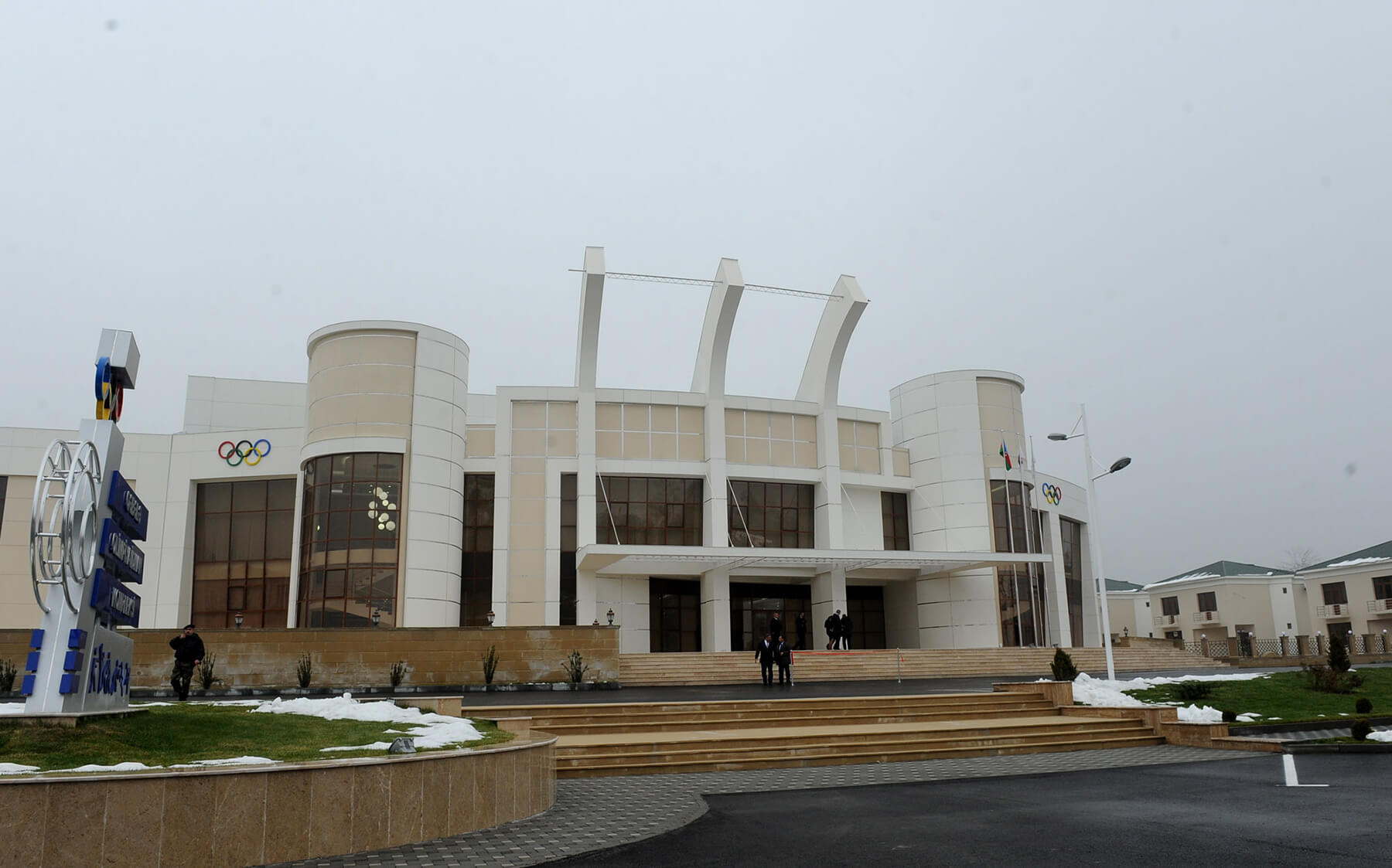
Gabala Olympic Sports Complex was put into operation in November 2011, 17.
The construction of the complex began in 2007, and it is located in the city center. 4.3 hectares of land have been allocated for the construction of this huge sports facility. The construction area of the main building is 9 thousand square meters.
The two-storied complex has a 744-seat sports hall (48×24 m), a swimming pool with a capacity of 79 spectators (25×12.5 m), gyms, a canteen, training rooms, and cottages. The complex has been provided with the necessary equipment for the development of various sports in Gabala at the level of modern standards.
There are all the conditions here for athletes to spend their leisure time efficiently. For this purpose, billiard and tennis tables have been installed on the second floor of the complex.
744 seats have been installed in the gym, where international tournaments on mini-football, basketball, volleyball, gymnastics, boxing, and wrestling will be held. Separate gyms for men and women have been created here. The halls are provided with modern equipment.
The open stadium with artificial grass cover (104×68 m) has a capacity of 1409 spectators. In addition, there is mini football (40×20 m), tennis court (40×20 m), basketball court (36×19 m), and volleyball court (36×19 m).
Three two-storied cottages with all the conditions have been built on the territory of the complex. Each cottage has 8 beds. Both athletes and guests will be able to relax here.
Sumgayit Olympic Sports Complex
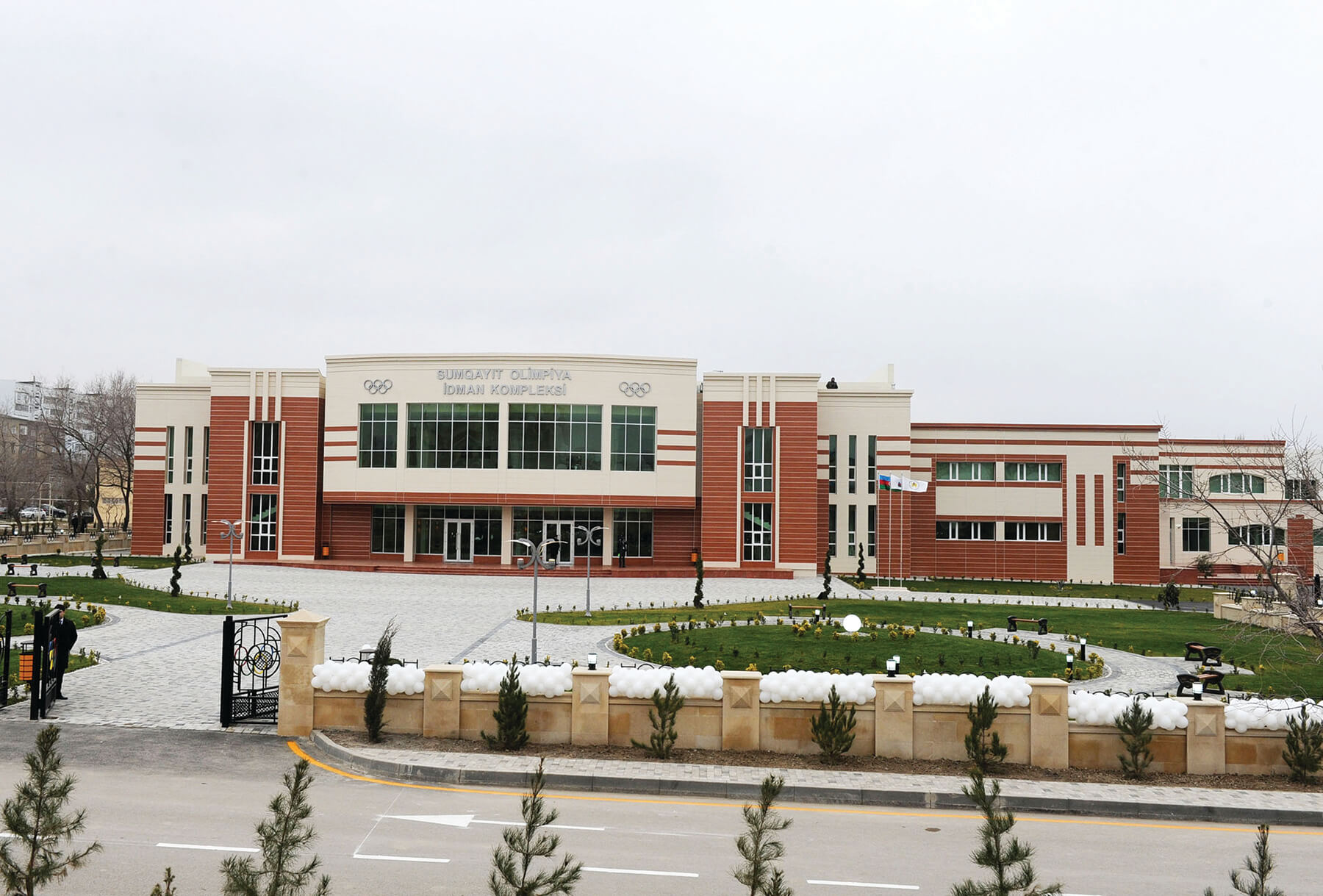
Sumgayit Olympic Sports Complex was put into operation in December 2011, 19.
The complex was built by order of the Ministry of Youth and Sports on the instructions of the President of Azerbaijan. Three hectares of land were allocated for the construction of the complex in the 7th district of the city. The construction of the complex began in 2007 and consists of three parts.
The gym and weightlifting halls, as well as the shooting range of the complex, have the latest equipment for young people to engage in these types of sports. It is possible to conduct various training and other events in the cinema at the complex. There is also a modern swimming hall (25×12, 5 m), which allows holding competitions of different levels.
The weightlifting, swimming pool, and sports halls of the complex have locker rooms, showers, sauna cabins, massage rooms, and other technical rooms. According to the general plan, a football stadium with artificial grass cover with a length of 70.2 meters and a width of 51 meters has been built on the territory of the sports facility. There is also a 110-meter-long running track, outdoor basketball (40×17.5 m), volleyball (15.2×35.2 m), tennis (40×17.5 m) pitches.
Extensive landscaping work has been carried out on the territory of the complex and the green areas laid out.
The three-storey hotel built on the territory of Sumgayit Olympic Sports Complex consists of 42 people. 17 double, 7 single, and one luxury rooms fully meet modern requirements.
A universal sports hall with dimensions 51×21 m for 804 seats allows holding large-scale competitions of international and local importance.
The hall, 47.6 meters long and 23.3 meters wide has all the conditions for playing basketball, volleyball and other sports. There are table tennis and billiard tables on the second floor of the complex.
Astara Olympic Sports Complex
Astara Olympic Sports Complex was put into operation in March 2012, 13.
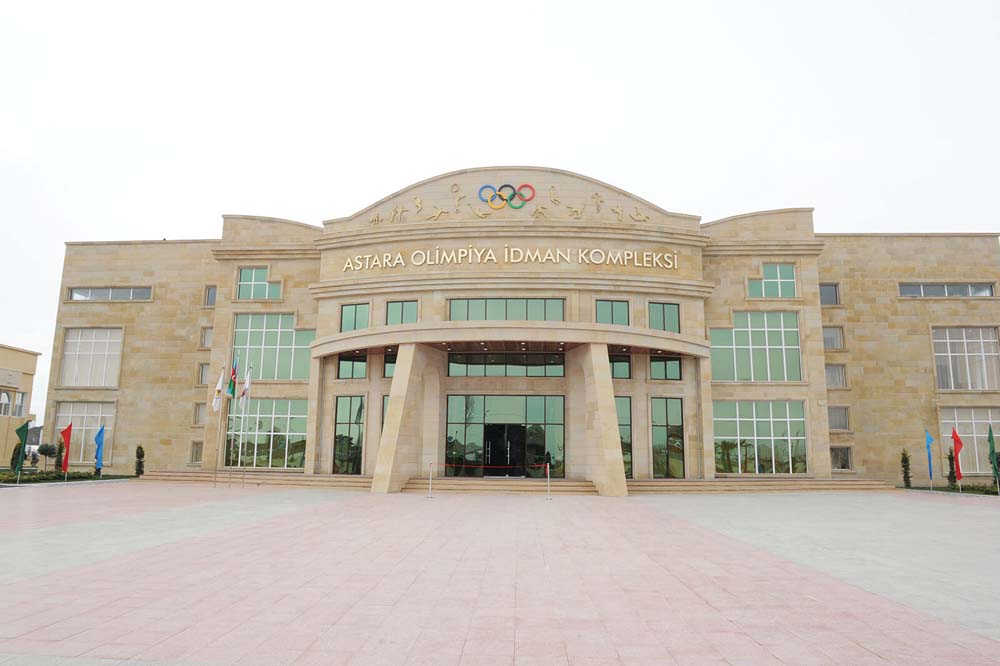
The construction of the complex covering an area of 5 hectares began in 2006 and was carried out at a high level.
The large sports hall for 936 persons (50×30 m) of the complex has all the conditions for conducting mini-football, volleyball, basketball, and tennis competitions. Training halls, as well as a swimming pool with 172 seats (25×12.5 m) also meet international standards.
It is possible to hold various events in the living room and conference hall created within the complex.
In 4 two-storied cottages built on the territory of the Complex, 40 people can stay at the same time. Each cottage has 10 beds.
On the territory of the complex, there is an open football field of size 65×46 m. There is also a running track around the pitch. The area also has outdoor volleyball (16×35.2 m) and basketball (40×17.5 m) playgrounds.
Jalilabad Olympic Sports Complex

Jalilabad Olympic Sports Complex was put into operation in July 2012, 31.
The sports facility meets the latest standards and covers an area of 5.36 hectares. All conditions have been created in the universal sports hall with a capacity of 724 spectators (45×48 m) for conducting mini-football, basketball, volleyball, wrestling, judo, taekwondo, and other sports at a high level.
The second floor also attracts attention with its spaciousness and modernity. Various study rooms and gyms are located here. Athletes practice shooting on a pneumatic beam installed here. There is also a large gym on the second floor. Those interested can play billiards and table tennis in the complex, which is equipped with various equipment for seventeen sports types. In the chess room, 10 people are taught the secrets of this ancient game at the same time. With the help of an electronic monitor installed on the wall, young people are taught the subtleties of chess.
The judo hall and the five-lane swimming pool also meet the latest standards. The length of the pool is 25, width is 12.5 meters. Dressing rooms, showers, and saunas are designed to meet the latest standards for both swimmers and other sportsmen.
Artificial coated football ground (104×68 m) has been created in the complex. There are 900 seats in the stands of the football field. There are two running tracks measuring 5×110 meters on the edge of the square. In addition to the football field, there is a tennis court (36×18 m), a basketball court (36×18 m), and a volleyball court (27×18 m).
A 48-seat, 24-room three-storey hotel has been built on the territory of the complex. On the first floor there is a conference room for 42 people, a dining room for 65 people, on each of the second and third floors there is one deluxe and 11 standard rooms.
Gobustan Olympic Sports Complex
Gobustan Sports Complex was built by the order of the Ministry of Youth and Sports of the Republic of Azerbaijan and started to operate on May 1, 2013.
The sports complex building consists of the universal gym with a capacity of 900 seats, size 50×24 meters, a gym, 2 dressing rooms for athletes, showers and bathrooms, coaching room, medical center, wardrobe for spectators, 2 bathrooms for spectators.
A football pitch of 66×34 meters with artificial grass cover, a basketball pitch of 26×18 meters, and a volleyball pitch of 26×18 meters have been built on the territory of the complex. A recreation area has been created on the territory of the complex.
Shirvan Olympic Sports Complex
The construction of the Shirvan Olympic Sports Complex was started by order of the Ministry of Youth and Sports and put into operation on July 1, 2013.
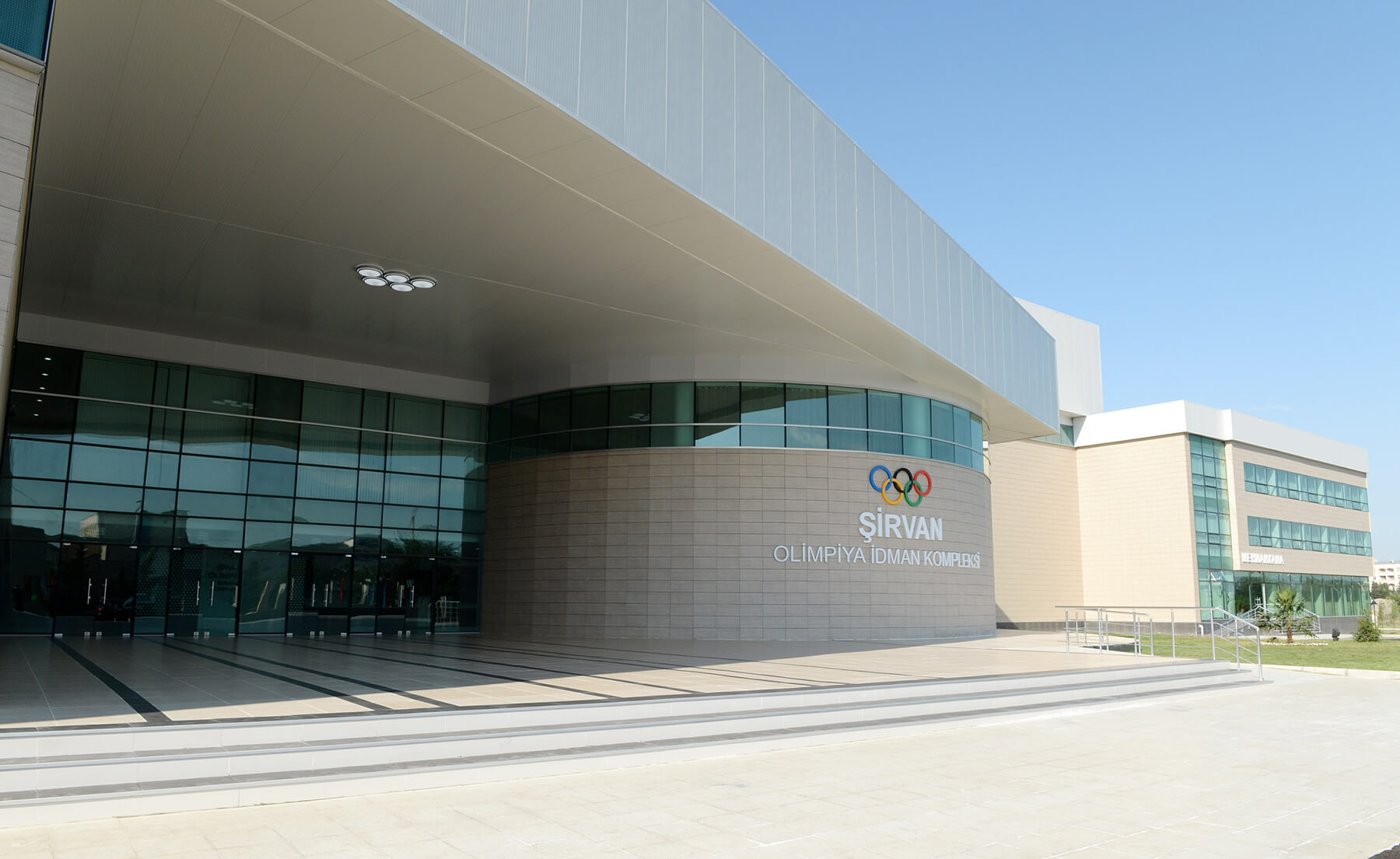
The main building consists of 5 blocks:
Block A — Swimming part of the hall: the size of the pool is 50x24m, the number of seats for the audience is 372 people. On the first floor, there is a doctor’s room, a coach’s room, 2 dressing rooms, a sanitary unit, and a shower room. On the second floor, there is a gym, a coach’s room, a director’s room, a reception room, administrative rooms, and other ancillary rooms.
Block B — Wrestling, Judo, and Boxing section of the hall (48x36m): the size of the Wrestling Hall is 30x20m (with 2 tatami pads), the number of seats for spectators is 222 persons. On the first floor, there is a foyer area, a registration room, an instructor’s room, a press room, 3 doctors’ rooms, a sauna, a massage room. On the second floor, there is a judo hall (12×24) and a boxing hall (19×20), a coaching room, a training room and a dressing room for these halls, a bathroom, and a shower room.
Block C — The size of the universal sports hall is 48×40 meters, the number of seats for spectators is 780 people. There is a foyer area, sanitary units for spectators, and technical rooms here.
Block D — Three-storey hotel section: There are 14 2-seater, 2 3-seater, 4 luxury living rooms, 64-seater restaurants, kitchen, laundry, reception, and administrator room.
Block E — There is a 50-seat conference hall, a billiard room, a cafe bar, a food distribution room, etc. also there are ancillary areas.
The football stadium measures 105×65 meters. At the same time, a grandstand for 1260 spectators was built at the stadium, changing rooms, showers, toilets, a modern lighting system, and an electronic scoreboard were installed. The stadium has a 120×7.6 meter long-running track with artificial grass cover. In addition, a large tennis court measuring 40×20 meters with artificial grass cover and a sports field for mini-football were built in the sports complex.
Khachmaz Olympic Sports Complex
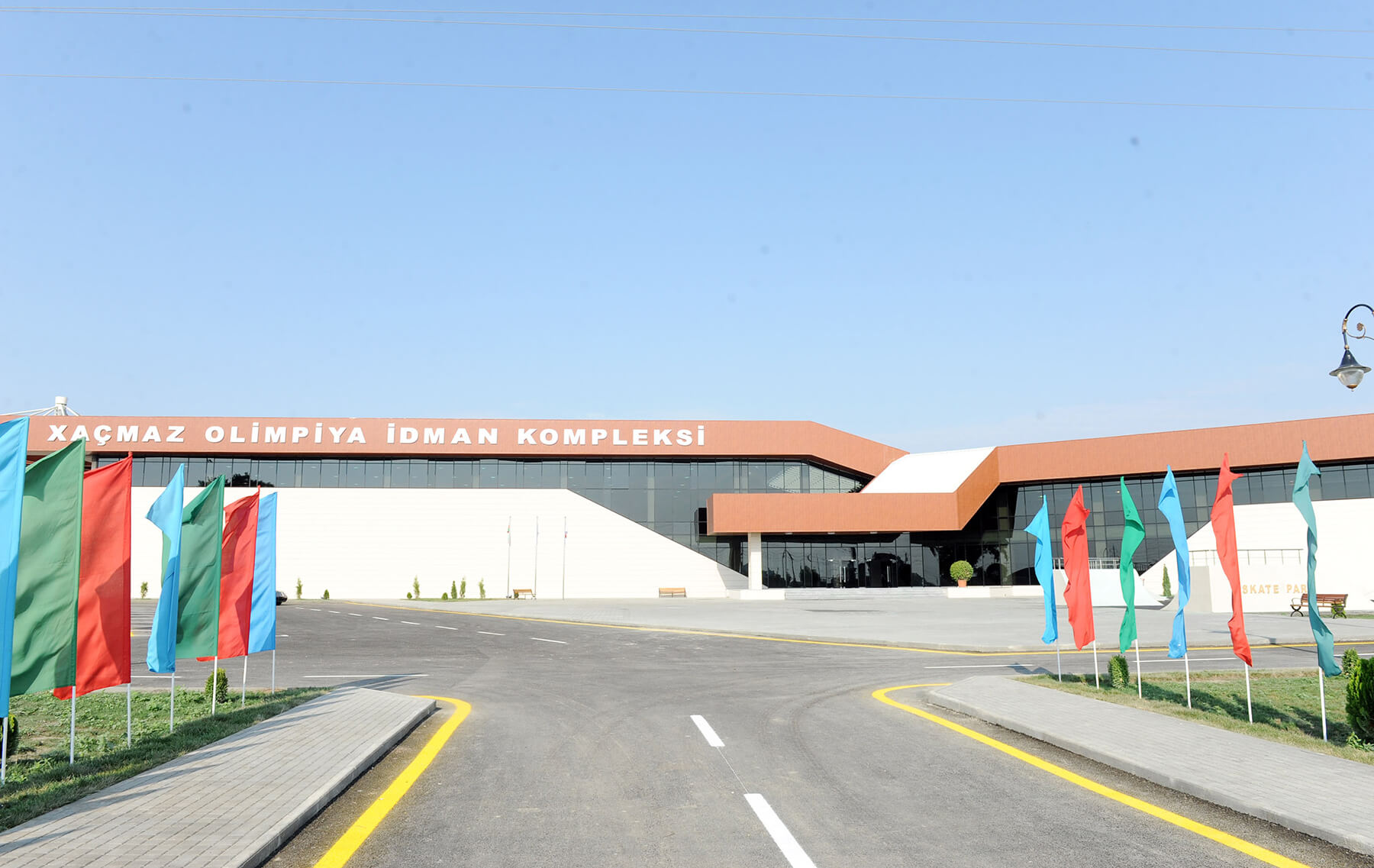
Khachmaz Olympic Sports Complex was built by the order of the Ministry of Youth and Sports of the Republic of Azerbaijan and put into operation on July 19, 2013. The building of the Sports Complex consists of 3 blocks.
Block A on the first floor has a universal gym. The size of the hall is 48x22m, the audience capacity is 749 people. On the second floor, there is a wrestling hall with two mattresses.
Block B has a 50-seat dining room on the first floor, a 50-seat conference room, and a billiard area on the second floor along with the service rooms.
Block C has the swimming hall which consists of two parts. The size of the swimming pool for adults (25×12.5 m), the size of the pool specially built for children it is 8.75×6 meters. On the second floor, there is a gym and ancillary rooms.
In the courtyard of the complex covering an area of 6 hectares a stadium, mini-football, and basketball courts have been built. The stadium (90×66 meters in size) has a 6 lane track with epidemic coating and 3 long jump tracks for athletics competitions. The stadium has a covered stand with a capacity of 1,300 spectators, a modern lighting system, and an electronic scoreboard. In addition, a mini football pitch of 44×22 meters in size with an 8 mm artificial grass cover has been built in the stadium and equipped with a lighting system.
For the first time in Azerbaijan, Skate Park operates at the Khachmaz Olympic Sports Complex. There is also a hotel with 18 double rooms and 3 two-room luxury rooms in the complex. All conditions have been created at the hotel for the comfortable rest of athletes and guests. Four 2-storey standard and one 2-storey luxury cottages have been built on the territory of the complex. Standard cottages have 1 living room and 3 bedrooms for 2 persons, luxury cottages have 1 living room, 2 bedrooms, kitchen, wardrobe, 2 bathrooms, and shower rooms. The total capacity of cottages is 28 people.
Gakh Olympic Sports Complex
Gakh Olympic Sports Complex was built by the order of the Ministry of Youth and Sports of the Republic of Azerbaijan and put into operation on August 16, 2013.
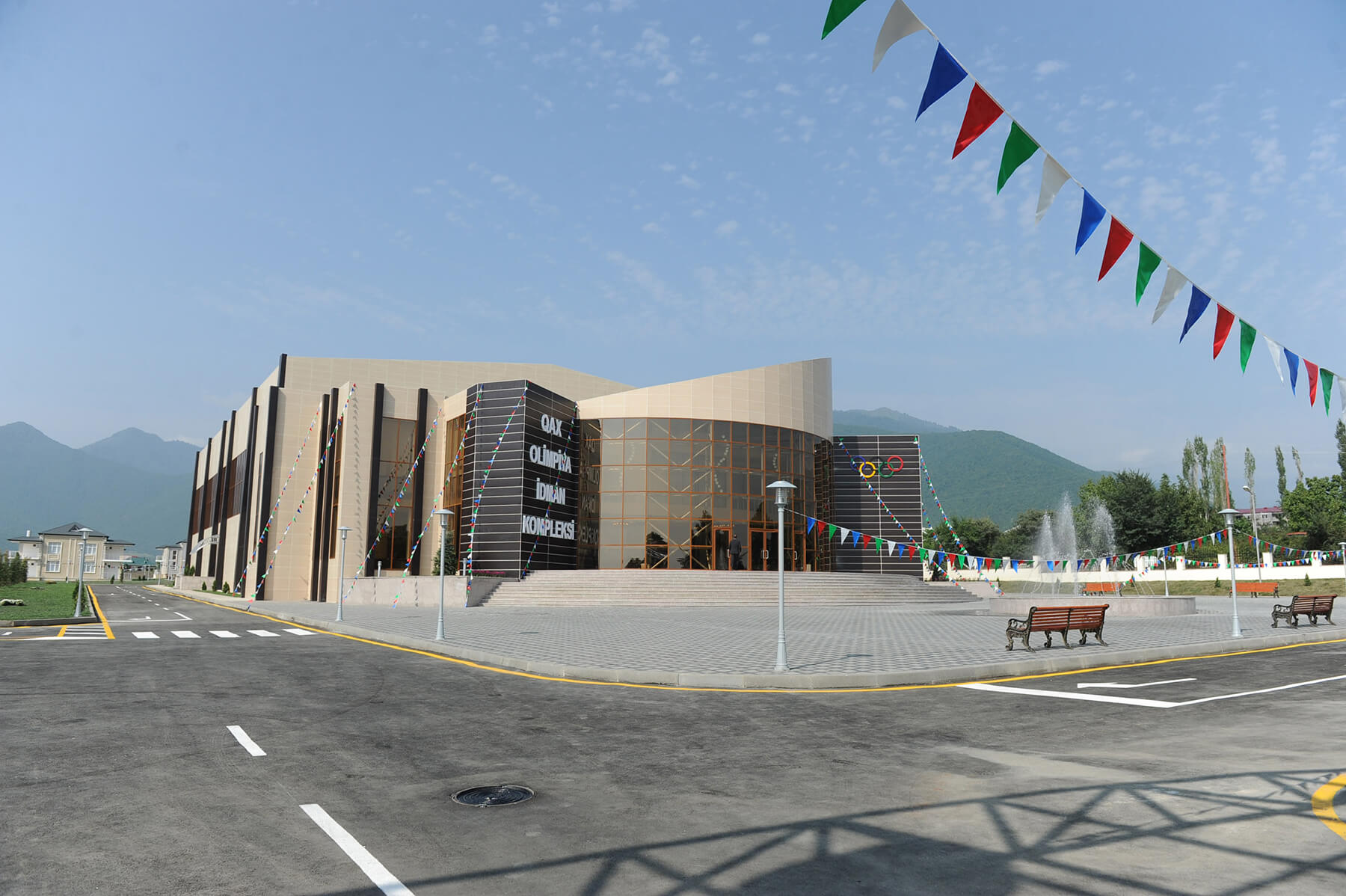
The Universal gym (the size of the hall is 53×30 meters) is designed for an audience of 496 people. There are 2 locker rooms for athletes, a bathroom, shower rooms, and a coaching room. The complex has a swimming pool. The size of the swimming pool is 25×12,5 meters, the number of seats for spectators is 288. There are 2 locker rooms for athletes, a bathroom, shower rooms, and a coaching room.
The Gakh Olympic Sports Complex has an 18-bed, 9-room local hotel. Also, five 2-storey cottages have been built on the territory of the complex. Each cottage building consists of 4 rooms. Each cottage consists of 4 rooms. Each room has 1 bedroom with 2 beds, 1 living room and a bathroom (with shower). In total, 5 cottages are designed for 40 people.
A stadium for 938 people (105×70 meters) with artificial grass has been built on the territory of the complex.
In addition, an artificial coated basketball court (18×36 m), volleyball court (15×24 m), Tennis court (18×30 m) has been provided with the lighting system.
Saatli Olympic Sports Complex
Saatli Olympic Sports Complex was put into operation on August 2013, 29.
The total area of the complex is 6 hectares. The universal sports hall with a total area of 3,340 square meters has 432 seats. At the same time, 400 spectators can watch the competitions from the lodges. There are two locker rooms for athletes, a coach, and other ancillary rooms here. On the first floor of the administrative section, there is a large vestibule, an information center, a registration part, a restroom. On the second floor there is a gym, a cafe, offices and working rooms, a conference hall and a wrestling hall. The complex includes an open stadium for 900 seats, a tennis court, a basketball court.
The swimming hall which was built according to modern standards can accommodate 200 people. The complex has five two-storey cottages. Each cottage has four rooms.
Goygol Olympic Sports Complex
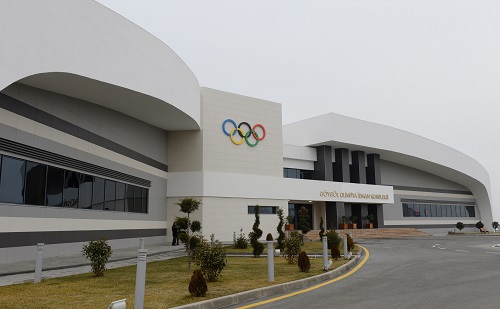
Goygol Sports Complex was built by the order of the Ministry of Youth and Sports of the Republic of Azerbaijan and started operating on January 21, 2014.
The building of the Sports Complex consists of 3 blocks. At the entrance to the building, there is a foyer with an area of 450 m2, a cafe for 50 people.
A block-I Floor: Wrestling hall with double mattress (27×21 m), gym (19.8×6 m), and terrace with an area of 164 m2 are located. II floor: Boxing hall (19.8×10. 5 m), and a conference room.
Block B-swimming pool size 25×12.5 meters, a number of seats for spectators for 102 people, 2 dressing rooms, 2 saunas and etc.
Block C-Universal gym (50×36 m), the number of seats for the audience is 800 people, and VIP tribune is located. In addition, on the first and second floors, there are 17 bedrooms for 2 athletes (34 people in total) and 2 bathrooms for spectators.
Five 2-story cottage buildings have been built on the territory of the complex. The cottages have 1 living room and 4 double bedrooms. The number of accommodations in the cottages is 40 people, with 8 people in each cottage. A 34-bed hotel with 17 rooms has also been built on the territory of Goygol Sports Complex. A football stadium measuring 105×68 meters, a pitch with artificial grass cover, a 6-lane 100-meter running track with an epidemic covering, and a long-jump track are built around the stadium for athletics competitions. At the same time, a covered grandstand for 1,300 spectators was built at the stadium and an electronic scoreboard was installed. In addition, a 40×24 meter mini football field and an 18×9 meter artificial grass cover volleyball court were built in the area the perimeter of the playgrounds were fenced with a 6-meter-high metal-porous fence and equipped with a lighting system.
YOUTH POLICY
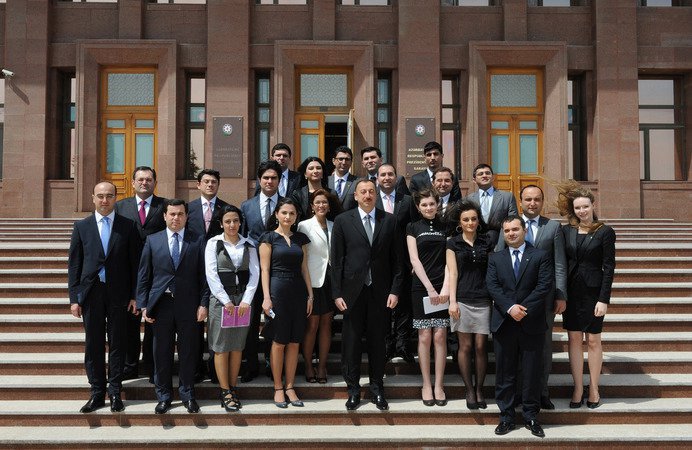
In the 1990s, national leader Heydar Aliyev took decisive steps to increase the role of retail Azerbaijani youth in the development of society and solve their problems, increase their participation and responsibility in the future development of the country, and create conditions for youth exchange in the capital and regions. June 26, 1994 Establishment of the Ministry of Youth, Sports and Tourism (now the Ministry of Youth and Sports), holding the first Azerbaijan Youth Forum on February 2, 1996, adoption of the Law “On Youth Policy” on April 9, 2002, is the best example of this.
The main development of a new generation is ensuring the participation of young people in the socio-economic, socio-political, and cultural life of the state and society, in general, the implementation of state youth policy in the country is entrusted to the Ministry of Youth Affairs and Sports, which is the main state body responsible for this. The main directions of youth policy are determined by the Law of the Republic of Azerbaijan” About youth policy ». This includes issues of spiritual and moral education and participation of young people in cultural life, state care for talented youth, health and physical development of young people, ensuring their employment, providing state assistance to young families and youth organizations.
This policy initiated by the Great Leader is successfully continued by Ilham Aliyev. In accordance with the purpose of the « Azerbaijan State Youth Program » (2005-2009) signed by the President of the Republic of Azerbaijan in 2005, the tasks set were implemented at a high level. 2007 has been declared the « year of youth » in order to evaluate the services of young people in culture, public administration, and other areas with the purpose of active participation of Azerbaijani youth in the socio-political, economic, and cultural life of the country, solution of their social problems and protection of their rights, effective implementation of the relevant state program on all aspects of youth policy, increasing state care for young talents, evaluation of youth services in science, education, economy.
By the decree of the president of the Republic of Azerbaijan dated January 30, 2006, No. 359, “Youth Foundation under the president of the Republic of Azerbaijan” was established on the basis of the Ministry of Youth, Sport and Tourism of the Republic of Azerbaijan, by the decree of the Ministry of Youth and Sports of the Republic of Azerbaijan, issued on December 2011, 19.
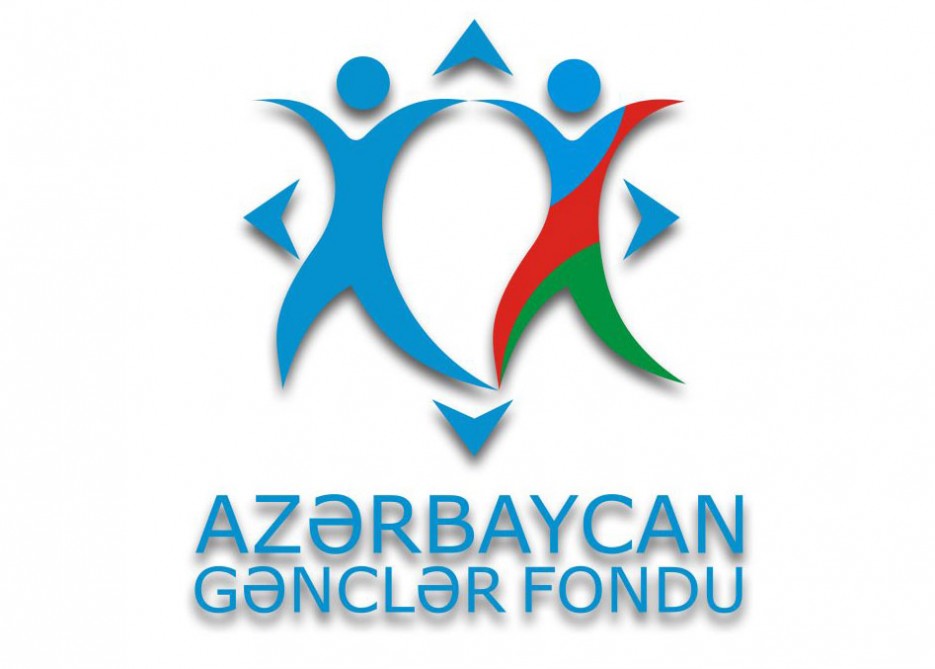
The Order signed by the President on the approval of the State Program « Azerbaijani Youth 2017-2021 » is the third State Program on Youth.
According to the relevant paragraph of the State Program, during the period covered by the document, it is planned to declare one region or city of the country « Youth Capital » every year. In this regard, young people who took part in the online voting voted more for the city of Nakhchivan, thus demonstrating that they consider this magnificent city, rebuilt in harmony with antiquity and modernity, the most ideal place to become the « Youth Capital » in 2018.
On March 7, 2018, President Ilham Aliyev signed a decree on measures to improve governance in the field of youth policy in the Republic of Azerbaijan. According to the decree, the Youth Foundation of the Republic of Azerbaijan was established on the basis of the Youth Foundation under the President of the Republic of Azerbaijan, and the Charter of this organization was approved. Execution of the powers of the founder is entrusted to the President of the Republic of Azerbaijan, the Cabinet of Ministers, and the Foundation itself.
FORUMS OF AZERBAIJANI YOUTH
The first forum of independent Azerbaijani youth was held on February 2, 1996. President of the Republic of Azerbaijan Heydar Aliyev personally attended the forum.
On February 1, 1997, on the occasion of the anniversary of the forum, Heydar Aliyev received a group of young people and signed an order « On the proclamation of February 2 – Azerbaijan Youth Day. » Since then, every year on February 2, Azerbaijan has traditionally celebrated Youth Day.
The II forum was held in 1999 in Baku. The forum was attended by the President of the Republic of Azerbaijan Heydar Aliyev.
The III forum was held on October 13, 2003, in Baku.
The IV forum was held in Baku in 2005.
The V forum was held on October 3, 2008, in Baku.
The VI forum was held on October 25, 2011, in Baku.
The VII forum was held on June 2-3, 2014 in Baku.
The VIII forum was held on November 16, 2018, in Baku.
YOUTH ORGANIZATIONS
The Ministry of Youth and Sports has established close ties with all children’s and youth organizations, has done a lot to direct their activities in a targeted direction, to finance programs and projects. At present, more than 300 youth organizations are registered with the Ministry of Justice.
In order to ensure the participation of youth non-governmental organizations (public associations and foundations) in the decision-making process related to the implementation of state youth policy, the Public Council for Youth Affairs has been operating under the Ministry of Youth and Sports since 1994. Recently, youth organizations have moved away from the center and prefer to operate in more regions. Thus, Ganja, Mingachevir, Sumgayit, Sheki, Bilasuvar, Samukh, Ismayilli, Shirvan, Hajigabul, Lankaran, Barda, Absheron, Gazakh, Zagatala, Gobustan, Goychay, Guba, Saatli, Gusar, Masalli, Astara, Zardab, Goygol, Ujar, new organizations were established in Beylagan and most of them were registered. Recently, youth organizations have moved away from the center and prefer to operate more in regions. Thus, Ganja, Mingachevir, Sumgayit, Sheki, Bilasuvar, Samukh, Ismayilli, Shirvan, Hajigabul, Lankaran, Barda, Absheron, Gazakh, Zagatala, Gobustan, Goychay, Guba, Saatli, Gusar, Masalli, Astara, Zardab, Goygol, Ujar, New organizations were established in Beylagan and most of them were registered.
Currently, more than 35 youth organizations represent Azerbaijan on the international platform. For comparison, representation on international platforms has doubled in the last 10 years. Hearing the victory of the Azerbaijani youth from all continents of the world is a logical consequence of the integration of our state into the world community. Youth organizations of the republic establish contacts with the UN, the Council of Europe, ECO, GUAM, CIS, and other international organizations, implement joint projects. All this proves the formation of intellectual Azerbaijani youth.
TOURISM POLICY OF AZERBAIJAN
Azerbaijan is located at the junction of East and West, the main historical point of the Great Silk Road, and a country open for travelers and merchants from all over the world for centuries. Caravans loaded with silk, sweets, gold, and pearls traveled to the countries of Europe and the East.

Famous English traveler and merchant Anthony Jackson (XVI century), Russian traveler Afanasi Nikitin “traveling behind 3 Seas” (XV century), famous writer-traveler of XIX century Alexander Dumas and other outstanding personalities visited Azerbaijan.
It is not surprising that Azerbaijan’s rich history, cultural and natural heritage attract tourists from many parts of the world and bring them to this country. The warm Caspian Sea, mild climate, and untouched nature form the basis of beach, active, and hunting tourism.
The development of tourism is necessary for any country with such beautiful nature and natural resources as Azerbaijan. The country is rich in well-groomed sights, high-class resorts that do not lag behind World resorts. Recently, magnificent hotels are being built in four corners of the country: the Shahdag ski center with six hotels in Gusar; the second ski resort in Gabala; the beautiful hotel “Quba Palace” in Guba, etc.
Azerbaijan is an amazing country. Everything here — nature and culture, history and architecture, Customs and traditions are unusual. In Nakhchivan, Kalbajar, Lenkeran, and Babadag, boiling water come out from under the ground, there is a fire temple Ateshgah in Surakhani, and there are also a number of places of interest.
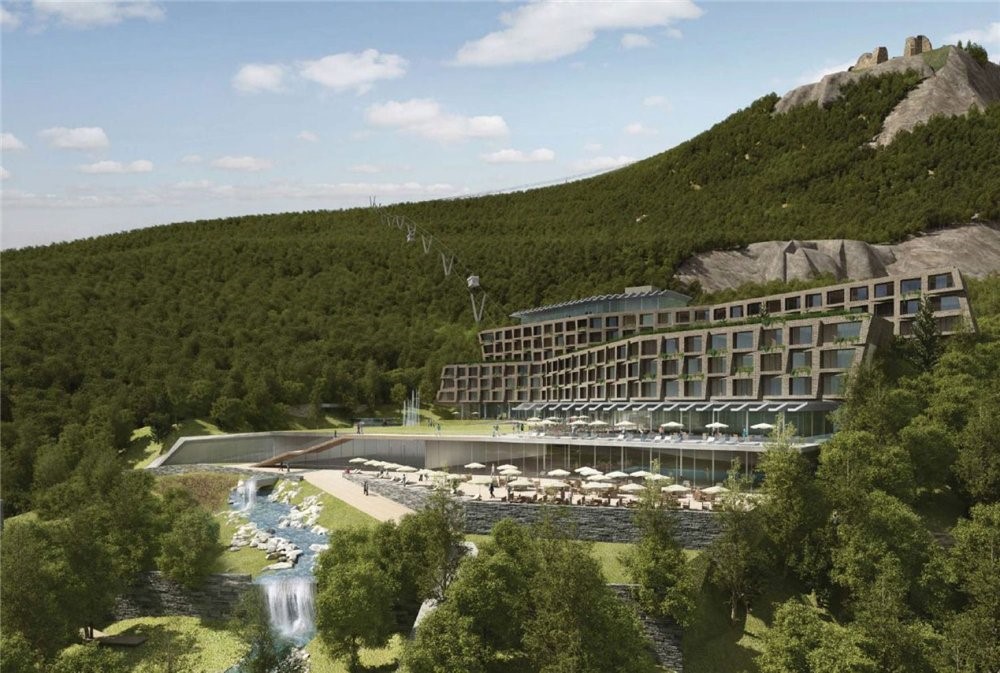
Everyone who wants to restore and strengthen their health is applying to numerous health centers of Azerbaijan. Due to the unusual climate of the southern region, there are numerous healing centers in Lankaran and surrounding areas. The world-famous Naftalan resort has unique biological quality treatment methods. Naftalan is the place where there is a special kind of oil field, which has healing power, which is unique in the world. All these factors are indicators that contribute to the creation and development of medical tourism in Azerbaijan.
Unique architecture, primitive culture, and multi-faceted national cuisine attract tourists from all over the world.
Mugham, which is considered the traditional music genre of the Azerbaijani people, was included in the UNESCO non-Cultural Heritage List and created a new tourist trend-mugham tours.
In summer, ecological tours — hiking natural reserves and hunting routes are common in Azerbaijan. They can be easily combined with ethnographic tours. It is also very interesting to visit Lahij, which is located in the ancient village of Guba, Khinalig, Ismayilli, and preserved the traditions of middle-century copper works.
Tourists visiting the capital of Baku definitely want to visit the historical-architectural reserve — the Shirvanshahs ‘ Palace and the “Maiden Tower” Icheri Sheher, which is listed on the UNESCO World Heritage list.
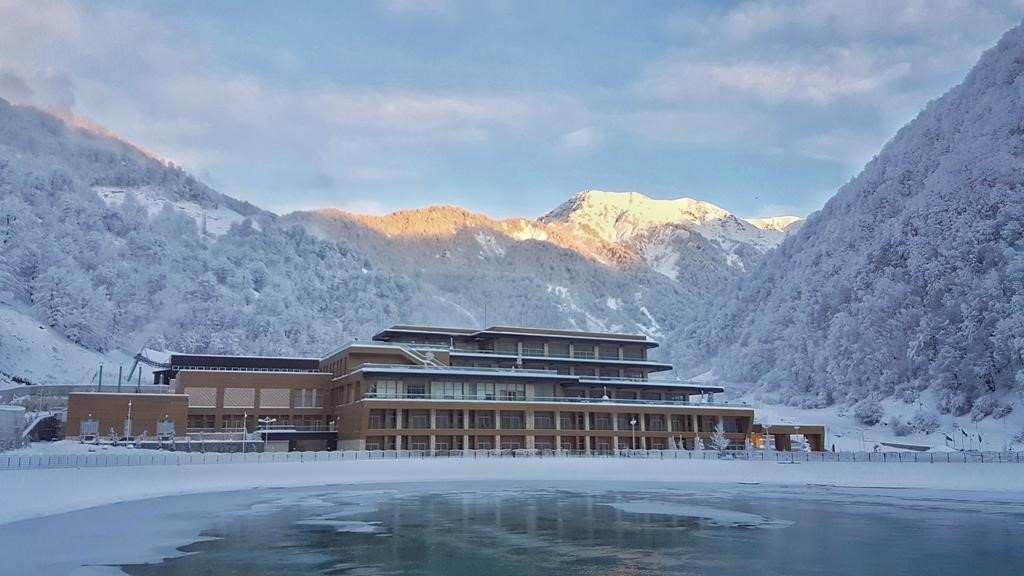
Azerbaijan has become a tourist center in the region. AITF — “Tourism and travel” — is held every year in the country, which allows hundreds of people from all over the world to come together.
In 2018, a state Tourism Agency was established on the basis of the Ministry of Culture and Tourism of the Republic of Azerbaijan. The state tourism agency functions as a central executive body implementing state policy and regulation in the field of Tourism.
The most famous hotels in Azerbaijan are the following: Four Seasons Hotel Baku, Hyatt Regency, JW Marriott Absheron Baku Hotel, Grand Hotel Europe, Fairmont Baku, Intercontinental, Pullman Baku, Hilton Baku.
Hotels, leisure places, entertainment and sports centers operate in the provinces of Azerbaijan, including Shahdag Mountain Resort, « Qafqaz Riverside », « Shamakhi Palace Sharadil », “Chinar Hotel Naftalan”, « Rixos Guba Azerbaijan », Markhal Resort, “Galaalti », Duzdag hotel in Nakhchivan. In addition, winter and summer tourist complexes Shahdag and Tufandagh, Aghbulag Ski Center in Nakhchivan, about 50 Olympic sports complexes and facilities with important infrastructure are at the disposal of tourists throughout the year.
At present, a strategy for the development of tourism in liberated territories is being developed. In the near future, Karabakh and the Eastern Zangezur region will be presented to the world as a new tourist destination and become the main tourist center of Azerbaijan.
VISA REQUIREMENTS
Entry rules
In accordance with the legislation of the Republic of Azerbaijan, entry to the country is regulated by visa regime. According to the country of arrival, there are various privileges and restrictions for foreign citizens to obtain visas:
– visa-free entry;
– get a visa on arrival;
– obtaining an electronic visa (e-visa);
– get a visa at the embassy.
Visa-free regime
There are a number of countries where citizens have the right to visa-free entry into the territory of Azerbaijan for up to 90 days.
Belarus, Georgia, Kazakhstan, Kyrgyzstan, Moldova, Russia, Uzbekistan, Ukraine, Tajikistan.
Getting a visa on arrival
In order to facilitate and speed up visa issuance, citizens of some states may obtain a visa upon arrival at Azerbaijani airports. This visa will allow Azerbaijan to stay in the country for up to 30 days. This list includes the following countries:
Malaysia, Oman, Japan, China, Qatar, South Korea, Saudi Arabia, Singapore, Turkey, Kuwait, United Arab Emirates.
Electronic visa (e-VISA)
Also, the Ministry of Foreign Affairs introduced the possibility of obtaining a visa by e-mail. You can get a visa by filling out the form, which can be obtained from the official website. Registration of an electronic visa takes from 1 to 3 days. Visa payment is accepted through Visa and MasterCard payment systems. ASAN visa applies to citizens of 81 countries: United States, Albania, Germany, Andorra, Argentina, Australia, Austria, Belgium, UAE, Bahrain, Bulgaria, Bosnia and Herzegovina, England, Brazil, Brunei, South Africa, Czech Republic, Chile, China, Denmark, Estonia, Algeria, Finland, France, India, Croatia, Indonesia, Jordan, Iran, Ireland, Iceland, Spain, Israel, Sweden, Switzerland, Italy, Canada, Cyprus, South Korea, Costa Rica, Cuba, Kuwait, Qatar, Guatemala, Latvia, Lithuania, Liechtenstein, Luxembourg, Hungary, Macedonia, Malaysia, Malta, Mexico, Morocco, Monaco, Montenegro, Mongolia, Nepal, Netherlands, Norway, Oman, Pakistan, Panama, Poland, Portugal, Romania, San Marino, Serbia, Saudi Arabia, Singapore, Slovakia, Slovenia, Sri Lanka, Thailand, Turkey, Turkmenistan, Vatican City, Vietnam, Japan, New Zealand, and Greece.
E-Visa is issued within 3 (three) working days.
e-visa applications can be made by single, family (at least 2, up to 10 people) and group (at least 10, up to 300 people).
the information necessary for obtaining e-Visa is entered directly into the system.
the fee for e-Visa registration is paid electronically through the system.
the state fee for E-Visa is 20 US dollars. This fee is required for the consideration of the visa application and is not refundable under any circumstances.
The service fee in the amount of 3 US dollars is charged for processing e-visa applications. This amount is paid in addition to the state fee in the amount of 20 (twenty) US dollars for an electronic visa.
Payment transactions can be made only through Visa and Mastercard.
Get a visa from the embassy
If the country you are interested in does not belong to any of the above lists, a visa can be obtained by applying to the embassy of Azerbaijan. If there is no embassy of Azerbaijan in your country, you should apply to the embassy of Azerbaijan in the nearest country.
There are the following types of visas to Azerbaijan: tourist, transit, educational, business, humanitarian, business, and guest visas to Azerbaijan. Depending on the type of visa, the necessary documents and the conditions for issuing the visa vary, but the main document must be sent through the Consular Department of the Ministry of Foreign Affairs of the Republic of Azerbaijan.
The period of temporary stay of foreigners and stateless persons is determined by the period of stay in the country specified in the visa. The period of temporary stay in the Republic of foreigners and stateless persons on the basis of visas shall not exceed ninety (90) days. Foreigners and stateless persons respectively on (10) days (except weekends and holidays) of residence www.mia.gov.az. they can apply to the relevant authorities of the Ministry of Internal Affairs for registration.
Foreigners and stateless persons may apply to the State Migration Service for an extension of their temporary stay in the country (according to visa-free or visa-free rules) not later than seven (7) business days before the end of their stay in Azerbaijan.
Attention: if the validity period of the passport or identity card is less than 3 months, the visa cannot be issued.
HOTELS AND RECREATION AREAS
1. Sheraton Baku Hotel Airport
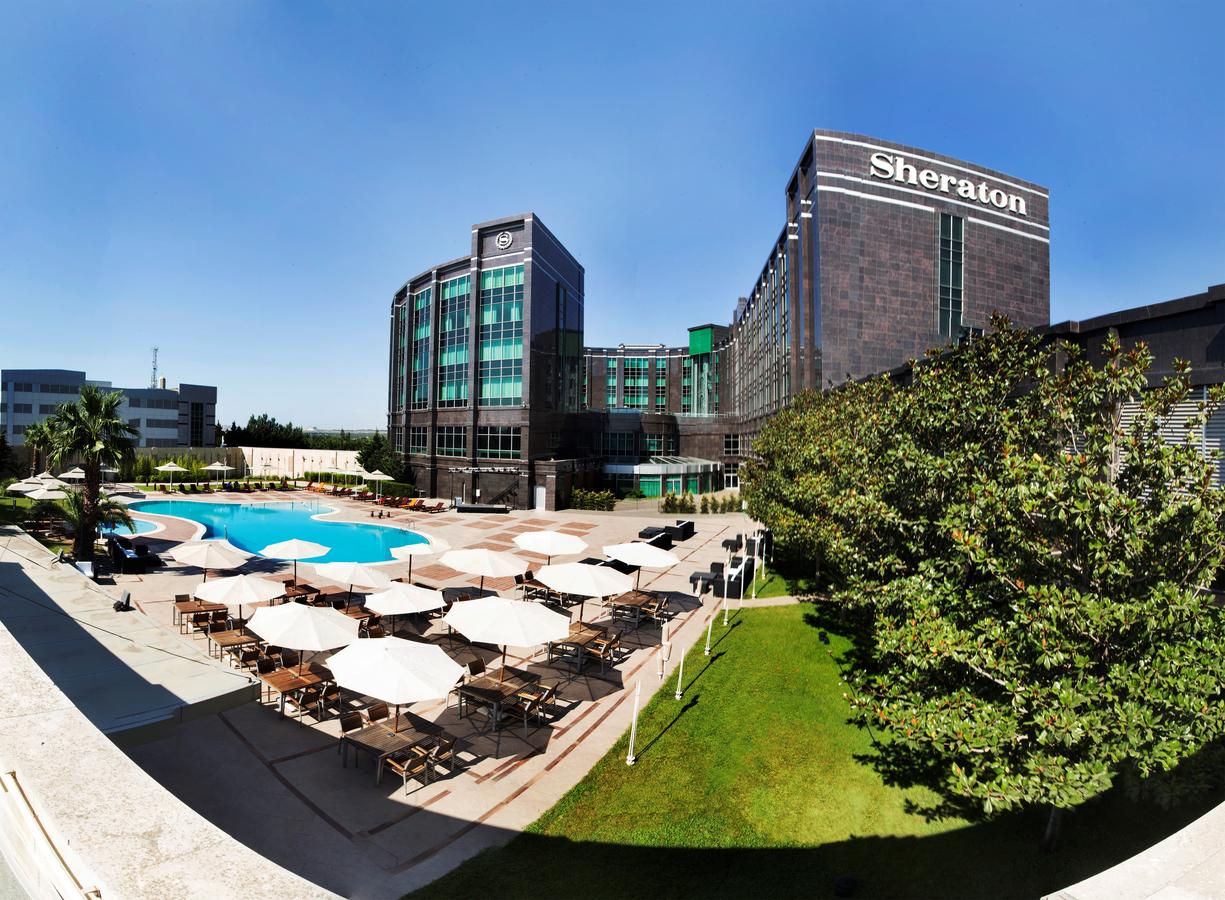
Baku, Heydar Aliyev International Airport
Distance to center — 16.8 km
The comfortable hotel is located 15 minutes from Absheron Beach.
Well-groomed rooms are offered, equipped with everything necessary for comfortable living. Here you will find comfortable furniture, a flat-screen TV. The private bathroom is equipped with a shower.
The snack is served with a delicious and satisfying breakfast. There are also many Mediterranean dishes. The bar offers drinks for every taste and choice.
The distance to the airport is 0.5 km, to the railway line-19.4 km. The main sights and architectural monuments can be reached in 25 minutes by car.
2. Ramada Hotel Baku
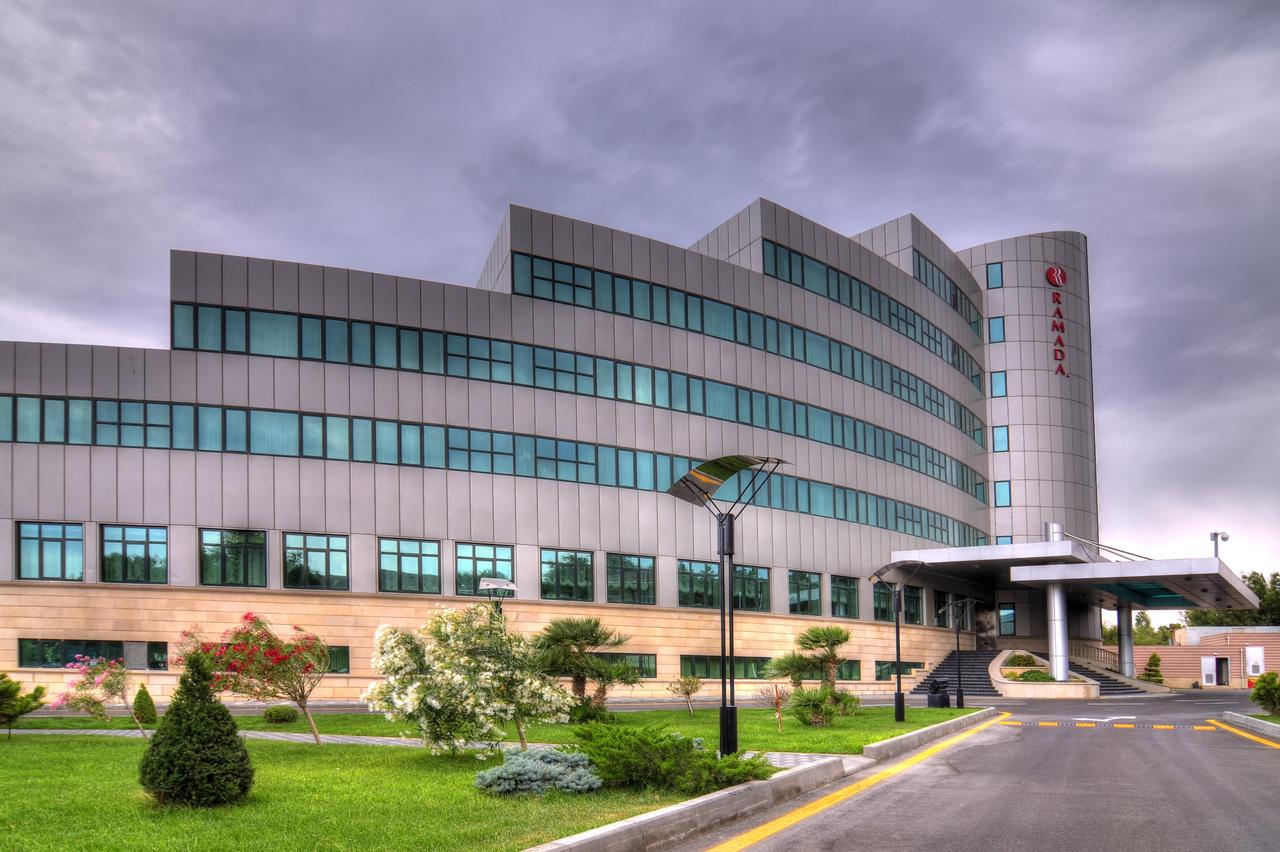
Baku, Salyan Highway, Shikhov 1023
Distance to center — 12.7 km
« Ramada Baku Hotel » is very close to the Sea coast. The beach can be reached in just a few minutes.
There are 79 comfortable rooms of different categories for accommodation. Each of them is made in an individual style, equipped with high-quality furniture and technical equipment for comfortable rest.
Lunch and dinner are available in the hotel’s restaurant. Delicious dishes of both European and national cuisine are served here.
You can rent a conference room for holding solemn ceremonies and business meetings. The distance to the nearest airport is 27 km and to the train station-9 km.
3. Aysberg Resort
Baku, Salyan Highway, Shikhov Beach
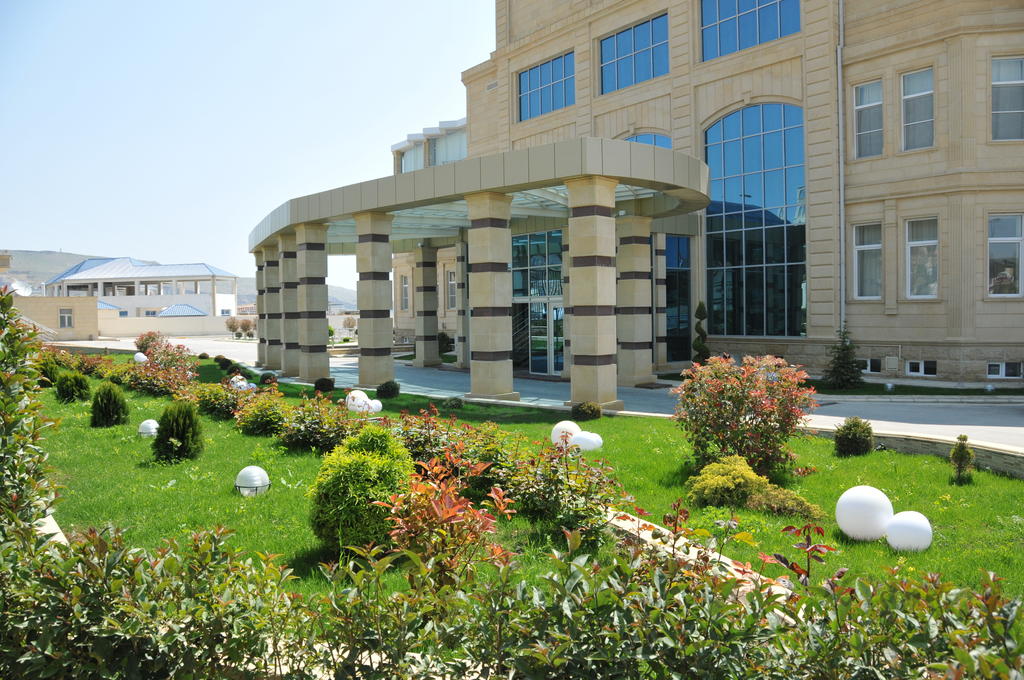
Distance to center — 13.3 km
« Aysberq Resort » is located in Baku. Upon arrival at the head of the apartment, you can use the transfer service at any time, and for arrivals with your own car, there are private parking lots. If necessary, you can use the laundry, as well as the pool and fitness center. Guests are provided with bright and comfortable rooms of various categories. All rooms have been painted with warm pastel colors, comfortable beds, high-quality furniture, and modern technical equipment. The private bathroom has all the necessary appliances.
The local restaurant » Isbek » offers excellent dishes on the menu. It is possible to order food and drinks in the room. You can also go to nearby cafes, bars or fast food points. A business center operates specifically for business people to conduct important negotiations, organize interviews or meetings.
Within two kilometers from the hotel, you can see Bibi-Heybat, Highland park, and Flame tow towers.
9.6 km from the hotel to the airport and 27.8 km to the railway station. there is distance.
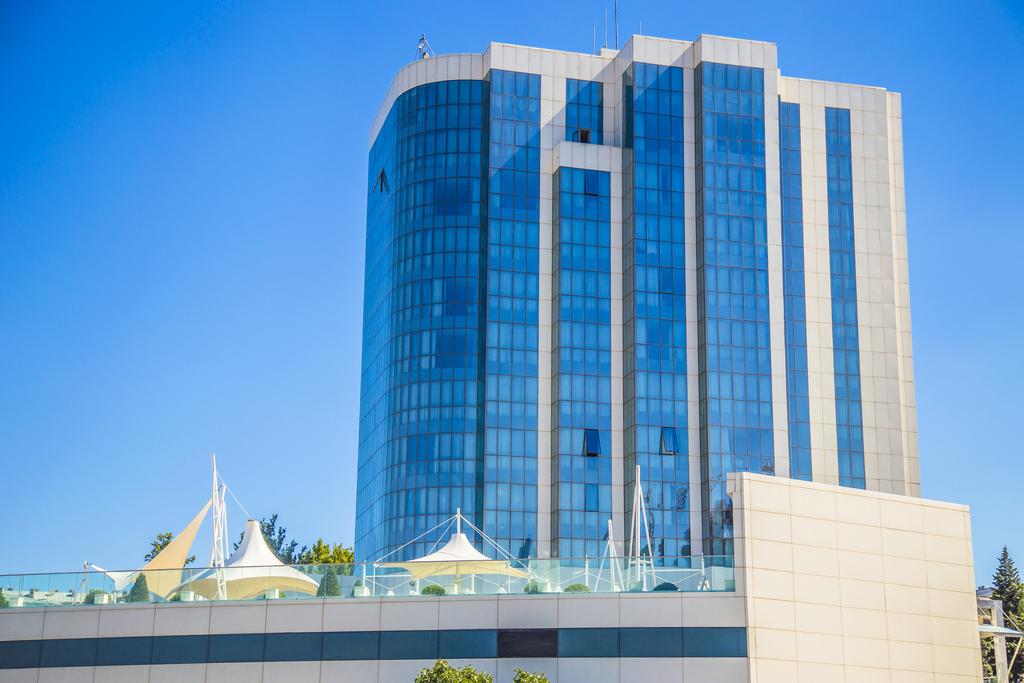
4. Golden Coast Resort
Baku, Mikayil Huseynov Avenue, 14
Distance to center — 7.4 km
« Golden Coast Resort » Hotel is located just a few steps from the Caspian Sea. The hotel offers the following services: luggage storage, air conditioning, Internet, 24-hour registration office, massage, sauna, and currency exchange. There are rooms of different categories for those who want to stay at the hotel. Each of them was created in an individual style, provided with high-quality furniture and equipment for comfortable rest.
Located on the territory of the hotel, the restaurant offers a wide range of dishes and drinks. A conference room for important events, banquets, and business meetings can also be rented.
The nearest railway station is located at a distance of 4 km, and the airport is about 21.9 km.
5. Intourist Hotel
Baku, Mikayil Huseynov Avenue, 51
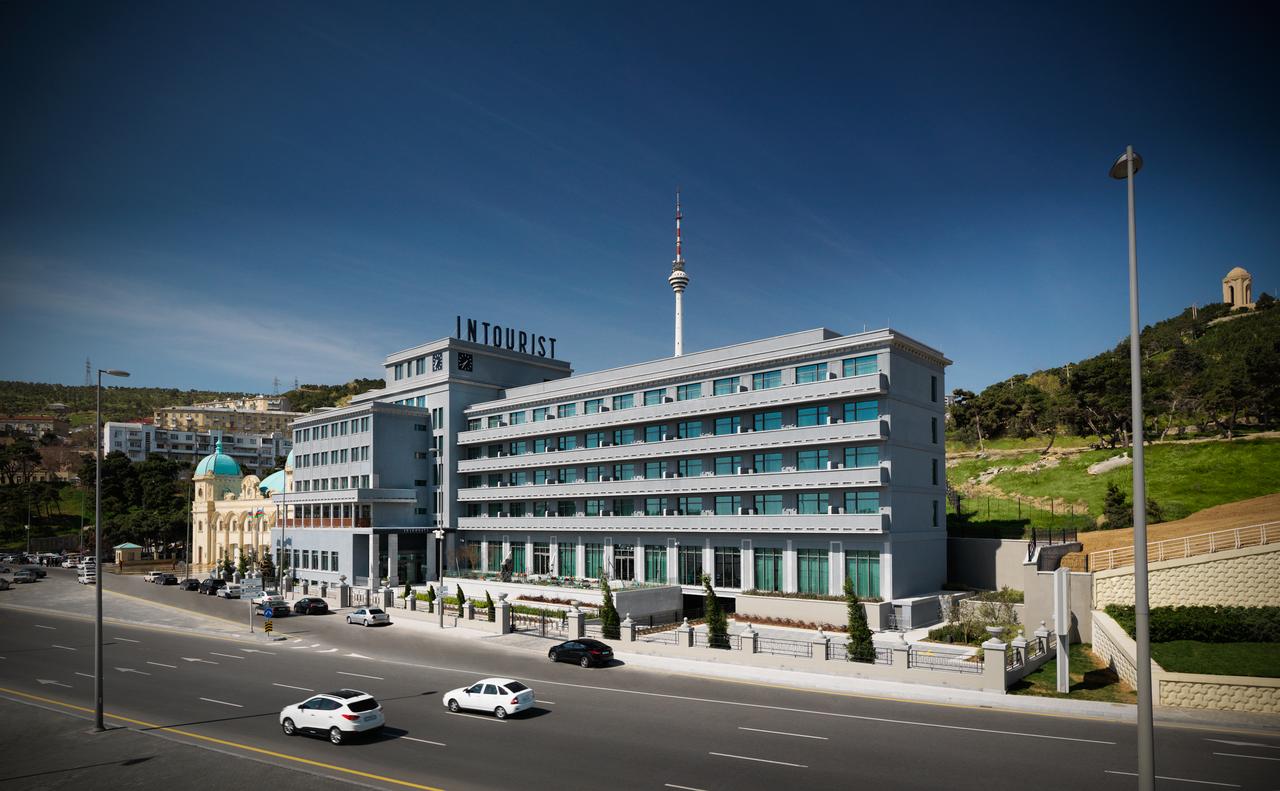
Distance to center — 6.8 km
« Hotel Intourist » is located 0,3 km from the Seacoast, and 20 minutes from the nearest metro station. Wireless W-Fi is available in the area. Each room is equipped with air conditioning, satellite TV, and furniture. Private bathrooms have been provided with hairdryers and saucers for hair drying.
Guests can dine at the restaurant on the hotel’s territory. Dishes of traditional Azerbaijani cuisine and various drinks can be ordered here.
The nearest airport is located 21.7 km from the hotel and the railway station is 3.2 km away. Museums and cultural centers are within walking distance of the hotel.
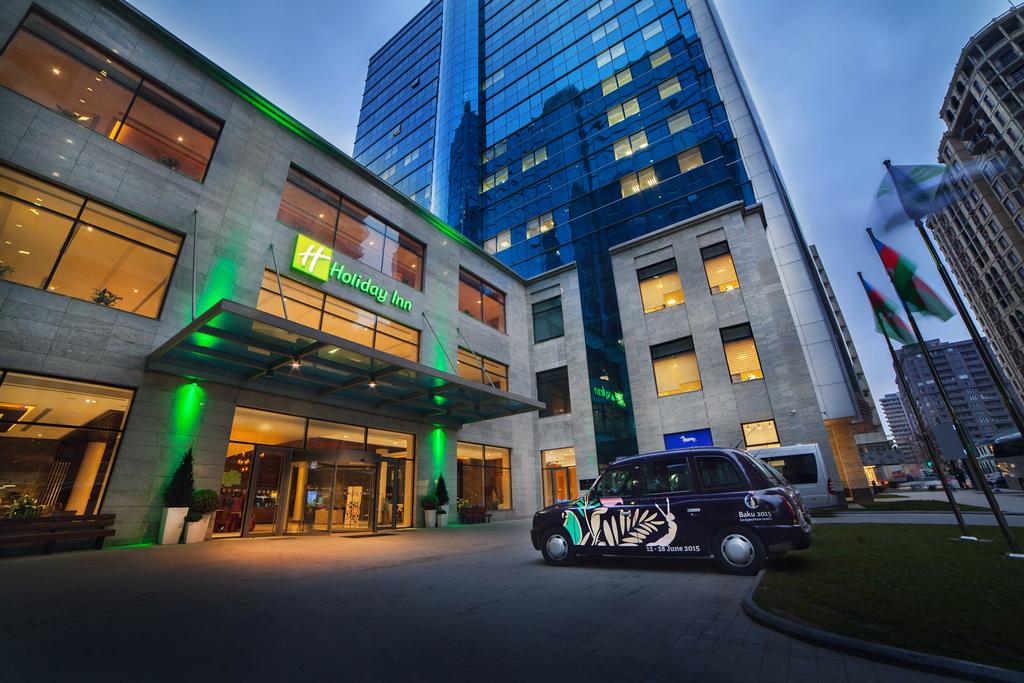
6. Holiday Inn Baku Hotel
Baku, Keykab Khanum, 5
Distance to center — 3.8 km
The hotel is located near the Seacoast, 13 minutes from the metro station. The famous architectural monument “Maiden Tower” is located 1,5 km from the hotel. Wireless W-Fi is available in the area. The hotel consists of comfortable rooms made in a simple classical style. Comfortable beds, orthopedic mattresses, light windows, air conditioning, flat-screen TV, etc. there are.
Guests can use the mini-bar or the hotel’s restaurant. Lunch can also be ordered by number.
In 20 minutes’ walk from the hotel are the main cultural centers, tourist facilities, shopping, and entertainment complexes.
7. Boulevard Baku Autograph Collection Hotel
Baku, Khagani Rustamov Street, 4c
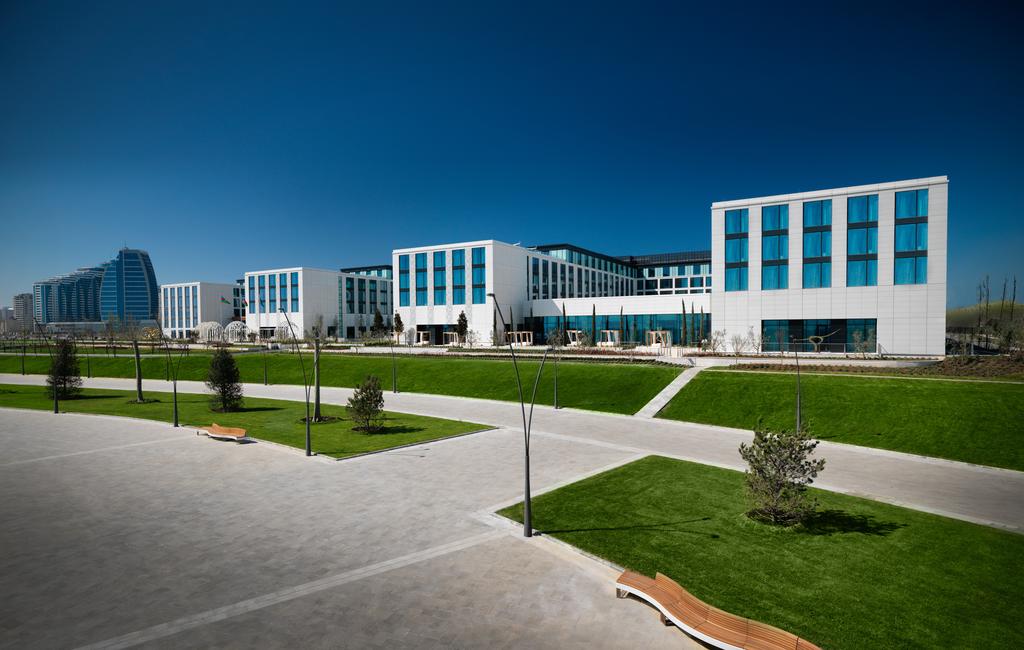
Distance to center — 4 km
The doors of the Hotel » Boulevard Baku Autograph Collection » were opened to all guests of Sunny Baku. W-Fi, parking, transfer, excursions, etc. at your service.
The attractive colors of the rooms create an incredible harmony for relaxation. Here you have everything for your comfortable and comfortable life, to feel good. The restaurant, which operates on the territory of the hotel, can order the most delicious dishes from local, European, and other cuisines. Nearby shops, cafes, sightseeing places of the city, as well as public transport stops that will facilitate the movement around the city are at your service.
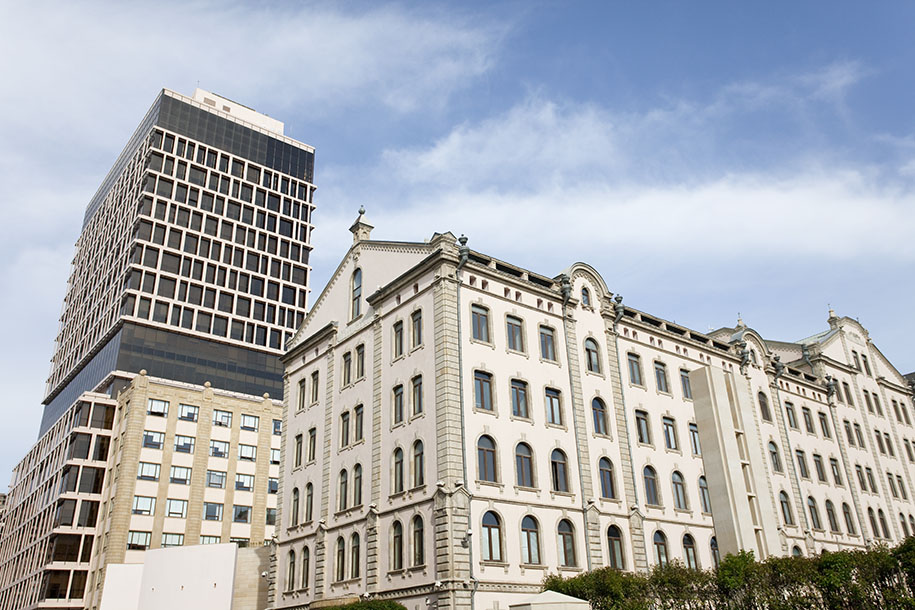
8. Landmark Baku
Address: Baku, Nizami Street, 90a
Distance to center — 3.9 km
« Landmark Baku » is located in a very convenient part of Baku. It takes a few minutes to get to the beach and the main infrastructure facilities the hotel has comfortable rooms of various categories and reasonable prices for its guests. Conditions have been created for the comfort of each guest, the rooms are provided with necessary furniture and modern appliances.
All types of services are provided in the hotel’s restaurant.
The distance to the nearest airport is about 19 km and to the railway station 500 m.
9. Park Inn by Radisson Azerbaijan Hotel
Address: Baku, Azadlig Avenue, 1
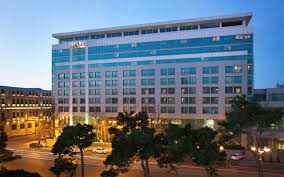
Distance to center — 4.5 km
Park Inn by Radisson Azerbaijan is located very close to the city center and the coast of the Caspian Sea.
Landing service rooms include air conditioning, flat-screen TV, mini bar, various equipment, wireless access to the Wi-Fi network. The private bathroom is equipped with the necessary items for personal hygiene. In the morning there is a delicious and delicious snack. In the evenings, delicious dishes of national cuisine are pleasing to the eye. The bar offers tourists a variety of drinks.
The nearest airport is located at a distance of 19.7 km, the railway station — 0.9 km.
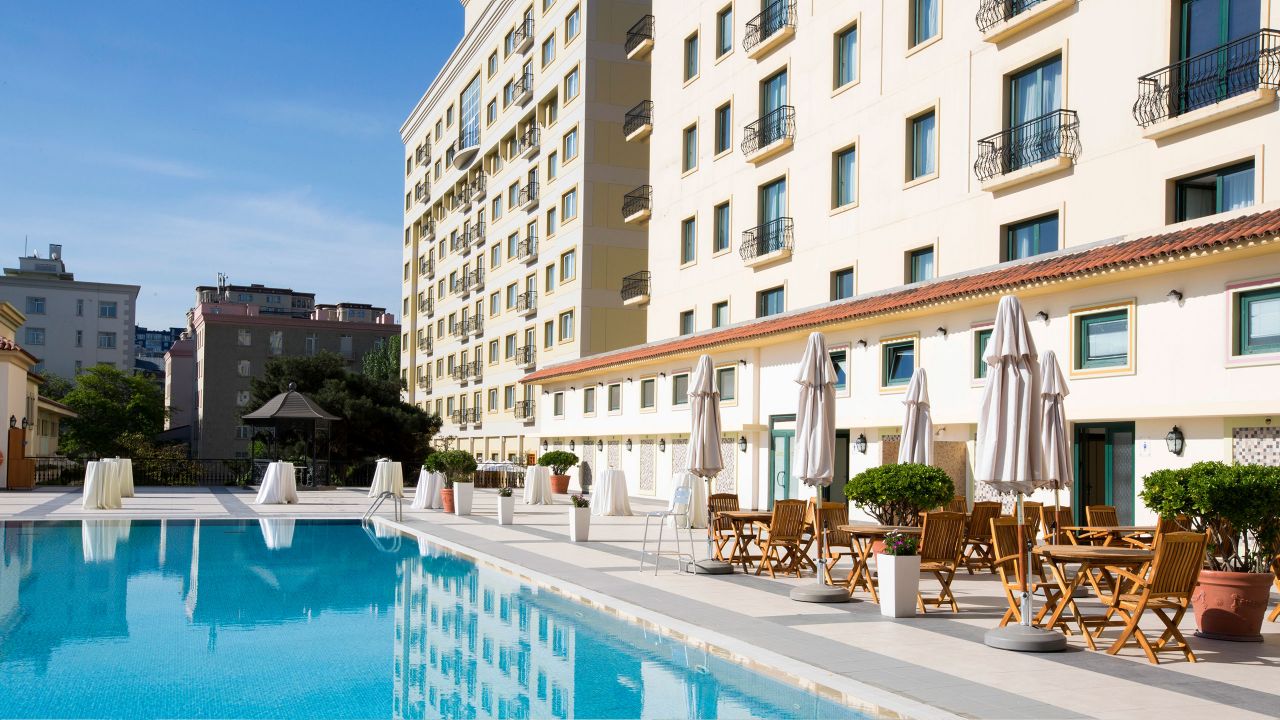
10. Hyatt Regency Hotel
Address: Baku, Izmir Street, 1033
Distance to center — 4.3 km
The comfortable, modern hotel is located in the historically significant area of the city, close to the developed infrastructure.
The hotel offers comfortable and eye-catching rooms, flat-screen TV, air conditioning. The private bathroom is equipped with the necessary items for personal hygiene. The stylish restaurant offers a different menu. Drinks are available to everyone’s taste at the bar.
The nearest airport is 20.8 km, and the railway station is 2.3 km away.
Guests can all attend health and beauty treatments.
11. Diplomat Baku Hotel
Address: Baku, Suleyman Rahimov Street, 185
Distance to center — 4 km
The modern hotel is located in the city center, 0.2 km from the famous Heydar Aliyev Palace. Guests are offered beautiful and pretty rooms in classic style. Everything you need for comfortable living — plasma TV, tea and coffee accessories, as well as wireless access to W-Fi network. The private bathroom is equipped with the necessary items for personal hygiene. The modern-style restaurant offers a variety of dishes, including a menu of European dishes. In the morning snack prepared with pleasure, it is at the disposal of the guests to choose different dishes.
The road to the airport is 19,8 km and to the railway line-0,6 km. An example of popular culture — the Opera and Ballet Theater is located 7 minutes from the residence.
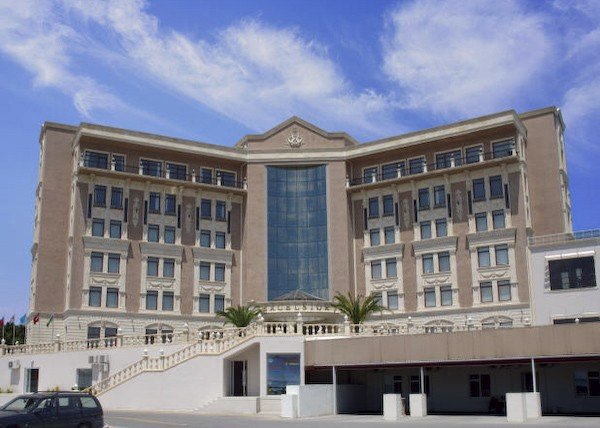
12. Excelsior Hotel & Spa Baku
Address: Baku, Heydar Aliyev Avenue, 2
Distance to center — 2 km
« Excelsior » Spa Hotel is located in Baku. Guest services: parking, W-Fi, newspaper, air conditioning, 24-hour reception, terrace for sunbathing, etc. included. For guests there are rooms with different categories. Each of them is made in an individual style and equipped with the necessary furniture for comfortable rest. A variety of dishes are served in the hotel’s restaurant. There is a wide range of delicious dishes.
Solemn events can be organized in the banquet hall.
The nearest railway station is located at a distance of 2 km, the airport is about 17 km away.
13. Grand Hotel Europe
Address: Baku, Tbilisi Avenue, 1025/3
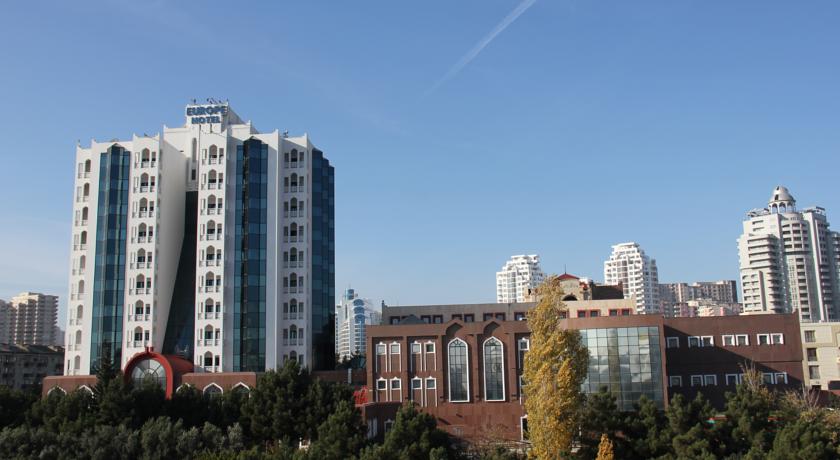
Distance to center — 4 km
« Grand Hotel Europe » is located in Baku. The main infrastructure facilities can be reached in just a few minutes. There are 94 rooms of different categories for guests. Each of them is made in an individual style and equipped with the necessary furniture. It is also equipped with the necessary equipment for comfortable rest. In the morning, guests can have a snack in the hotel restaurant. Delicious drinks are also served here.
The nearest railway station is located at a distance of about 3 km, and the airport-21 km.
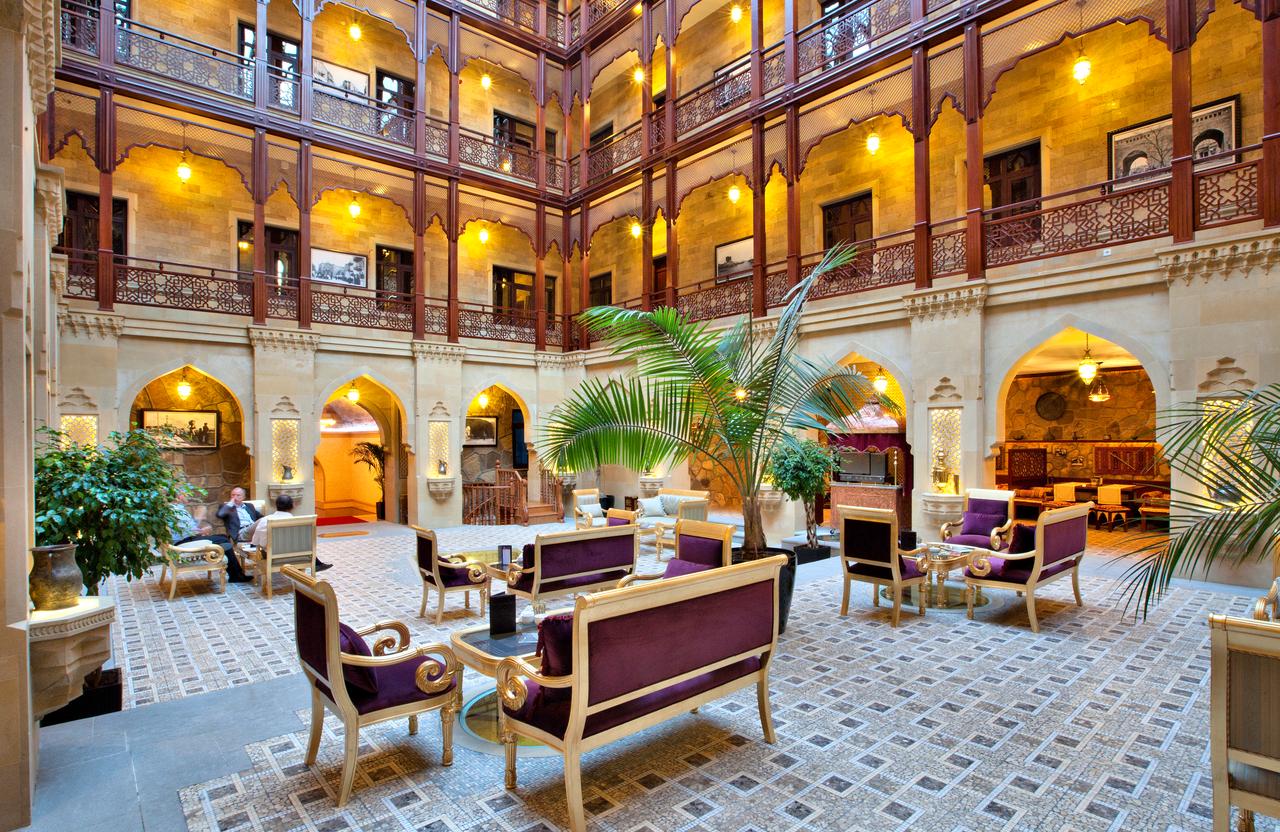
14. Shakh Palace Hotel
Address: Baku, Gosha Gala, 47
Distance to center — 5.3 km
Located a 3-minute walk from the metro station” Shah Palace Hotel ». The rooms are always ready for guests, each of them is designed in strict classical style. Guests are waiting for comfortable rooms, air conditioning, a flat-screen TV, and a bathroom with personal hygiene items. The hotel has a restaurant with traditional Azerbaijani and European cuisine. Delicious snacks are served here in the morning.
The International Airport is located at a distance of 20,8 km, and the railway station at 1,7 km. A few steps from the Hotel, Baku seaside boulevard is located.
15. JW Marriott Absheron Baku Hotel
Address: Baku, Azadlig Avenue 674
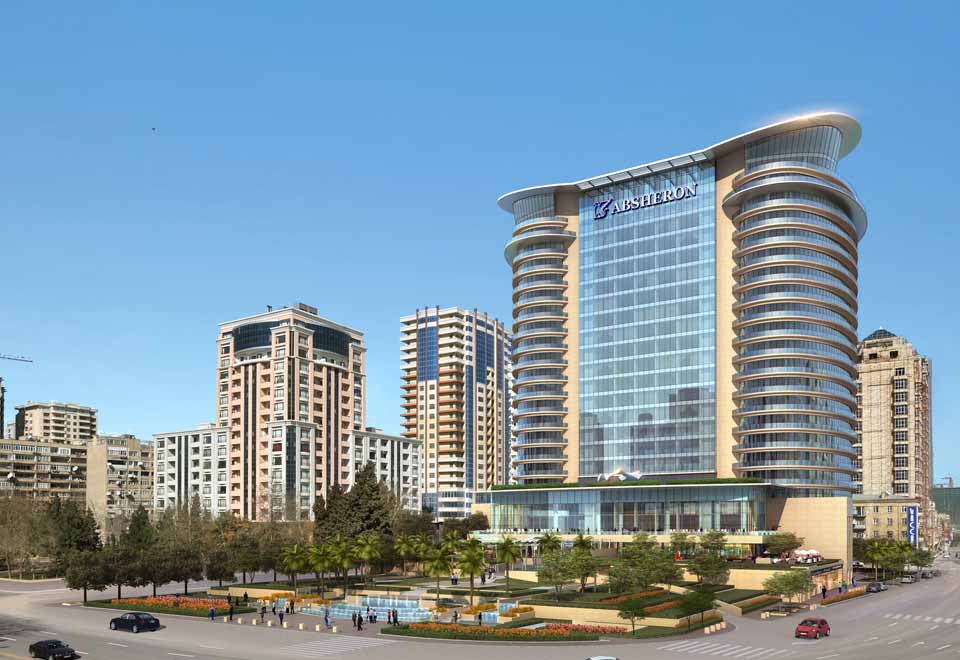
Distance to center — 4 km
« JW Marriott Absheron Baku » is located in the central part of Baku. Near the hotel, there are shopping and entertainment places, as well as business areas. Premium rooms are available for guests with their own equipment: air conditioners working in a cooler mode, new generation TVs, Chargers, safes, etc. There is an additional option for your business or leisure — Wi-Fi. The rooms in each category have baths and showers. To take care of each guest, the hotel provides them with individual hygienic things. In the area, you will find restaurants, bars, and coffee shops.
For sports fans, there is an indoor pool and a gym. The railway station is near the hotel, and the airport can be reached within 20 minutes by car.
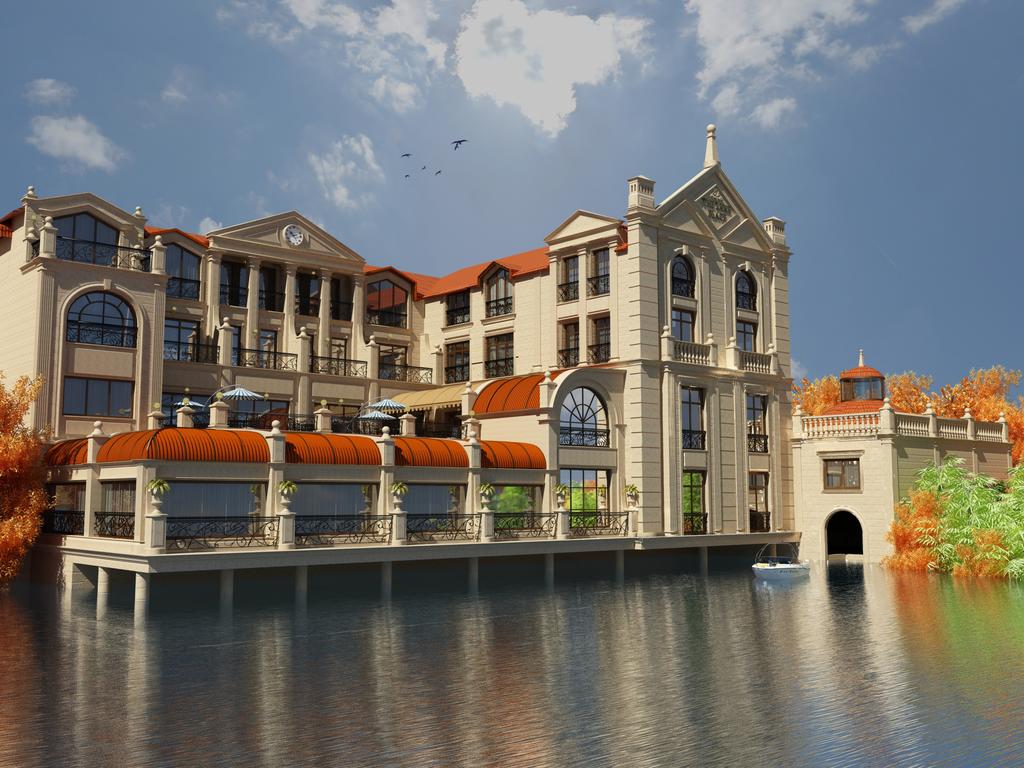
16. Lake Palace Baku Hotel
Address: Baku, Z. Khalilov Street, 63a
Distance to center — 5.5 km
« Lake Palace Baku » hotel is located in Baku. Guests are provided with many services here. You can go in for sports in the gym and then relax in the sauna, you can also swim in the pool or take a massage. For guests, there are comfortable rooms of different categories and reasonable prices. Each room is designed in a classic style. The decor of the rooms includes spacious sleeping areas, designer furniture, and modern appliances. The beautiful view of the city from the balcony fascinates everyone.
Guests can enjoy a delicious snack every morning. The restaurant offers excellent local and European dishes. Snacks and drinks are available at the bar to everyone’s taste.
There is a conference room in the area, which is very convenient to conduct important negotiations and organize interviews, especially for businessmen.
Nearby there are various metro stations where you can move to any place in the city. The park of officers, the Philharmonic garden, and the Mosque of Muhammad is very close to us. The distance to the airport is about 22 kilometers.
17. Badamdar Hotel
Address: Baku, Mikail Mushfig, 1c
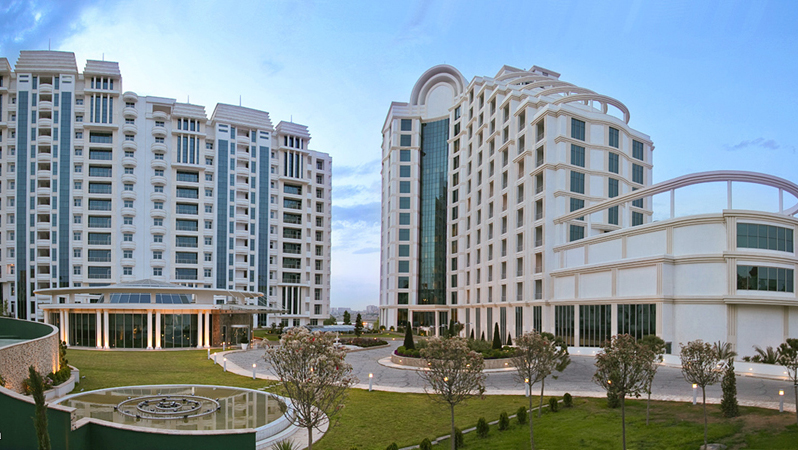
Distance to center — 8.1 km
Hotel « Badamdar » is located in a quiet area of the city. Each room is connected to the W-Fi network, the rooms have a modern flat-screen TV, air conditioning, and a balcony allowing you to enjoy a wonderful view of the city. The rooms of the hotel are painted in calm and eye-catching colors, which makes a pleasant impression on the rest. High-skilled chefs prepare traditional dishes in the aristocratic restaurant. In the morning, a delicious and varied snack is served.
The distance to the airport is 23,8 km, to the railway line — 4,7 km.
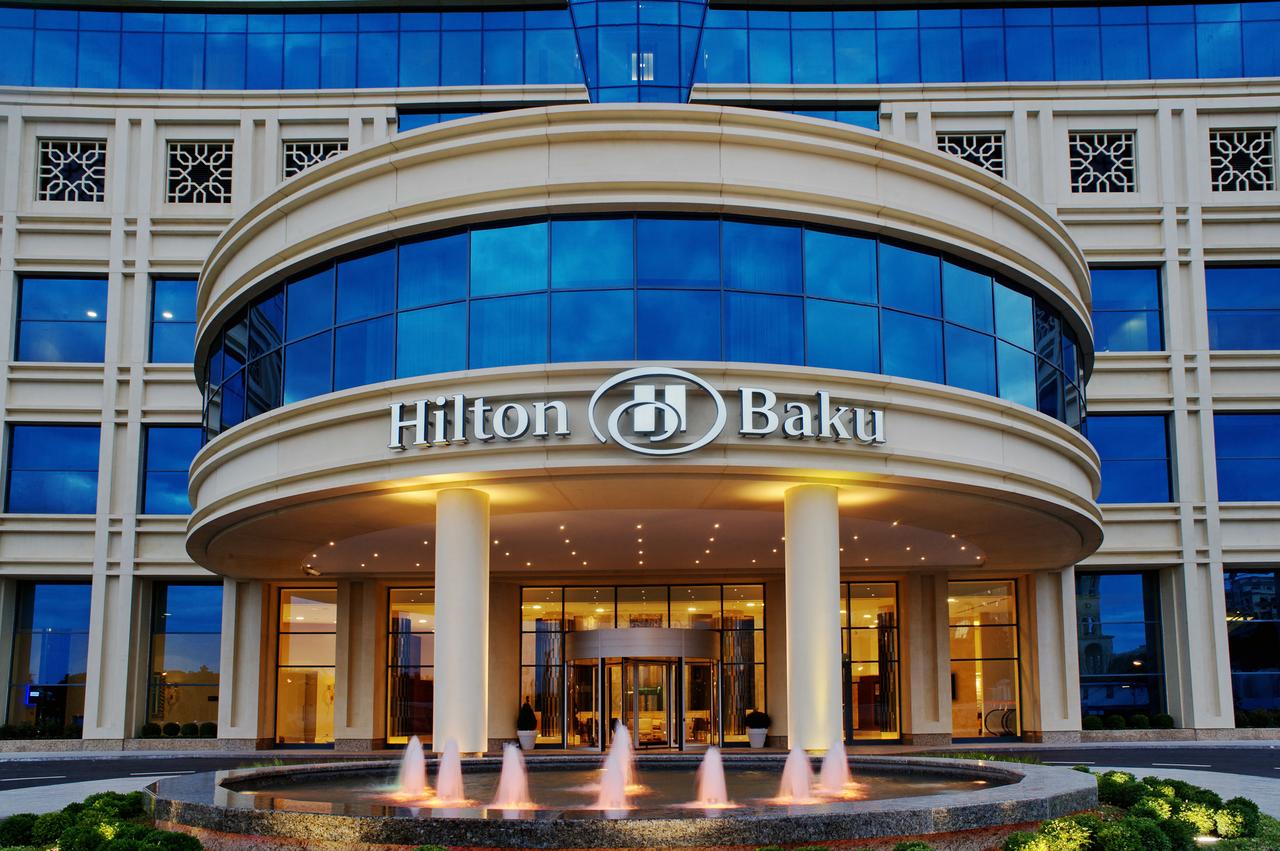
18. Hilton Baku
Address: Baku, Azadlig Avenue, 1B
Distance to center — 4.4 km
« Hilton Baku » hotel is open to all guests of this beautiful city. W-Fi, park, laundry, sauna, transfer, and other services available for guests. Each of the rooms will please you with its comfort, pleasant atmosphere, interior, and amenities.
In the restaurant, you will enjoy the delicious dishes of the cooks. The hotel has a conference hall with all the necessary facilities for various events.
There are many shops and cafes around the hotel. Also, the proximity of public transport vehicles facilitates movement.
19. Premier Expo Hotel
Address: Baku, Aga Neymatulla Street, 48
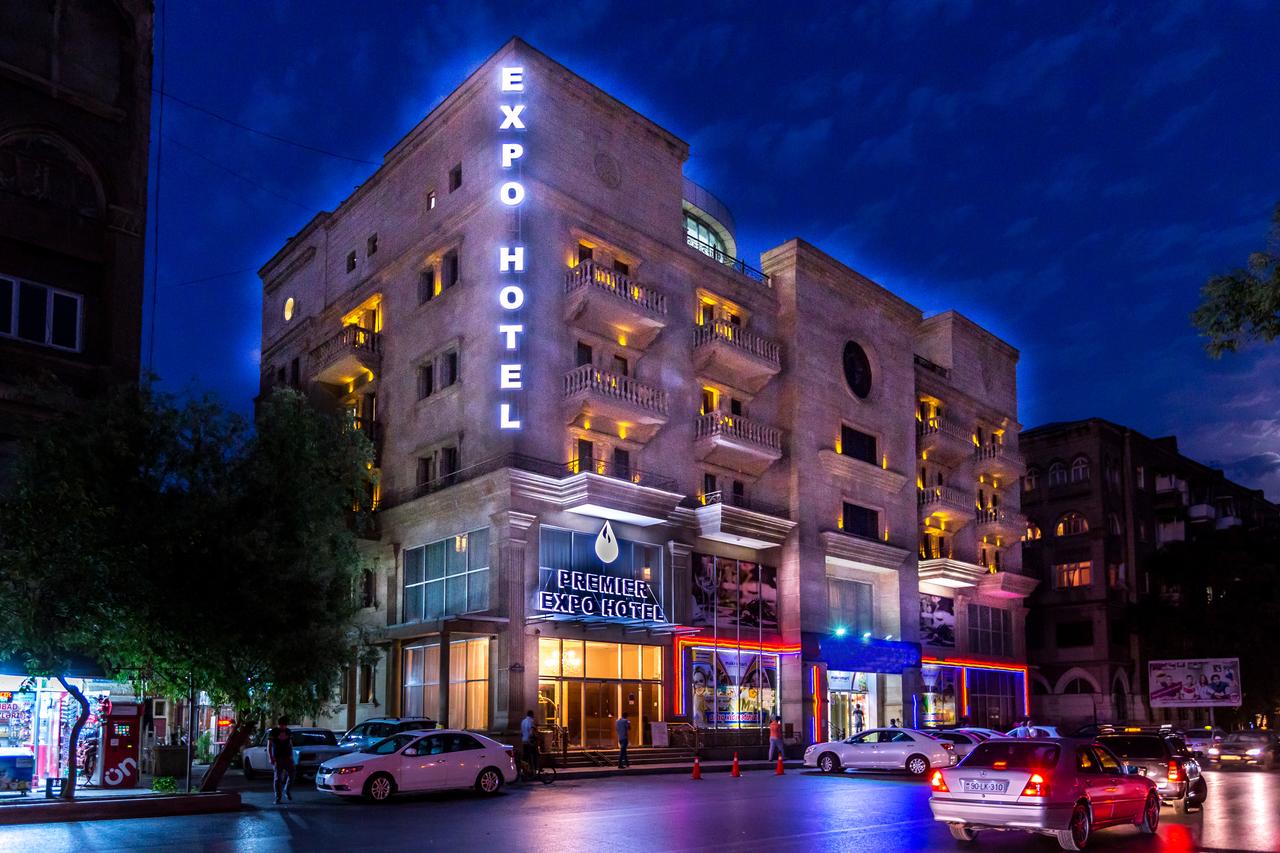
Distance to center — 1.7 km
« Premier Expo Hotel » is located in Baku. Guests are provided with many services here. You can use the shuttle while you are staying at the hotel. The hotel has a fitness center, spa and free W Car owners are provided with special parking. For guests, there are rooms of different categories. Each of them has comfortable beds, high-quality furniture, and modern appliances. The private bathroom provides guests with personal hygienic items.
Guests are offered delicious and varied breakfasts. Food and drinks can be ordered in the room. The hotel’s restaurant offers excellent dishes from the menu. On the territory of the hotel, there is a conference hall, which is especially convenient for businessmen to conduct negotiations, conduct interviews or hold a solemn ceremony.
Nearby is the Heydar Aliyev Center. It has a distance of about 16.5 km to the airport and 3.1 km to the railway station.
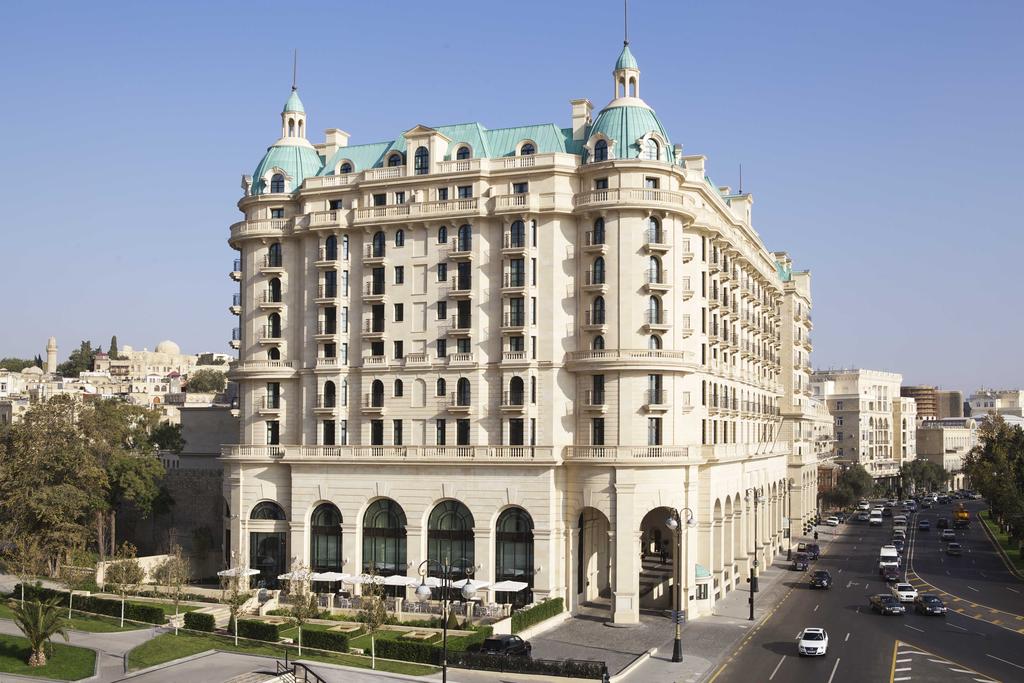
20. Four Seasons Hotel
Address: Baku, Neftchilar Avenue, 1
Distance to center — 5.8 km
The hotel is located near the picturesque seacoast and the sights of the city. Guests are offered comfortable rooms designed in a unique style. From the windows of the rooms, there is a panoramic view of incredible beauty. Here you will find comfortable beds, a flat-screen TV, wireless access to the W-Fi network. The private bathroom provides you with everything you need.
Dishes of Italian cuisine are served in the restaurant. The Bar can delight guests with a wide range of drinks.
The nearest airport is 21 km, and the railway station is 2,3 km away. A large-scale shopping center is located near the hotel.
21. Fairmont Baku Hotel
Address: Baku, Mehdi Huseyn, 1а
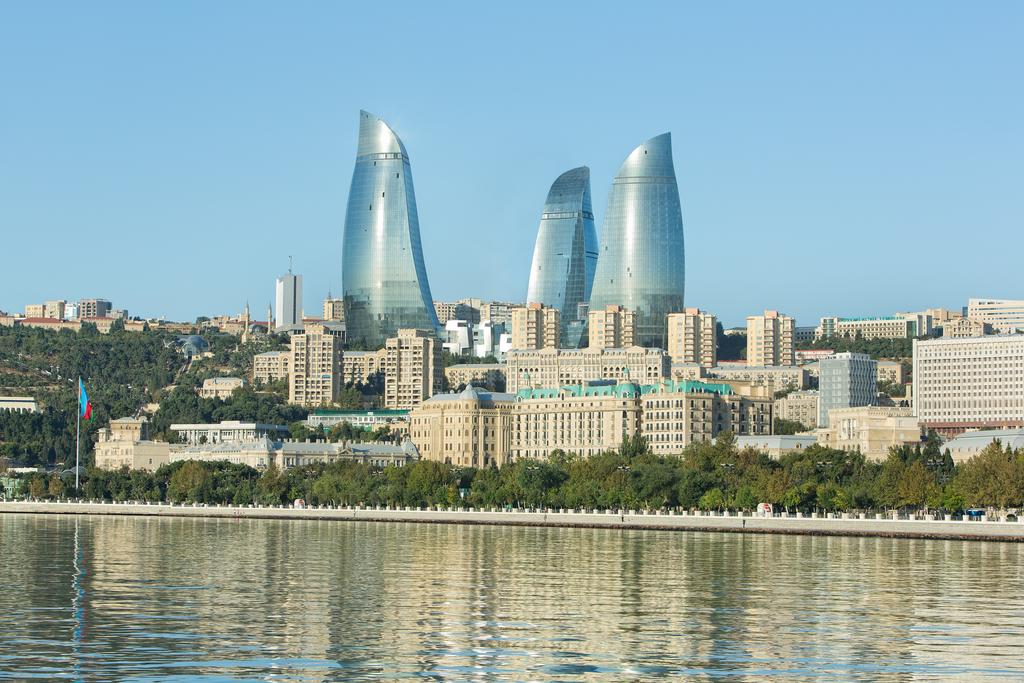
Distance to center — 6.5 km
Hotel « Fairmont Baku » is waiting for its guests in Baku. At your service W-Fi, parking, bath, massage, transfer, etc. there are services.
Each room has everything necessary to make your rest comfortable and pleasant impression of your stay.
In the restaurant, which operates on the territory, you can taste delicious dishes of world cuisine and have a great time.
There is a conference hall equipped with all the necessary equipment for holding events here.
Sightseeing places in the city, cafes, and shops are near the hotel. It is also near public transport stops, which makes it easier for everyone in the city.
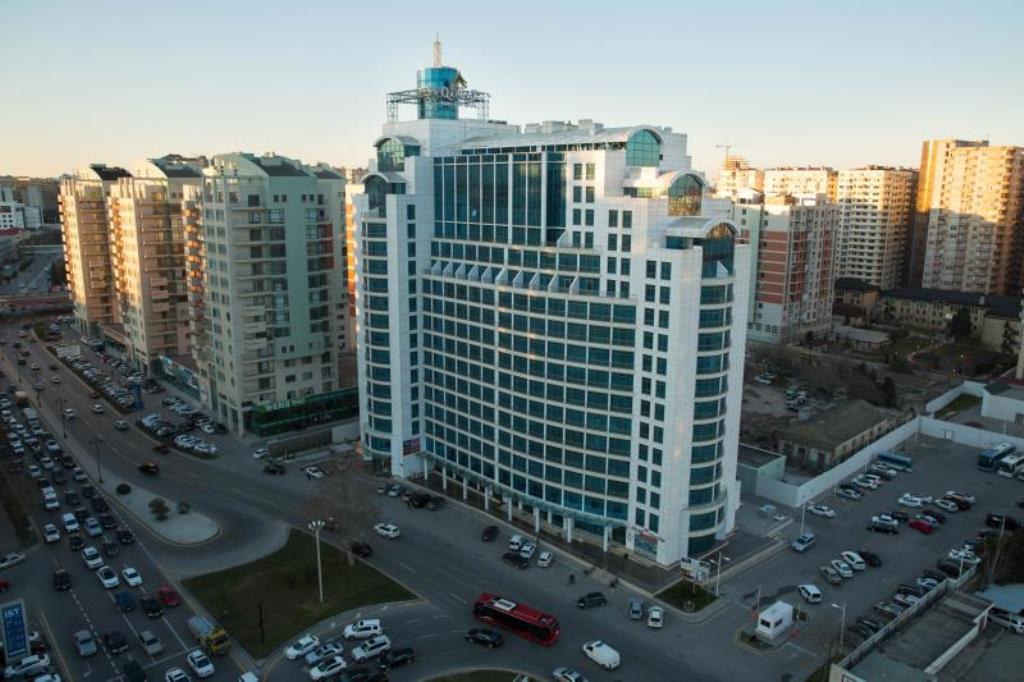
22. Hotel Caucasus Baku City and Residences
Address: Baku, Tbilisi Avenue, 34
Distance to center — 4.5 km
Hotel « Qafqaz Baku City and Residences » is waiting for its guests in Baku. At your service W-Fi, parking, bath, massage, transfer, etc. there are services.
Conditions have been created for the comfort of each guest, the rooms are provided with necessary furniture and modern appliances. Each of the rooms will please you with its comfort, pleasant atmosphere, interior, and amenities. In the hotel restaurant, you can order delicious food and have a nice time.
There is a conference hall equipped with all the necessary equipment for holding events here.
Sightseeing places in the city, cafes, and shops are near the hotel. Public transport stops are also nearby, which makes it easier to move in the city.
23. Sapphire Inn Hotel
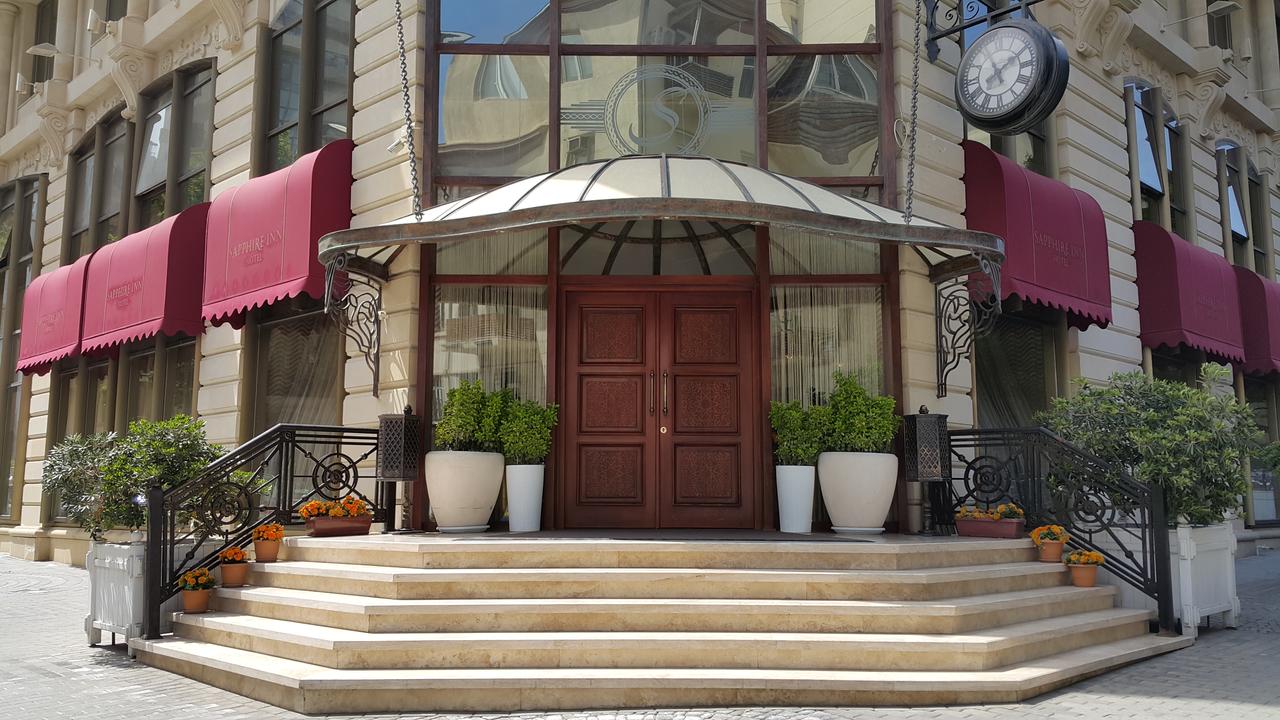
Address: Baku, Hasan Abdullayev Street, 5
Distance to center — 5.6 км
Hotel « Sapphire Inn » is located in the city center. At the service of guests, there is a car parking, washing machine, internet, etc. there are.
There are 56 rooms of different categories and prices for the accommodation of guests. Each room is equipped with the necessary furniture and modern appliances.
Lunch and dinner can be served at nearby restaurants and cafes. There is also a grocery store right near the hotel.
The distance to the nearest railway station is 2 km, and to the airport — 21 km.
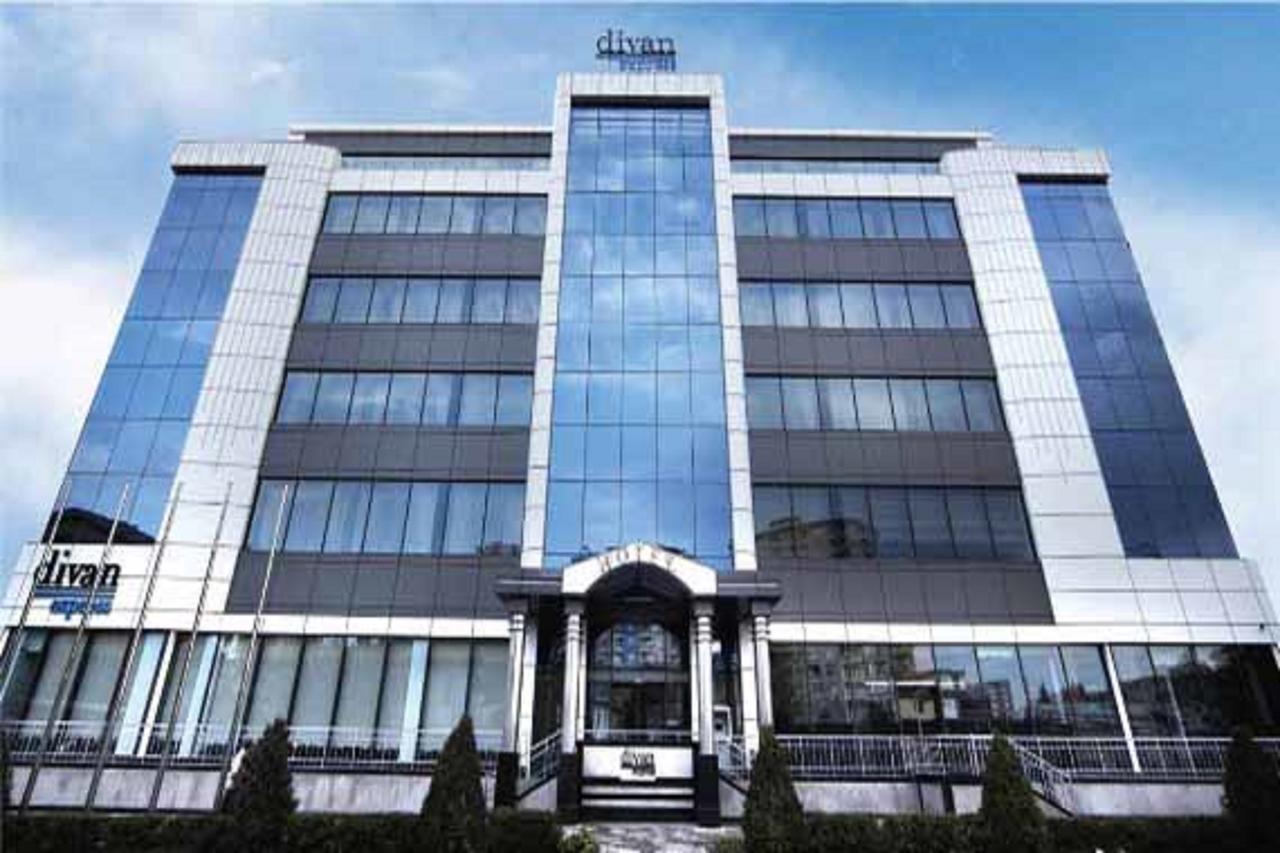
24. Divan Express Baku Hotel
Address: Baku, Hasanoglu Street, 15
Distance to center — 0.9 km
Hotel » Divan Express Baku » is located in Baku. At the service of the guests, there is a car park, internet, press, and food delivery.
For accommodation of guests comfortable rooms of different categories are offered. Each of them is designed in different styles and provided with all the necessary furniture and equipment for your rest.
Meals are organized in the hotel’s restaurant. Here, guests are offered a variety of dishes and drinks at an affordable price.
The Banquet Hall of this place is rented for holding solemn events.
The distance to the airport is 17 km, to the railway station — 2.6 km.
RECREATION AREAS IN THE REGIONS
I. North direction.
Guba (168 km from Baku). It is a picturesque land with rich vegetation and lots of apple orchards. Among the places where tourists visit with great interest are the waterfalls of Afurja, Kunkhart, and Pirbanovsha, Gachresh, Nugadi, Tanga six resorts, ancient stone pools filled with hot hydrogen sulfide spring waters. In Khinalig, a high mountain village, whose inhabitants speak a language no one knows anywhere in the world, there remains a unique temple of fire-worshippers of IX century. Other architectural monuments include mausoleum in Agbil village, Juma Mosque, and Sakina-khanim mosque, ancient towers.
Khachmaz (157 km from Baku). The mild climate creates ideal conditions for dense forests to the flat shore of the Caspian Sea and attracts many tourists eager to relax from the smoke and noise of the city. There are many mineral springs, the most famous of which is the fountain “Istisu”. The Khachmaz region is also rich in historical, cultural, and architectural monuments. The ancient fortress city of Khudat, the mosque-Madrasa of Shah Abbas, the mosque of Sheikh Yusif (XV century), the ancient settlements and burial mounds of the Bronze Age, The “Iron Gates” of the Derbent fortress. The largest tourist zone of this region is Nabran, which has numerous beaches, picturesque coasts, developed tourist infrastructure. Many recreation areas of different levels, cafes, restaurants, night discos make your stay in Nabran interesting and memorable.
In Nabran “Palermo”, “Green Villa”, “Atlant”, “Lotos”, “Aqua park”, “Dalga”, “Ober Lux”, “Orman”, “Palermo”, “Mayak”, “Forester House”, “Mirvari”, “Elvin”, “Malibu” recreation areas are offered in Seyidli settlement.
Shabran (122 km from Baku). The region is famous for its medicinal mineral spring “Galaalti”, hunting and fishing farms, historical monuments (ruins of ancient Chirag Gala Castle, Shabran ancient settlement, ancient architectural monuments) located in foothills zone of Greater Caucasus, mysterious views of mountains, valleys, and forests.
Gusar (180 km from Baku). It borders with Dagestan. This mountainous area, covered with broad-leaved forests, with numerous springs, waterfalls, small lakes, is attractive for recreation. The highest point of Azerbaijan — Bazarduzu mountain (4466 m) is located here. A state Reserve has been created on a large territory. While summer is distinguished by coolness, winter attracts lovers of frosty weather and continuous snow cover. You can take a walk in the « Alistan baba » beech forest and on the route of familiarization with folk applied arts such as carpet weaving, wood carving, embroidery.
One of the historical monuments of the region is the mausoleum of Sheikh Juney of XV century, the Museum of Russian poet Lermontov, who visited here 170 years ago. Lovers of exotic cuisine can taste fine meat dishes in small local restaurants with an unusual taste, with the addition of fragrant greens and spicy spices.
Khizi (located 104 km from Baku). It is a mountain district located near Baku. It has a temperate arid climate. From the East, surrounded by the Caspian Sea, most of the region is covered with forests. One of the remarkable places of the district is Mount Beshbarmag, which is called Beshbarmag for its miraculous form and has many legends connected with it.
The district also houses one of Azerbaijan’s natural beauty — Altiaghaj. Altiaghaj National Park with rich flora and fauna has been created here. There are many historical monuments in the region: walls of Bashbarmag Castle (VIII century), ruins of the ancient city and Khizi Castle (V century), etc.
II. North-west direction.
Shamakhi (135 km from Baku). Around Shamakhi are amazing Meadows and forests, snow-capped mountains suitable for skiing and mountaineering. In the mountains, there is also Pirgulu Reserve, an astrophysical observatory named after Nasreddin Tusi operates.
Shamakhi is an ancient city with a history of not less than 3000 years. During our period, tourists can visit remains of Gulustan and Gala-Bugurt fortresses, the vault of Shirvan Khans, medieval tombs, Juma Mosque with two minarets (743 years), caravanserai complex with ancient underground baths (XIV century), and other buildings and architectural monuments of the past.
Shamakhi region is famous for dessert wines that can be tasted in any village. It attracts attention with an abundance of forest fruits and medicinal herbs.
Ismayilli (185 km from Baku). The climate here is mild hot in the Lowland and Foothill zone and cold in the high mountains. “Ismayilli” Reserve, which protects various plant and animal species, has been created in the region. Remains of Gasimkhan, Javanshir, Girkoshag castles, legendary Fitdag Castle, Khan Castle, and “Maiden Tower” in Khanarli village (11-12 centuries) attract many tourists who are lovers of history and past.
Gabala (225 km from Baku). Forested mountains, crystal water sources, mysterious subalpine and alpine meadows, a small chestnut forest, whose age exceeds 500 years, attract numerous vacationers of different ages here.
There are the ruins of the ancient city, tombs, holy shrines, mosques and fortresses, temples, ancient defense buildings of the IX century, and many other monuments of the past.
Gabala has long been specialized in providing services to visitors, offering both short-term and long-term rest and excursions to the ancient region.
Sheki-Gakh-Zagatala region (300-370 km from Baku). The territory of this region is located on the southern slope of the Greater Caucasus and is covered with forests consisting of fisticuffs, hornbeam, chestnuts, walnuts, oak, and other trees. Many rare animals live here in Zagatala, Ilisu, and Turyanchay reserves and rare Eldar pine grows in natural conditions.
The age of some plane trees here is more than 500 years. And in the park “Dede Gorgud” in Zagatala city the age of one of the 8 plane trees reaches 700 years. In the north of Sheki, untouched forests stretch on the territory of « Gelersen-Gorersen », where they come to breathe fresh air. The city of Sheki, founded 2600 years ago, attracts tourists with its numerous historical monuments. Ancient settlements were built by great architects, castles, towers, mosques, the Palace of Sheki Khans, caravanserais of XVIII century, as well as the grave of Hadji Murad. The Church of St. Elysee-the oldest Albanian temple founded in the II century remained in the village of Kish of Sheki region.
Shaki craftsmen are famous for their work, pottery, metal and wood souvenirs, silk fabrics, and carpets. The rich Sheki cuisine, especially its sweets, is famous far from Azerbaijan.
III. South direction.
Masalli (232 km from Baku). The region is surrounded by the Caspian Sea on the one hand and Talysh mountains on the other. There are small lakes and waterfalls in the forests of a wonderful climate here, and many Sulfur Springs with the most famous Istisu spring.
Historical monuments are represented by mosques of XVI-XIX centuries, the mausoleum of Seyid Sadig, Arkivan fortress. Secrets of traditional crafts are transmitted from generation to generation.
In the villages of the district, you can find colorful, small products made of wood, carpets, original woven mats.
Lankaran-Astara (268-313 km from Baku). The subtropical climate, rivers, and Hot Springs create favorable conditions for growing vegetables all year round, as well as setting up many orchards and tea plantations here.
The non-tall Talysh mountains are covered with forests, in which relict trees predominate. Hirkan National Park and Gizilagach Reserve are located in the territory of the region and many rare animals — deer, roe deer, lynx, wolf, and even rare tiger are found.
Especially in Astara, there are good beaches (Sandy, Pebble), the water here is very transparent and clean. Ballabur Tower, Khan’s palace, mosque and minaret of XIX century, ruins of an ancient castle in Astara, caravanserai of XVII century, the mausoleum of XII century remained among architectural monuments. The local cuisine is especially famous for its dishes, which include fish, poultry meat, and the use of unusual spices.
IV. West direction.
Ganjabasar (300 km from Baku). The famous zone under this name includes 10 regions located in the west of Azerbaijan in the surrounding areas of ganja, Mingachevir, Gazakh, Aghstafa, and other cities.
This region, one of the ancient centers of the East, is rich in historical, architectural, and religious monuments. Among them is Juma Mosque of XIX century, mausoleums of Sheikh Ibrahim and Nizami, Imamzada complex of XVI century, city baths, a medieval fortress, rare “Sinig korpu” of XII century in Gazakh, mounds of Bronze Age in Khans, ancient castles, and towers, and beautiful feudal Castle in Shamkir. There are roe deer, mountain goats, wild boars, and many other species of animals in the mountain forests and meadows. At a distance of 25 km from the city of ganja, Goygol is located, the Pearl of the Azerbaijani nature, around which the Goygol Reserve was established.
Other well-groomed places in the nature of this region — “Gizil Gala”, caves of Aveydagh mountain, and rich Tugay forests can be noted. Carpet weaving, weaving and embroidery, silk, and porcelain production have been developed in the region since ancient times. And, of course, gourmets can taste the unique exquisite dishes of local cuisine in numerous small restaurants, tourist bases, and recreation areas.
V. The Nakhchivan Autonomous Republic.
The majority of the territory of Nakhchivan Autonomous Republic, being a mountainous region located at 1000 meters above sea level, has a rich natural and rare cultural heritage. There are many museums, hotels, restaurants, and a modern Olympic Complex in Nakhchivan, the capital of which is one of the ancient cultural centers of the East.
The cities of this region are distinguished by their historical monuments, cozy streets and squares, and unique hospitality. The plant world of the Republic is rich with broad-leaved forests. Many rare species of animals live here.
Among them are the tombs of Yusif Kuseyr and Momina Khatun, the mausoleum of Naimi, Alinja castle, ruins of Gilan city, ancient bridges, etc. many historical and architectural monuments remain. Since ancient times, local craftsmen have improved carpet weaving, embroidery, wood carving, and silk fabric.
BAKU TOURISM ZONE
If the image of Azerbaijan on the map looks like a bird flying towards the sea, its « beak » is the Absheron Peninsula. Baku, the capital of Azerbaijan, an ancient and always young city, is located on the southwest coast of this peninsula.
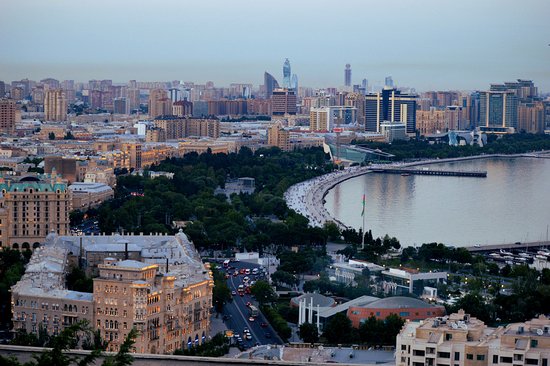
The population of the city is about 2 million people. Although Baku is separated from Absheron settlements from an administrative point of view (their number is 32), historically these settlements are connected with the capital both from a cultural, economic and spatial point of view. Therefore, the whole Absheron Peninsula together with the capital is called « Great Baku ».
In Absheron and Baku, there are the main transport highways of the republic — the Heydar Aliyev International Airport, the big seaport in Baku bay (by the way, it is the largest port in the whole Caspian Sea), the railway station in Baku, and the highways connecting the capital of the republic with the regions.
The main pipelines for the transportation of oil and gas start here, from Absheron. Baku is the main point of the TRASECA (Europe-Caucasus-Asia) International Transport Corridor. As part of this project, Azerbaijan participates in the restoration of the historic Great Silk Road Route.
CLIMATE. The Absheron Peninsula is located 28 meters below the world ocean level. The climate of Baku and Absheron is mild-hot, semi-desert and steppe, characterized only by the winds characteristic of Absheron. The so-called « Khazri » north wind cools the air in summer, and in winter it cools excessively. The so-called » GILAVAR » south wind brings the heat in summer and modifies the cold in winter. In general, the climate of modern Baku has become quite mild due to the gardens and parks where Baku people grow with pleasure. At the beginning of the XX century, it was impossible to get to the streets of Baku by a strong wind and dust, and today Baku has turned into a city with a warm and comfortable lifestyle.
MINERALS. There are oil, gas, construction Stone (called « badamdash » limestone), salt, sand, and lime deposits in Absheron Peninsula. Masazir, Gala, Boyuk Shor, Khoja Hasan salt lakes in Absheron are very popular. Some of the oldest oil wells in the world are located in Absheron. People used to extract oil from these wells with verdures. Here are a few of the first wells produced by industrial oil.
Azerbaijan ranks first in the world for the number and diversity of mud volcanoes, which are considered a wonderful mystery of nature. Of the 800 known mud volcanoes existing in different countries of the world, 400 are located within the South Caspian oil and gas basin, including more than 300 onshore territories of Azerbaijan, in the Caspian Sea, and on numerous islands.
All different types of mud volcanoes existing in the world are represented in Azerbaijan. It is no exaggeration to call this land a natural reservoir and laboratory of mud volcanism. Therefore, in recent years, international scientific forms on the issues of volcanism, geodynamics, and seismicity are being held in Baku.
Mud volcanoes attract more and more attention from tourists coming to our country. The desert and rocky landscape of Absheron, its volcanoes remind us of the youth period of our planet. There were no people on earth at that time, nor the moon landscapes. But Azerbaijani volcanoes are alive, they breathe…
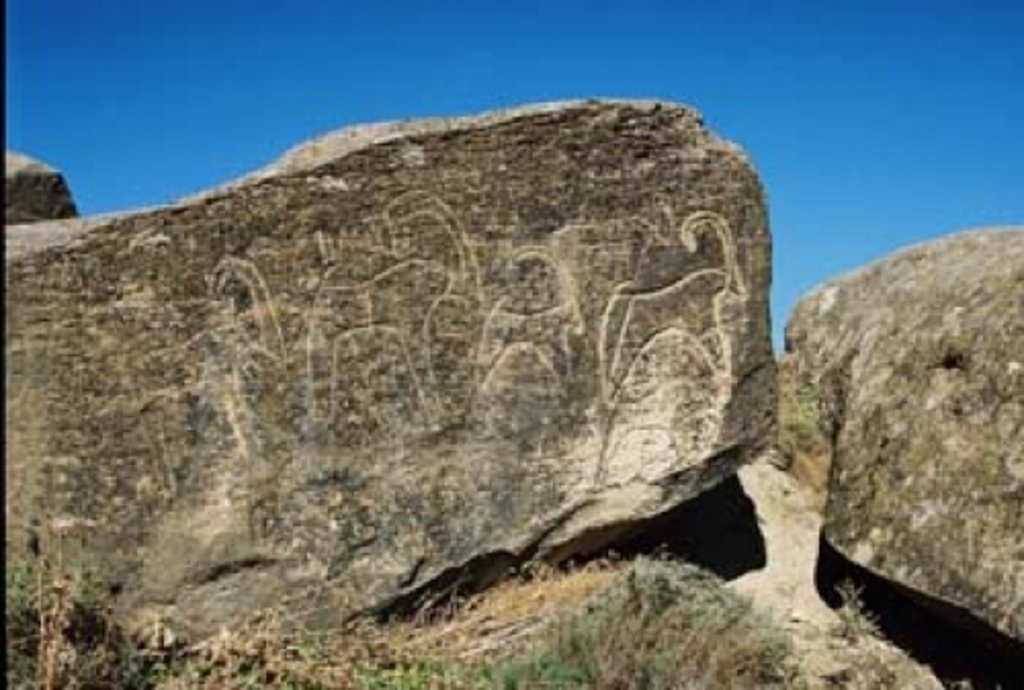
GOBUSTAN PETROGLYPHS IS AN OPEN-AIR MUSEUM. Petroglyphs, that is, rock paintings, are artistic « archives » of human evolution on Earth. The « documents » of such archives are similar to the first time a person broadcasts his own self to the surrounding world. There are several such « archives » in the open air in Azerbaijan. One of them, probably the largest, is located in Gobustan — the Baku State Historical-ethnographic and artistic Reserve near Baku. Located in the south-eastern foothills of the Greater Caucasus Mountains, this rocky Massif is located near the Caspian Sea on the modern highway, built along the ancient Shirvan road. Numerous rock drawings, ancient human settlements under the rocks, and burial mounds were discovered here. Two archaeologists, who devoted 35 years of his life to the study of Gobustan — D.Rustamov and his wife F.Muradova believes that the most ancient part of Gobustan petroglyphs is a very informative picture of life, despite the simplicity of the most optimistic and self-expression of man in the early period of human development. They studied about 20 rocks in six settlements, excavated about 40 mounds, discovered 300 new rocks and stones with drawings on them. However, the rocks of Gobustan are not only witnesses of the most ancient period of human life. These rocks reflect 15 thousand years of the life of the region — a great time period from the Upper Paleolithic to the Middle Ages.
In 1939, archaeologist Isaac Jafarzadeh, the first researcher of Gobustan, informed world science about these unique places.
Today, more than 4000 petroglyphs (rock drawings made on the basis of stone carving technique) have been found in Gobustan. These paintings include animal and fishing, domestic scenes, collective dances, various, including sun symbol (swastika, spirals, cross), constellations, men and women (interestingly, women went hunting with men at that time), images of animals such as gazelle, mountain goat, lion, goat, the boat made of cane, two-wheeled cart, and Human Traces. Unusual « dishes »-hollows printed on stone and even decorated with patterns remained intact in Gobustan. There are also unusual « musical instruments » — stones that give powerful sounds. Because each stone has its own timbre, they are called « tambourine stones ».
There are signs confirming the presence of Roman legionnaires in the I century of our era in Gobustan rocks. This region, which is attractive to be occupied, has not spread from the attention of the Romans. A Latin text was written by the Roman centurions of the 11th lightning Legion on one of the rocks here. This article indicates that at that time Emperor Domitsian Caesar Augustus was in Germanic power in Rome. In 2007, Gobustan was included in the UNESCO « World Heritage » List.
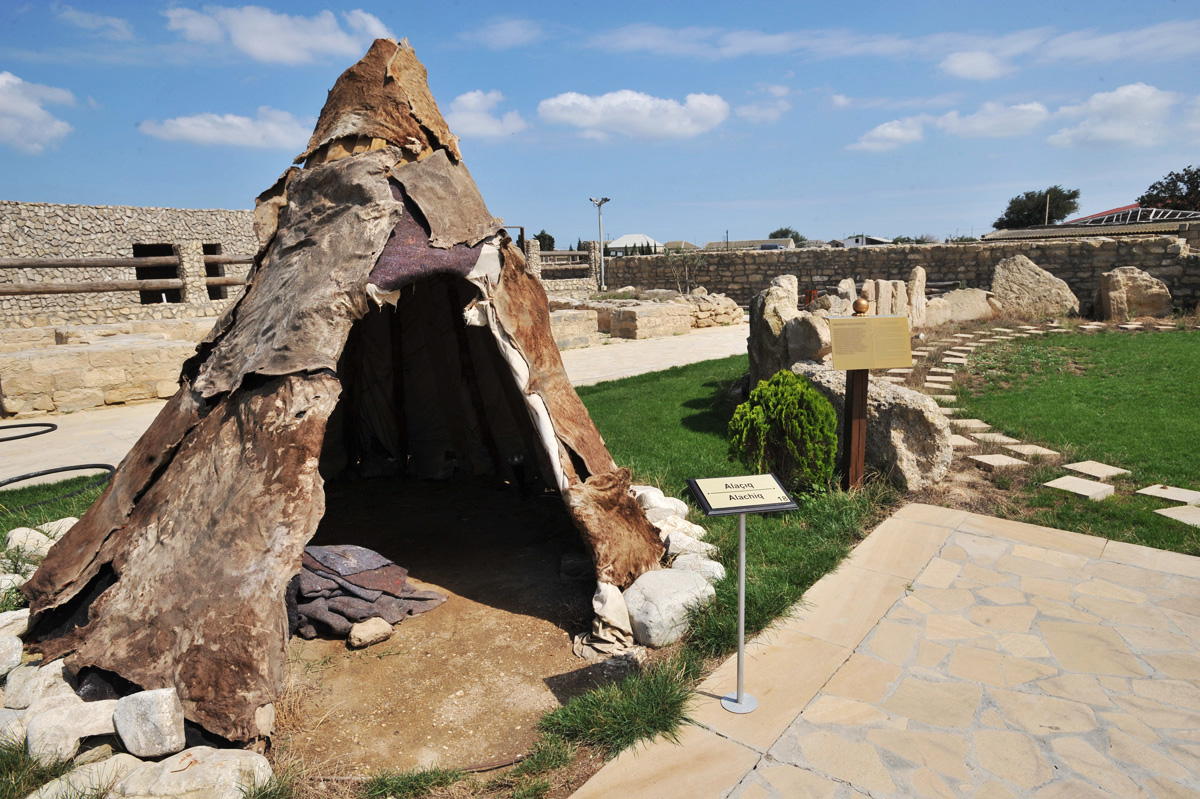
HISTORY OF ABSHERON. Due to the geographical climate and geological factors of Absheron, the entire Absheron Peninsula and the territory of Baku were inhabited 20,000 years ago. (Ancient human settlements were discovered near Yeni Surakhani settlement.). In general, the ancient human settlements on the entire peninsula do not account for the burial mounds of the Bronze Age and the early Iron Age. There are also ancient burial complexes with anthropomorphic figures shaved from stone, on which plot drawings are applied (the villages of Dubendi, Turkan, Hashahuna, Mardakan, Shuvelan). You will not find such complexes in any other region of Azerbaijan and the Caucasus. Ancient human settlements have been discovered on Pirallahi Island, on Lake Zyg, in Binagadi and Amirjan(before the III-I millennium BC). All this shows that the Absheron Peninsula as a whole has attracted people for their peaceful life since ancient times. However, the geostrategic position of this peninsula attracted various invaders.
The largest settlement in Absheron is MASHTAGHA village. In addition to the remains of human settlements belonging to the Bronze Age and Iron Age, there are also monuments related to the later period: flea ARBUTAY mosque (1414), Khoja Aydemir mosque, GAZIKHANA, Khoja Karbalai Huseyn mosque (XVIII century), a mosque built in XIII-XIV centuries and later added 40 m high minaret, bathhouse belonging to XVII century, OVDAN (sututar, XIX century); tombs of AGIL BABA, Khoja ASLAN, HASANBEK, Khoja Aydemir (XVIII century).
In « Gala » Baku State Historical and ethnographic reserve located in Absheron village, ancient mosques, roads, ovdans, ancient graves (XV century), baths, human settlements of the Bronze Age are preserved. Gala settlement, which is very peculiar in Absheron, is sometimes called « Old City » in Absheron.
The temple of fire worshippers in Baku — Ateshgah (firehouse) is of great interest to the guests of the capital. ATESHGAH (XVII century) in SURAKHANI settlement is located on the rock. Here, for millennia, gas, which has naturally emerged from the Earth, has been burned. A very interesting natural phenomenon can be observed near the village of MAMMADLI: natural gases emanating from the ground are constantly burning here at the foot of the rock. Therefore, this place is called « Yanardag ». In ancient times, there were many such places in Absheron.
Very ancient “tracks” were discovered in Absheron. Many of these spots, which are a complete analog of mysterious « roads » on the island of Malta, lie directly inside the sea and disappear there…
Baku. This city was one of the first seaports built on the Caspian coast since ancient times. Using one of the ancient sea routes — Astrakhan along the Volga, from there by sea to Baku, boats of the invaders and peaceful trade caravans from Russia and European countries came to Baku. Merchants and travelers continued on their way to the southwest, passing through the territory of Georgia to the countries on the Black Sea coast, east, Iran, China, and India. If Azerbaijan is a country located on the conditional border of Europe and Asia, Baku and Absheron can be considered one of the main gates of this country. Residents of European countries had to go through this gate to get to know Asia better. Residents of Asia and the Far East, eager for Europe, did not bypass Baku either. A branch of the Great Silk Road passed from here.
Some written sources information about the city BARUKA in ancient Caucasian Albania. According to scientists, this name belongs to Baku. In various written sources of the ancient period, ancient names of Baku City such as Bagavan, Ateshi Bagavan, Bakukh, Bakuya, Bad-Kuba, Baku, and Baka can be found.
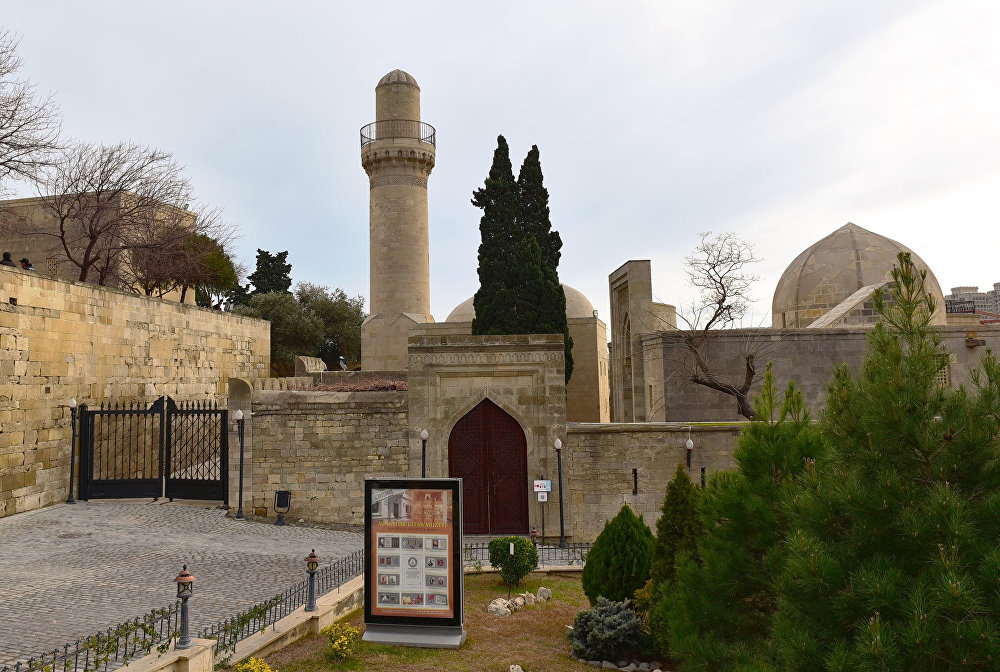
The reward of seeing people truly fulfilled by their sense of purpose. As a result of a strong earthquake in the XII century, Shamakhi suffered serious damage and Shirvanshah I Akhsitan, whose wife and children died, moved the capital of Shirvan state to Baku. Thus, Baku became one of the main cities of Shirvan. Shirvanshah erected the fortress walls of Icheri Sheher in his new capital and dug trenches in these walls. The people of the city were engaged in crafts, prepared carpets, copper and bronze dishes, and weapons. Many of these samples of folk art are now kept in museums of different countries of the world. Baku became a strategic port in the Caspian Sea, which created favorable conditions for its further progress.
The Shirvanshahs created a powerful fleet in the Caspian Sea. During the reign of shirvanshah I Khalilullah (1417-1462) a lot of construction work was carried out in Baku, the economy and culture strengthened. In 1501, Shah Ismail Safavi conquered Baku. During the reign of Shah TAHMASIB (1538) the state of Shirvanshahs became part of the Safavids state. After the disintegration of this state in the XVII century, the independent Baku Khanate was established here.
At that time, the Russian Empire’s geopolitical interest in the Caucasus was very strong. In this regard, Baku was of particular importance. The Russian Tsar Peter I marched to the Caspian Sea. In 1723, he sent an expedition to the Caspian Sea, and in the same year, Peter’s troops captured the entire Caspian region, including Baku, Shamakhi, Shirvan, Derbent, and the Caspian cities of Iran. The wars between Russia and Iran ended with the conclusion of the GULUSTAN peace treaty in 1813. According to this agreement, Azerbaijan was divided into two parts: the northern part was taken by Russia and the southern part by Iran.
MONUMENTS OF BAKU. The most interesting among historical monuments in Baku is the old Icheri Sheher, surrounded on three sides by a great fortress wall. The palace of the Shirvanshahs and its complex of various buildings (mausoleum, saray mosque, divankhana, Palace bath, mausoleum of the palace scientist Seyid Yahya Bakuvi (dervish turbine)) are located here. The palace of the Shirvanshahs was built by Shirvanshah I Khalilullah (in 1417-1462) and his son Farrukh Yasser (1962-1501). Among the ancient monuments in ICHERISHEHER, the Juma Mosque is also of interest. There is a text written by SULTAN OLJAYTUN (XIII century) in the building of this mosque. The streets of ICHERISHEHER are very narrow. Sometimes the passage between the houses is so narrow that when a person opens his hands, he grabs the whole street. In numerous small shops, there are carpets, ceramic products, copper dishes, and other ancient and modern products, which are handmade by folk craftsmen. it is possible to buy things. You can get acquainted with the national cuisine of Azerbaijan in the restaurants of the ancient Caravanserai building in Icheri Sheher.
The city looks like an amphitheater located on the slopes of rocky hills of Baku from the top of it – Highland Park or from the side of the sea. It reminds me of a goby on the Seacoast. On the outskirts of Icheri Sheher near the great Baku Boulevard, one of the most important historical-architectural monuments of our country, the Maiden Tower, which has become the symbol of Baku, is erected.
The Maiden Tower is dated to the XII century. According to scientists, this fortress was for military and defense purposes and is part of a whole complex of the military—defense buildings starting from the northern borders of Azerbaijan — Derbent fortress. The complex of defense fortifications Gilgilchay began from the sea. Many fortresses have been erected along this barrier which ends with a big tower in the Chiraggala mountains.
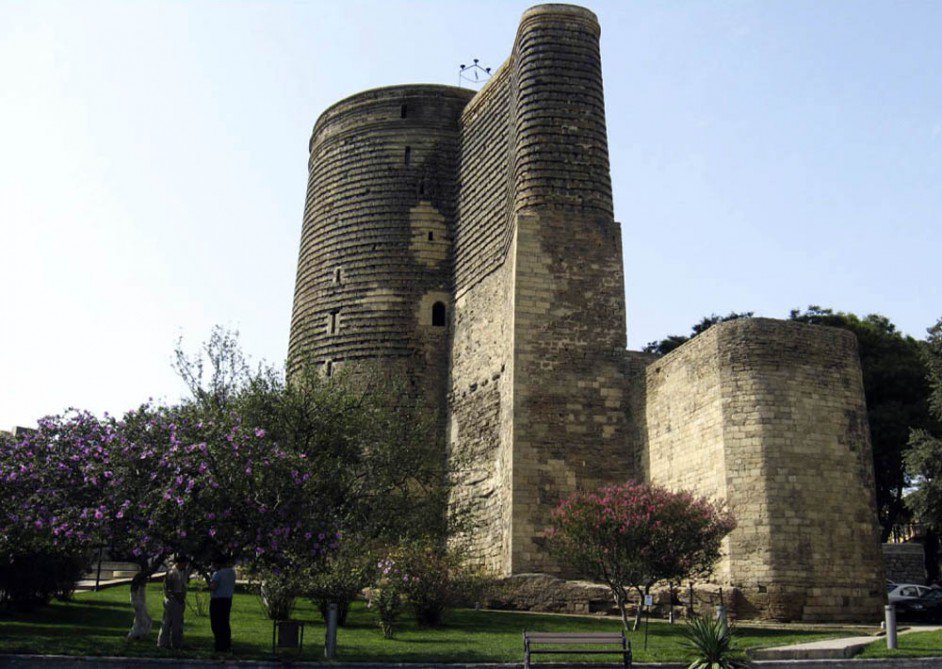
However, scientists have not yet been able to reveal all the secrets of the Maiden Tower. For example, there are facts about the construction of this fortress earlier. Many bakuvians consider the Maiden Tower, a unique example of the history and architecture of our country, very important not only from a religious, defense, and scientific (astronomic) point of view but also from an esoteric point of view. Therefore, there are many legends about the Maiden Tower and its name in the City folklore. Since 2000 it has been included in the UNESCO « World Heritage » List.
Today Baku is a modern city with the unique beauty of the East and features of a modern megalopolis. Baku, the capital of Azerbaijan, has several museums: the Museum of Azerbaijani history, The Museum of Literature, The Museum of musical culture, The Carpet Museum, The Theater Museum, as well as the Museum of the founder of modern Azerbaijani music Uzeyir HAJIBEYOV, the famous Azerbaijani composer Niyazi, the composer and jazz performer Vagif MUSTAFAZADE, memorial museums of world-famous musician Mstislav Rostropovich born in Baku, writer and playwrights Huseyn Javid, Jafar JABBARLI, Mammad Said ORDUBADI, and others, unique miniature book museum are functioning.
Of course, the new symbol of modern Baku is the Heydar Aliyev Center. It is a beautiful building, surrounded on four sides by various facades. The adjacent territory is neatly decorated, there are fountains, stairs, and escalators. This is a famous work of Iraqi-British architect Zaha Hadid.
The small town » Little Venice » is one of the beautiful places of the seaside National Park in Baku. This small town, reminiscent of Venice of Italy, adorns the capital of Azerbaijan with its beautiful appearance. In the 60s of the XX century, « Little Venice » was established on Baku Boulevard and became a favorite place for recreation of Baku citizens and guests of the city.
Seaside Boulevard is a charming corner of Baku, one of the favorite places for recreation of residents and guests of Baku City. In 2009, The Boulevard celebrated its 100th anniversary. If before the reconstruction the length of the boulevard was 16 kilometers, then after the reconstruction it became 25 kilometers. In March 2014, a new 60-meter-high observation wheel was opened in the new tabloid section of Primorsky National Park. Inspired by the « sails » of the Sydney Opera House on the boulevard, there are attractions such as the Park Bulvar Mall and the Caspian W. At the end of the boulevard there is the National Flag Square (World Flag Square) with the flag and the flagpole. A little away from the flag there is a sports and concert complex « Crystal Hall », designed for the « Eurovision-2012 » song contest.
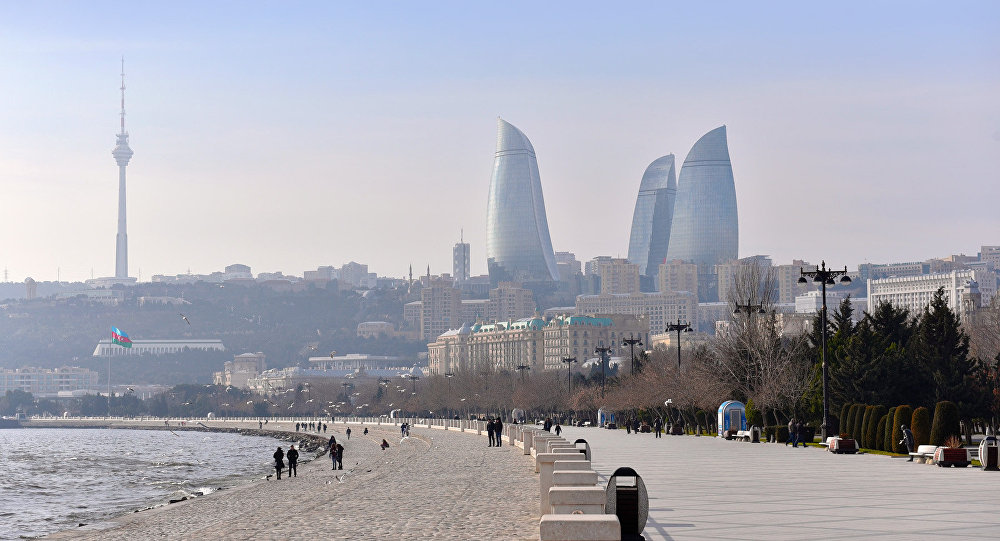
Since carpet weaving is the oldest art in Azerbaijan, it is not surprising that the world’s first specialized museum for Carpet collection, preservation, and study was created in Azerbaijan.
The ultramodern architectural complex, which forms the new symbol of the capital of Azerbaijan, suits the overall look of the city. Its name is self-explanatory Flame Towers, that is, « flame » or « glowing » towers are three giant buildings resembling fiery tongues. It is not necessary to go out to the side to see them, because these towers are visible everywhere.
There are numerous exhibition and concert halls, art galleries, theaters, sports complexes, stadiums, swimming pools, hotels, and restaurants in the capital.
There are many beaches in Baku’s circuit along the entire perimeter of the Absheron Peninsula. In 5 months of the year, you can sunbathe and bathe on the beaches of Absheron. There are many sunny and hot days here. In summer, when the heat decreases, discos and nightclubs begin to work on the beaches after sunset. Here, numerous hotels, rest houses, and sanatoriums on the Caspian Sea coast offer their services to tourists and holidaymakers.
NORTH ROUTE: KHIZI— SIYAZAN— DAVACHI— GUBA — KHACHMAZ— NABRAN— GUSAR
KHIZI

KHIZI district is located in the Guba-Khachmaz region of Azerbaijan. Khizi is the closest to Baku among the administrative regions of the republic with mountainous terrain: the distance between Baku and Khizi is only 70 km. The climate in this region is mild-hot and precipitation falls less. The eastern part of the district is the Caspian coast.
On the road to Khizi, 10 km from the BAKU-ROSTOV highway, one can observe a very interesting natural phenomenon: layers of geological rocks create on the surface of hills a landscape of its own color. Experts say that a similar geological phenomenon can only be found on earth, except here — in the Valley of death in the United States.
One of the most beautiful reserves of the Republic, « ALTIAGHAJ » Reserve is located in Khizi district. 90% of its area consists of forests. This reserve was created to preserve rare species of animals and plants on the south-eastern slopes of the Greater Caucasus and to prevent erosion processes from taking place here. One of the caravan camps established during Shirvanshahs ‘ rule was located here. The meaning of the name « Altiagach » is related to the words « 6 trees »: the point is that the word « tree » is an ancient unit of length and is approximately 7 kilometers.
Since the distance from Altiaghaj to Shamakhi is 42 km, that is, « 6 trees », this place was named as such. The ancient caravan route linking Shamakhi and Derbent passed here. Lovers of pedestrian tourism still make tourist trips from here to Maraza and Shamakhi. Yashma Reserve is also located in the territory of Khizi region (near Sumgayit city). The Reserve, which covers an area of 4 hectares, has favorable conditions for hunting and fishing for water birds.
The administrative center of the district is KHIZI city. The distance from Baku is 104 km. Khizi is the homeland of the famous writer and playwright of Azerbaijan, Jafar Jabbarli who has done a lot for the development of national cinema art. At present, the Azerbaijan State Film Studio bears his name. Well-known cultural figures of Azerbaijan Mikayil Mushfig and Jabir Novruz are also originally from Khizi. For travelers, tourists, and simply vacationers who come here, a wonderful recreation area called « Paradise Garden » has been created near the city. This zone is located in the mountain forest, on the Bank of Atachay River, near Altiaghaj Reserve. 8 km from Khizi there is another recreation area called « GIZILGAZMA ».
SIYAZAN
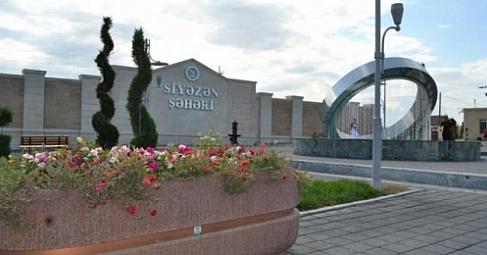
Siyazan district is located in the north of the capital of Azerbaijan, along the coast of the Caspian Sea. Climate dry semi-desert climate, the landscape consists of sparse forests and shrubs. Wolves, wild cats, jackals, rabbits, and other species are common in the animal world. Several species of waterfowl can be found in the coastal zone. GILGILCHAY and ATACHAY rivers flow through the territory of this region.
During the early Middle Ages, the second line of the Caspian defense fortifications was passing here (the first line of these fortifications is in Derbent). This line is included in the list of historical and cultural monuments protected by the state of Azerbaijan. GILGILCHAY defensive fortification was also recommended by UNESCO to be included in the list of World Heritage Cultural Monuments in the complex « Caspian defense fortifications ». Archaeologists have established that the construction of the defense fortification Gilgilchay began long ago, even before our era, additional construction works were carried out and the fortification was further strengthened.
The walls of the fortifications begin directly inside the sea (for many years the water level in the Caspian Sea has undergone periodic changes). The fortress walls, stretching for several kilometers, ending in the magnificent CHIRAGGALA Watchtower (V century). It is worth climbing this tower: its historical significance lies in its place, looking from the top of the mountain, a very beautiful view of the sea and the surrounding mountains opens.
Here, between the sea and the foothills of the Caucasus Mountains, there is a convenient passage for travel from Azerbaijan to other countries in the North. From ancient times, the invaders who came from the territory called the Caspian passage from neighboring states and distant provinces entered the territory of our country. They attacked Azerbaijan, made robberies in the port of Baku, sometimes even went to the districts in the inner part of the country. Therefore, this fortification was of defensive nature and was used to deliver signals to Absheron (Baku) and later to all border regions of ancient Azerbaijan. The dimensions and defensive purpose of the fortification walls (he also protected the passage to the Great Silk Road) make it possible to compare it with the Great Wall of China, but this facility has not been restored yet.
In the resort town of GALAALTI, located just a short distance from the Chirag gala Tower, the Chiraggala sanatorium attracts attention. On its territory, there is a spring of sulfur-containing mineral water, which has a curative value. This water is especially useful for patients with stones in the urinary bladder and gallbladder. Along the way to the sanatorium, there are numerous kebab houses, cafes, and small campsites. Most of them work only in summertime.

Fragments of another defensive fortification Beshbarmag near ZARAT village were preserved. Among the people, these remains are called baba in Khizirzin. And near the village of Sedan, the remains of the religious fortress attract attention.
Carpet weaving patterned carving on wood, making of folk musical instruments are widely developed in this region. The center of the district is 103 km from the city of Siyazan.
There is no hotel in Siyazan. Therefore, those who come here can stay in private houses or in the Chiraggala sanatorium, which is a little distance from the city. If you want to have lunch in Siyazan, you can use the services of « GORUS », « ZAFARAN » or « CHIRAGGALA » restaurants. As the city is located near the Caspian Sea, these restaurants offer a wide range of fish dishes in meat and vegetable dishes.
SHABRAN
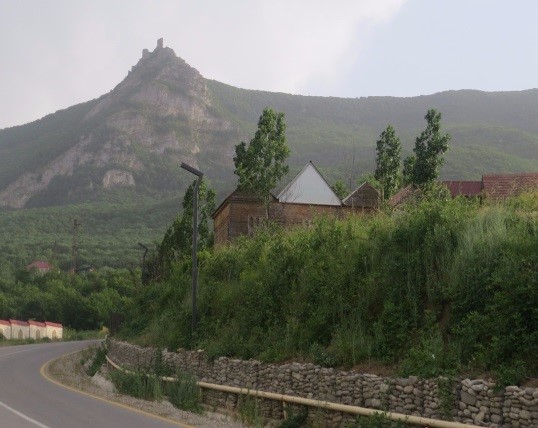
Located in the north of Baku, the eastern border of the Shabran region stretches along the coast of the Caspian Sea. Such a name of the district is probably due to a large number of camel caravan routes here. Residents of this region used to keep camels, and visitors from neighboring regions bought and sold not only camels, but also birds, animals, butter and dairy products, honey, wool (camel and sheep wool), and carpets. In addition, there were those who came to join the caravan or rent camels and sarvan for themselves. In 2010, the name of Davachi district was changed to Shabran district.
A hunting farm called Aghibir was established in the territory of devechi district at a distance of 12 km from the Sea coast. With an area of 1180 hectares, the farm can hunt waterfowl and fish. Three interconnected lakes, located in Agzhibir, have access to the sea. There are also small houses and boats to welcome hunters. There are a lot of forests (21,500 hectares) in these forests: bears, foxes, wolves, jackals, wild boars, and gazelles. Birds, including water birds, can be found as turaj, Partridge, goose, duck, crane, Cormorant, coot, and other species. The relief of the territory is very diverse. Here, along with Plains, foothills, there are also rocks and mountains. The place called kechigaya is very popular among both tourists and local residents. Here the river flows through the rocks, and mineral springs containing a lot of sulfur attract attention. The most famous historical monument of Archaeology in the region is Shabran city (5-18 centuries), located near the village of Shahnazarli. Shabran was one of the largest trade and craft centers of Azerbaijan in the Middle Ages. The art of silk production, pottery, and glazing were particularly highly developed here. As a result of archaeological excavations carried out in the 80s of the 20th century, the discovery of many ceramic products imported from both local and other countries shows that Shabran had local trade relations with some countries of the East. Fragments of water pipelines built in 14th century were also discovered during archaeological excavations. This pipeline supplied the city with drinking water from a fountain located more than 10 km from the city.
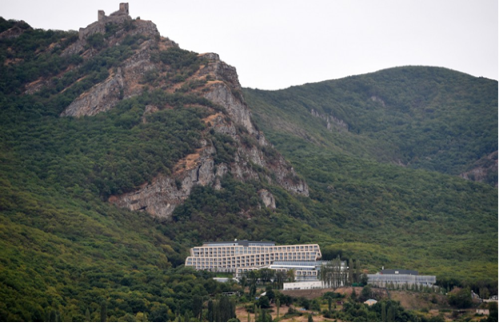
Galaalti is an original and extremely attractive balneological resort of Azerbaijan. It is located in the picturesque foothills of the Greater Caucasus at an altitude of 1000 m above sea level. Crystal clear air, located on picturesque forested slopes on the shore of the Caspian Sea, is a place of special natural beauty. Here mountain air merges with sea air and creates a low humid climate, which makes people feel comfortable. « Galaalti sanatorium » is especially useful for the treatment of kidney stone disease in medical and recreational resort complex in the territory of which there is a new unique architectural style and a mineral spring with curative sulfur water. The area is rich in mineral waters and mud volcanoes. Oil reserves have been found in the depths of the oxidized-Zeyva forests. On the way, you can see many oil rigs. There are two historical and archaeological monuments on the territory of the district. As for Shabran, we first get to know Chiraggala Castle. The meaning of « Galaalti » in Azerbaijani is « lower than the tower. » The name of « Chiraggala » Castle is directly related to the fact that it is located at the bottom of the fortress.
Gulistan Iram City (18-19 centuries) is located in Gandob village. Numerous archaeological sites dating back to 3-2 centuries BC were found in the Shabran district. The materials found during the excavations can be found in the historical and local lore Museum in Shabran.
The administrative center of the district, Shabran city, is located 122 km from Baku. Local » PIRABEDIL « and » HERAT PIRABEDIL » according to the classification of specialists belong to the Guba carpet school. These carpets, which are original and unique, are popular among lovers of hand-woven carpet products.
Shabran city is an administrative center located 122 km from Baku. Shabran was founded in the V-VII centuries. In the IX-X centuries, it became the main political-administrative, trade-cultural and cultural center of the state of Shirvanshahs. In the middle of the XI century, the Tomb of the Shirvanshahs family was located in Shabran. The name of the city was later given to the environment.
GUBA
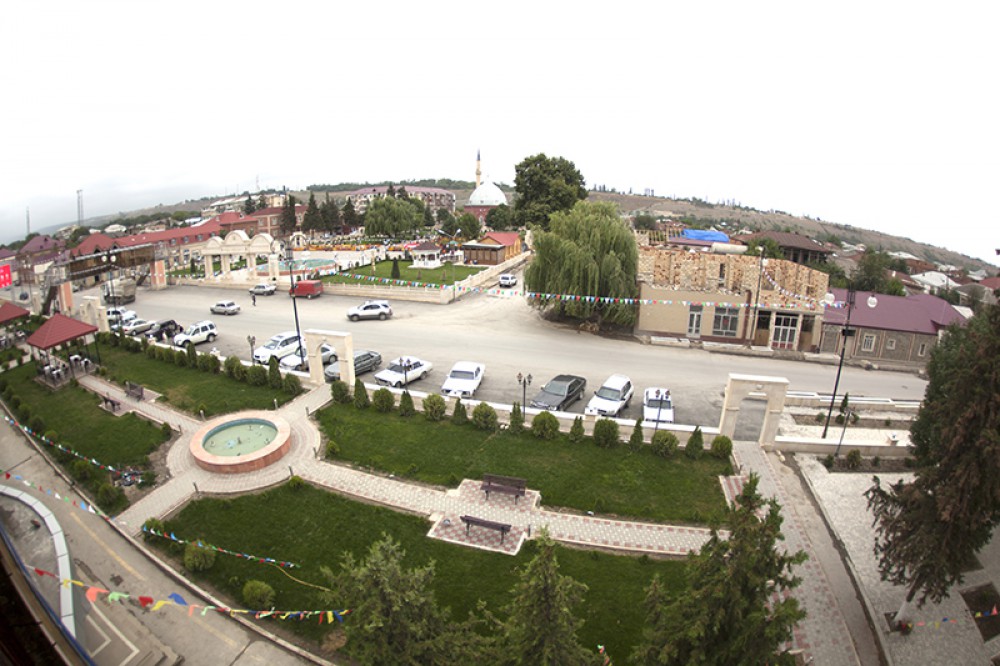
Guba district is one of the most developed agricultural regions of Azerbaijan. Fruits and vegetables grown here are exported to the capital markets, processed at local canning industry enterprises, and also exported to other countries. Despite a large number of fruits and vegetables grown in the Guba region, every Azerbaijani remembers his apple orchards when he says « Guba ».People who sell apples in Baku markets, while praising their goods, certainly emphasize that it is a Guba purchase. Guba region, which has a rich flora, is also represented by a wide range of medicinal plants. Hawthorn, Juniper, nightshade, andis, devadaban, effedra, and a number of other medicinal plants are grown here.
There are many picturesque corners around Guba. Gachresh, Balbulag, as well as Tangaalti ravine, the depth of which is from 400 to 600 meters, have become particularly popular and are of great interest to tourists.
The famous AFURJA waterfall on Valvalachay is included in the list of natural monuments of Azerbaijan and is protected by the state. There are other waterfalls here that attract the attention of tourists and travelers due to their uniqueness and uniqueness. It is a pleasure to stroll through these picturesque places on tourist trails. As you ascend to the mountains, tall trees are replaced by bushes, and above — on the Bank of Khashichay River thermal waters flow from the rocks of the mountain gorge. In ancient times, skilled craftsmen created three holes in rock and made self-made baths, and built their edges with stone. Those who come here can bathe in healing hot water containing sulfur-hydrogens in these baths. According to competent people, a bath made of natural stone enhances the healing effect of water.
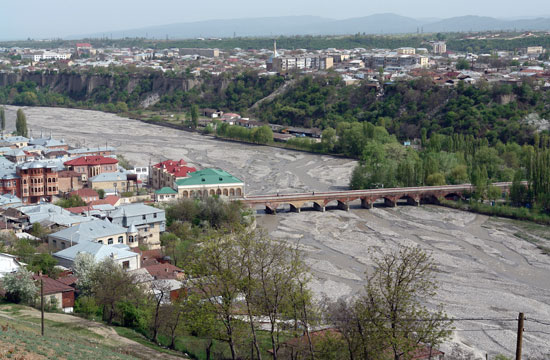
The famous French writer Alexander Dumas visited these places while traveling to Azerbaijan. When he camped near the road, the people of Guba camped nearby invite him to their bonfires in order to relax and have a snack. It is very impressive how the people of Guba skillfully cut and clean the sheep and share it with Dumas. The biggest traveler of our time, Norwegian scientist Thor Heyerdahl also visited Guba during his visit to Azerbaijan. He thought that the « aslar « mentioned in the » Edda » Epic were the ancient ancestors of Azerbaijanis and moved to the north of Europe during the great resettlement of peoples. In the Guba region, the population of Khinalig village, located 65 km from Guba in high mountains (2500 meters above sea level) is a separate unique ethnic group. The ancient language of the Khinaligs is not similar to any of the modern languages of the world. The people of Khinaliq also speak Azerbaijani but have preserved their language. Khinalig phenomenon is one of the most interesting ethnographic mysteries not only in the history of Azerbaijan but also in the history of mankind in general.
The sacred sanctuary is located near Khinalig. In this sanctuary of the IX century, natural fire emerges from under the Earth. Therefore, this place among the people is called Ateshgah. A unique ethnic group lives in the village of budug. These people have a very rare language. The ancient building called shakhma remained intact. These towers, belonging to the Zoroastrian period and called the « Tower of silence » among the people, were intended for the execution of Zoroastrians ‘ funeral.
Guba city is located on the Bank of Gudialchay River and on the north-eastern slopes of Shah Mountain, which is part of the Greater Caucasus range. The distance from Baku is 168 km, and the height above sea level is 600 meters. Information about the history of Guba city and Guba Khanate, people who made this country famous can be found in Local History Museum. The House-Museum of a famous public figure, writer, and educator Abbasgulu Aga Bakikhanov is also located here. One of bakikhanov’s books, « Gulustani — Iram », is devoted to the history of Azerbaijan. In essence, this book is the first scientific work on the history of Azerbaijan. There is also a carpet weaving center in Guba.
« Chichi », « Sirt Chichi », « Gimil », « Jimi », « Yerfi » carpets woven in this area are adornments of a number of museums and private collections of the world.
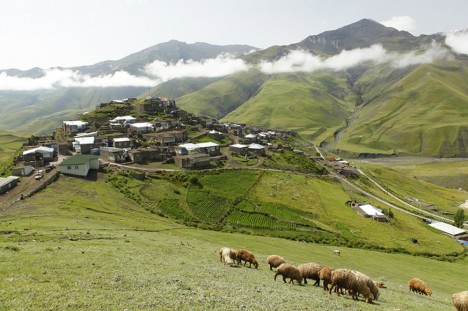
Historical monuments such as Sakina Khanum mosque, Juma Mosque, the mausoleum of the 16th century, ancient Eastern baths have been preserved in the city. In the first half of the 18th century, the present Guba, Davachi, Gusar, Khachmaz, Khizi, and Siyazan districts were united in the form of Guba Khanate. Initially, the center of this Khanate was Khudat city, but later Guba Khan Huseynali turned Guba into the center of its Khanate and moved his residence to Guba. Fatali Khan, the most famous ruler of Guba Khanate, tried to unite retail khanates of Azerbaijan under his leadership. He subjugated entire north-eastern Azerbaijan from Derbent to Lankaran. At that time, Jews were invited to settle in Guba, on the Left Bank of Gudyalchay. This settlement, formerly called the Jewish Sloboda, has been called the Red settlement since 1926.
Dagestani Khans have always been a source of danger for Guba Khanate from the North. When Russia began to show geopolitical interest in the Caucasus and Transcaucasia, it became much more difficult to protect the borders of Guba Khanate when it decided to establish its regime here. And at the beginning of the 19th century (in 1813) Guba Khanate became part of the Russian Empire.
Guba is a small town, but the territory of the present Guba district, located on the north-eastern slopes of the Greater Caucasus, is very picturesque and you will plunge into the world of beauty as soon as you get out of the city to the Canary Islands. Both Azerbaijani and foreign tourists never leave this region in the spotlight. And bakuvians, especially those who come there in their cars to rest in Guba, often visit the recreation area from Guba on the shore of the Yalama sea, not far from Guba. Those who relax in Yalama (Nabran) do not miss the opportunity to enjoy the rest on the Caspian coast, to enjoy the foothills of Guba forests, to enjoy numerous Springs and natural landscapes. Guba district is one of the most beautiful parts of our country. Given its proximity to the capital, the location of the forest zone with the Caspian coast, numerous tourist bases, and recreation areas, this region is of great importance as a recreational zone of the country.
KHACHMAZ

KHACHMAZ region, which occupies part of the Samur-Shabran lowland, is located in the northeast of Azerbaijan and borders Russia in the North. The main highway and the Baku-Moscow railway pass through the territory of this district. The climate of the region is mild-hot, semi-desert, and dry steppe. But more than 20 hectares of area in the district are covered with forests. There are several rivers, 3 artificial lakes, numerous thermal and mineral springs here.
On the border with Dagestan, there was a road before. The occupier Scythians, alan, and hunn tribes followed this path. For this purpose, the defense fortification near Caspian, which reached the territory of the present Khachmaz region, was built. One of the ancient city-castles at the beginning of the 18th century — Khudat (which literally means « Gifted »). It has become the capital of Guba Khanate. Near the city of Khudat, groundwater resources are especially abundant. In 1914, a drinking water pipeline was built here from the village of Shollar to Baku.
Traces of Neolithic and Bronze Age human settlements were found in the whole territory of the region. According to scientists, the toponym « KHACHMAZ » is connected with the name of Khachmatak or Khachmat tribes of the Comme Hunn tribes. Subsequently, they became entangled with the local population. It is interesting that one of these tribes moved from the territory of Khachmaz region to the present Oguz region and created Khachmaz village of the same name, then Khachmaz fortress.
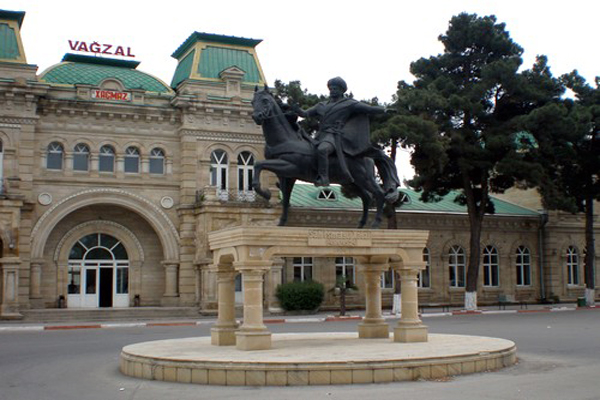
About 60 historical and cultural monuments are preserved in this region. However, according to archaeologists, the number of such monuments should be much higher, since ancient times the population has been densely populated in this region. Human settlements and mounds of the Bronze Age were discovered near the villages of Molla Burhan, Hulovlu, Garajig, Hasangala, human places of the Middle Ages near the villages of Janakhir and Bostanchi. The Sheikh Yusif mosque (15th century) in the village of Shikhlar refers to the early periods when architectural-mausoleum complexes were established. Subsequently, in the 16th-17th centuries, such complexes became more widespread. Mosques of the 19th century in the villages of Morugoba, Tagaroba, Uzunoba, mosques of the 15th century in the village of Garagortlu, and madrasas were preserved.
The administrative center of the Khachmaz district is Khachmaz city. Its distance from Baku is 157 km. A special faculty was opened in the local Lyceum because carpet weaving was developed more widely from traditional folk art. Visitors often come here to watch how they weave beautiful carpet patterns with the delicate fingers of young masters. Patterns of these carpets have been passed from generation to generation for centuries and are still preserved.
Visitors to Khachmaz can stay here at “Elit N Hotel”. The second place in the country for its size and improvement is located in the territory of Khachmaz district. Occupying an area from Mukhtadir settlement to Nabran settlement and a little farther along the coast of the Caspian Sea, this recreation area has many tourist bases and boarding houses.
NABRAN
Nabran is the largest creative region located on the shores of the Caspian Sea in Khachmaz. An interesting feature of this zone is that the forest begins immediately after the sandy beach, located in a small area. Various tourist bases, camps, boarding houses, and rest houses are located in this forest. Their conditions are very diverse-there is a wide choice of comfortable hotels of the « luxury » type, from abad cottages for several people to tent camps.
GUSAR
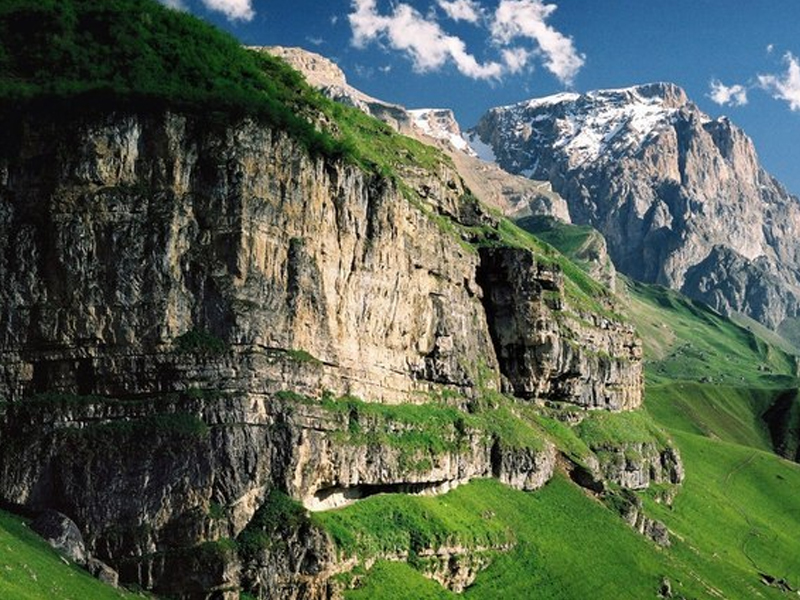
District center-Gusar city. Gusar bordering Dagestan is located in the northeast of Azerbaijan at a distance of 35 km from Khudat railway station. The name of the region is derived from the name of the tribe « Khisar », which once lived in this area and later disappeared as a result of historical ethnogenesis. Now in this region mainly live representatives of the Lezgin nation.
The landscape of this area is marked by an alternation of mountains and valleys covered with forests. Broad-leaved trees-hornbeam, oak, and birch trees are more common here. Asgaril, sumakh, Hawthorn, dog-rose, wild fruit trees, wild grapes, various kinds of medicinal plants grow in Tugay forests of the river deposits. Beech forest called « ALISTAN BABA forest » here (Area of 7 hectares) is protected by the state. The fauna of the Gusar region is also rich. Here live wolves, bears, Boars, mountain goats, eagles, owls, and other birds and animals. In order to preserve hunting and hunting industrial species of fauna and restore their prime number, « Gusar » Reserve was established (an area of 15 thousand hectares).
There are beautiful waterfalls in mountain gorges. The most popular of them are the waterfalls of Laza and Shahnabaz, which attract tourists and lovers of the wild nature of the Caucasus. The mountains and peaks of the Gusar region attract climbers. In recent years, local waterfalls have become a place for athletes who like to climb the icy mountains in winter. You can walk from Laza village to Khinalig village of Guba district. This route is preferred by lovers of pedestrian tourism.
Those who walk along the ecological tourism route from Gusar to Laza waterfall can camp in Anik village. The ruins of the fortress walls of the 13th century and the ancient mosque building are in good condition near this village. And near the village of Laza you can stay at the rest base » SUVAR ».
The length of the route from Gusar to the village of SUDUG is 75 km. On the slopes of the Shah mountain, you can see the mausoleum of Sheikh JUNEYDAN (16th century), the grandfather of the founder of the Safavid state of Azerbaijan Shah ISMAIL Khatai, in the village of Hazra.

Like all Azerbaijani lands, one can see evidence of the ancient culture and way of life of this person in Gusar. The remains of ancient mausoleums, mosques, ancient human settlements, and fortresses have been preserved in Hazra, Hil, Balagusar, Anik, Yasab, Kohna Khudat, Gunduz gala villages.
The administrative center of Gusar district is located 183 km from Baku. The Great Russian poet Lermontov once visited this city. Now a museum bearing his name has been created here.
The most common types of folk art in Gusar are carpet weaving. Flat-woven SUMAKH carpets are more popular both at home and in a shop in the city center. The biggest carpet bench in the Republic has been installed in this workshop. Up to 10 Carpet Makers can work on this machine at the same time.
Gusar district attracts tourists visiting Azerbaijan not only as a functional ski tourism complex, but also the natural wonders, culture, and traditions of the people living here are very interesting. The Pearl of all tourism industry of Azerbaijan, the complex of winter and spring sports facilities « Shahdag » is located at 2544 m above sea level, on the mountain slopes. The existing hotels here are located at an altitude of 1640 meters: « Pik Palace Shahdag », « Park Chalet, Shahdag », « Zirve Hotel Shahdag », and « Shahdag Hotel & Spa », but this is not the end for these places. If you are an excellent driver, you can see the highest mountain tourist center in Azerbaijan — Recreation Area « Suvar ». This is “Suvar”, located at an altitude of 1850 m above sea level. Near the complex, there are beautiful waterfalls — 2000 m high — Laza and Shahnabat twin waterfalls. Local waterfalls have one characteristic feature — it is very-very convenient to hold winter competitions here because they do not freeze in winter.
NORTH-WEST ROUTE: BAKU — GOBUSTAN — SHAMAKHI — ISMAYILLI — GABALA — OGUZ — SHEKI — GAKH — ZAGATALA-BALAKAN
Gobustan district is one of the administrative districts of the historical province of our country called Shirvan. In the 8th-16th centuries in the territory of Shirvan, there was one of the most important state institutions of Azerbaijan — the state of Shirvanshahs, located in the capital city of Shamakhi. It was this state that existed for the longest time in the history of the Middle Ages.
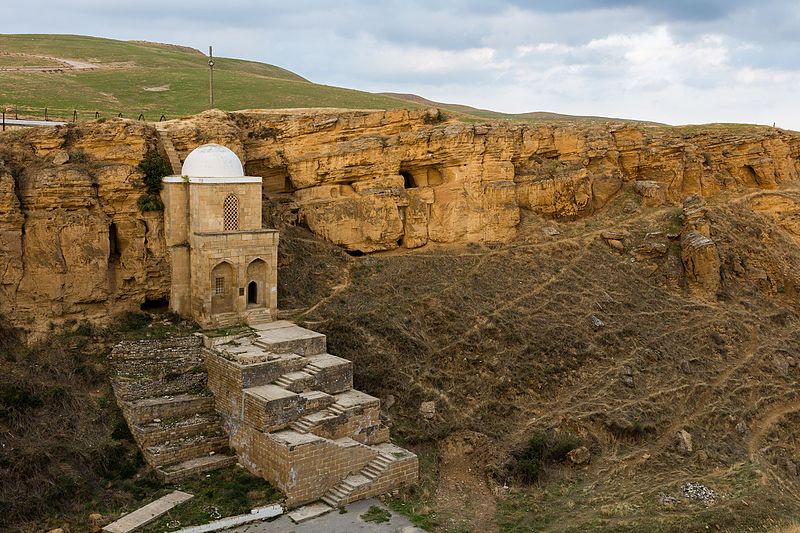
Present Gobustan district is located to the east of Shamakhi, 101 km away from Baku. Here the relief of the territory — gorges, ravines, rocks, toponymical reflected. The spring of these places is very beautiful, with tulips, chamomile, and irises.
The climate of the region is mainly semi-desert. The most interesting and attractive object here for tourists is cave labyrinths (spheres), located in the village of SOYUNLU, in the gorge near the city. Here it is possible to observe a very original natural phenomenon, which is popularly called « Weeping Rock ». According to legend, the « tears » flowing from this rock are the tears of the mother who killed the soldier sons. Caves are a system of natural galleries adapted for living, artificially expanded, and adapted during Tribal Wars and raids by foreign invaders in Azerbaijan in the Middle Ages.
The administrative center of the Gobustan district, the city of Gobustan, is located on the Maraza plateau, near the main highway of the district. According to one legend, the name of this city (« Maraz ») was named after this event because the beloved wife of one of the influential people settled here and recovered. No one knows if this narration is true, but near the Maraza there is a spring of MINERAL water. Although its juice is brackish and bitter, it heals certain gastrointestinal diseases.
The famous kurgans of Shikh DUZU, the remains of ancient human settlements dating back to 1-8th centuries BC, located on the ancient trade routes of the village of DAG KOLANI, DIRI BABA tomb around the city (15th century); the remains of Shah ABBAS Caravanserai located in the very center of the city show that these places were human settlements in ancient times.
They were into carpet weaving here from ancient times. Patterns of local « Maraza », « CHUKHANLI », « CHAMJEMLI » carpets are popular all over the world. « NABUR » carpets are still woven by hand in the village of the same name.
You can stay here at the hotel « Gobuland ».
SHAMAKHI
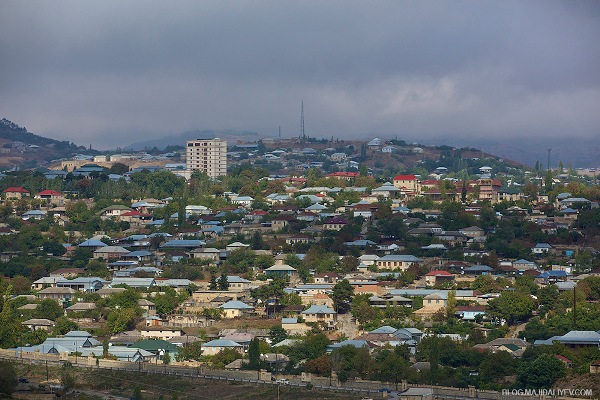
Shamakhi region-historical region of Azerbaijan, the center of ancient Shirvan, where the former state of Shirvanshahs is located. It is located on the south-eastern slopes of the Greater Caucasus. The climate of the main part of the region is mildly hot and dry in summer. The landscape is changeable. Here the steppes are replaced by foothills with grass, then forests. The cooler the fall rises above the sea level, the more snow remains in winter. But in general, the climate of the region is mild, the lands are fertile, rich in flora and fauna. Roe deer, wild boars, wild cats, foxes, wolves, bears, and many species of birds live here. Broad-leaved forests such as hornbeam, birch, oak, blue meadows covered with scarlet tulips are pleasing to the eye. More than 50 species of medicinal plants grow in the territory of the region.
Shamakhi district is the largest viticulture center of Azerbaijan. Shamakhi wines were popular not only in the local market but have long been awarded medals and diplomas at international exhibitions.
This region is a popular place of rest for the residents and lovers of sports tourism in the capital of Azerbaijan. Those who like to travel on foot, go on an excursion here to Guba and ISMAYILLI. Ecological tourists and ordinary travelers try to go to the forest of Jangi. Wild apple, pear, and cherry trees grow here, along the edge of the forest and near the gorge, springs of sulfurous water emerge from the ground. Famous « SHIRVAN », « SHAMAKHI », « ISRAFIL » and « ERJIMAN » carpets are woven in mountainous villages.
There are a lot of interesting places in the Shamakhi district. Molokans from Russia live in CHUKHURYURD settlement located on the Right Bank of PIRSAATCHAY River. Their delicious sunflower oil, pickled vegetables, mountain honey, vegetables, and fruits produced for sale in the capital of the Republic are very popular. There are many drinking water springs in the area called GIRKHBULAG. Near the village of Salam there is a famous cave named for its healing properties. Very famous in the East poet AFZALADDIN KHAGANI was born in this village in the XII century. In general, this region became famous for its poets, philosophers, and architects. SEYID Azim Shirvani, Imadeddin Nasimi, Mirza ALAKBAR SABIR, Haji ZEYNALABDIN Shirvani, Mahammad Shirvani, Azim AZIMZADE, ABBAS SAHHAT, Hamadi Shirvani, Falaki Shirvani are the children of this land (frequent repetition of the word « Shirvan » in their names is connected with a tradition that existed in the East since ancient times. As a rule, the name of the surname, which he adopted after becoming a famous person, is reflected in the name of his place of birth).
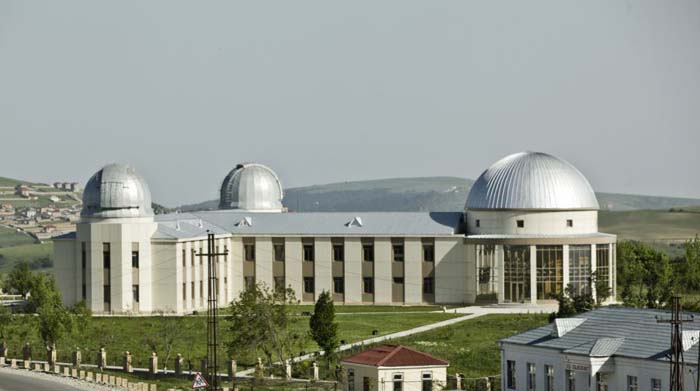
Shamakhyastrophysical Observatory named after Nasreddin Tusi (SAO) located near PIRGULU settlement is 1400 meters above the sea surface. One of the largest telescopes in the former USSR was installed here. One of the first Presidents of the Azerbaijan National Academy of Sciences, academician Yusif Mammadaliyev, who laid the foundation of petrochemistry in Azerbaijan, once did a lot to organize this Observatory. A statue of Y.Mammadaliyev has been erected here at the initiative of scientists working now in the territory of Shao as a sign of gratitude. Baku schoolchildren are always looking forward to going on an excursion to the Tusi balloon and seeing a huge telescope there. Residents of Baku, who do not usually snow in winter, are more eager to come here: because the snow in Pirgulu stays on the ground for a long time, so when you come here you can play snowballs. In summer, local residents, at the request of guests, take them for a ride on horseback.
Historical monuments of the region: Juma Mosque (VIII-X centuries); pirmardakan Tomb (XIII-XIV centuries); shahkhandan Tomb (XVII century); seven GUMBEZ complex consisting of 7 tombs (XVIII century); remains of legendary GALAYI-BUGURT fortress (XII-XVI centuries); this castle located near the mountain village of the same name as Sal kaya. In GULUSTAN fortress (VIII-XV centuries) Shirvanshah Shahrukh bravely repulsed the attack of Iranian troops. Shirvanshah’s Palace and unique water supply system remained intact in the fortress. Historical monuments of the region: Juma Mosque (VIII-X centuries); pirmardakan Tomb (XIII-XIV centuries); shahkhandan Tomb (XVII century); seven GUMBEZ complex consisting of 7 tombs (XVIII century); remains of legendary GALAYI-BUGURT fortress (XII-XVI centuries); This castle, located near the mountain village of the same name, seems to be attached to the rock. In GULUSTAN fortress (VIII-XV centuries) Shirvanshah Shahrukh bravely repulsed the attack of Iranian troops. Shirvanshah’s Palace and unique water supply system remained intact in the fortress. The hidden water pipeline provided the defense fortifications with water. Stone fences and slaves intended for storing water remained intact. Pirgulu Reserve was established in 1968. The total area of the Reserve is 1521 hectares and consists of three parts, 1362 hectares are forests located at an altitude of 800-2000 meters above sea level. The flora of the reserve includes 45 species of rare and endemic plants, the name of many of them is included in the Red Book.
The administrative center of the district is Shamakhi city. The distance from Baku is 120 km.
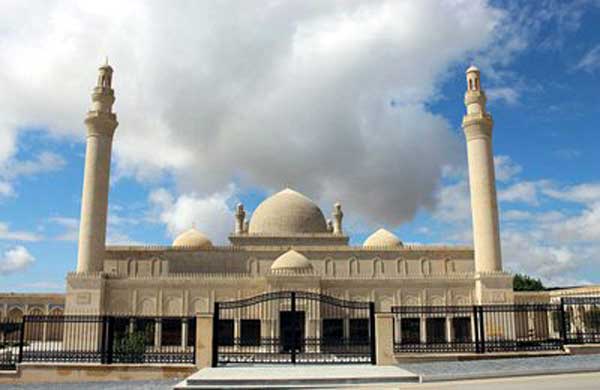
In ancient times, present Shamakhi city called « Sharvan », « Ashshamakh », « Shirvan », « Shakh-Makh » was the capital of Shirvan-Shirvanshahs state. One of several small states formed in the VIII century after the weakening of the Abbasids dynasty was Shirvanshahs state. This city has a glorious but tragic fate-it has been destroyed many times. These destructions were connected not only with the raids of the invaders but also with earthquakes because this place is a high seismic area. In 1191, when Gizil Arslan from the Atabey ELDAGEZ dynasty seized this city and devastated it, Shirvanshah I Akhsitan temporarily moved its capital to Baku. In 1501, Shah Ismail Safavi occupied both Shamakhi and Baku. After 37 years, the existence of the state of Shirvanshahs was terminated and Tahmasib Safavi created the state of the Safavids. In later periods Shamakhi was repeatedly destroyed in wars between the Safavids and Ottoman Turks. At such times, along with the death of people, architectural monuments and books were also destroyed…
However, the people of Shamakhy have always found strength in themselves and restored the city and arranged their livelihoods. Alexander Duma, who had traveled to Azerbaijan in due time, wrote about Shamakhi that residents of this city never know whether they will survive tomorrow. At present, many ancient monuments are preserved around Shamakhi.
Shamakhi is located in the Juma Mosque, the oldest mosque not only in Azerbaijan but also in the entire South Caucasus. It was built 743 years. In 2013, a major reconstruction of the Juma Mosque was carried out. In addition, old cells were restored around the mosque. During the archaeological excavations, madrasas, cells, and tombstones found in the courtyard of the mosque were found.
In Shamakhi, you can stop at such beautiful hotels as « Shirvan Hotel & SPA », « Sakit Lake — Silent Lake Hotel », « Samaxi Palace Platinum”.
ISMAILLI
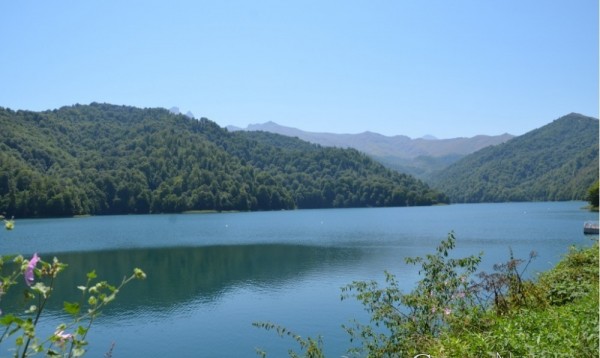
Three of the 8 climatic zones existing in Azerbaijan are found in the territory of ISMAYILLI region. The winter here is dry, mild, the weather in the plains is hot, precipitation is regular, and in the mountains winter is cold and humid. The main relief of the region consists of mountains. This place has a very beautiful nature. Forested mountains, rocks, rivers (GIRDMAN, AKH-OKH, GOYCHAY), waterfalls (GALAJIG — height 50 meters, CHAYGOVUSHAN — height 30 meters, ISTISU — height 25 meters, madrasa — height 25 meters). On the slopes of BABADAGH at an altitude of 3500 meters above sea level, 3 natural lakes, three artificial lakes near the villages of KURDMASHI and ASHIGBAYRAMLI are very picturesque and suitable places for fishing.
The « ISMAYILLI » Reserve was established in 1981. With an area of 5,778 hectares, this reserve consists of two parts — artillery and will remain. Their distance from each other is 1 km. The forests of the Reserve occupy 5021 hectares, subalpine meadows 227 hectares. Here you can meet more than 40 species of wood and shrubs, 170 species of vertebrate animals — deer, mountain goats, wild boars, bears, wolves, foxes, hares, etc.
The name of this district fell on the history of Russian literature: M.Y. Lermontov wrote his poem « Ashig Garib » on the basis of the saga heard about Ashig Garib from Oruj (people’s singer) and Ashig Lezgin Ahmad while he was in Tirjan village of Ismayilli.
The name of this district fell on the history of Russian literature: M.Y. Lermontov wrote his poem « Ashig Garib » on the basis of the saga heard about Ashig Garib from Oruj (folk singer) and Ashig Lezgin Ahmad while he was in Tirjan village of Ismayilli.
Since ancient times, along with Azerbaijanis, representatives of other peoples and ethnic groups — lezgins, Jews, Russians (molokans living in Ivanovka village), lahijs (Iranian-speaking tribe), hapits (heirs of ancient Albanians) have settled in this area.
The traditions of ancient art and applied art have been preserved in Ismayilli region. Carpet weaving (GALAJIG and TAZAKAND villages), utensils and weapons with forged patterns made of copper, tannery, blacksmithing, wood and metal carving (these professions are more common in Lahij village, many shops and workshops in the central street of this village), national head coverings called « KELAGHAYI » are made for women in BASQAL village. Patterns of kelaghayi made of silk fabric are engraved by pressing method.
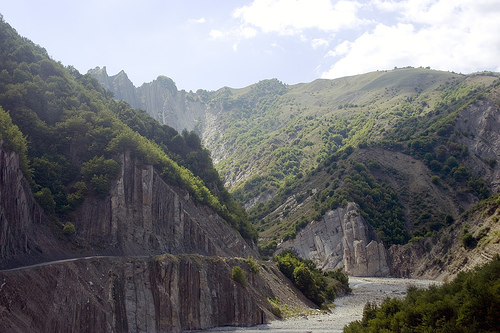
It should be noted that Azerbaijani kelagayi was included in the UNESCO Intangible Cultural Heritage List under the name “traditional art of making and dressing kelagayi women’s headscarf and its symbolism”. Copper production in Lahij is also included in UNESCO’s list of intangible cultural heritage from Azerbaijan.
Historical and cultural reserves have been created in Lahij and BASGAL villages. Most of the monuments here are protected by the state. Badoy ZEVERO mosque (1791), Agali mosque, ZEVERO spring, mosque and bathhouse (XVIII century).
Other monuments: Maiden Tower in KHANAGAH village (XVII century), FITDAGH Tower in SULUT village (XVIII century), and a number of other archaeological objects. It is interesting that local residents associate the Fitdagh Tower with a narration about Alexander the Macedonian. It is said that Alexander of Macedon himself camped here, and his supporters climbed to the top of the mountain and informed each other about it with Golden Sheeps. Therefore, this tower is called Fitdag Tower.
Javanshir (VII century), one of the rulers of Caucasian Albania, according to legend, lived in a fortress near TALISTAN village on the top of another mountain on the Left Bank of GIRDIMAN River. GIRKHOTAG Tower, HARAM Tower, Khiraki defense wall, and Juma Mosque were also preserved in Sulut village.
The administrative center of Ismayilli district is ISMAYILLI city. The distance from Baku is 185 km. Ismayilli is also one of the winemaking centers of Azerbaijan, and all opportunities are created here for one direction of tourism-wine. Since the deserts of Ismayilli are unusually rich, hunting tourism is also developing in the region.
There are many hotels and recreation centers in Ismayilli. GAYA RESORT CENTER, MAIDEN TOWER, GREEN HOUSE, JULYAN RESORT CENTER, KALAMARJ, HASANOGULLAR RESORT CENTER, MAXUL, RIZVAN RESORT CENTER, KORKUT MONTOLIT.
GABALA
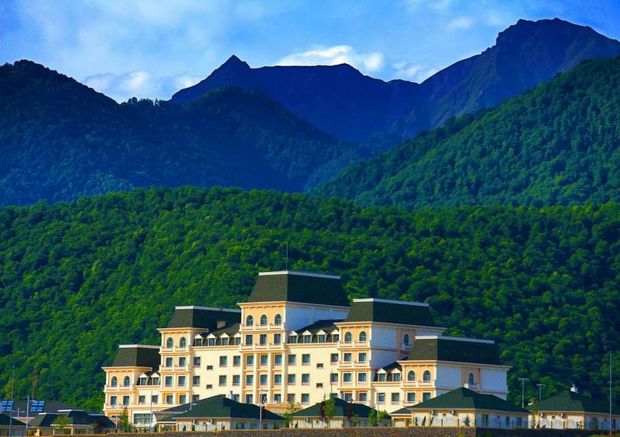
Gabala region is located in the north-western part of Azerbaijan, in the territory of Sheki-Zagatala zone, on the border of Dagestan and Georgia. This region has a very ancient history. People lived here even in the Neolithic period. Gabala was the center of Caucasian Albania for some time, and later it was part of Shirvanshahs state and Sheki Khanate. DEMIRAPARAN River, VanDam River, BUM River, TIKANLY River, and other rivers flow through the region.
Gabala region is named for its nuts and Chestnut Gardens. On the mountain slopes, at an altitude of 1000 m above sea level, there is a famous chestnut forest. The flowering of chestnut trees in spring creates a wonderful landscape. The trees in this forest are very old. The average age of each of them is more than 500 years. Some of these trees are included in the list of natural monuments protected by the state. Here you can hunt gazelle, roe deer, bears, wolves, hares, and other animals representing local fauna. One of the mountain routes going to the highest peak of the Republic to BAZARDUZU mountain (4466 m above sea level) passes through this region.
There are many historical, cultural, and architectural monuments in the region. Mosque in Bum village (XIX C), Albanian temple in Emili village (IV C), ustajan Tower in BAYRAMKOKHA village (IX C), Haji Garib mosque and CHOTARI Albanian Church in NIC village, Sheikh BADRADDIN and Sheikh Mansur tombs in Hazra village (XV C), the mausoleum in SHAFILI village (XVII C), as well as SHIKHBABA piri in HAMZELLI village (XVI C) and KOMRAD piri on the top of KOMRAD mountain (the place of burial of people considered holy and righteous in their health is called pir).
In YALOVLU mountain near NIJ village, archaeologists discovered the remains of ancient human settlements. Samples of archaeological culture found here are typical for northern regions of Azerbaijan and are known as « Yalovlu Hill culture » in science. Weapons made of iron and bronze, gold objects, millstones, and other samples were found here. Wood processing (VanDam Village), Pottery (GAMARVAN village), carpet weaving (LAZA and BUM villages) are widely developed. Zop-Zopa Folklore Ensemble established in Bum village has performed successfully in various festivals held in foreign countries. The udins live compactly in the village of NIJ in the Gabala region. This ethnic group, considered the predecessors of the ancient Albanians, managed to preserve the traditions, language, material and spiritual culture of their ancestors to this day.
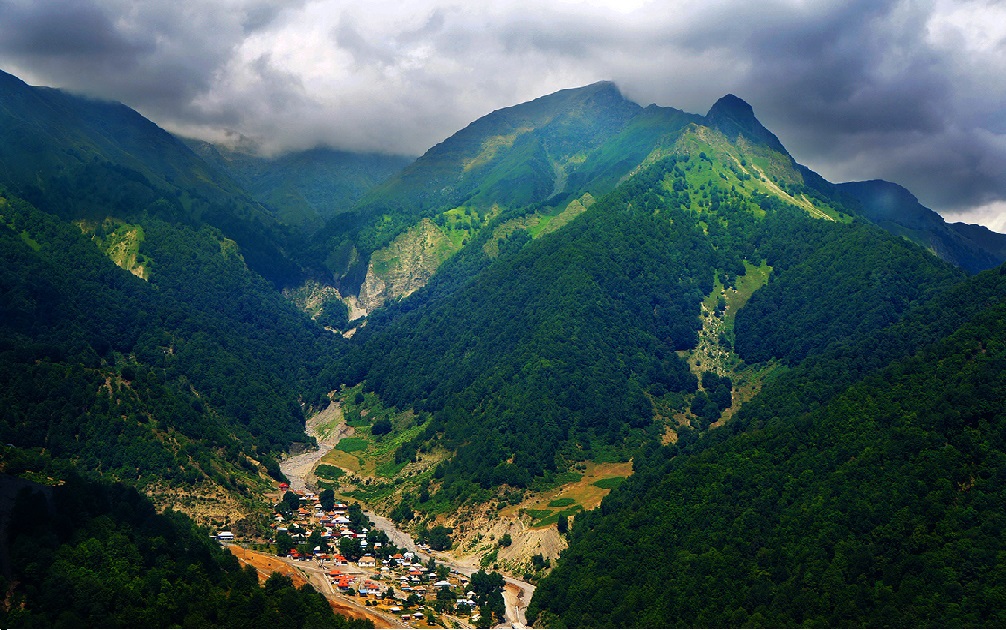
The administrative center of the district, the city of Gabala, is located in the foothills of Shahdag. The ancient city of KABALA, named in Greek and Roman written sources (Pliny), was founded about 2000 years ago and for more than 600 years was the capital of Caucasian Albania. Ruins of the ancient city of Gabala are located near the modern Gabala (15 km from it) in the area between the GARACHAY and COVURLUCAY rivers. There are monuments such as the Tomb of IMAM BABA (XVIII century) and the Juma Mosque in Gabala. There is also a large museum of history and local lore in the city. In this museum, numerous archaeological finds discovered in the region have been collected.
Here tourists will be able to find everything you need for a good rest. Mountain air, beautiful rivers, waterfalls, and lakes delight the eye. A unique tourist route » Alexander Dumas in the Caucasus » is located on the territory of the Gabala region. This route is the same age as the writer’s arrival in the Caucasus in 1858.
Not far from Gabala, there is a unique architectural monument — the Udi temple in NIJ village. Udi is considered to be descendants of the ancient Albanians, and there are about 10 000 representatives of this particular ethnic group. They have managed to preserve their language and cultural traditions to this day. In recent years, this temple has been restored and is now open to tourists. This recreation area is a popular tourist center, which is open not only to residents of Azerbaijan but also to tourists from different countries. Every year music festivals of mugham, jazz, classical music, and piano are held here. In addition, a large entertainment center “Gabala” was built in Gabala. This is the largest amusement park in Azerbaijan, located on 16 hectares. Here there is an ice rink, Sports Grounds, go-karting, XD theater.
Culture and tourism in the region are currently developing rapidly. There are very interesting hotels: « Caucasian Sport Gabala », « Caucasian Resort Hotel », « Caucasian Riverside Resort Hotel », « Caucasian Seven Beauties Resorts », « Caucasian Thermal and Spa Resort hotel », « Caucasian Karvansarai Hotel”.
On the outskirts of Gabala city is a recreation area « AI ISHYGY ». High tourist service « mountain hostel », forest, excursions, hunting and fishing recreation is organized.
Located at 5 km of Baku-Gabala Road (area 1.5 ha), the « Sahil Lake Nokhur » recreation area is located. Tourists can go to waterfalls, forests, historical monuments.
OGUZ
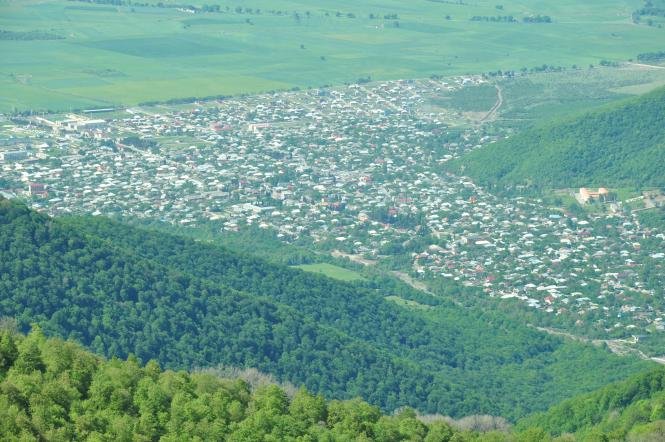
Oguz district is located in the Sheki-Zagatala zone of our country on the southern slopes of the Greater Caucasus. This region, which borders on Russia in the North, is so beautiful that it is rightly called « Azerbaijan’s Switzerland ». A little less than half of the territory of the region is covered with forests. There are many waterfalls, sulfurous and thermal water springs here. Fauna of the region is represented by rabbit, Bear, Mountain Goat, wild boar, pheasant, partridge, goose, as well as som and forel fish. Various fruits and berries — walnuts, hazelnuts, apples, pears, cornel, hawthorn, cherry, cherry, cherry, currant, and raspberry grow in the region.
Traditional folk art carpet weaving (Filfilli village), metal and wood carving (BASH, DASH, AGHIL village) are continued. People here still led a sedentary lifestyle in the Neolithic period. At the beginning of our era, this territory was part of Caucasian Albania and in the XVIII century, it was part of Sheki Khanate. Archaeologists have discovered ancient human settlements near the villages of KARIMLI and KARABALDIR. Spears, bronze arms, women’s sculptures made of stone, and staves were found here.
There are many ancient historical and architectural monuments in the region. DASHUZ Bridge on the SARISU River near KHACHMAZ village (XIX century), a mosque in SINJAN village (XVIII century), the mausoleum in KARIMLI village (XV century), three-storied tower in MUKHAS village (XIV century), defensive GABUR Tower in KHACHMAZ village (VII-XIV centuries) still located near GALADAGH peak but supplied with drinking water GAVURGALA Tower (VII century), SURKHAYKHAN Tower (XVIII century), built of river stone, located near FILFILLI River, on the Bank of GALACHAY River and etc.
The administrative center of the district is Oguz city. Ancient synagogue Jewish settlement (1849) in the area of Oguz city, Albanian temple where the Museum of local lore is located, one of the oldest schools in the territory of Azerbaijan, built in XIX century (such schools are also found in PADAR and KHACHMAZ villages).
Oguz itself is a small but clean city. Only 15-20 km around it are very convenient places for hunting and fishing. Although the tourist potential of this area has not yet been fully utilized, there are a number of recreational areas of the city and abroad, such as the guest Greenland, LT Hotel, and Afra Hotel. The main attraction of this region is the Khal waterfall, as well as the « Golden Fish” Family Recreation Center, where entrepreneurs have created several artificial mountain lakes. The peculiarity of this recreation area is that it provides guests with the opportunity to fish.
SHEKI
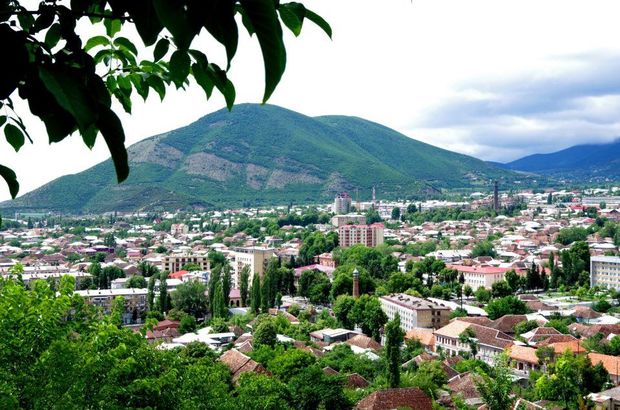
Sheki region is located on the southern slopes of the Greater Caucasus Mountains. The ruins of many monuments of early medieval architecture — castles, observation towers, churches, temples of Caucasian Albania have been preserved in the settlement of Sheki. More interesting are the monuments in the villages of BIDEYIZ, BASH KUNJUT, ORTA ZEYZIT, the church erected by Saint Elysee in the village of Kish. This church is considered to be the oldest Christian building in the territory of the Commonwealth of independent states. At present, the church has been restored and turned into a museum.
Sheki city is the main city of Sheki-Zagatala region. Sheki, one of the oldest and most beautiful cities of Azerbaijan, is supposed to be built in the first millennium BC. This city is mentioned in Arabic, Turkish, Georgian, Russian, and European written sources.
Scientists believe that the name of this city was derived from the name of the SAK tribes who once lived here. Sheki is located on the route of the Great Silk Road. Ptolemy wrote his name in the records about Sheki as Niga. The city is associated with enthusiastic people from around the world who have enjoyable. Old residents still call Shaki Nukha. In 1772, when the flood flooded Shaki, residents moved to the nearby village of Nukha. During the widespread Christianity, Sheki was one of the religious centers of Caucasian Albania. During the period of Arab-Caspian Wars (VII-XIX centuries) this city turned into an area of military conflicts and clashes. When the Arab Caliphate zayiflak, the principality created here was part of the Shirvanshahs ‘ state.
During the reign of the Elkhanids dynasty, the stage of progress began in Sheki, and the city became the center of an independent territory under the rule of the local ruler Sidi Ali (Seyid Ali). During Tamerlane’s attacks, Sidi Ali resisted the invaders and then took the troops led by him and went to help Nakhchivan, who heroically defended ALINJA Castle at that time (1397-1398 years).
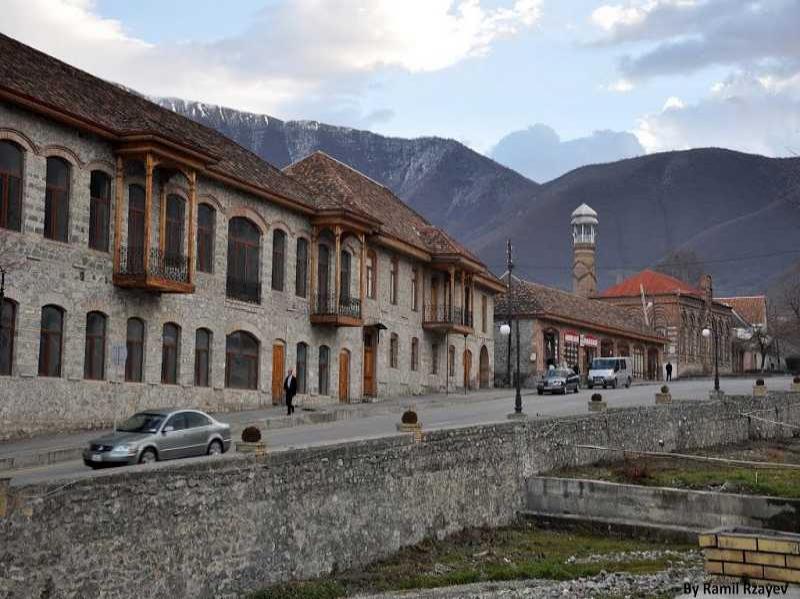
At the famous Sheki markets, there was a fierce exchange, where grain, dishes embroidered with tattoos, and jewelry made by jewelers were sold. There are different types of Sheki silk — soft and non-shafikav, thin and shafikav, dark-colored or with gulabatin thread… craftsmen of this city have made a great contribution to the development of trade along the Great Silk Road. Sheki was the center of Sericulture of the whole Caucasus. In 1862, 62,239 Poods of Silk were produced in Nukha (Sheki) province. In 1861, the first silk-spinning factory was built here. It was one of the largest factories in the world. In 1862, at the International Exhibition in London, Sheki silk was awarded a gold medal.
Sheki is proud of the famous philosopher, writer, and enlightener Mirza Fatali Akhundov. In this city, there are house-museums of M.F. Akhundov and SABIT RAHMAN. Sheki Khan’S Palace is a unique example of the connection of folk architecture (carving on wood and clay) with the traditions of the palace architecture of the east (wall paintings painted with varnish).
The dimensions of the lower caravanserai and the upper caravanserai built in the XVIII century show that trade was widely developed here in the Middle Ages.
The ruins of the ancient fortress « GELERSEN-GORERSEN » are preserved near Sheki, on the West Bank of the river Kish. From the name of this fortress, it is known that its defenders were determined not to let the enemy into this fortress and were sure of the invincibility of the fortress. The events that happened to the heroes of Lev Tolstoy’s narrative « Hadji Murad » take place in this fortress. Alexander Dumas, Kempfer and N.Rayevsky was in Sheki. N.Rayevsky wrote in his letter: « our camp is in a forest with trees like tamarisk, pomegranates, plane trees and others… Nukha is a wonderful place. » In 1805 Sheki Khanate became part of Russia and its existence as a Khanate was terminated. In 1819, by the decree of the Russian Tsar, the Nukha province was established and Sheki was managed by the Tsar’s Commandant.
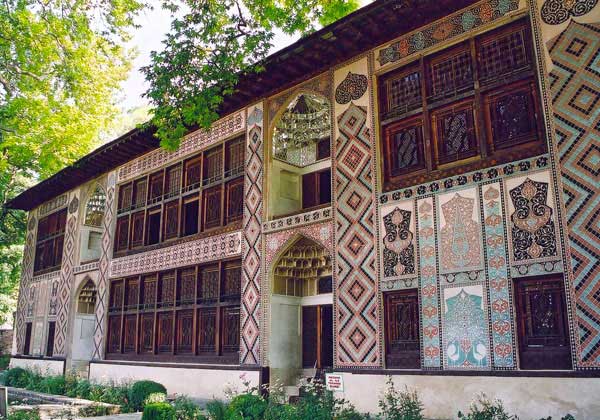
There are a lot of attractive cultural objects in this city: The Drama Theater named after Sabit Rahman, the Museum of decorative and Applied Art, The Art Gallery are such objects. The inhabitants of the nin have preserved their unique traditions and knowledge of ancient art even today. Silk caps called « KELAGHAYI » are exported even to Central Asian countries and used there by local craftsmen for the purpose of embroidery on silk. Wooden chests with special patterns of Sheki are also made here. And The Shape of ornaments made by local jewelers has changed little since ancient times. The art of needlework called TAKALDUZ was highly developed in Sheki. Previously, this work was mainly dealt with by men. In addition, hat-making, making musical instruments and networking are continuing in Sheki. Such frames made of patterned wooden net and decorated with colored shushets are usually used indoor and window places. Original Sheki cuisine, which has no analogs in Azerbaijan, is also included in the unique culture of Sheki. The unusual sweets (Sheki halva) cooked by the citizens of Sheki are obtained by spreading thin yukha from the dough, which is mixed with rice flour, and by shaping them.
Sheki is famous for its natural beauty. Here all the conditions for active sports and simple but pleasant walks are created, at which time you can generally watch the mountains, forests, and nature. Medical and massage centers, restaurants, cafes, and shops are also open for tourists.
There are modern hotel complexes in Sheki, such as « Sheki — Karvansaray » hotel. Sheki Palace Hotel, Issam Hotel & Spa, Sheki Palace Hotel.
Marxal Resort & SPA.
One of the perfect places of rest in Azerbaijan is the hotel « Marxal Resort & SPA ». This beautiful Health Complex is located in the beautiful village of Markhal in Kish village, near Sheki, at an altitude of 1,080 meters above sea level. The hotel is surrounded on all sides by mountains, which means that here you can find clean mountain air and an unforgettable holiday. For fans of entertainment, there is an opportunity to ride a bike, you can dance in a nightclub or sing in a karaoke hall, there is a cinema hall, bowling alley, and a billiard room. Every evening, guests of the hotel are waiting for interesting entertainment shows. There is a unique Amber Room here — one of the few places in Azerbaijan and one of the few in the world. The room is assembled from untreated natural Ukrainian Amber, embodying solar energy. It’s great to be in such a room. Since ancient times, amber heals almost all diseases.
GAKH

Located in the northwest of the Republic, the Gakh district shares a border with Georgia. The region has a dry climate in the South, mildly hot and subtropical humid climate in the center, cold in the mountains, and regular distribution of precipitation. As we can see, there are four climatic zones here in a relatively small area. The temperature range in Gakh is very high, with temperatures ranging from minus 40 degrees to positive 40 degrees near Lake AJINOHUR.
« ILISU » State Reserve is located on the territory of the district (the area is 9.2 thousand hectares). The main Protected Objects here are forests in the middle mountainous zone (90% of the Reserve’s territory). It is possible to find about 300 species of plants, including 90 species of wood and shrubs, a number of endemic and endangered species. In the mountain, forests live bears, mountain goats, wolves, wild boars, wild cats, and jackals. There are suitable places for animals and fishing in GANIG-AYRICHAY Valley.
There are many historical monuments in the territory of the Gakh district. The burial mounds discovered by archaeologists here prove that this region was inhabited even in the Bronze Age. ULU KORPU, SUMUG GALASI was built in the XVIII century and the mosque located in its center was formerly the capital of Ilisu Sultanate. Sumuq remained in the memory of the people as one of the forces behind Daniyal Bey, The Last of the local sultans, the brother of Sheikh Shamil. In these places, people have been inhabited since very ancient times. Archaeologists have discovered here the jug graves of the I century before our era. In Ilisu, a Square watchtower with a height of 10 meters remained intact (XV century). There are many sulfur thermal springs around this village.
In the forest near TIRMACHI village, where old oak trees grow, there is the grave of Naib (commander of Sheikh Shamil) Hadji Murad. The following words were written in Arabic on the tombstone: « a great sufferer, avar Haji Murad Khunzakhski was buried here ».
Monuments of Caucasian Albania period — SIRTGALA fortification (XVIII century), ruins of gum Basilica (V century), round temple (VII century), temple complex in LEKIT village (XII century) were preserved near Gum village.
In the villages of SARIBASH and JALAIR, local artisanal women sew original embroidered carpets and woolen socks. Local residents produce wine at home in Gakhbash village.
The administrative center of Gakh district — GAKH city is located at an altitude of 500 meters above sea level. The meaning of the name of this city, located on the banks of the mountain river GURMUKHCHAY, at the foothills of the Greater Caucasus, is « gala ».
Here you will be able to stop at EL Resort, Eden Park Hotel, Senger Ghala, Ulu Dag Resort, and Green Park Resort, as well as at Ilisu and Shefa medical hostels and take hot therapeutic baths.
ZAGATALA
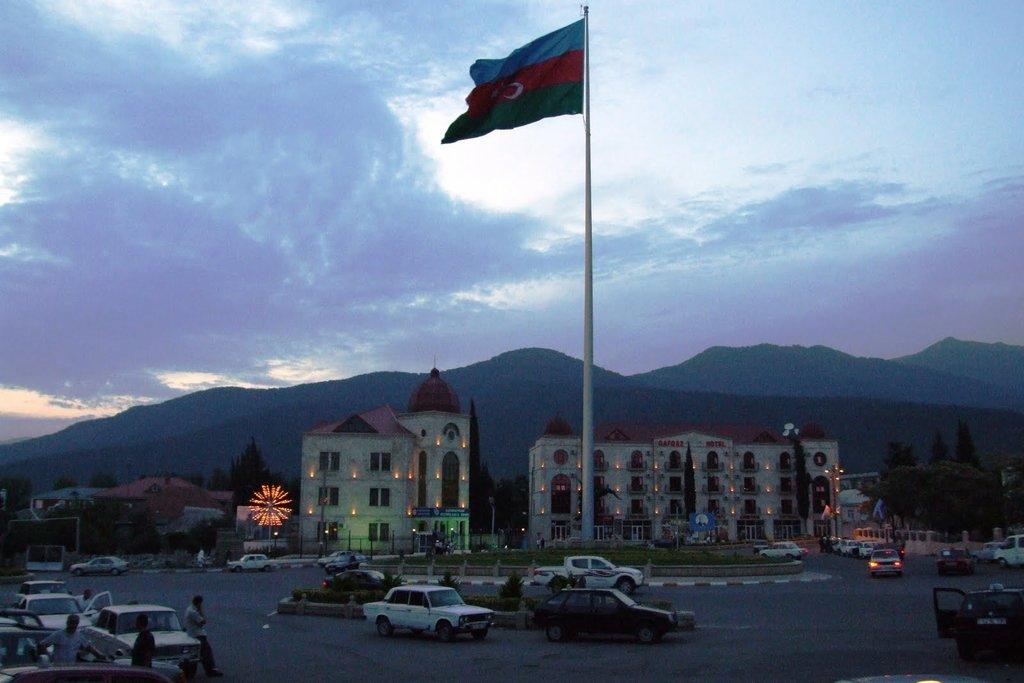
ZAGATALA district is located on the slopes of the Greater Caucasus, in the north-western region of our republic. The region is bordered by Russia on the northeast side. Relief of the region is mountainous and lowland, the climate is cold in mountains and hot in Plains. There are a lot of forests in the district, but they are mainly located in the mountains and in the foothills. Flora of Zagatala region is rich with different valuable tree species — chestnut, walnut, hazel, oak, hornbeam, elm and etc. Fauna is represented by deer, mountain goats, wild boars, bears, wolves, hares, as well as many species of birds — girgovul, partridge, mountain hawk, hawk, turaj, jackdaw, and nightingale.
In 1929, « ZAGATALA » State Reserve was established here on the southern slopes of the Greater Caucasus Mountains. With an area of 23.843 hectares, the Reserve is located at an altitude of 650-3646 meters above sea level and covers the territory of both Zagatala and Balakan districts. On the territory of the reserve there are suitable places for rest and overnight stay of tourists. Near the village of QAS, there is a lot of snow in winter.
Along with Azerbaijanis, representatives of ethnic groups of other nationalities — russians, avars, lezghins, tsakhuolar, tatars, ingiloys — about 20 people live here peacefully.
The historical monuments of the district are located in villages that have been preserved from the most ancient times to the present day. Mosques of the 18th century in the villages of GEZBARAH and Halal, two towers of the 14th century in the village of Kebeloba, a tower of the 12th century in the village of Mazykh, a Pari tower of the 5th century in the village of Upper Chardakhlar, a KINGAZ tower of the 14th century in the village of Ker and the district Museum of Local History, an Albanian tower in the village of PASHAN (13th century) and an Albanian tower in the village of Akhahdar (12th century), Aliabad and Mosul in preserved mosques built-in in the 19th century.
Tourists like to visit the village of JAR, which is located 6 km northwest of Zagatala city. In addition to being a beautiful corner of the local nature, the village has preserved its original architectural, construction, and living traditions inherent in this region.
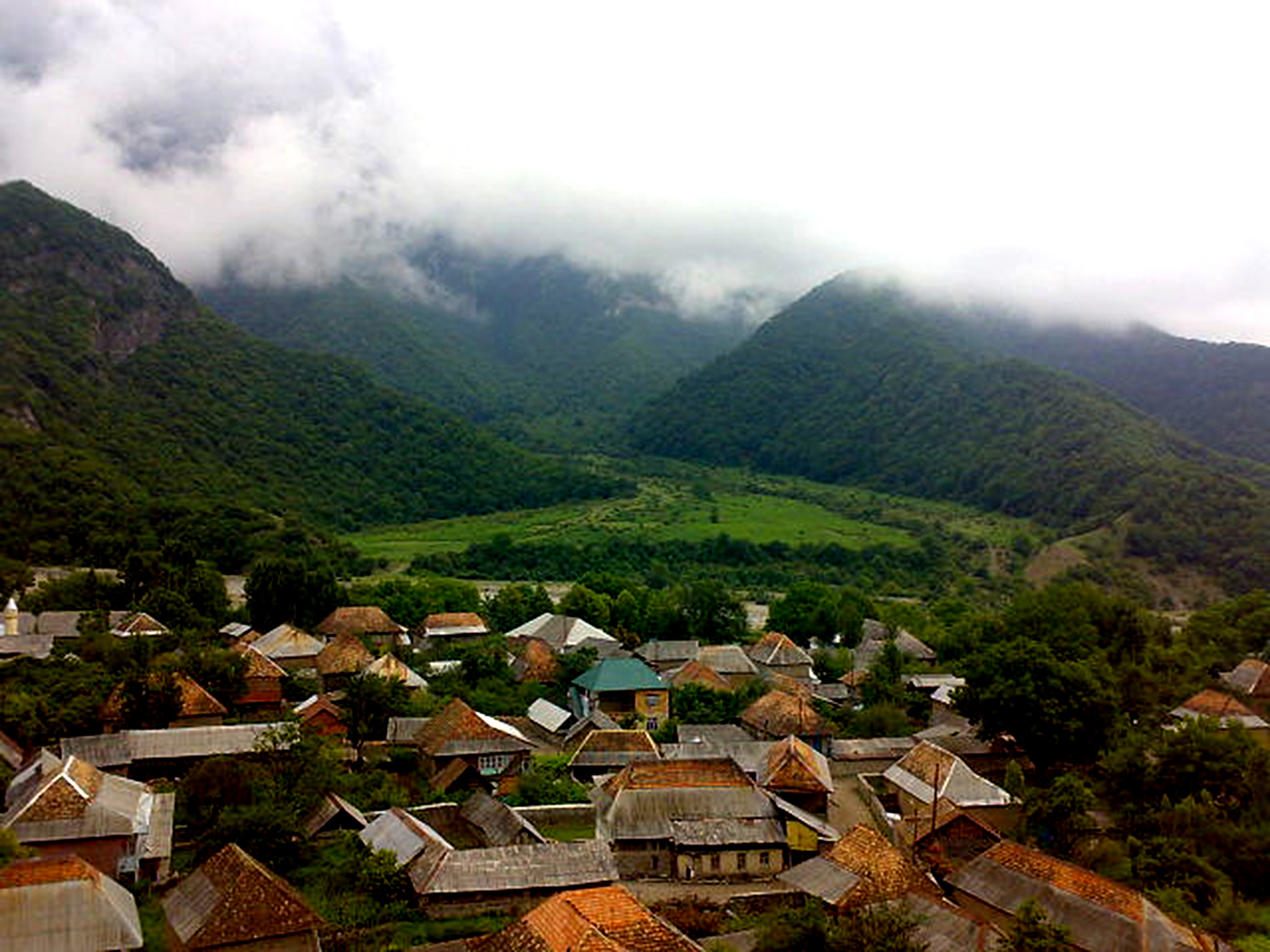
ZAGATALA city, the administrative center of Zagatala region, is located on the Bank of the TALACHAY River at an altitude of 535 meters above sea level. The distance from Baku is 372 km.
This city deserves to be called a real resort due to its climatic characteristics and beautiful nature. There is a park of culture and recreation on an area of 15 hectares, an interesting natural monument — the 800-year-old plane tree is also located here.
The ancient castle in the city (1830) is interesting not only because of its antiquity but also because it imprisoned the sailors, who once rebelled in the armored grief « POTYOMKIN ». A monument to S.Demashko was erected in the local park. The monument to Sevil Gaziyeva, the first woman in Azerbaijan who was driving a cotton-harvesting machine, is also interesting.
A rich collection of medieval manuscripts has been collected in the History-Ethnography Museum in Zagatala city.
Another interesting Zagatala monument is the Armatai fortress, which is associated with the legendary hero Prometheus. The city has an ancient fortress built-in 1830. There is a museum of history and local lore with a rich collection of medieval manuscripts in Zagatala. Lodging is available in « Zagatala Hotel », « Turgut hotel », « Salamander Cottage ».

Located in the north-east of Azerbaijan, BALAKAN district shares borders with Georgia in the south and West, with Russia in the North and East.
The relief of the region is distinguished by contrast: mountains and plains replace each other here. In the plain regions mild-hot, dry in winter, in the foothills-mild-hot, with regular distribution of precipitation, in the mountains-cold humid winter (average annual humidity level is more than 40%).
There are many mountain rivers, a beautiful lake near Mountain Katekh, and in the north of the district, the area is covered with forests. More than half of the territory of Zagatala Reserve is located in the Balakan district. In 1929, « ZAGATALA » State Reserve was established here on the southern slopes of the Greater Caucasus Mountains. Now, with an area of 23,843 hectares, this reserve is located at an altitude of 650-3646 meters above sea level. According to the nature of its vegetation, this reserve can be divided into mountain-forested (67.4%) and mountain-meadow parts. The flora of the reserve includes more than a thousand, including rare plant species (hornbeam, alder, oak, walnut, chestnut, acacia, more than 30 species of medicinal plants). The fauna of this region is also rich. It should be especially noted the widespread here of the black-colored Caucasian forest cock.
There are many historical and architectural monuments in the region. Archaeologists have discovered many ancient human settlements belonging to the early Iron Age. For example, 2 km from the village of MAHAMALLAR there are traces of early Iron Age human settlements in Nokho cave near the rock of navel. There, near the village of MAHAMALLAR, there were also graves of pitchers (II-I centuries BC), remains of a sanctuary and residential buildings (V-VIII centuries), a mosque (XVIII century), a tower (XIX century), fortress walls.
There are underground water reservoir of XVIII century and MASCHID in GULLAR village, mausoleum of XIV century in Tulu village, temple of XIV century in Hanifa village, temple of XVI century in XALATALA village, Albanian temples in Hanifa and MAZIMCHAY villages, fairy Tower of XII century in GULLAR village, GUMBEZ River Bank, city of Early Middle Ages in MAKHLAKAN mountain.
The administrative center of the Balakan district is BALAKAN city. The distance from Baku is 394 km. Mosque building belonging to XVII-XIX centuries, which caused interest due to the unusual height of its minarets is preserved in the city.
In the local museum of the region, traditional art items for this region, archaeological finds showing the Neolithic settlement of this region, and other exhibits allowing to follow the events related to the history of the region have been collected. The professions of coppersmithery, shebeke (making patterned wood frames for doors and windows), wood carving, and pottery are well developed in Balakan. TEKELDUZ embroidery, which is rarely found in Azerbaijan, has been preserved here (it is called The Art of sewing fantastic silk thread patterns on Tekelduz — dark background).
Balakan has a large city park with an area of 7.5 hectares. After a walk in the city, you can relax in this park.
The variety of flora and fauna of the Balakan region creates useful prospects for the development of Tourism. 12 tourist routes and recreation areas have been identified in the region. In the Balakan region, mainly sports and rural tourism are developing. Most tourists who visit the region prefer this type of Tourism. The city has a great culture and recreation Park with a cable car. Here you can stop at » Gubek Hotel », « Elite Saray Hotel ».
SOUTH ROUTE: BAKU — SALYAN — BILASUVAR — JALILABAD — MASALLI — LANKARAN — LERIK-ASTARA
SALYAN
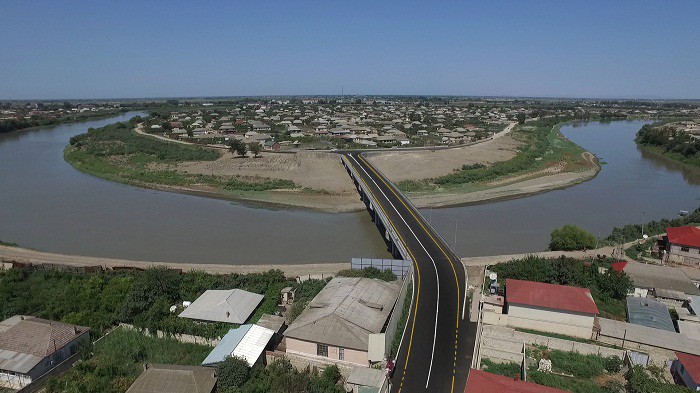
SALYAN district is located in the south-east of Azerbaijan, LANKARAN-ASTARA region inhabited since ancient times, distinguished by unique cultural and historical traditions, unique plant world, long-lived inhabitants, unique cuisine with fish dishes.
Salyan region is in some sense the Gateway of this region — the transport arteries of the Republic, the highways and railways linking Azerbaijan to its southern regions, as well as the countries of the Middle East are located here.
In very ancient times, various tribes settled here, in the ancient times they replaced each other and became one of the components of the ethnogenesis of the Azerbaijani people. One of these tribes was called « sal ». The city of Salyan also got its name from this word.
One of the main rivers of the Republic — Kur river flows through the territory of Salyan region. The eastern part of the region joins the shores of the Caspian Sea. Its location close to the sea and river conditioned the features of the National kitchen of the inhabitants of this area.
« Shirvan » national state park is located here (in 2003 the reserve of the same name was reorganized and turned into a national park). The Reserve itself was established in 1969 in order to preserve and propagate the typical plant complex of Shirvan lowland (the territory distinguished by semi-desert and wet-swamp ecosystem). « BANDOVAN » reserve located here was established in 1961. The reserve covers an area of 30 thousand hectares and occupies part of the territories of two administrative districts — Salyan and Garadagh. The Reserve was organized to protect gazelles and waterfowl and restore the number of heads.
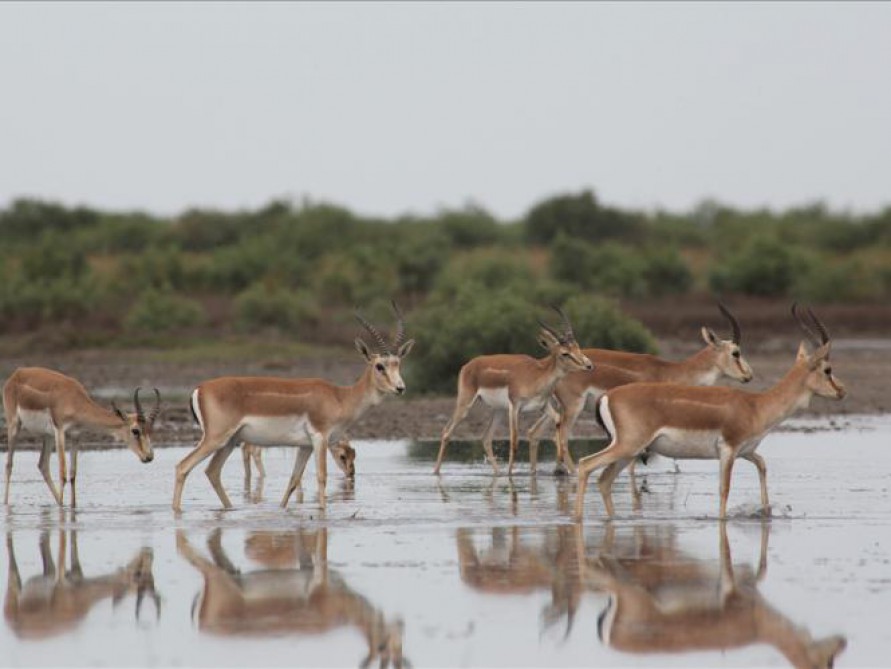
This region is also interesting from the point of view of archeology and preserved historical and architectural monuments. A number of objects related to the Middle Ages were discovered here in 70-80s of XX century.
There are a number of archaeological sites in this region covering the period from the Bronze Age to the early Middle Ages. Among them, the marimli Necropolis, the necropolis of pitcher graves in kursengi village, the ruins of ancient human settlements in the villages of present NOKHUDLU and MAHMUDABAD should be particularly noted.
At a distance of 5 km from the district center, one of the numerous mud volcanoes of Azerbaijan is BABAZANAN volcano. The healing properties of mud erupted from this volcano still attract local residents.
There is another mud volcano near the Sea coast in the area called DASHGIL, which is less than reaching salyan. The dashgil Reserve is also located here. It is a suitable place to hunt waterfowl, caspian kutum, carp and other fish species living in the Caspian Sea.
SALYAN city, the administrative center of Salyan district, is 126 km from Baku. The ancient mosque belonging to XIX century here is an architectural monument guarded by the state. At present, travelers and tourists coming here can use the services of a modern caravanserai. Here you can taste the dishes of the local ancient Azerbaijani cuisine.
Visitors to Salyan can stay at “Kur” hotel located in Salyan city.
BILASUVAR
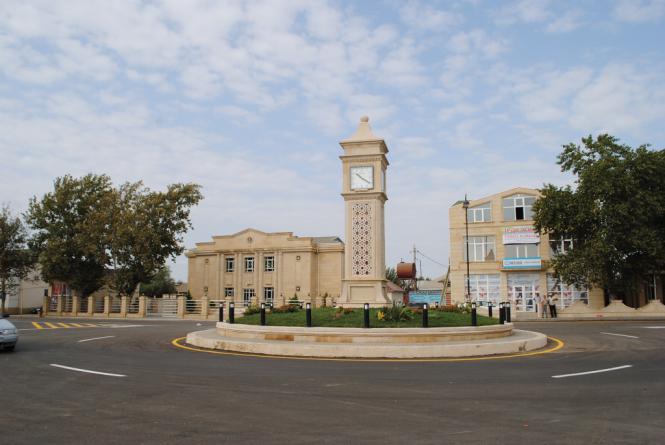
BILASUVAR district borders on Iran in the West. The climate here is semi-desert and dry desert climate. Features of climatic conditions have developed here cotton-growing, grain-growing and cattle-breeding. According to one hypothesis, the name of this region is connected with the search for water – the meaning of the word « Bilasuvar » means « there is water here ». Another version is that this name is associated with the presence of people who managed to find water in the desert. According to this version, « Bilasuvar » means a person who knows where to get water.
As in the whole territory of Azerbaijan, the territory of Bilasuvar district has been a human settlement since the earliest times. This is confirmed by numerous archaeological finds and remains of architectural monuments discovered in the region. CHOL AGHDAM, ICHERI AGHDAM, TORAGAYLI belong to ancient times and early Middle Ages. Unfortunately, most of these archaeological objects have not yet been studied.
BILASUVAR is a small town. It is located 182 km from Baku. Visitors to the city can stay at”Zirve Hotel ».
JALILABAD
JALILABAD region is located on the border of Kur-Araz lowland. The climatic zones here begin with a temperate hot climate where precipitation is distributed almost regularly, ranging from semi-desert and dry steppe climates typical of summer drought. The rivers INCACHAY, BULGARCHAY, MISHARCHAY, GOYTAPACHAY flow from the territory of this region. The intensive development of viticulture in this region is associated with the climatic and relief features of the region. The territory of Jalilabad district is a great place for hunting. Approximately 14.7 thousand hectares are covered with forests. In the hunting farm « ZAVVAR » you can hunt water birds. The fauna of the region was represented by wolves, rabbits, badgers, boars, foxes, wild ducks, geese, eagles, turaj and other creatures.
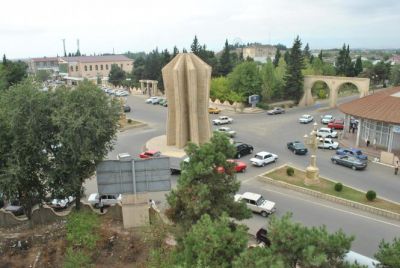
The administrative center of Jalilabad district – JALILABAD city is located 208 km from Baku. Archaeologists have discovered an ancient city called HAMSHAHRATAPA on the outskirts of this city and carried out excavations there. As a result of excavation, objects of material culture of the Eneolithic period were found. According to scientists, in the early Zoroastrianism, one of the ARI tribes – the famous tribe of mags-lived here. Representatives of the tribe of mags, according to tradition, became priests of this ancient religion and joined the ranks of its supreme priests caste. They have mastered the secrets of Medicine and Zoroastrian Astrology. These people were so skillful that over time, the name of that tribe became a special name and fell into the form of « Magic ». In the small hills of HAMSHAHRATAPA, there were found products for making KHAOMA, which is considered a pre-Zoroastrian drink, for household items and religion of Zoroastrianism.
Numerous burial mounds, urban areas, human settlements and necropolises were found in the territory of the region. The period of their creation covers the time period from the Bronze Age to the early Middle Ages.
The city was originally called KHASILI. Then, his name was changed to ASTRAKHANBAZAR. The present name of the city was given in honor of JALIL MAMMADGULUZADE, founder and irreplaceable editor-in-chief of « MOLLA Nasreddin » magazine, the first satirical journal in the East.
There is a small museum of local lore, a park and a hotel in JALILABAD.
MASALLI
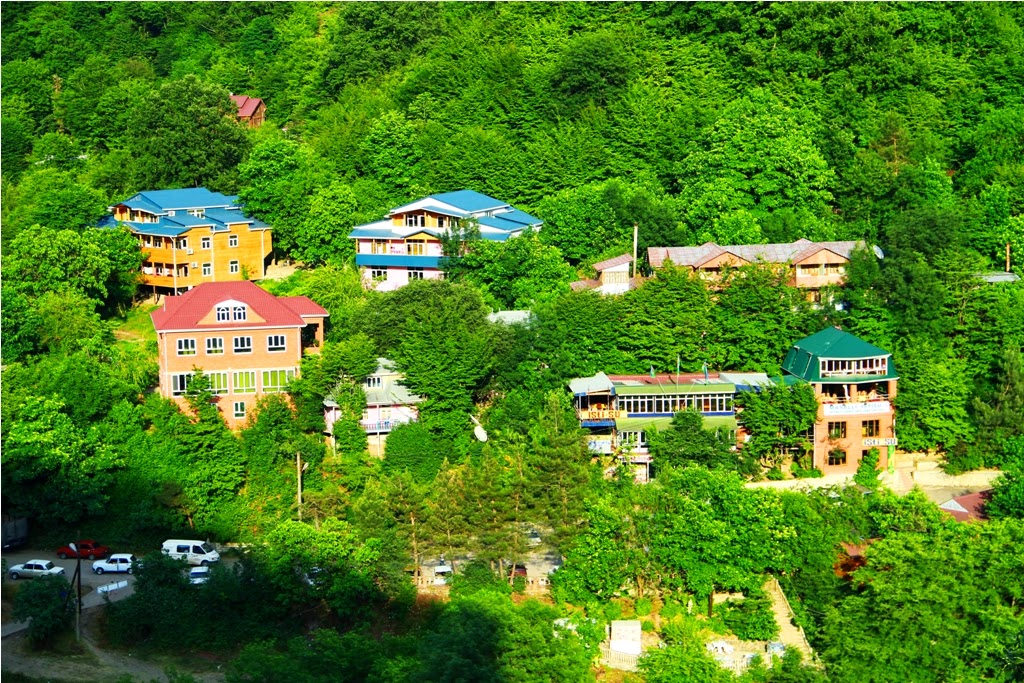
MASALLI district is located on the main transport artery of this region – the main road from the capital of Azerbaijan to the south, towards Iran. One of the borders of the region is the coast of the Caspian Sea and the other is the Talysh mountains. VILASH, ALVADICHAY and TATYAN rivers flowing through the region flow into the Caspian Sea.
Masalli region is rich in mineral water springs. Among them are those that are thermally watery, as well as those that are chosen with cold water, such as ice. The water of some Springs contains a lot of sulfur and other microelements. ISTISU mineral spring is located in one of the picturesque mountain corners of the region. The water of this spring has healing properties. There are those who come here to be treated, and those who come to rest. Thermal water falls and suspension bridge give these places special beauty. Istisu, which is a multi-porular healing mineral water, is sold in pharmacies of the country.
MASALLI city, the administrative center of masalli district, is located 230 km from Baku. In the past, A Tribe Called « Masal » lived in these places. This name engraved in the memory of the people conditioned the modern name of the city. In the valley of Masalli there is a small picturesque lake in the forest. This is a favorite place of rest for both local residents and guests of the city.
Historical and architectural monuments in Masalli City are represented by the mosque built in XIX century, ancient bath-house, ARKIVAN tower and the building of the museum of local lore.
Along the road from Masalli to Lankaran, on the south-western coast of the Caspian Sea (GIZILAGAJ Bay) GIZILAGAJ Reserve is located. The territory of this reserve covers the entire water area of the Bay, as well as nearby dry areas. The reserve was established in 1929 with the purpose of protection and reproduction of wetlands and wild birds, protection of water and semi-desert natural complexes which are wintering places for migratory birds. Among the 248 species of birds and 54 species of fish living here are also species included in the Red Book.
LANKARAN
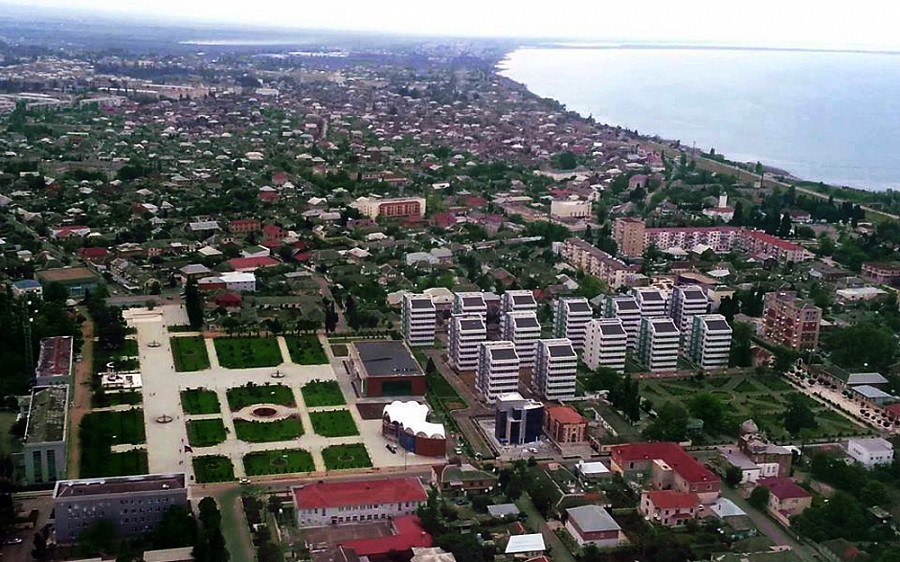
The territory of Lankaran region covers the eastern coast of the Caspian Sea and the entire Lankaran lowland in the part up to Talish mountains. There are many comfortable sandy beaches on the shores of the Caspian Sea here. Humid subtorpic climate, harsh winter conditions, dry and hot summer days and rainy autumn conditions the rich flora and fauna of this region. LENKERANCHAY, VERAPVUL, GUMBASHI, BOLADI rivers flow mainly due to rain water in spring and autumn, in summer they calm down and become noticeably sloping. Therefore, in order to irrigate agricultural plants in this area, Khanbulanchay water reservoir was created.
Lankaran is another important agricultural region of Azerbaijan. Its specific climatic conditions led to the cultivation of subtorpic plants with tea mandarin, persimmon, feijoa and several types of lemon. The famous lankaran tea is not inferior to the classic Indian tea in its quality and aroma.
It is no coincidence that masters of skillful carving grow here. After all, this region is rich in unique tree species, including rare and endemic species. The famous iron tree, propka tree, velvet beech tree, buxus hyrcana pojark tree, silk acacia, oak, eucalyptus and broad-leaved Oak, which are considered the main forest tree of Talysh Mountains, is a kind of symbol of these forests. In addition, many wild fruit trees, medicinal herbs and shrubs grow in Lankaran forests. Therefore, it is not surprising that two reserves and one reserve have been created in the territory of Lankaran district.
« GIZILAGHAJ » Reserve is located in the Gizilaghaj region on the south-western coast of the Caspian Sea. The territory of this reserve covers the entire water area of the greater Gizilagaj Bay, the northern part of the lesser Gizilagaj Bay, as well as nearby parts of the coastal zone. it was created in 1929 for protection and reproduction of wintering and migratory water, wetlands and wild birds. There are 248 species of birds and 54 species of fish here.
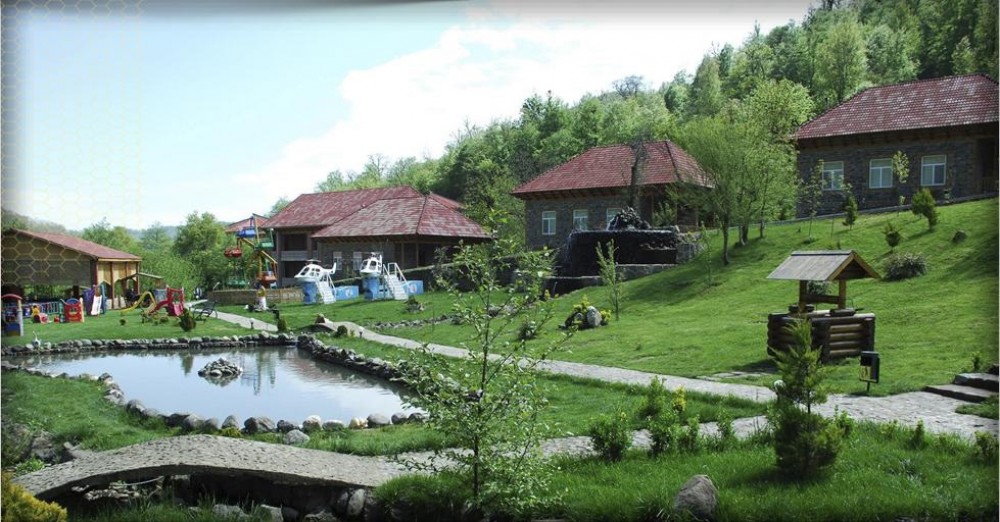
HIRKAN Reserve, which covers an area of 21,435 hectares, is also located in this region. In 2004, the Reserve was transformed into HIRKAN National Park. The National park occupies a part of the territory of Astara and Lankaran regions. The small Gizilaghaj reserve (an area of 10.7 thousand hectares) was established in 1978 in order to protect and restore the head number of birds wintering in the Gulf of Gizilaghaj, living in migratory water, wetland and around the water area, as well as rare and under the threat of destruction. This reserve borders directly with Gizilagaj Reserve.
The administrative center of lankaran district is the city of Lankaran. The distance from Baku is 268 km. Favorable geographical position of the city fertile land natural resources have always attracted people here. Lankaran is located in the south-east of the country, on the Bank of the Lankaran River. They think that the city was built here, near the sea, about 300 years ago. Initially, a fortress equipped with guard towers was built, a lighthouse was built. The first name of the city was « LANGARKUNAN ». The meaning of this word is anchored parking, which means a port.
The Khan’s House, Kichik gala mosque, Guldeste minaret and ancient Haji Mirza Hamam attract the attention with original facade patterns among historical architectural monuments in lankaran. If you visit the Museum of history in the city, you can get acquainted with the history of this land. The building of the museum itself is also very interesting from the architectural point of view. There are many decorative and applied art workshops in the city. There, freckles are engaged in the art of carving on wood, stone and metal. The first performance of the theater in lankaran was in 1850, and the profit from it was fully distributed to the local poor. The glorious military commander-General Hazi Aslanov was born and lived in this city. Now a museum exposition has been opened in the house where he was born.
The city has various high-end hotels and cottages, such as AB QALA, GIZIL TAJ, CAUCASAS SEASIDE, XANBULAN, Khan Lankaran Hotel.
LERIK
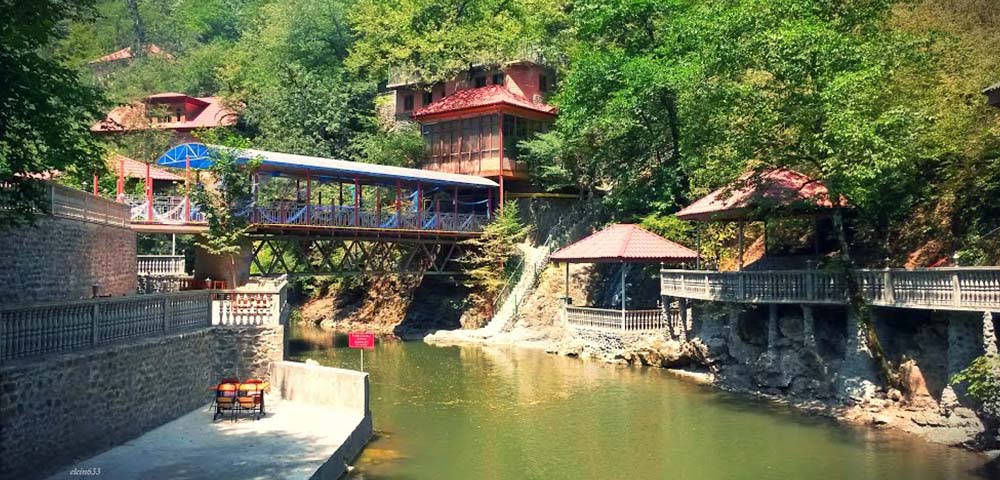
One of the most beautiful corners of Azerbaijan, Lerik rayou is located in the lap of Talish mountains. The beautiful nature of this place, the aroma of the forest, mountain air, springs, rivers and fertile soil make the inhabitants of this land long-lived.
This region has its own unique history, which reflects the most interesting moments of the complex history of the whole of Azerbaijan. Numerous cultural and historical monuments proving that this region was inhabited in the Neolithic period remained in Lerik region. For example, there is a stone cave-like Camp, an ancient Gizyurdu settlement located near the mountain village of MISTAN at an altitude of about 2430 m above sea level.
Baba Hasan mausoleum near Conu village, Baba Isa mausoleum in Mondigah village, Khoja Seyid mausoleum in Khanagah village (XIV century), Pir Yusif mausoleum near Kekonu village, Jabir mausoleum on the side of road to Jangamiran village (XII-XIV centuries) and Khalifa Zechariah mausoleum are guarded by local residents and prostrated to old and old trees in the area of those mausoleums. At one time, Aleksan Dumas visited the village of Jangamiran, and later in one of his works he poetically described the fate of one of the women living in this village full of heroism.
The original mosque built in XIX century in the village of Lulakaran remained intact. The storage of aries figures made of stone in a number of villages of the district is also remarkable fact.
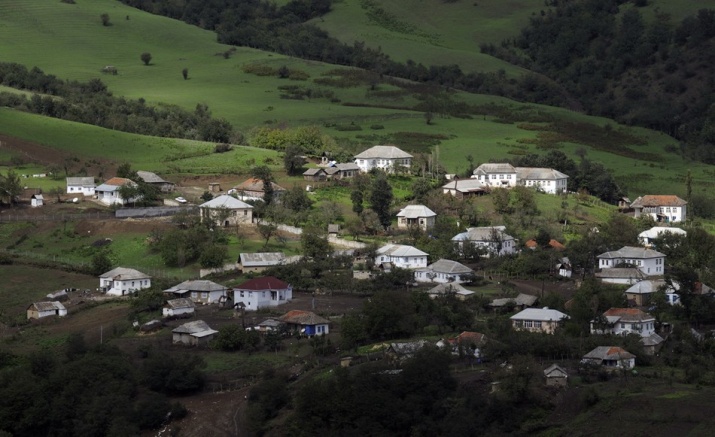
As mentioned above, Lerik region is famous as land of long-livers. For example, the resident of this region SHIRALI MUSLUMOV (1812-1975) had an active lifestyle for 163 years and set a world record for longevity. Another resident of the region MAHMUD EYVAZOV (1808-1958) lived for 150 years. Today there are dozens of people living in Lerik who have passed a century of age but have not lost their ability to work.
Carpet-weaving from folk art types, making of various household items from wood, as well as pottery art developed more in the region. The special feature of carpet weaving here is that these carpets are woven not in traditional vertical looms, but in horizontal looms located directly on the floor.
The administrative center of the district is Lerik city. Lerik city with distance of 325 km from Baku is located at the foot of Talysh mountains, in fertile plain area. Here you can go to the museum of history and local lore and look at the memorial in memory of the victims of the Karabakh conflict.
In Lerik it is possible to go to the apartments of local residents, as well as in such popular recreation areas as « Relax Hotel and Resort », « Shelale » and « Meshachi ».
ASTARA
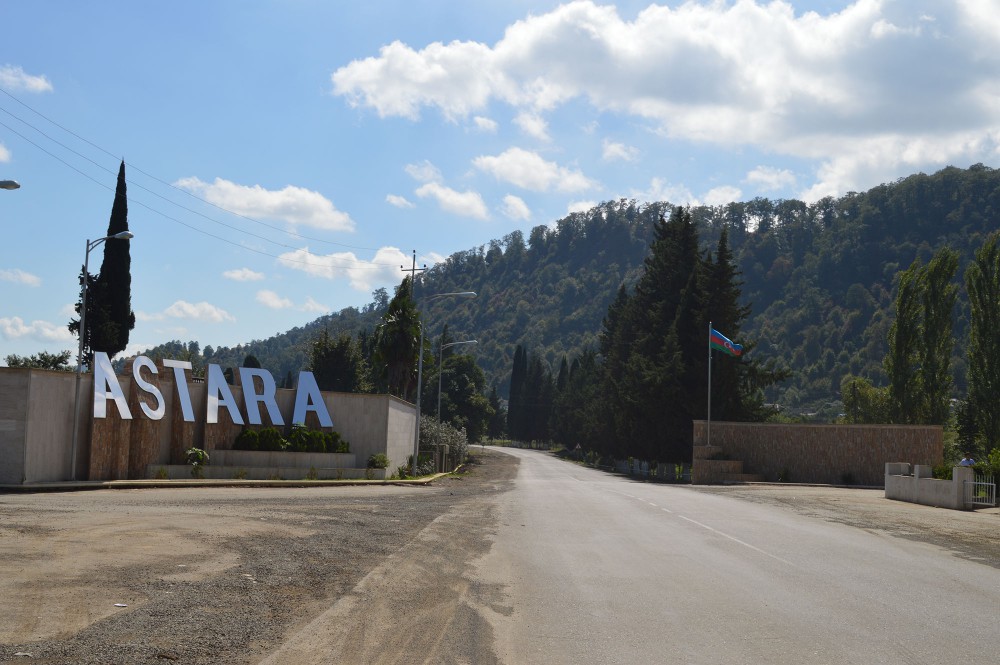
Astara district is located in the south-east of Azerbaijan on the border with Iran. Part of the territory of the region is occupied by Talysh mountains. This is due to the specific climatic conditions of this region.
Area of forests 37. It is about 000 hectares. The rivers Astarachay and Tangerud, originating from the peaks of Talysh, flow into the Caspian Sea. The plant world of Astara is rich and diverse. Wild quince, medlar, hawthorn, blackberry, silk acacia, evergreen coniferous plants, as well as representatives of linanas family grow here. The famous iron tree, which looks at the water because it is very heavy, ends here. From ancient times, local residents made knitting looms from this tree and some details for looms used in the textile industry in modern times.
The flora of the region is also diverse. In Astara forests roe deer, wolves, wild cats, deer and other wild animals live freely. On the shores of the Caspian Sea there are many beaches with clean and clean waters.
Part of Hirkan National Park is located on the territory of this district. This fact attracts environmental tourism lovers to Astara. There are many therapeutic mineral water springs in Istisu area near the Iranian border. Tea-growing and vegetable growing are widely developed in this region. Citrus plants are grown.
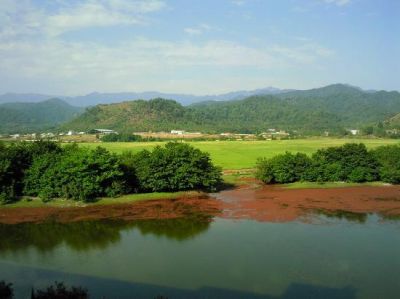
There are numerous (about 400) historical and architectural monuments in the region. It is possible to say that in every village there are traces proving human life from ancient times. For example, in the village of Shindan there is a tower. It is called the tower of Babek among the people. The tower in Nudis village, Meshadi Abutalib bath in Pensar village, Haji Teymur mosque and Haji Jahanbakhish mosque, mausoleum in Shahagaj village, Karbalayi Hamid Abdulla bath in Archivan village are among them. There is a well-known sulphurous spring in this village. When a match is drawn close to the water of this spring, the water gets on. Remains of Castle in the village of Goygol settlement, mausoleum of VII century, caravanserai, stone sculptures of Stone Age and Bronze Age, bridges of XIII century in Siniyapert, Lomin and Pilakan villages still remain.
Astara is the administrative center of Astara district, located 322 km from Baku. Astara, which is an important transit point on the Baku-Tehran highway, is a small border town with the Sea on one side and the Talysh mountains on the other. Paddy fields around the city attract attention. Fishing here is also widely developed – no event was able to change the characteristics of the local national kitchen.
The exposition of the museum of local lore in Astara is quite rich. In addition to ancient coins minted in different periods and confirming the formation of trade in this region in ancient times, a statue of man sculpted from stone is kept in this museum. The age of this statue is more than 2000 years.
Visitors to the district can stay in the apartments of local residents or in the hotel « Espinas Hotel ».
WESTERN ROUTE BAKU — HAJIGABUL — KURDAMIR — MINGACHEVIR — YEVLAKH — TARTAR — NAFTALAN — GANJA — GOYGOL — DASHKASAN — SHAMKIR — GADABAY — TOVUZ-AGSTAFA-GAZAKH
HAJIGABUL
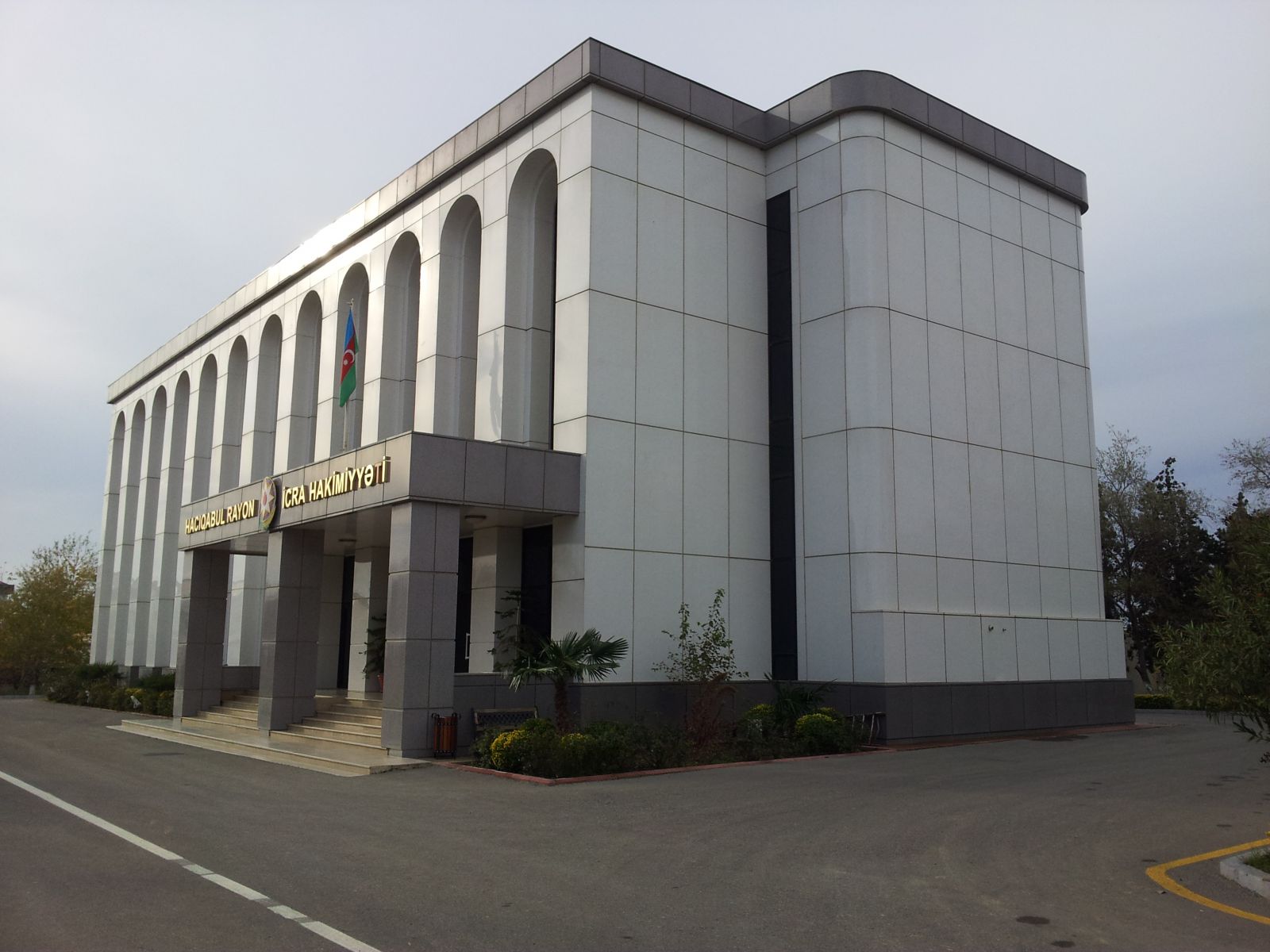
Hajigabul District of HAJIGABUL region occupies part of the fertile ancient Mugan land in the Kur-Araz lowland. Climate is semi-desert, dry and hot, winter is mild. HAJIGABUL lake created as a result of natural laying of the Caspian Sea in a certain geological period is in the territory of this region. Water area of the lake has been expanded as a result of flooding of Kura River in spring time. The hot waters of the State Power Station of Ali Baryamli (DRES) are also entering this lake. This lake, whose depth does not exceed 5 meters, does not freeze in winter. It is of great importance as a suitable place for wintering migratory birds and nesting of waterbirds. Many of these birds belong to rare species that have reached the limit of extinction.
Carpet weaving has been widely developed here since ancient times. The tradition of weaving handmade carpets called « yellow carpet » of Shirvan school is still going on.
The administrative center of the district is HAJIGABUL city, 113 km from Baku. The meaning of his name is « May God accept your pilgrimage ». The visit of Muslims to the holy cities of Mecca and Medina is called « pilgrimage ». A person who has made a pilgrimage is awarded the honorary rank of « Haji » and this word is added to the beginning of his name. In essence, the pilgrimage is a complex of spiritual concepts and includes requests for mercy from God and various repentance. Therefore, from the name of the city of Hajigabul it is known that this place was not only a place for trade caravans, but also a place for pilgrims. Sometimes pilgrims went by caravans, and some pilgrims vowed to go to the pilgrimage on foot. There were caravanserais here to welcome both pilgrims and merchants traveling to the gulf region of Iran.
In XVII century Shah Abbas built a large caravanserai near Hajigabul Lake, and during the rule of the Safavid dynasty a city was built and at that time this city was called Mahmudabad. Later this name was forgotten and the city began to be called Hajigabul again. However, 5 thousand years ago people lived in this area — archaeologists have discovered the remains of cyclopean buildings on Mount HARAMI in the north-west of the city. Petroglyphs on the walls of these buildings attract attention. Images of people and unusual, fantastic animals were found on the stones near him. Scientists assume that this object originated in the Eneolithic period. Other historical and architectural monuments remain near Hajigabul. Pir Huseyn khanagah in gubali Baloglan village includes an ancient minaret mosque, fortress walls, caravanserai, residential buildings (XIII-XIV centuries), mausoleum of Sheikh Hussein lived in XI century (this mausoleum built in honor of Sheikhin was erected two centuries after his death), as well as an ancient bridge (XVII-XIX centuries). It is considered to be one of the best in the Muslim East. At present, some of them are kept at the State Hermitage in St Petersburg and the Literature Museum named after Nizami Ganjavi in Baku. The early medieval defense tower remained intact in Udulu village. From the name of this tower it is seen that the people who defended there were determined not to compromise the enemies until the last breath.
KURDAMIR
The center of the region is Kurdamir city. KURDAMIR district is located in Shirvan, the historical region of Azerbaijan, in the north-west direction from Baku. This fertile and beautiful land is very attractive for tourism and Recreation. Sometimes they call it Gulustan.
Summer in Kurdamir is hot and arid. Climate is considered a desert climate. The animal world of the region is diverse — Wild Boars, wolves, foxes, jackals, pheasants, turaj, wild ducks and geese live here. The vineyards of this land are very popular. The most famous grape variety is called » Shirvanshahli ». Kurdamir district has also been named by its traditions of carpet weaving. The most popular type of local carpets in the world market is the « Shilyan » carpet. This carpet is woven in the village of the same name near Kurdamir.
KURDAMIR city, the administrative center of Kurdamir region, is located on the Left Bank of Kura River, 189 km from Baku.
YEVLAKH
The center of the region is Yevlakh city. Yevlakh district is located on the Right Bank of the river Kura and is one of the major cities of the region called GANJABASAR (formerly called Ganja Khanate) among el. Ganjabasar region covers several regions of Azerbaijan. These regions are united by their common historical and similar geographical-climatic conditions.
YEVLAKH city, the administrative center of yevlakh district, is located 280 km from Baku. Yevlakh is located at the intersection of many roads. Direct roads run from here to Mingachevir, Sheki, Balakan, ganja and Khankendi cities. It is no coincidence that Yevlakh was called « the gate of Karabakh » in the written sources of XII century. Both caravans and travelers passed through these » gates » and drove the flocks of sheep to summer pastures – plateaus, located in Alpine Meadows. A number of archaeological objects related to Bronze Age and early Middle Ages were discovered in Garamammadli, Garanmanli and Khaldan villages of Yevlakh.
MINGACHEVIR
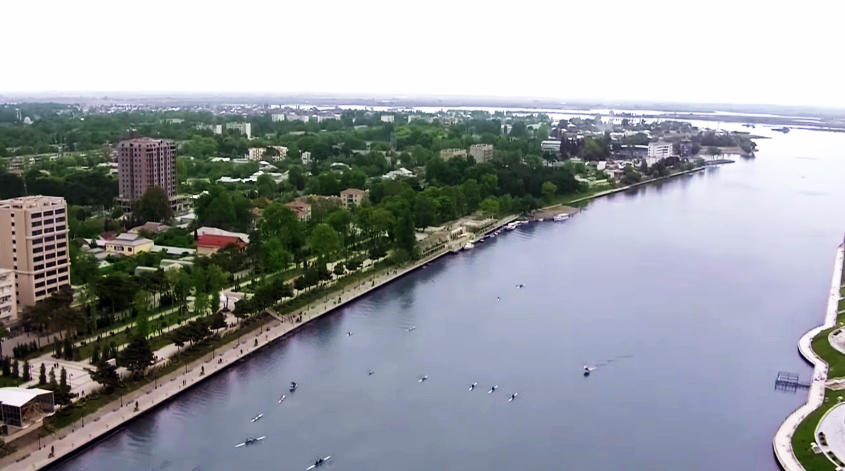
Mingachevir, one of the youngest cities of Azerbaijan, was founded in 1945. Today, this prosperous city, located on the picturesque Bank of the Kura River, is not only the main center of the energy sector of Azerbaijan (65% of all electricity produced in the country is here), but is also of great interest in the development of tourism.
Mingachevir is also known as a sports center. Most of the time, a number of athletes from around the world come to the famous Kura Olympic sports — training center to train. It is worth coming to Mingachevir to eat at least delicious Kura fish, swim on its transparent beaches and take a walk on the boat.
Although the modern city of Mingachevir was established due to the construction of the Mingachevir hydroelectric power station, people lived in the surrounding fertile lands for many years and settled in the Kresahili areas.
Two settlements and 4 large Cemeteries discovered in the south of the Bozdag Ridge and on the Kura Coast are considered the largest archaeological complex in the South Caucasus. About 20,000 samples of material cultural heritage belonging to III-II Centuries BC were found during excavations. The basis of the exposition of the Historical Museum of the city was many topics.
Glassware, gold and silver, jewelry, coins, a number of objects belonging to ancient Eastern cities during archaeological excavations show a high level of development of trade and cultural relations in Mingachevir. In the medieval period, this city is marked as the center of jewel shops, shopping shops, baths. In Soviet times, there was a boarding resort, where during the season a large number of tourists from all over the country rested
The density is observed on numerous beaches today. You can stop at » Kur Hotel », » Agsaray Deluxe Hotel & SPA », » River Side Hotel ».
TARTAR
The center of the region is the city of Tartar.
Fertile land of Karabakh is one of the most ancient regions of Azerbaijan. The famous Karabakh Khanate, formerly the central city of Shusha, was located here. There are many historical and architectural monuments, rich fauna and flora in this land. One of the most colorful types of Azerbaijani carpets, the Karabakh carpet was created here, and the famous Karabakh horse breed was grown here. This land, which has such a rich natural condition, has endowed the Azerbaijani land with many talented poets, writers and musicians. The most famous singers-mugham performers (mugham — the national music genre of Azerbaijan) originated from Karabakh. Mugham melodies are the basis of the National opera of Azerbaijan. Unfortunately, today Karabakh has been occupied by Armenians.
Tartar region is located in the lower reaches of the Terterchay, it is bordered by the Incachay to the north, where in winter the temperature does not drop below two degrees, and in summer it rarely exceeds 25 degrees. The climate in the region is diverse-in some regions there is a mulafim climate, and in some places a semi-desert climate. It is due to such changeable climatic conditions that sheep-breeding has developed here. Khachinchay also passes through the territory of this district. In due time, this territory was part of Albania being one of the early state structures of Azerbaijan (Manna, media, Atropaten, Caucasian Albania). Albanians, like other Azerbaijanis, worshiped Zoroastrianism in ancient times, and later adopted Christianity.
The town is associated with enthusiastic people from to the world which having enjoyable. The city is located on both shores of Terterchay, 332 km from Baku. Here, along with animal husbandry and agriculture, they are engaged in ancient folk arts such as carpet weaving, weaving and embroidery. The city of tartar, located on the ancient caravan route, was once called Chaparkhan. There are a number of architectural objects in Tartar, Kangarli, Garadagli, Qaynaq, Azad Garagoyunlu villages of the district.
NAFTALAN
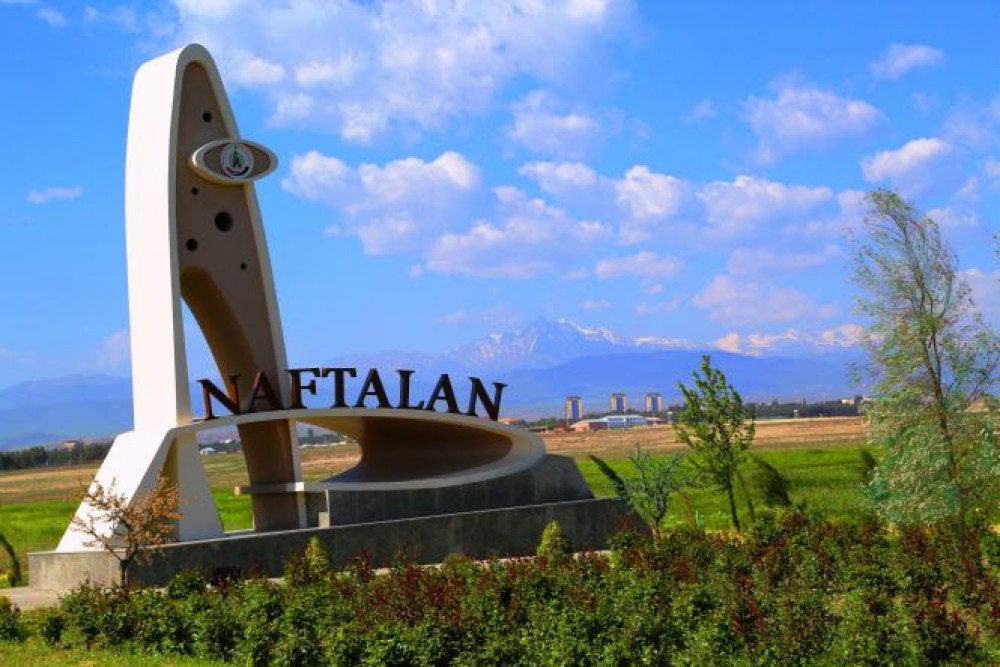
The population of the small NAFTALAN town located in the center of Goranboy region, near the city of Goranboy, is 6.500 people. Patients who come to sanatoriums and boarding houses in this resort city are treated with Naftalan oil and ointments prepared on its basis. Naphthalan oil is a very effective remedy for the treatment of wounds, skin, nervous, Urological and gynecological diseases, as well as soft tissues in the liver, joints and joints, as well as the musculoskeletal system. Naftalan city was built in the place of a small village of the same name. The word « nafta », which forms the basis of this name, means « flowing, straining » in the language of media, one of the ancient state institutions in Azerbaijan.
Several thousand years ago, along with oil, Naftalan was used for various purposes in Azerbaijan. There were not only local residents who used Naftalan oil for the treatment of wounds, but also the soldiers of Alexander The Great, who once attacked Azerbaijan, Roman legionaries and Vikings, Alans of shmchi, Khazars and representatives of other tribes used Naftalan oil for the treatment of wounds. Naftalan was also an export product. It was transported by caravan routes to other countries — Kievan Rus, Central Asia, Afghanistan, India, and Gulf countries of Iran. Marco Polo, a famous traveler of the Middle Ages, described Naftalan oil as « a magical ointment that is a remedy for skin diseases. »
When the oil industry began to develop rapidly in Baku in XIX century, the number of engineers, industrialists and bankers from Europe increased significantly in Azerbaijan. In 1874, German engineer Yager was interested in what local residents said about naftalan oil and regulated the production of « Naftalan » oil in Germany. He exported these cattle to different countries of the world. It is clear that the Germans, who produced ointments on the basis of Naftalan in Azerbaijan, were good managers, as this ointment was used not only in European countries. During the Russo-Japanese war in 1904, the pharmacy set of Japanese soldiers included jars with Naftalan ointment. This ointment was used as first aid. On these jars, it was written: « whoever has this ointment in his hand, he should not be afraid of any pain. »
Visitors can stay here « Chinar Hotel & Spa », « Naftalan » health center, « Gashalti » sanatorium, miraculous Naftalan sanatorium, « Magic Naftalan » sanatorium, etc.
GANJA
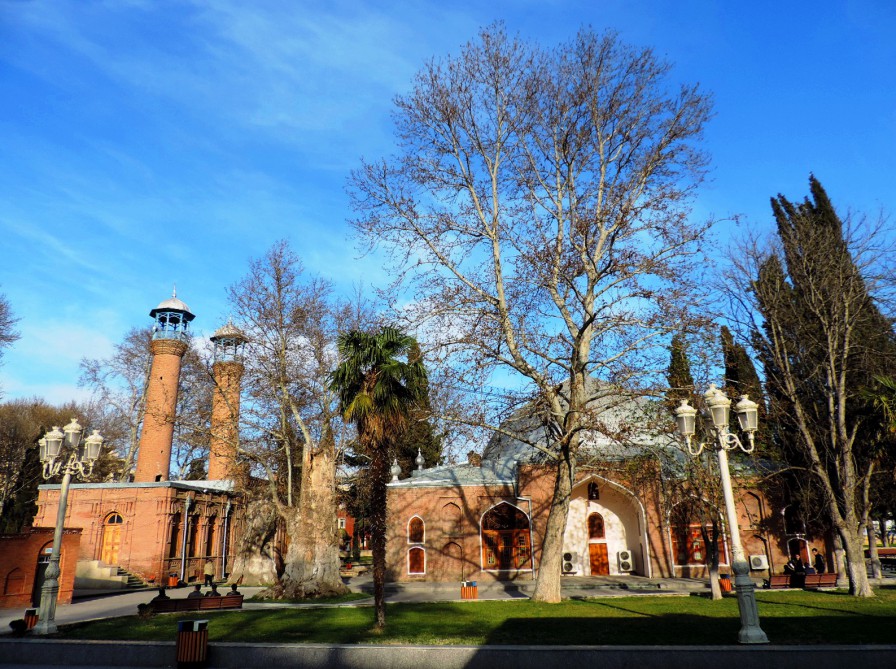
It is located on the banks of the river Ganjachay in the Ganja-Gazakh lowland. The river divides the city into two parts. Here is a kind of boundary of two climatic zones — the temperate-hot semi-desert and dry desert climate, as well as the temperate-hot climate zone. The population of the city is 302,000 people, the distance from Baku is 375 km.
Ganja is the second largest city in Azerbaijan. There are Ganja State University, Academy of Agriculture, Ganja branch of Azerbaijan National Academy of Sciences, Scientific-Research Institute of cotton growing, experimental Agricultural Station. A modern Olympic Sports Complex has been built in the city.
Ganja is the homeland of world-famous poet NIZAMI GANJAVİ, poetess MAHSATI KHANIM, MİRZA SHAFİ VAZEH. There are many historical monuments here: Juma Mosque and its Madrasa, the mausoleum of Sheikh IBRAHIM, the mosques of GIZIL HAJİLİ, OZAN, BALA BAGBANLI, SHARAFKHANLI and SHAHSEVEN, the Big Bridge and small bridge built over the Ganjachay River (XII century), a complex of caravanserais and buildings, goy kashi gumbezli IMAMZADA, and extremely beautiful ancient city baths (bathhouses now work). Visitors are advised to visit the mausoleum of Nizami Ganjavi located at the entrance of the city.
Ganja is one of the most ancient cities that played an important role in the history of our country at different times.
The Arabs called this city Janza. During the excavations in ganja, archaeologists have discovered ancient human settlements dating back to the II century BC, and around Ganja a lot of archeological objects of the Bronze Age.
The history of Ganja is the history of its destruction by the invaders almost to the ground and further progress. Foreign fighters, alan tribes, Mongols, Georgian Princes, Ottomans devastated Ganja during the Caspian-Arab wars. In the XI century, Christian head of Albanians ‘ residence in Barda was devastated and his residence was moved to Ganja. People who believed in Christian and Islamic religions lived peacefully in Ganja, and goods from Eastern countries to the Black Sea coast were transported by caravan routes passing through this city.
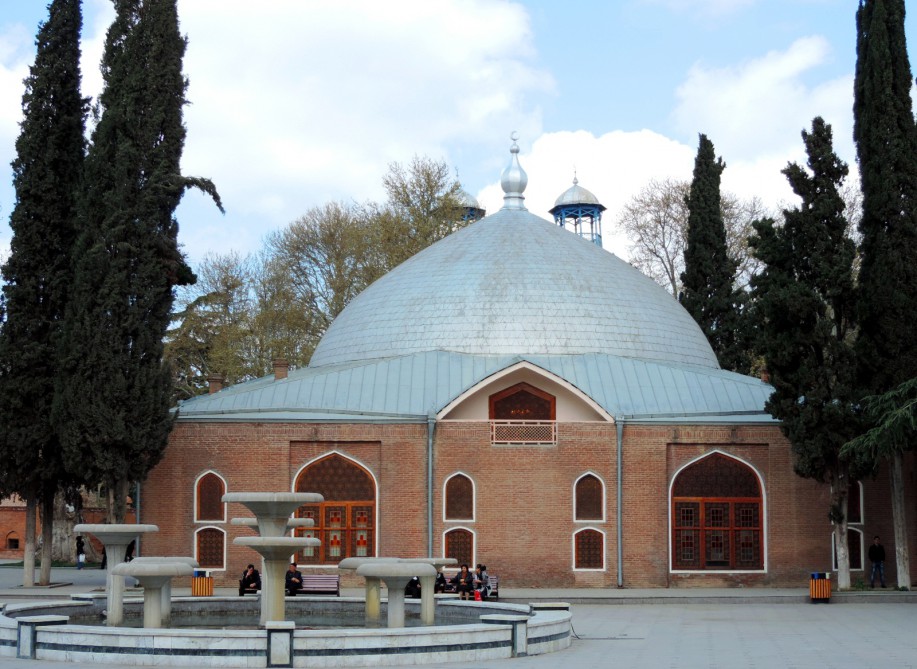
In XII century Ganja was the capital and residence of feudal rulers. However, in that period the city was subjected to two very strong earthquakes. As a result of the earthquake that occurred in 1139, Ganja was devastated, about 250 thousand people were killed. One of the peaks of Kapaz mountain crossed the river AGSU and thus Goygol was created.
In the XVII century, the city was rebuilt 6 km east of the previous place. At the beginning of XVIII century Ganja was again attacked by invaders, and in the middle of that century it became the center of Ganja Khanate. Ganja Khanate existed until the occupation of Russia. In 1804, when the superior forces of the Russian army attacked Ganja, Javadkhan’s group heroically defended Ganja, and Javadkhan himself bravely died. After this event in 1804, ganja was renamed to Yelizavetpol in honor of the Russian empress Elizabeth.
In 1918, during the collapse of the Russian Empire, Ganja was the capital of the independent republic of Azerbaijan for several months.
At that time, an officer school was opened in Ganja. In 1935, Ganja was renamed Kirovabad. Only in 1989, on the eve of independence of Azerbaijan and the collapse of the USSR, the historical name of Ganja was returned to him.

At present, HAJIKAND resort zone is located near Ganja. There are many tourist routes, boarding houses, tourist bases and rest houses here.
GOYGOL » State Reserve is the first reserve in Azerbaijan. This reserve was established in 1925 for the purpose of protection and study of ecological systems of middle mountainous, forested and partly subalpine zones of minor Caucasus, as well as Goygol, Maralgol, Zaligol and other mountain lakes, consists of forests and mountain meadows.
Located in the North foothills of Murovdag in the south of ganja, at an altitude of 1566 meters above sea level, Goygol is rightfully considered the Pearl of Azerbaijani lakes. Being the first reserve in the Caucasus, this reserve consists of two parts — the main part and the branch called « ELDAR pine forest ». The distance between the two parts of the Reserve is 80-85 km.
Ganja has its own history and Ethnography Museum. Among the exhibits of the museum there are many interesting finds of the Bronze Age. There is a Drama Theatre and a children’s Puppet Theatre in Ganja.
Tourists and guests of the city can stay in « Ganja Hotel », « Ramada Plaza Gence », « Vego Hotel », « Deluxe Hotel », « Karvansaray Hotel », located in the city center.
GOYGOL
District center — Goygol city.
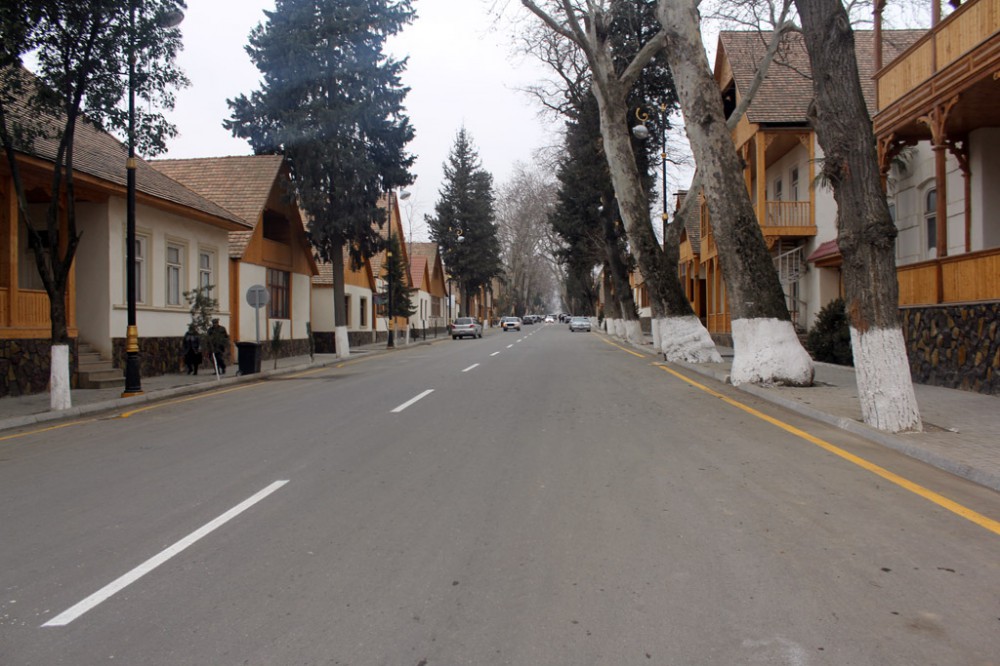
GOYGOL region is located at the foothills of the Lesser Caucasus, slightly south of ganja. Agriculture is well developed in this district, which attracts attention with its extremely picturesque nature. Climate is mild heat. There are especially many places where birds nest. The Ganjachay and Gushkara rivers are great places for hunting and fishing. The highest point of the district is the Murovdag ridge, located at an altitude of 3724 m above sea level. This region is very popular among tourists and ecotourists. When they come here, they stay in the Houses of local residents and in the surrounding villages.
The administrative center of Goygol district is GOYGOL city, located 384 km from Baku.
The city of Goygol was built in XIX century by the Germans displaced in the place of the ancient village called Khanate. In 1819, they planned this city with their own kind and called it Yeleniyendorf. Looking at the smooth streets of this city, facades of houses built of wood, carved works, kirkhaya (Lutheran Church), it is remembered that the Germans used to live here. Under Stalin’s orders, local Germans were exiled to Central Asia.
In Goygol there is a museum of local history, a music school, a cinema, numerous cafes and restaurants. Tourists coming to this quiet, green city go on tourist trips on various routes from there. Archaeological finds from the bronze and Iron Age confirm the ancient history of this city. Historical and architectural monuments such as Lutheran Church (1854), two bridges over Ganjachay — « two-eyed bridge » ( XVI century) and « three-eyed bridge » (1896) remained intact. The fortress of XII century in ZURNABAD village, the mausoleum of XVI century in SARI Gaya village, « AG bridge » of XII century in Topalhasanli village, as well as a number of historical monuments in CHAYKAND village can be shown as an example of monuments left intact near Goygol.
DASHKASAN
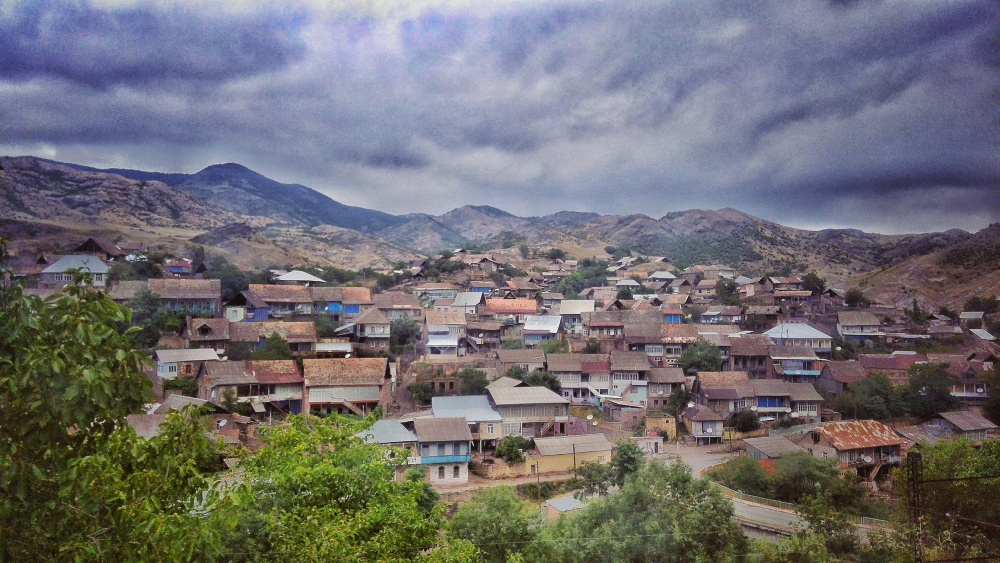
The center of the region is the city of Dashkasan. DASHKASAN district is the center of ore production in Azerbaijan and is located in the northeastern foothills of the Lesser Caucasus. Here the temperature can change very sharply. In winter, up to 20 degrees of frost (in general, this is not typical for Azerbaijan), and in summer-up to 35 degrees of heat, as in Absheron, located in the semi-desert zone. The region’s fresh air, mountain pastures and springs, rich in Alpine Meadows, attract both tourists and just vacationers.
Archaeologists have found the remains of ancient settlements of Stone Age in the areas of Khoshbulag, Zagali, Gurbulag, Amirvar, Bayan, Dardarya villages of this region. Two ancient stone bridges built over the GUSHGARA River and the mausoleum in Ahmadli village are historical and architectural monuments that have survived to our time. The monastery built in 487 in gushchu village remained intact. In the village of Bayan you can see the ruins of the Christian temple of XV century.
The administrative center of the district is DASHKASAN city. As you can see from the name of this city, located 397 km from Baku, this region has been famous for stone-carving artists, who have been considered connoisseurs of stone and wood carving since ancient times. At present, carpet weaving and sock weaving arts are well developed here.
In the small restaurants here, customers are offered typical dishes of national cuisine, and in the kebab houses you can taste delicious national dishes made of fresh meat and listen to folk music performed by ashugs (improviser folk singers). Dashkasan honey is considered one of the best types of honey in the Republic. Residents of the nearby city of Ganja love to come to Khoshbulag village of Dashkasan district to relax.
SHAMKIR
The center of the region is the city of Shamkir.
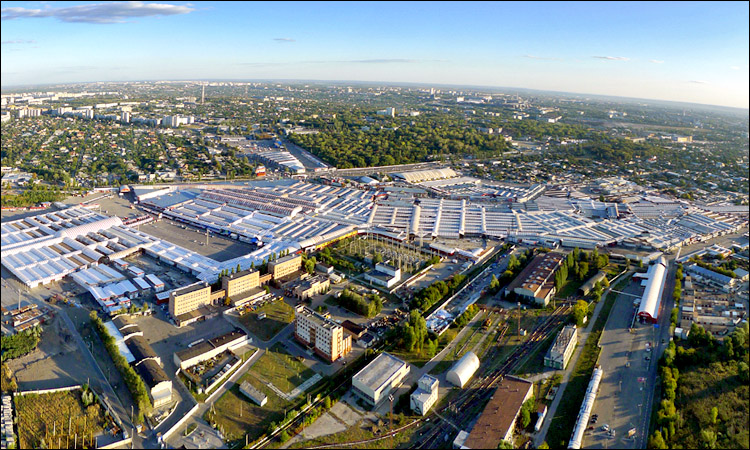
There are many archaeological sites related to bronze and early Iron Age in Shamkir district. They were found mainly in CHANLIBEL, SEYIDLAR and GARAJAAMIRLI villages. There are a number of historical and architectural monuments belonging to the Middle Ages: castles in TATARLI and ASHAGI SEYFALLI villages, bridges built in TAHNALI village and over ZAYAM River, Christian churches in YUKHARI CHAYKEND, GUNESHLI, DAGH JEYIRLI villages can be an example.
There are also places that fishing enthusiasts like — YENIKEND dam on the Kura River is more popular.
The administrative center of the district can be reached in one hour from Ganja to Shamkir city. The distance of Shamkir from Baku is 417 km.
In the XIX century, there was a small colony of German settlers called Annenfeld. As in the Khans, there are several streets and Lutheran churches that are in perfect condition as a memorial to the inhabitants of this colony.
According to written sources and archaeological data this city was built in V-VI centuries on the Bank of the great Shamkir River near the present MUKHTARIYYAT village, 20 km away from modern Shamkir.
In the Middle Ages, there was an 8-tower feudal castle in the city called SHAKUR. Shamkir’s riches attracted not only merchants, but also conquerors. Like many ancient cities of Azerbaijan, Shamkir was repeatedly destroyed during its existence, was subsequently restored and a period of progress passed. However, after one of the subsequent attacks, the surviving population of the city moved there and founded a new city.
Around modern Shamkir, there are two ancient castles of XVII century — SHAMKHOR fortress and KOROGHLU fortress (the name of this fortress was chosen as our national symbol in honor of brave Koroglu, who fought heroically against tyrants and villains). Many scholars believe that Koroglu was a real historical figure. But it was not convincingly determined that he really lived in the castle of Chanlibel.
In Shamkir you can stay at » Excelsior Hotel Shamkir » or rent a private house.
GADABAY
The center of the district is the city of Gadabay.
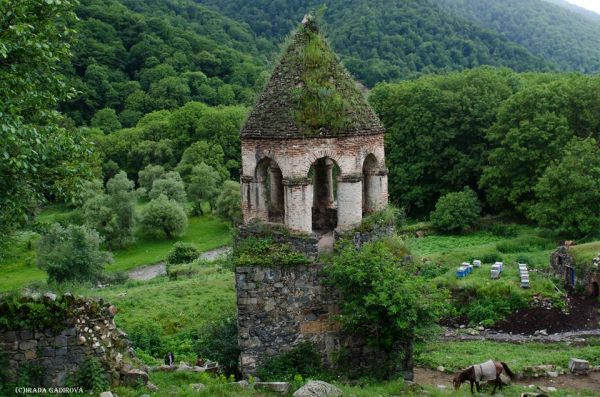
GADABAY region is located in Lesser Caucasus Mountains, as well as high mountains (Goshabulag peak height is 3549 meters, Gojadag peak height is 3317 meters) and mountains of medium height. The diversity of the area above sea level makes climatic conditions different. The tundra climate in the mountainous area gradually shifts to a dry climate with hot summer. The cost of the district center is 462 km from Baku.
Gadabay can be reached either from Shamkir or from Govlar station of Tovuz. Although the Tovuz road is more picturesque, it is difficult for passenger cars to pass this road: « basarkecher » cars are needed here.
There are good conditions for fishing in Shamkir River in Gadabay district. Near the village of GALAKAND there is a private fishing farm. The plant and animal world of gadabay region is rich and diverse. « GIZILAGAJ » Reserve is located on the territory of this district. There are also some natural objects included in the list of objects protected by the state, such as » natural monuments of Azerbaijan » — Pine, cane, JAKDARA, CHOVDU forests. This type of springs are Kechi-Kechi, roe deer, bear, jarga springs, as well as mineral water springs NARZAN, GIZILJA, MORMORE, CHALDASH.
Here, ancient cultural monuments entered the history of Azerbaijan under the name of Khojaly-GADABAY culture, cyclopical buildings of Bronze Age, as well as « GADABAY treasures » — ancient kuzas intended to store House utensils and stone stones, silver coins of XVI century – Shah Tahmasib’s reign period were found. These money began from Tabriz (present Iran) to Shirvan and Ganja were in circulation in a wide area.
As an example of the preserved historical and architectural buildings in the region, one can cite the archly bridge (XIX C.), the tower in Gala village (XVI C.), The Maiden Tower in SOYUDLU village (or Namard gala-IX C.), Christian temples of the early Middle Ages in NOVOSARATOVKA, SOYUDLU, CHANAKHCHI and KILAVI villages.
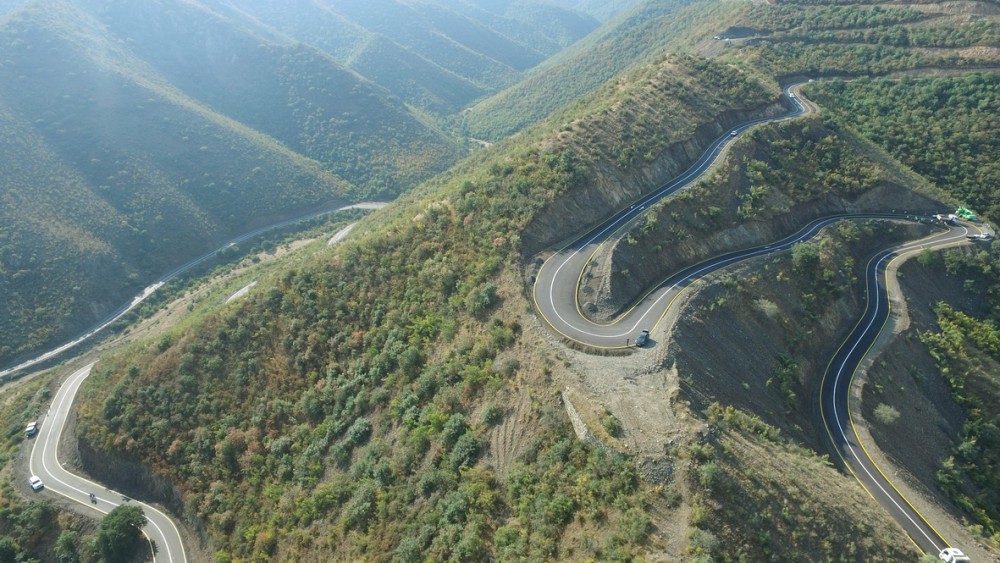
In the village of SARATOVKA live representatives of the old tribe of sects, called « dukhobor » of russians. They have still preserved their material and spiritual culture.
Folk arts such as wood carving, carpet weaving, socks and gloves weaving from colored coarse wool thread, processing of sheep skin are well developed in this region.
The territory of Azerbaijan was in the center of attention of some famous entrepreneurs in the West. For example, the NOBEL brothers got rich at the expense of Baku oil. German company » Siemens » built two copper-smelting plants in Gadabay at the end of XIX century. In Tsarist Russia, about a quarter of all copper was purchased at these plants. The Simens brothers were seriously interested in the history of this unusual land and organized archaeological excavations in this region. According to the results of these studies, the scientific work « GALAKEND » was written.
Visitors can stay at the hotel located in the center of the city.
TOVUZ
Center of the region — Tovuz city.
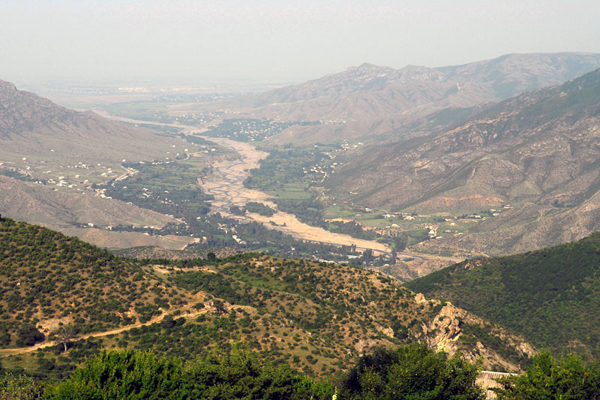
TOVUZ region of Azerbaijan is located in the west of the Republic and borders with Georgia and Armenia. Kura, Akram, Tovuz, Zayam and other rivers flow through the area. On the mountain slopes there are many forests, Springs, a rich world of plants and animals (wolf, fox, hare, turaj, partridge). The climate is dry, here you can hunt mainly rabbits and waterfowl.
Ancient monuments have been preserved in Tovuz district. The most interesting of them are the temple of XII century in KIRZAN village, maschid of XVII century in YANIGLI village, mausoleums in GAZGULU village, fortress in ALIBEYLI village and others. There are also numerous archaeological sites of bronze, iron and early middle ages.
Administrative center of the district — TOVUZ city is located 457 km from Baku.
Like most cities of Azerbaijan, Tovuz was built on the site of ancient human settlements of the Stone Age and Bronze Age. This city has left its mark in the genetic memory of the people to remind the places where our ancestors, who have replaced each other for millennia, lived. According to ancient Turkic written sources, the name of this city was derived from the names of two related Turkic tribes — OGUZ and TOGUZ. This name was established here as a toponym.
The foundation of Tovuz as a modern settlement was laid by German settlers who called it Traubenfeld.
There is small museum of famous ashig Huseyn Bozalganly (1860-1942) in Tovuz. Ashig Huseyn Bozalganli knew the KOROGHLU epos by heart.
Tourists can also stay in local residents ‘ houses or Ayan Palace Hotel.
AGHSTAFA
District center — Aghstafa city.
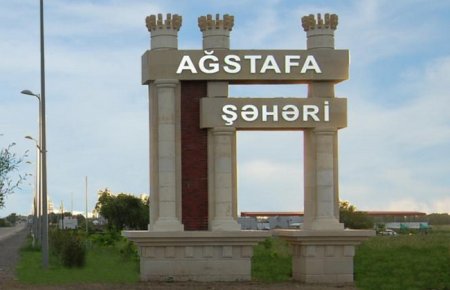
AGSTAFA region is located on the foothills of the Great Caucasus, on the border of Azerbaijan with Georgia and Armenia. Climate of the region is mild. Local residents are mainly engaged in livestock and agriculture.
A few small rivers flow through the region and Aghstafachay-the tributary of the Kura River. The lake CANDARGOL is also located here. Located 20 km from the city of agstafa, in the village of TATLI, a spring called GALACHMA is a favorite place for both local residents and tourists. The kebab cooked here is very much liked by the customers.
GARAYAZI State Reserve located on the Bank of the Kura River in an area of 4.9 thousand hectares was established in 1978 to protect and restore Tugay forests, Garayazi lowland and middle stream of Kura River in the zone around the Kura. The main object protected in the Reserve is the Tugay forest Massif.
« GARAYAZI-AGSTAFA » game reserve, established in 1923 on an area of 12.0 thousand hectares, is also located in Agstafa region. The purpose of creation of this reserve was to preserve Caucasian deer, pheasants, feathers, other rare species of animals and birds and increase their head number. The Reserve is located in the tugay forests zone in the middle Bank of the Kura River, on the border between Georgia and Azerbaijan. Flora and fauna of this reserve are identical to the flora and fauna of « GARAYAZI » Reserve, which is directly related to it.
A number of historical monuments have been discovered in the region: near KOCHASGAR village is an ancient settlement called MOLLA NAGHİ Hill of Paleolithic age; 17th century tower and 19th century MASCHID in GIRAG KESEMEN village; 19th century mosques in KOLKHALVALI, GARAHASANLI, DAGKESEMEN and duz GISHLAG villages, etc. There are no numerous monuments of stone, bronze and Iron Age in this area. These facts show that in ancient times the level of settlement of this region was quite high. There is a need for a detailed study of all these archaeological sites and new excavations.
There are defense fort and cave-type monasteries built in Caucasian Albania during early Christianity near Shepherd’s fields (places where sheep flocks are grazing in summer) in Keshikchidagh range in the top of agstafa city. During the USSR, this zone was closed for departure and arrival, as military units of the Transcaucasian Military District were located there. For this reason, this unique complex has not been studied properly. There was no departure there, most of the ancient paintings in the caves were broken by artillery fires. This complex belonging to Caucasian Albania, which was one of the state structures of ancient Azerbaijan, is currently being studied by archaeologists of the National Academy of Sciences of the Republic.
AGSTAFA city is located near the Georgian border, 479 km from Baku. This city was established as a railway junction in 1914. This city, the territory of which was small at that time, was called Yelizavetinka.
From here you can get on the train and get to the capital of Georgia-Tbilisi. Special care is taken to preserve historical and architectural monuments and cultural heritage-carpet weaving and ashug art in agstafa. The findings discovered by archaeologists – glass, vases, household items and ornaments are kept in the local museum of local lore.
Tourists can stop at » Medine Hotel », » Nesiboglu Hotel », » Qerb Hotel ».
GAZAKH
The center of the region is Gazakh city.

Gazakh district is located near the western borders of Azerbaijan. In general, Gazakh and Agstafa regions are considered the western border not only of modern Azerbaijan, but also of ancient Caucasian Albania. The division of the region into two independent administrative districts — Gazakh and Agstafa took place relatively recently.
There are state-protected historical monuments (monuments of architecture and archaeology): SYNY KORPU (12th century); DAMCILI Cave; Temple of 5th century in YUKHARI ASKIPARA; sugar gala Temple of 15th century; megalith type didevan fortification; complex of Albanian (7th century) temples in DASH SALAHLI village; Attracting attention with the remains of the fortress walls (The Last Middle Ages) GOYAZAN mountain and the remains of ancient urban settlements recently discovered near it.
There are many ancient settlements in the territory of Gazakh region: in AVEY Mountain, Between Dash Salahli and Kamarli villages, in the Valley of the Incisu River, on the north-eastern slopes of the Lesser Caucasus, caves inhabited by Neanderthals (Mustier) period, settlements of chromanion men were found near DAMCILI cave in Avey mountain, Khal-Khal City Place near stylish pink-gold Golden Rock and remains of castle walls were discovered. It is assumed that this area was one of the summer residences of the rulers of Albania. Without any excavation, archaeologists have discovered numerous remains of ceramic dishes of Bronze Age on the surface of the Earth. At one time, the Albanians destroyed Roman Pompey’s troops here. This is stated in ancient written sources: « 10 thousand cavalry and 60 thousand infantry of Albanians fought against Pompey’s troops ».
Kurgan graves belonging to the Bronze Age were discovered in the mouth of Barkin located a little west of the Golden Rock. All these historical objects (except Siniq bridge) are located near the city of Gazakh. Thanks to the efforts of the initiators of this land, many archaeological artifacts were collected and exhibited in the Museum of local lore. Those who come to the village of YUKHARI SALAHLI can visit the House of the famous Azerbaijani poet Samad Vurgun.
Relief of Gazakh region-mountains, valleys, rivers (Kura, Agstafachay, Jogaz, Khramchay) has always been favorable for seasonal cattle-breeding. Local shepherds bring and keep herds of sheep from summer pastures (mountain pastures) in winter season. It originates from the natural conditions of this area with local features of folk music and national cuisine. There are a lot of ashugs here, they are invited to various family celebrations and celebrations.
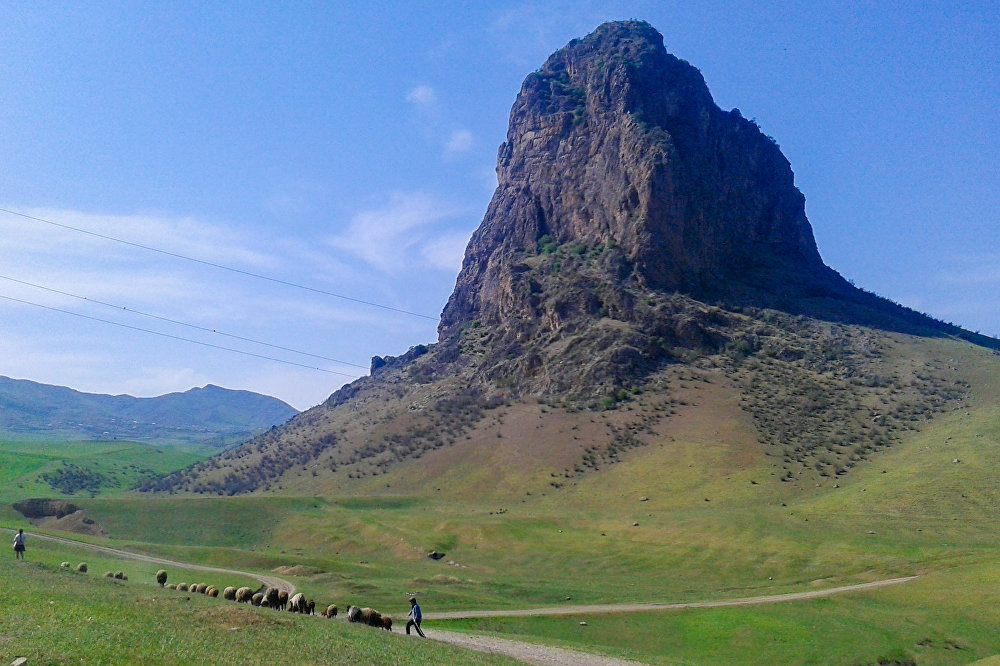
It is assumed that the ancient names of the GAZAKH CİTY are « Kasal » and « Kazaka. » According to some written sources, in the 8th century, Marwan ibn Muhammad founded a city here.
Gazakh, the last major city on the western border of Azerbaijan, is home to talented poets and writers. People recognize Kazakhs as people with special poetic feelings. A number of famous ashugs, scientists and military leaders were born here. Poets Samad Vurgun, Molla Panah Vagif, writers Mehdi Huseyn, Ismayil Shikhli, general Aliagha Shikhlinski, who was a participant in the defense of Prot-Arthur fortress, called « God of artillery » and others are originally from Gazakh. In 1917, the first seminary of teachers was opened in Gazakh.
There are museums reflecting the life of famous poets VAGİF and VIDADI, ancient maschid and other interesting objects in the city. Gazakh is also famous as one of the oldest carpet-weaving centers and horse-breeding plants. Especially popular are domestic horses of DILIBOSE breed, which are bred here. The products of Gazakh carpet school such as « Dagh Kesemen », « Gazakh », « Aggoyunlu », « Four Horn », « Damkali », « Shikhli », « Chobankara », « Borchali », « Fahrali » and « Gaymagli » are in great demand in the world market. The cuisine of the Gazakh zone consists mainly of simple, but very tasty meat and flour chokes. Tourists coming here are advised to stay in the Houses of local residents.
NAKHCHIVAN AUTONOMOUS REPUBLIC
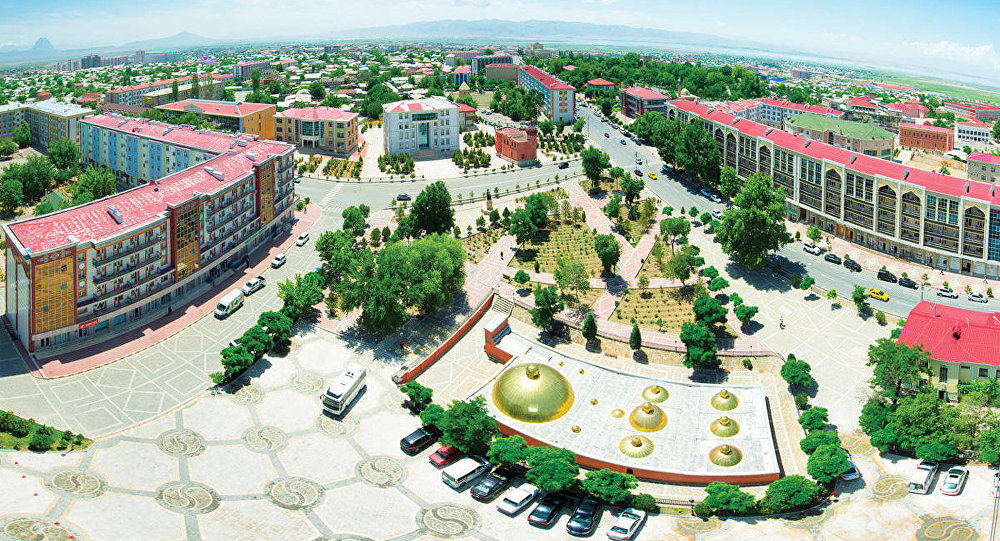
Nakhchivan Autonomous Republic (NAR) is located in the southwest of Azerbaijan. It was separated from the main territory of the Republic of Azerbaijan by a narrow strip of another state. Its total area at the beginning of its establishment was 5988 sq. km. where. In 1929-1930, part of the autonomous republic was cut off and transferred to Armenia by the Kremlin regime, currently, its territory is 5365 sq.km.left. In all historical periods, Nakhchivan was bound together by unbreakable bonds with Azerbaijan. As a result of the Armenian aggression, Nakhchivan had to be removed from Azerbaijan and, starting from the 90s, faced with the difficulties of the blockade. But difficult blockade conditions could not break the will of the people of Nakhchivan. As a result of their stubborn resistance, the occupying Armenians could not reach their hateful intentions. Modern Nakhchivan is a prosperous corner of ancient Azerbaijan and the entire Turkic world.
It is a mountainous place — more than 30% of the territory of the autonomous republic is located at a height of 600-1000 meters above sea level. The highest mountains of the region are GAPIJIG (3904 m) and Ilandagh (2385 m).
The autonomous republic is rich with rare mineral waters such as marble, stone salt, lime, gypsum deposits, SIRAB, BADAMLI, VAYKHIR, NAHAJIR, GIZILJIR. Underground water is generally abundant here, therefore, historically, the construction of Amber – rare underground water tunnels in the region has reached a high level. They descend from the top of the Earth by steps to Amber, and there are others with which water is simply brought to the surface of the Earth (just like in the style of modern water pipes). The Masters of Kahriz (kankans) preserved their professional skills until our time.
The ARAZ river flows along the border with IRAN and Turkey, in addition, about 40 small and medium-length rivers flow in the region (ORDUBADCHAY, ALINJACHAY, GILANCHAY, NAKHCHIVANCHAY, ARPACHAY, etc.). In addition to Lake Batabat, which is the « floating islands » of the world, there are also artificial lakes for irrigation of the Lands of Babak and Julfa regions — they are located at an altitude of 1500 meters above sea level near the village of GAZANCHI.
There are many ruins of ancient cities, towers, fortresses, and mausoleums left in the region. This region, like its natural resources, has always been attractive for the occupiers due to its strategic importance.
The Nakhchivan Autonomous Republic is distinguished by its healthy climate, therapeutic mineral waters, and rich medicinal plants.
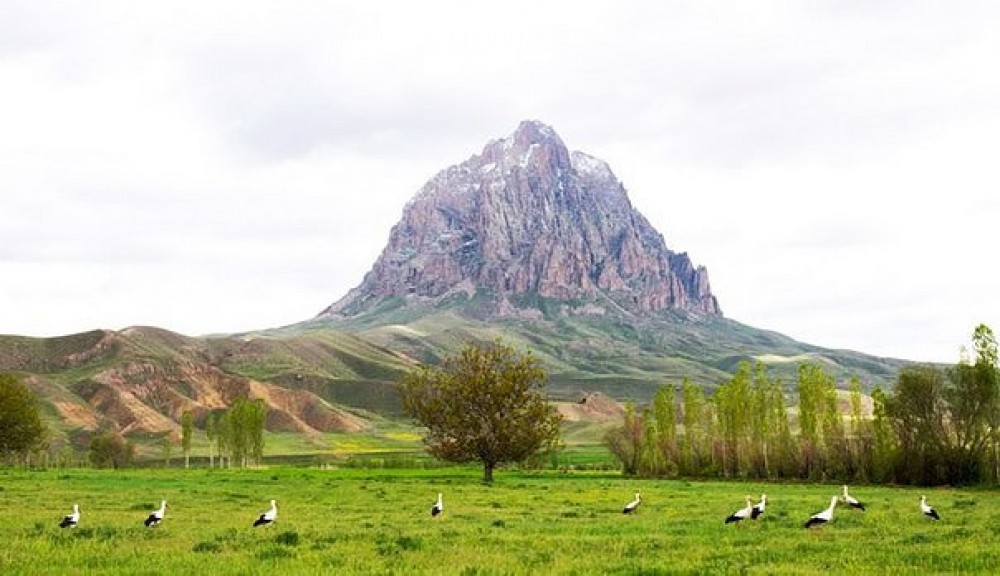
NAKHCHIVAN city is the administrative center of the Nakhchivan Autonomous Republic of Azerbaijan. It is located on the right bank of Nakhchivanchay, at an altitude of 1000 m above sea level. The distance from Baku is 560 km.
Nakhchivan is the most ancient city of Azerbaijanis in the world. The Azerbaijani people had created an ancient and rich culture on these lands. At the same time, Nakhchivan is considered one of the most ancient centers of the world. The rich historical, scientific and cultural heritage of the Azerbaijani people has been established in these areas.
Those who speak the word are the ones who are the ones who are the ones who are the ones who are the ones who are. According to the people’s trust, Nakhchivan means “Nakshi-Jahan”— decoration of the world. According to the most common legend among the people, Nakhchivan is associated with the Prophet Noah. The ark of Noah, which saved his people from the flood, went ashore here, and this is considered the territory where Noah came from.
Nakhchivan was one of the most ancient and large cities of Azerbaijan and the East. The history of the city goes deep into the millennia: archaeologists have found here many items of the material culture of the II and I millennia BC.
Local residents associate the establishment of a settlement in Nakhchivan with a legend about the Prophet Noah, who survived after the Great Flood. According to legend, Noah’s Ark was woven three times on the mountain tops of the Lesser Caucasus before burning on land and one of them was separated into two parts — The Great Agridagh and the lesser Agridagh.
The other underwater mountain peaks touched by the ship were Gapijik, Ilandagh, and Alagoz. According to this legend, wandering among the locals, Noah lived here considerably after the flood subsided and died on this land. Until recently, long-lived elders claimed that they knew the place where the Prophet Noah was buried. This legend is so widespread among the people that even famous artist Bahruz Kangarli created a painting called « the grave of Noah ».
The earliest written source of the name of Nakhchivan is Ptolemy’s (II millennium) works. He mentions Nakhchivan as « Nakhsuana ». In Arab sources of the Middle Ages, the name of the city is written as « Merkava », but Mahammad Nakhchivani, Hamdullah Gazvini, Secretary Chalabi, Evliya Chalabi, and others. in the works of such famous medieval authors, the name of the city is called « Nakshi-Jahan » (« decoration of the world ») with great respect. In the early Middle Ages Nakhchivan had close and intensive relations with Asia Minor, Middle East, and South Caucasus countries.
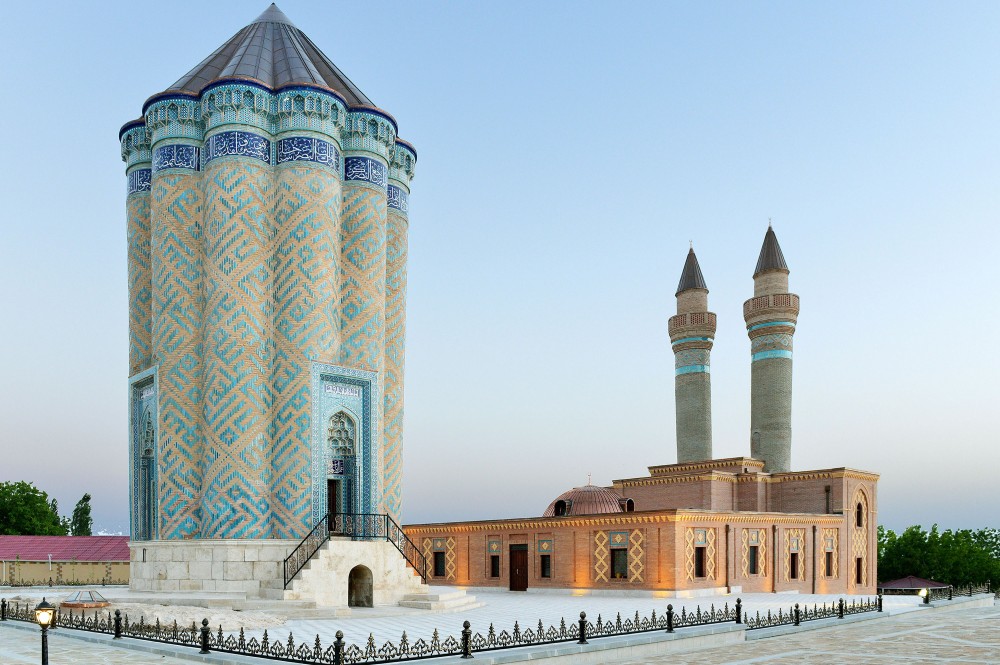
The beauty of the city and its geopolitical position led to frequent raids of the bordering states, as a result of which the city was destroyed several times. However, every time Nakhchivan stubbornly stood up again, restored the fallen, and fell into a better shape than before. For example, in the middle of the First Century AD, Byzantine Emperor Heraclius II plundered and destroyed the city, which was repeatedly destroyed by Mongol invaders, which turned into a « discord » between the Byzantine and Arab Caliphate.
In the XII century, 200 thousand people lived in Nakhchivan, trade developed, the city gained fame with its masters and craftsmen: Potters, jewelers, and glassmakers. However, the city was more known for its builders — the well-known Nakhchivan architectural school appeared here, and the construction work was widespread. In the Middle Ages, the famous palace complex of Eldanizs, the Juma Mosque, the madrasa which became the center of Muslim education, state buildings, and palaces of aristocrats were erected here, according to travelers who were impressed by the beauty of the city. Written sources tell that at that time there were « 20 thousand houses, 70 religious buildings, 20 caravanserais, 7 baths, several bazaars » in the city.
French travelers Pierre Charden and Dubois De Monper, English traveler Porter note that this is a beautiful city where ancient architectural monuments are preserved. The Ottoman traveler Evliya Chalabi tells about the scented water of local baths, where a basket of rose petals is thrown into the pool every day.
This ancient city has a unique culture and an integral part of it is the local cuisine, which is famous all over the country. For example, the « alana », which is prepared by filling the dried peach with ground nuts and sugar powder, and the « balgaganganag » by adding honey to the scrambled eggs only applies to the kitchen of this place.
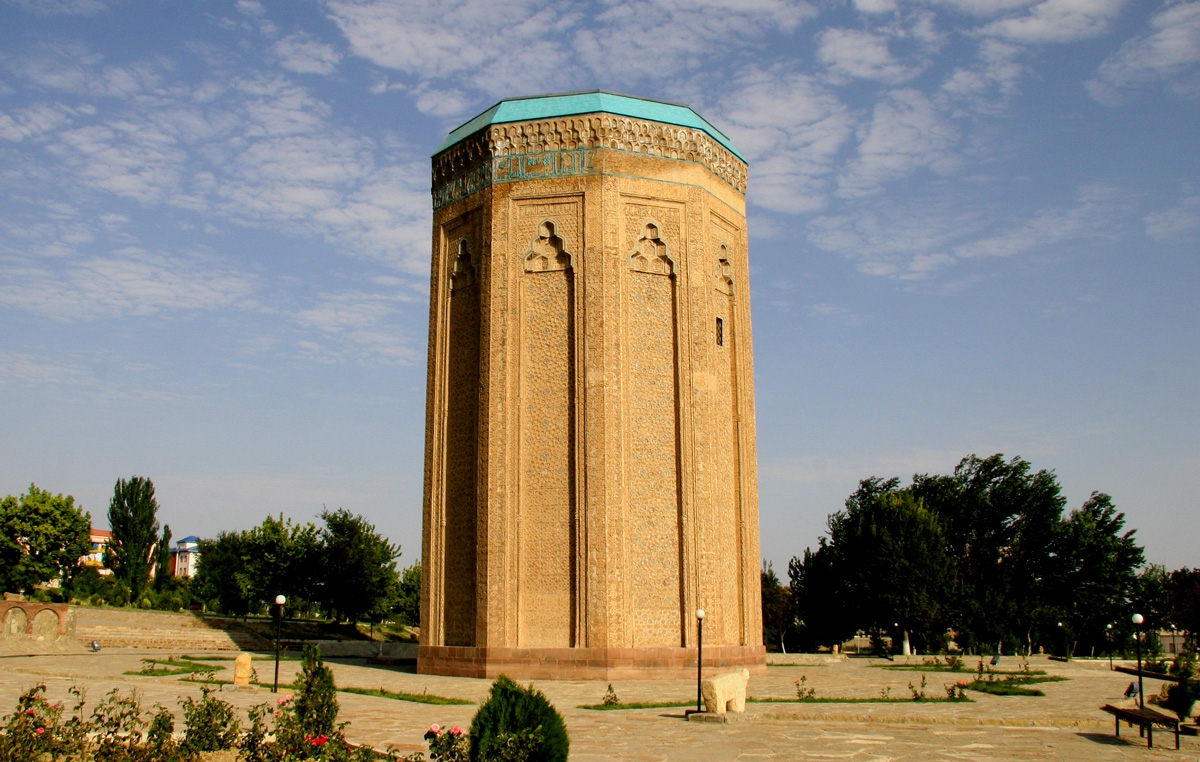
The land of Nakhchivan is the homeland of the great architect of XII century Ajami IBN Abubakr Nakhchivani. His works YUSIF IBN KUSEYR (atababa kunbasi), Momina-Khatun tomb, and portal of Juma Mosque with minaret remained intact until our time. It is believed that by creating the mausoleum of Momina-Khatun, Ajami created the image of the era. He was not in vain embroidered the mausoleum with these inscriptions: « We are leaving the world, we are dying — we have memories. » Geometric and epigraphic patterns decorating the mausoleum were executed with jeweler precision: it resembles a precious stone of the East striking turquoise.
Famous scientist, Statesman, writer, philologist, author of the first Persian-Turkish dictionary HINDUSHAH bin SENJAR BIN ABDULLA NAKHCHIVANI (XIII-XIV centuries) was born here. His son, Mahammad NAKHCHIVANI, who wrote a book on tax investments, was a well-known statesman of his time in the field of Finance (XIII-XIV centuries). Nakhchivan is also the homeland of KALBALI Khan NAKHCHIVANSKI, his son, general Huseyn Khan NAKHCHIVANSKI, military figure Jamshid NAKHCHIVANSKI, classic writer Jalil MAMMADGULUZADE, Romantic poet and playwright, Huseyn Javid, a victim of Stalin repressions, artist BAHRUZ KANGARLI.
Nakhchivan is also the homeland of national leader Heydar Aliyev.
In modern Nakhchivan, great attention is paid to science and education. There is a university, a branch of the Azerbaijan National Academy of Sciences, the campus has been built here. Special attention is paid to schools — old ones are being repaired, new ones are being built, for example, a very large and well-equipped school named after Heydar Aliyev has been put into operation. There is a Palace of Culture, A Drama Theatre, and a Puppet Theatre here. Well-equipped sports and Olympic Complex has been commissioned.
In the city, there is a Museum of carpets, A Museum of Literature, A Museum of history. There is also a house museum and Mausoleum of the writer and playwright Huseyn Javid. Many historical monuments-architectural complex IMAMZADE, JUMA MOSQUE, ZAVIYA MOSQUE, « PIRGAMISH », « Khan’S House », ISMAIL KHAN bath, YUSIF IBN KUSEYR MAUSOLEUM, MOMINA-KHATUN MAUSOLEUM, etc. it is protected.
You can stay in several hotels in Nakhchivan. Among them, the Hotel »Grand Nakhchivan », » Tabriz », » Togrul », » Azeri », » Ganjlik » shopping center, etc. can be shown. In front of » Tabriz » hotel, on Dede Gorgud Square there is a historical and architectural monument of XVIII century-the bath of Ismail Khan and the monument of Dede Gorgud.
Natural and medicinal objects of Nakhchivan
The Nakhchivan Autonomous Republic, which has rich natural resources, is famous for its natural-healing facilities. Thousands of people are healing here.
Daridagh Balneological hospital.
Daridagh arsenic thermal water, which is 15 km to the northeast of Julfa, plays an important role in the treatment of many skin diseases. Among them, it is necessary to take daridagh water baths for the treatment of itching, pyoderma, and other diseases. Water also contains iodine, boron, bromine, strontium, lithium. It is recommended to drink this juice for those who have diseases of the gastrointestinal tract and joints. These baths also have irreplaceable benefits in the treatment of the nervous system. Among arsenic, waters are the best alkaline-salt ones, which makes Daridagh water the first place not only in the Caucasus, but also among arsenic waters all over the world, for example, among Renchenko and Leviko waters in Italy known all over the world, and Lya-Bur-Bulvo in France. The amount of arsenic in renchenko water is more than in Daridagh water, but it does not contain alkalis that have a pleasant effect on the organism. A 2-block clinic with full medical condition has been built here.
Badamli physiotherapy hospital was established in Badamli settlement of Shahbuz region in 1980. Mineral water » Badamli » treats diseases of the gastrointestinal tract: chronic gastritis, chronic Hepato-cholecystitis, gallstone diseases, chronic entoroclitis, chronic gastric ulcer, chronic pancreatitis.
Duzdagh physiotherapy center. The famous sanatorium « Duzdagh » was considered one of the most unique places in the USSR. This physiotherapy center was established in the salt mine, 14 km from the city of Nakhchivan. Today, « Duzdagh » is considered the best treatment center not only for asthma, but also for allergic diseases. « Duzdagh » showed the highest efficiency in the treatment of bronchial asthma in the world.
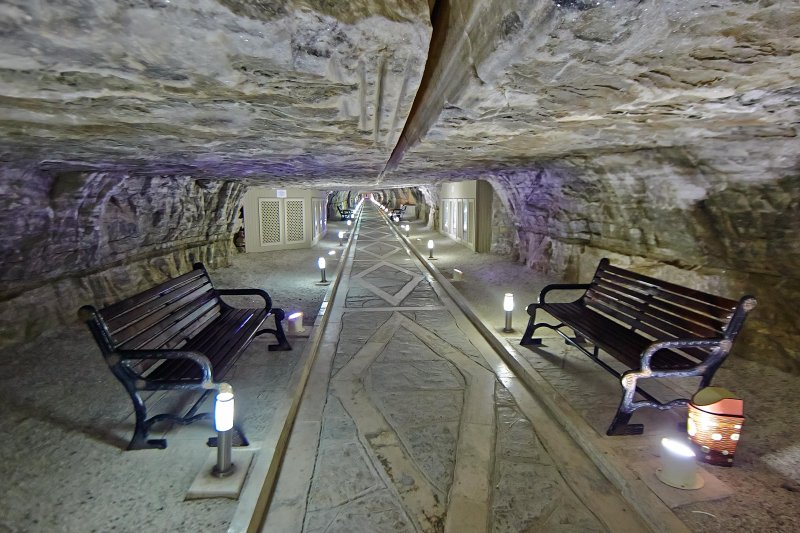
The sanatorium is located at the depth of the salty Mountain, which has been a salt extraction site for many years.
A 5-star hotel was built near the sanatorium. All demands and wishes of patients and their accompanying persons were reviewed here. The sanatorium and the hotel are a single medical and health center, both in the sanatorium and in the hotel all types of physiotherapy are provided to patients, which repeatedly increases the effectiveness of the treatment. The construction of a modern hotel next to the sanatorium is a vivid example of tourism cooperation with medicine. Today, « Duzdagh » is a tourist facility with many years of Statistics in the field of treatment and providing medical services at a high level.
« Nahajir » — Nahajir is a medical resort area located northeast of Nakhchivan. This place is located on the slopes of Mount Nahacir. The main reserve of the resort includes carbonate (1.3 g/l free carbonates) and iron-gyrocarbonate-sodium, minerals-6 g/l water source. It is possible to achieve good results in the treatment of problems with blood loss and digestion.
« Batabat » — is a resort zone with a curative climate, located 62 km to the northeast of Nakhchivan City, on the slope of the Lesser Caucasus Mountains, at an altitude of 1700 m above sea level.
In addition to the climate, there are carbonate, hydro carbonate, calcium, sodium, magnesia waters, which are used in the treatment of aerogeliotherapy. The mineral content of water is 0.5 g/l. They use this water in the treatment of the gastrointestinal tract. The mild climate, lakes, rich plant world of alpine meadows, and beautiful landscapes have a good effect on the human body.
ORDUBAD
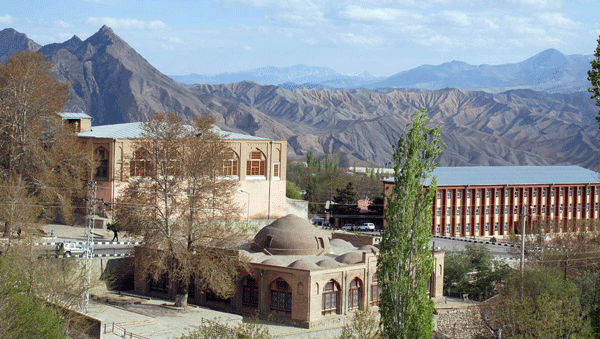
ORDUBAD district shares borders with Armenia in the North and East, and with the Islamic Republic of Iran in the South. It is located in the eastern part of the NMR.
The climate is contrasting-cold winter, hot summer. Here grow rich fauna and flora, amazingly clean air, many medicinal plants, and fruits. Many historical monuments of Bronze Age: stone Ram statues, remains of a settlement of II-I millennia BC in SABIR village, ruins of ancient GILAN city near AZA village, medieval buildings in KILIT, VELAVER, AYLIS, AZA, KOTAM, BILAV, Vanand villages, ruins of ancient ANABAD city, SHAKHTAKHTI tower near ANDEMIC village, XIX century mosque, the mausoleum of XIV century near DAR village, a bridge built in 1826 near AZA village, ruins of XIV century bath near Dar village and many historical monuments remain.
Rare petroglyphs dating back III-II millennia BC were preserved in GAMIGAYA 60 km south of Ordubad. Here are thousands of pictures depicting people, households, hunting scenes, real and fantastic animals.
ORDUBAD city is the administrative center of Ordubad district. This is the second-largest city of the Nakhchivan Autonomous Republic. The city is known from the XII century, it is located at an altitude of 850 meters above sea level. The city of Ordubad was declared a state historical and architectural reserve because of its antiquity, the presence of a large number of historical monuments, the fact that new buildings practically did not change its appearance, and the preserved lifestyle of residents.
Historical monuments: Juma Mosque with unique rear front view, DILYAR mosque, AFGHAN tower and XVII century balcony, many ancient sparrows, GEYSARIYYA trade complex with round dome covered (XIX-XX centuries) XVIII century ice-house and mosque two-storey madrasa and many others.
It is necessary to see Ordubad understand what beauty this small city has and how it preserves the natural fragrance of ancient times. In the shadows formed by the old plane trees with an incredibly huge trunk circle of 8 meters, people sit and talk without haste, rare mosques, ovdans, Amber — all this has their own unique features. It is a city inhabited by modern people who preserved the beauty of the ancient National way of life.
There is a museum of history, local lore with a rich Exposition, a theater, a House-Museum of the writer Mammad said Ordubadi, which laid the foundation of the historical-romantic genre in Azerbaijani literature. Restoration works are underway in the House of Academician Yusif Mammadaliyev — one of the first Presidents of the Academy of Sciences of Azerbaijan, the founder of the Azerbaijan oil and chemistry, a bright creative person, organizer of Science, and a person whose activity made an invaluable contribution to the destruction of Hitler’s fascism during the Second World War.
You can stay in the houses of local residents in ORDUBAD.
JULFA
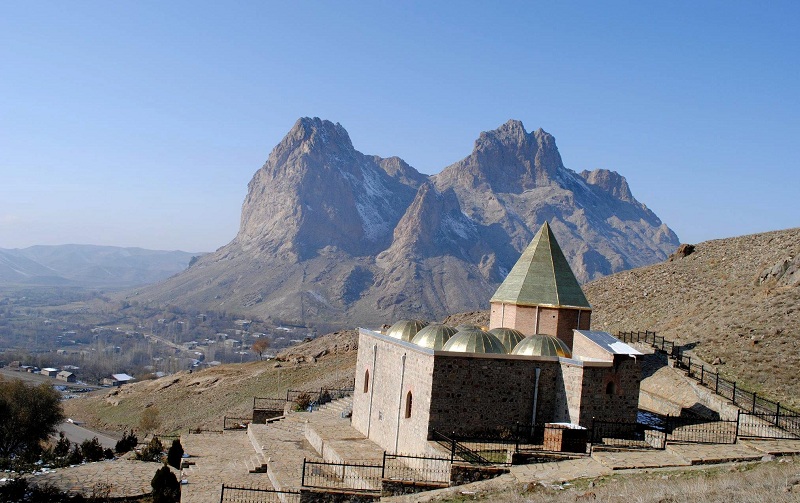
Julfa district is located to the east of the city of Nakhchivan. In summer it is dry and hot here, and in winter it is very cold. Precipitation falls about 220-600 mm per year. The rivers ALINJA, GARDARYA, as well as ARAZ (along the border with Iran) flow here. The mountains along the Julfa road are quite beautiful and peculiar – the geological factor (the composition of rocks, their age, etc.). the mountains are like huge, domes and fantastic buildings.
In the Julfa mountains, forest massifs are found, beech, hornbeam, Oak grow in the forests; the fauna is represented by wolves, foxes, and hares.
On the Bank of the Araz river, there are ruins of ancient buildings. These are caravanserai of XIII century, Khan of Nakhchivan, the remains of the bridge built at the beginning of XIV century by order of Hakim Ziyaaddin — small GULUSTAN mausoleum (XIII century) near the village of JUGA, three more ancient mausoleums near the village of Dar-among them the mausoleums with towers are in better condition (XV century). In particular, the ALINJA Castle (XII-XIII centuries) and many other monuments and the remains of ancient buildings can be shown.
There are many (about 40) water sources and springs in the region. One of them, the spring in the foothills of Daridagh provides about 500 thousand liters of strongly mineralized water per day.
The city of Julfa is located on the Bank of the Araz river, on the border with Iran. The Iranian city of Julfa is located almost symmetrically on the other bank of the Araz river. In the past, the ancient caravan route from Iran to Shirvan, Georgia, and Dagestan passed from here. Now there is a border checkpoint here. You can stay here at « Araz » hotel near the railway station. There is also a restaurant there. You can also dine in « Gulustan » restaurant and » Eldar » cafe.
BABAK
Babek region-it borders Armenia in the north of the Autonomous Republic and Iran in the South. The North and south-east of this territory have a mountain relief, and the south-west is plain. The highest mountain peaks-KECHALTEPE (2740 meters), GARAGUSH (2617 meters), BUZGOV (2470 meters).
There are SIRAB, GAHAB, vaykhir mineral water sources, and rock salt deposits in the area. It flows NAKHCHIVANCHAY and its tributary JAHRICHAY, the water reservoirs ARAZ, NEHRAM, UZUNOBA, and SIRAB are located here.
There are no forests in the region, viticulture, grain growing, horticulture, and animal husbandry were developed.
There are known archaeological monuments in the region: ancient ruins of GULTEPE and GULTEPE-2, ABBASABAD, VAYKHIR, AZNABYURT
BABAK city is the administrative center of the district. Until 1978 it was called TAZAKAND.
SHAHBUZ
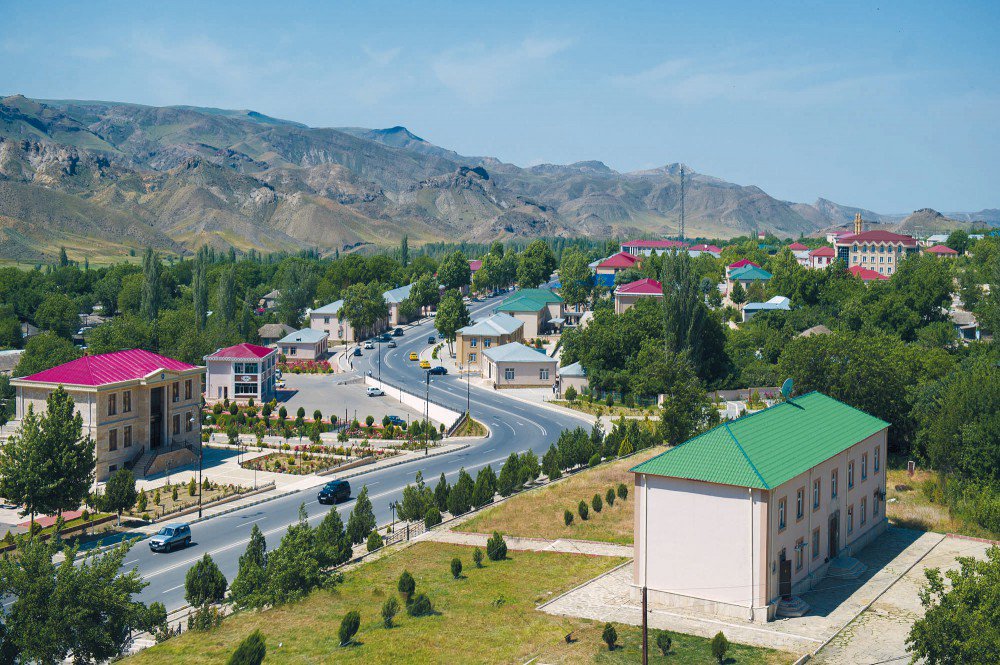
SHAHBUZ region is located in the north of Nakhchivan Autonomous Republic. This is a mountainous area. The highest point is SALVARTI (3160 meters), Kechaldag (3115 meters), the hayfields pass through the mountain pass.
As in the whole territory of the autonomous republic, many mineral waters flow here, including BADAMLI, BATABAT, caravanserai, and hayfields. Here there are deposits of sulfur, building materials, peat. NAKHCHIVANCHAY and its tributaries run: KUKU, SHAHBUZ, SALVARTI. Lakes-GANLIGOL, BATABAT. In the mountains, there are forest massifs.
The city of SHAHBUZ is the administrative center of the district. In the town of paradise, news of the preemptive measure provided little comfort. Among the people, this place is called « Farhad’s house » by the name of the hero of Nizami’s poem « Farhad and Shirin ». In fact, it is the home of an ancient man and has not quite the usual appearance: 4 rooms with a « veranda » on the stone wall of the mountain are carved. The ruins of the « Shahpur » fortress named after the ancient judge were also found by archaeologists. It is believed that this name acquired the form of « Shahbuz » over time.
The famous GARABAGHLAR mausoleum is located in GARABAGHLAR village. Surrounded by gardens, ancient but still working today, this village is located at the foot of Zangazur mountain range. The presence of fortifications with towers and a water supply system here testifies to the ancient origin of this settlement. There is a possibility that the mention of « 10 thousand houses, 70 mosques, 40 of them minarets, the city of GARABAGHLAR » mentioned in the XVII century manuscript refers to this village.
SHARUR
SHARUR region is located in the west of the Autonomous Republic and borders with Iran in the South. The area has a North and East Mountain relief. The DARALAYAZ Mountain system passes through here.
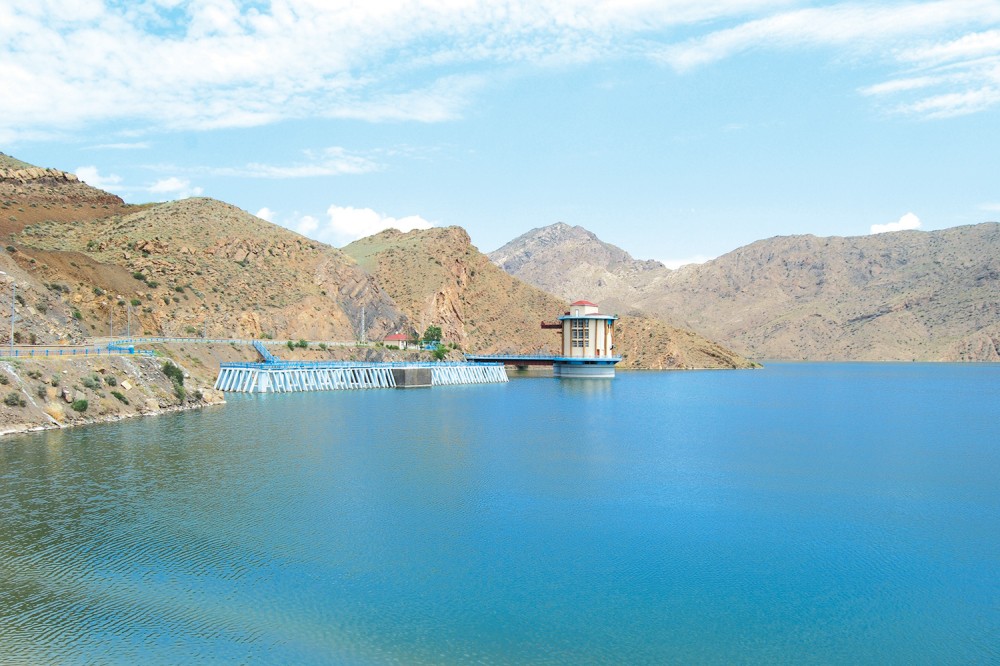
The highest mountain is GALINGAYA (2775 meters). The climate is semi-desert, arid. But it is soft enough — in winter the temperature rarely drops below +3 degrees, in summer it does not rise above +26 degrees.
From here the tributary of the ARAZ river flows ARPACHAY and others. Arpachay water is used for irrigation. Arpachay water reservoir has been built on it. Local fauna includes muflon (mountain sheep), wolves, mountain goats, foxes, bears, hares.
A few historical monuments are represented by ancient settlements dating back to the Bronze Period along the coast of Araz and Arpachay. In the GAZMA cave, there are stone and obsidian tools,
In the SHAHTAXTI mansion, samples of qualitatively processed fake utensils were found. Arbatan, Vermaziyar, Karahasanli,
Archaeological excavations carried out near the villages of Babaki, Kosajan showed that ancient settlements were located here. They live in the memory of such toponyms as Kohniks, Kohnekend, Arbatan, Kohnekend, Kultapa. Many household items and decorative pottery were found here.
SHARUR is the administrative center of Sharur district. It is a new city, it was formed during the construction of the railway. There are two parks, a museum, a stadium, a mosque, a monument to martyrs, a cinema here.
On the other side of the railway the old city has been preserved with its baths, market, and mosques.
Guests can stay here in the houses of local residents.
KANGARLI
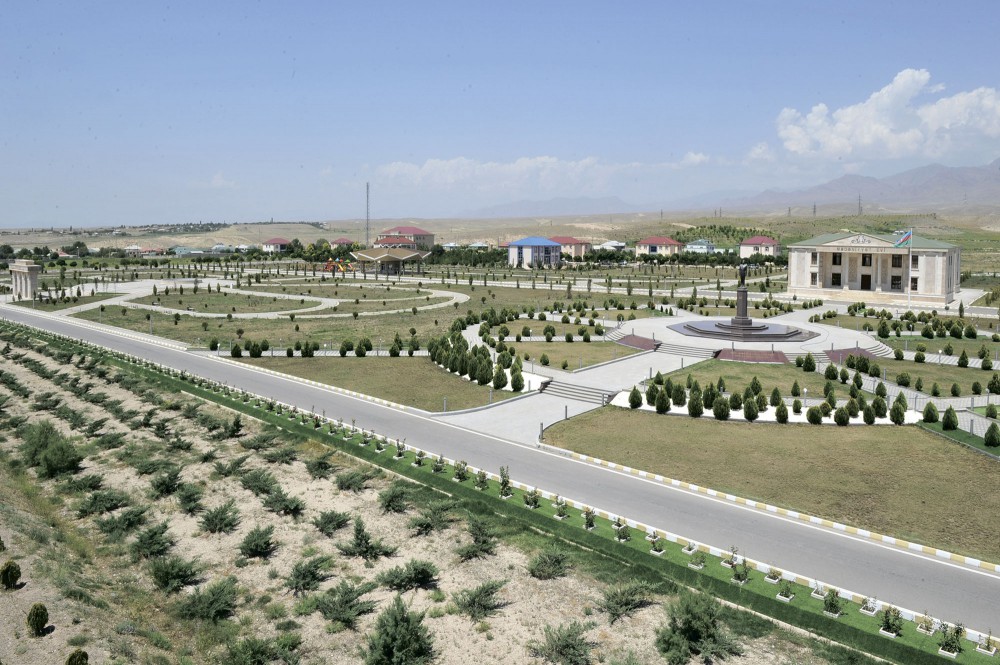
KANGARLI district is located between Babak and Sharur districts. The southern part of the region borders with Iran, the north – with Armenia. The region has a mountainous relief and is located in the mountains of DARALAYAZ.
As everywhere in the autonomous republic, its climate is sharply continental – it is very hot in summer and cold in winter. Araz river flows through the region along the state border between Azerbaijan and Iran.
The mountain relief, the features of the climate, and the absence of small rivers are the conditions of local vegetation. They are mainly represented by semi-desert and mountain species (shrubs, grasses, rare trees).
Tobacco, grapes, cereals, vegetables, and melons are grown in this agricultural region.
As in all parts of Nakhchivan Autonomous Republic, there are a large number of ancient monuments here, which indicates that the region has been inhabited by people since archaic times: CHALKHAN gala mounds, GAZMA cave, as well as GALACIG, GOVURGALA, DAMLAMA, GULAMLITAPA settlements.
Preserved monuments of later periods: Jame Mosque in Khok village (XVIII century) and bathhouse in SHAKHTAKHTI village (XIX century).
GIVRAG settlement is the administrative center of the new district, which was established in 2004. Givrag is located on the Nakhchivan-Sharur Highway, 30 km from the capital city of Nakhchivan. The settlement is 6 km from the Araz River.
Due to the fact that the district has recently acquired the status of an administrative center, there is no infrastructure for tourists in the village of Givrag. However, guests can stay here in the Houses of local residents.
SADARAK
Sadarak region was formed on August 28, 1990. It borders on Turkey in the south-west and Armenia in the North-West. The center is Heydarabad, located in 3 villages.
The territory of the region consists of mountains and plains. There are Dahna and Veling Mountain Heights.
The rivers Araz, Karachay, and Chapan flow through the area. Aghoghlan tomb is located in the north of Sadarak settlement. In addition, there are medieval historical architectural monuments on the territory of the region. Sadarak Castle belongs to the end of the Bronze Age and the beginning of the Iron Age.
A seal dating back to the VI-VII centuries has been discovered. The neolithic human centers are located to the east of Sadarak.
KARABAKH AND EAST ZANGAZUR TOURISM REGION
Karabakh is one of the most beautiful regions of Azerbaijan. Karabakh, which has a fascinating picturesque nature, rich spiritual and cultural traditions, is the birthplace of many prominent Azerbaijani scientists, poets, writers, artists, musicians, and singers. Karabakh is the cradle of Azerbaijani music. Hundreds of music works, one of the most ancient and rare samples of Azerbaijan folk folklore, were created in Karabakh.
Karabakh is one of the most ancient historical regions of Azerbaijan. In 1968, the remains of an ancient man were found in the Azikh cave located in the territory of Karabakh. It is likely that people lived in this area 250-300 thousand years ago. The rich nature and natural resources of these ancient lands were always in the spotlight.
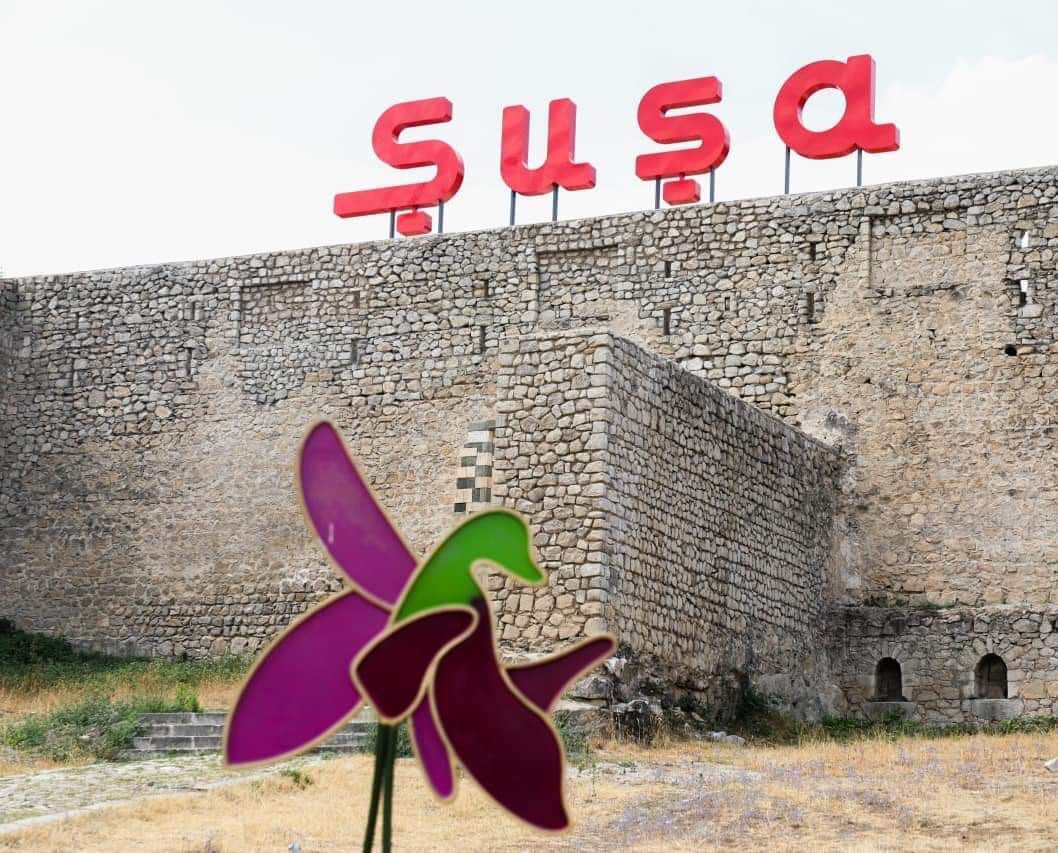
Unfortunately, as a result of nearly 30 years of occupation, all our wealth has been exploited and plundered in these territories. The enemy has not rebelled against his abominations, making everything self-sufficient. Cultural centers, museums, historical monuments located here have also been destroyed, destroyed and valuable items having an ancient history have been taken out of our country. The occupation regime conducted illegal archaeological excavations in different regions of Karabakh until the end of the second Karabakh War, and artifacts found were transported to Armenia. Our historical and cultural monuments were plundered, all the infrastructure was destroyed, the mosque and its minarets, which are considered an ancient architectural monuments, were destroyed and shrines were destroyed.
Despite all this Destruction, material, and moral damage, our state is engaged in the restoration of our religious, historical, and cultural monuments, which were barbarized on the one hand. The cultural construction work started in Shusha, which is considered the cradle of Karabakh’s culture, will be continued in our other regions. Over a short period of time, the mausoleum of Vagif, the bust of Vagif were reopened, the monument to Uzeyir Hajibeyli was reconstructed, the restoration of the destroyed House of Uzeyir Hajibeyli began, the opening of the Bulbul House Museum took place, and the Natavan spring was restored. Busts of our great personalities – Natavan, Uzeyir Hajibeyli, and Bulbul, shot down by Armenians, were brought and laid in the central square on the instructions of President Ilham Aliyev. Repair and restoration work started in three mosques, Vagif poetry days, and the « Kharibulbul » festival was restored. The role of the Heydar Aliyev Foundation in the restoration of all this cultural activity is undeniable. « Garabagh » and “Kharibulbul” hotels were commissioned in Shusha within a short period of time. The construction of 3 airports in Karabakh is not accidental either. The Fuzuli Airport has already started functioning, and the opening of Zangilan and Lachin airports in the near future is not ruled out. This will allow both local and foreign tourists, who wish to come to the cultural capital of Azerbaijan, Shusha, which is considered the Pearl of Karabakh, to travel to the Istisu resort with amazing nature, ecotourism opportunities of Kalbajar to make their travel more comfortable and easy.
The tourism potential of Karabakh is very rich, there are all opportunities for the development of many types of tourism — ecotourism, mountain tourism, winter tourism, hunting, and health tourism. The strategy and concept of the tourism development of liberated territories by the State Tourism Agency have been developed. In addition to traditional tourism in Kalbajar, winter and health tourism can be developed. Shusha, which is considered the cradle of culture, is mainly planned to hold festivals, to show the results of the « dark » occupation in Aghdam and business tourism. Khojavand also has special tourism potential. It is more appropriate to introduce tug and Hadrut into the wine route. The famous Azikh cave, Taglar cave are also located in this area. There are certain plans related to Sugovushan too.
This ancient region of Azerbaijan has its own flora and fauna, cuisine, historical cultural and religious monuments, ancient fortresses, bridges, forests, springs, etc. it will attract tourists with its sights. Various types of extreme tourism, agrotourism, and green tourism can also be organized in Karabakh, which is rich in natural resources. All this creates broad prospects for the development of Tourism. Kalbajar is an ideal place for winter tourism. It is important to establish the tourism infrastructure in the form of interaction in our liberated territories. Shusha will be one of the symbol cities of Azerbaijan tourism. Historical monuments and unique architecture of Shusha, the Pearl of Azerbaijani culture, will create new tourist routes.
Lachin reserve with an area of more than 21 thousand hectares will expand the tourism opportunities of Lachin, which has a fairly wide range of recreational opportunities and has rich flora and fauna. Even before the occupation, there were 2 large sanatoriums of all-Union importance in the Istisu settlement of Kalbajar. Every year 50 thousand people were treated there and rested. With the « Istisu » mineral waters here, it was possible to cure both external and internal diseases of man. There was even a resort and a mineral water filling plant. According to experts, the relief of Kalbajar allows the construction of the most amazing canaries of the world, the construction of the most interesting tourist services. In the future, it is possible to create the largest tourist center in the Caucasus.
At the same time, the « tourist route of Caucasian Albania » will play an important role in exposing Armenian lies that falsified the history of Karabakh. The route is prepared on the basis of advice and recommendations of scientists studying Caucasian Albania. The Albanian culture route covers 3 main corridors of Azerbaijan — Baku-Sheki-Zagatala, Ganja-Gazakh, and Karabakh. Traces of Albanian culture are more in Karabakh and East Zangezur. It has a rich heritage related to Caucasian Albania. This place includes temples, churches, as well as traditions, etc. included. It should be noted that the tourist route, which will be created in the footsteps of the ancient Albanian culture, will be of particular importance for the promotion of the rich and historical tourism potential of our country, as well as Karabakh.
Hard work is underway to create the necessary tourism infrastructure to promote the existing tourism potential of Karabakh. It should be emphasized that tourism, along with the economic side, has a promotional side. Tourists will rest in our Karabakh, enjoy the beauty of nature, cultural and historical monuments, the favorable environment created, as well as get acquainted with some buildings to be demonstrated as exhibits to show the results of occupation in our territories such as Aghdam, Jabrayil, Fuzuli and see what situation Karabakh was brought into by Armenian barbarians, and now they will be witnessing how they are improved by their true owners.
In general, there are broad plans to develop tourism in Karabakh and East Zangezur. In the next 4 years, considering domestic and foreign tourists, Karabakh is expected to receive 1 million people.
GENERAL INFORMATION
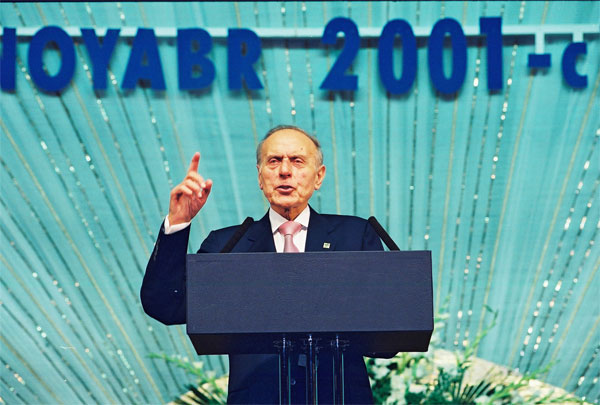
« Diaspora » is an old Greek word that is translated as « sparseness ». The appearance of the word dates to the period of occupations and migration started by the Greeks long ago A.D. During hostilities to different countries, a part of the Greek army settled in the occupied territories and turned to permanent settlers of that place. The term « Diaspora » came from their tongue.
Despite the sphere of activity, engagement and religious settlement of people of any ethnos aside from their historical lands for some period of time and their social activity cause the formation of the Diaspora.
Though Azerbaijan has recently acquainted with this term, the settlement of our compatriots in different countries of the world started several centuries ago. In comparison with other people, to leave the country was especially hard for Azerbaijanis for the reason that they were bound to their motherland. One may notice the theme of ‘Motherland and abroad’ to be one of the most popular themes in Azerbaijan folk literature. This fact proves quite the old age of the establishment of the Azerbaijan Diaspora.
The term ‘Azerbaijan Diaspora’ today means Azerbaijanis settled in foreign countries. The definition of the notion « Azerbaijanis living in foreign countries » is given in the Law of the Republic of Azerbaijan « About the state policy on the Azerbaijanis living in foreign countries ». It says that « Azerbaijanis living in foreign countries » are the citizens of the Republic of Azerbaijan and their children living abroad the Republic of Azerbaijan, a former citizen of Azerbaijan SSR or the Republic of Azerbaijan living abroad the republic of Azerbaijan and their children, and individuals relating themselves to Azerbaijan on ethnic, language, cultural or historical ground.
The migration of Azerbaijanis to foreign countries was more intensive in the early 20th century. Anti-Moslem and anti-Turk policy of tsarist Russia aimed at weakening the dominant position of Azerbaijanis in the Caucasus. The genocide was carried out by Armenians during 1905-1906 and in 1918 and the policy of ethnical cleaning had the same strategic purpose.
After the establishment of the Democratic Republic of Azerbaijan in 1918, the migration to foreign countries lessened enough. The destruction of the Democratic Republic formed a new situation. Serious pressures and persecutions of founders and supporters of the Democratic Republic by the Bolsheviks made them eave the country. This period is characterized by the mass migration of Azerbaijanis to foreign countries.
The first attempt towards the organisation of the Azerbaijan Diaspora was the establishment of the « Azerbaijan Culture Circle » in Ankara, Turkey on February 1, 1949. Saleh bey Sheykhzamanli, the son of Nagi bey Sheykhzamanli, the Minister of National Security in the period of the Democratic Republic of Azerbaijan, established in 1956 ‘Azerbaijan society of America’ in the USA. Today the mentioned society is ruled by the grandson of Saleh bey Sheykhzamanli Tomris Azeri. Thus we may come to the conclusion that the period of establishment of Azerbaijan Diaspora started in the middle of the past century. We don’t have any other fact evidencing the establishment of the communities and unions relating to Azerbaijanis till that time.
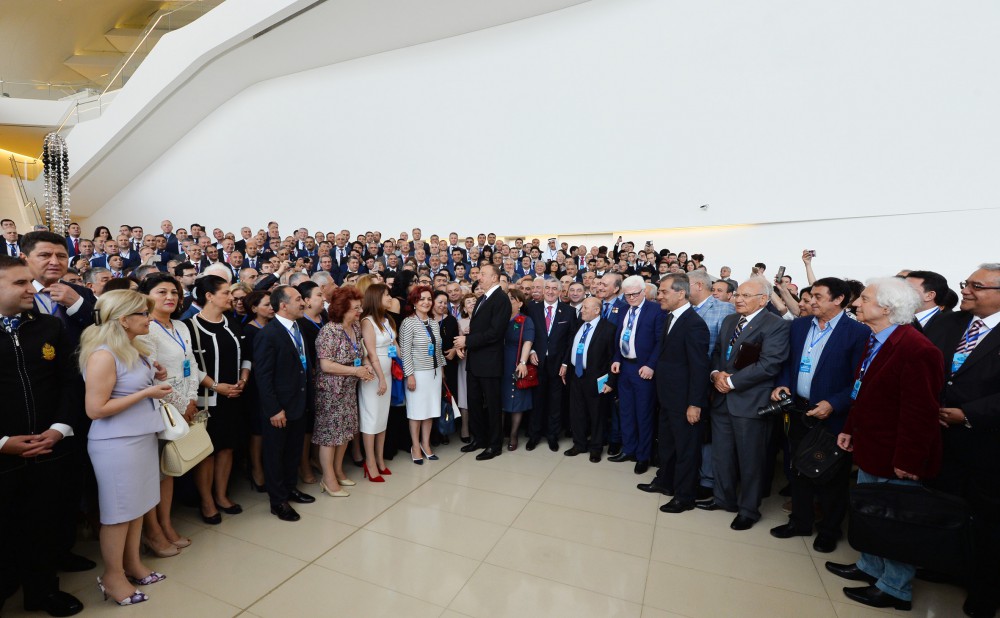
After World War II starts a new period in the history of the Azerbaijan Diaspora. Greatly increased the number of our compatriots living in foreign countries during the war and in the peace. Those were Azerbaijanis taken hostages in the war and those for different reasons left for Europe after the war. Cruel and merciless punishment mechanisms and bloody repressions of the Soviet regime prevented their return. Thus the quantity of Azerbaijanis living in foreign countries increased.
The number of applications during recent decades from Iran-the settlement of about 30 million Azerbaijanis- prevail those migrating abroad.
Several years after World War II hard borderline regime applied by the Soviet government prevented general flow abroad the USSR. But the dissident movement was more mass in the character in comparison with the previous one. The same danger was not an exclusion for Soviet Azerbaijan. In 1969 — the period of extension of the dissident movement and free thought in the USSR-Heydar Aliyev took his place at the head of Azerbaijan. He founded a new stage in the life, social consciousness and formation of national self-consciousness of the republic.
Beginning in the early 70s of the 20th-century national revival, the development of the economy, culture, science and education, perfection of moral values stimulated national self-consciousness. In 70-80s Heydar Aliyev did his best to preserve the historical memory of the people, development of culture and popularisation of Azerbaijan in the world.
The evident and systematic engagement in the problem of Diaspora on ideological base was impossible at that period for its political realities. Nevertheless, serious attempts made to develop culture, art and science, the achievements of our Republic widely popularised and used each opportunity that would serve the relation of the world Azerbaijanis with Azerbaijan. Intensification of cultural relations in foreign countries, development of translation, the establishment of the Azerbaijan Cultural Relations Society with the help of the Azerbaijanis living abroad (the society « Veten » (Motherland)) served the unification of compatriots and their relations with the Motherland. The thorough development of our country awoke the feeling of national pride and increased the interest and bond of Azerbaijanis to their motherland.
National leader Heydar Aliyev paid particular attention to the intensification of scientific-intellectual potentiality. Thanks to his attention hundreds of Azerbaijanis got the opportunity to get their education in progressive educational institutions of the USSR during his ruling. More than 15000 Azerbaijanis got their education on more than 250 specialities in science, economy, culture, industry and other necessary spheres in more than 170 institutions of higher education in more than 50 great cities of the former USSR. The majority of the professional community returned to Azerbaijan and served the development of Azerbaijan. The other part settled in the cities they got their education. Thus integration processes in the soviet state in 70-80s and education in other countries stimulated their migration. They started their activity abroad and thus helped the unification of our compatriots and the development of our science and culture. Particular importance in the intensification of the national consciousness of world Azerbaijanis played the activity of Heydar Aliyev in Moscow as one of the leaders of the Soviet state. The worldwide political activity of the national leader is evaluated by our compatriots as the reflection of national consciousness and character and thus intensified self-assurance, self-consciousness and unity of our people.
Historical progress of Azerbaijan people caused in re-establishment of irrevocable state independence in the late 20th century. But the social-political processes made Azerbaijanis leave their historical lands and settle in different countries of the planet.
The event in the USSR in the late 80s of the past century stimulated extension of the democratic way of thinking and inflammation of national movement for freedom. The process was more intensive. For this reason, Azerbaijanis were named ‘the most militant people of the world’ in 1989. A particular role in national awakening and intensification of self-consciousness played diversions by Armenians in the inseparable part of Azerbaijan Nagorny Karabakh.
The events of the 20th of January of 1990 remained in history as the great occurrence approving the national integrity of Azerbaijan people. The tragedy united the Azerbaijani people and revealed the power of world Azerbaijanis. Heydar Aliyev made a speech in Moscow on the January 20th tragedy and expressed the political will of his people. His feelings of citizen honour and real patriotism stimulated his courageous speech that raised Azerbaijanis. The declaration stimulated the organisation of the world Azerbaijanis in a whole nation. It gathered all our compatriots around the only statesman and national leader capable to assume responsibility for his people.
There is a great need to find out the more favourable solution to the problems and difficulties that appeared in the process of formation under the national Diaspora of the Azerbaijanis living in foreign countries and in creating relations with our Republic.
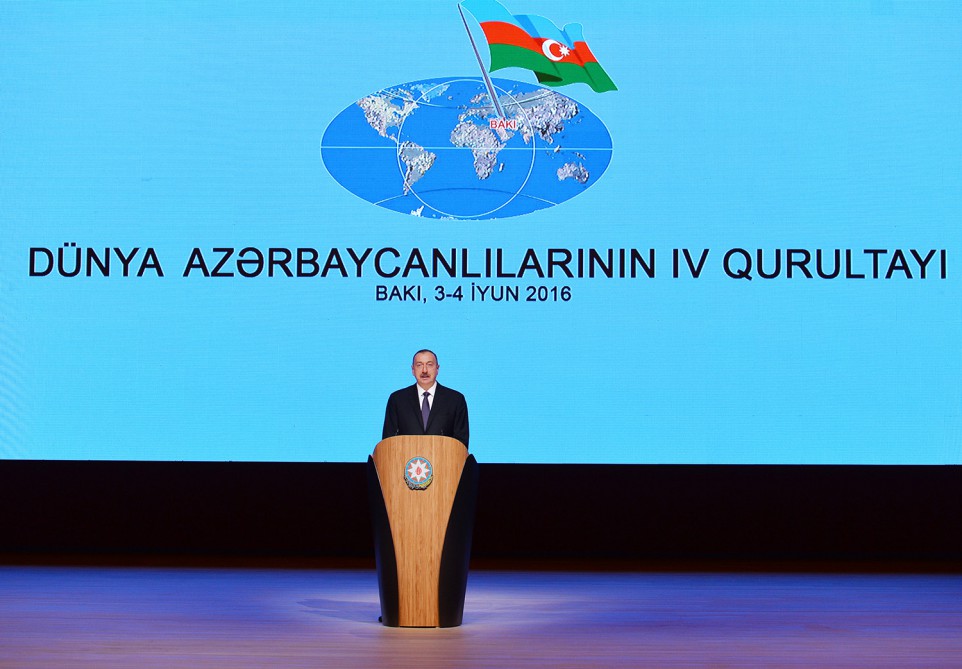
About 300 communities and organisations function in the majority of world countries today. The process of the formation of the Diaspora is still on today.
Common purpose united many societies and associations functioning separately and established federal Azerbaijan associations, such as All-Russia Azerbaijan Congress, the Congress of Ukraine Azerbaijanis, Federal National-Cultural Autonomy of Russia Azerbaijanis, Germanic Federation of Azerbaijan Societies, Sweden-Azerbaijan Federation, ‘Turan’ congress of Azerbaijanis from Kazakhstan, Kyrgyzstan, and Uzbekistan and Social Association « Azeri » in Kyrgyzstan. Those societies and associations could carry out important works for the development of the relations between Azerbaijan and the countries they function in, organisation of our compatriots and intensification of the relations with their Motherland. With the purpose to increase the power of the Azerbaijan Diaspora, the State Committee on the Affairs with Diaspora controls the establishment of new societies and associations. Thus the tendency o the establishment of new societies and associations spread to another country and caused the formation of the Congress of Azerbaijan Communities of Byelorussia, the Congress of Azerbaijanis from Moldova, the Association of Azerbaijan Centres of Culture in Uzbekistan, Azerbaijan-Norway Association. The abovementioned federal associations take all the necessary and possible measures to organise Azerbaijan Diaspora and to intensify their activity, they try to successfully carry out the responsibilities they assumed.
As a result of these efforts, today, more than 460 Azerbaijani communities have been established in Europe, North and South America, the CIS and many countries, including Uzbekistan, Kyrgyzstan, Norway, Netherlands, Germany, Spain, Italy, Belgium, Bulgaria, Czech Republic, Finland, Estonia, Poland, United Arab Emirates. Egypt, Turkey and the United States. The establishment of new Azerbaijani communities and communities deserves recognition as the successes of modern Azerbaijani diaspora construction.
POLICY OF ORGANIZATION OF DIASPORA
All the achievements in the unification of millions of our compatriots settled abroad in Azerbaijan around common purpose are related to the name and purposeful activity of the national leader Heydar Aliyev. The president of the Republic of Azerbaijan Ilham Aliyev being the honoured successor of Heydar Aliyev’s course and successfully implementing his strategy of national development got progressive achievements in the formation of our Diaspora. He pays particular attention to that problem. Despite the hard-working regime of President Ilham Aliyev he constantly receives the representatives of foreign countries directly related to the Azerbaijan Diaspora. He gives great stimulus to the State Committee of the Affairs on Azerbaijani living in Foreign Countries. Before his election president Ilham Aliyev was interested in the affairs of Diaspora, relating organisations and our compatriots living in foreign countries.
After being elected president in 2003, Ilham Aliyev showed particular interest in the problem of Diaspora. He successfully continued the policy of organisation of our compatriots and gathering round single idea. In December 2003 in his speech on the occasion of the day of Solidarity of all Azerbaijanis in the world Ilham Aliyev reminded of the importance of solidarity around the common idea. He based on the achievements of national leader Heydar Aliyev in this sphere and mentioned that he would take serious measures for further development of the matter.
President Ilham Aliyev also mentioned that to strengthen the relations with our compatriots in the priority duty of the state and the government was ready to do all their best in this sphere.
During his visits to foreign countries, the President of the Republic of Azerbaijan Ilham Aliyev meets with the representatives of Azerbaijan Diaspora, interests in their problems and gives them some advice.
In his official visit to France, the President held meetings with the participation of our compatriots who expressed their support to the internal and foreign policy of the leader.
In February 2004 the President of the Republic of Azerbaijan Ilham Aliyev paid an official visit to Russian Federation, where also he met with our compatriots. In his speech before the participants of the meeting he expressed his satisfaction with the activity that Azerbaijanis show in social-political life and the development of the economy of Russia and wished them luck.
At each meeting with the state leaders in his official visit to Kazakhstan in March 2004 the President of Azerbaijan interested in life conditions, problems and measures are taken for the solution of their problems.
During his visit to Uzbekistan in March 2004, the President of Azerbaijan participated in the unveiling of the monument of the great writer of Azerbaijan Nizami Genjevi in front of the Pedagogical University of Tashkent named after the great thinker and in the measurement met with the representatives of the Diaspora. He had his second chance to meet with our compatriots and to be interested in their life and relations with the Motherland in the ceremony of unveiling the embassy of Azerbaijan in Uzbekistan.
President Ilham Aliyev also took part in the solemn unveiling of the Azerbaijan Centre of Culture in Tashkent. In his speech, he stated that important measures would be taken to strengthen the economical-cultural relations of the compatriots with Azerbaijan. he got acquainted with the building of the Azerbaijan Centre of Culture and expressed his satisfaction with the established conditions.
The head of the state repeatedly underlined that the relations with the Diaspora play a great role in strengthening the state independence in the period of difficult processes and contradictions. He stressed the topic in his visits to France, Russia, Slovakia, Kazakhstan, Uzbekistan, Turkey, Poland, Belgium, Ukraine, Georgia, Moldova, Germany, the USA, Romania, England and other countries.
Measures are taken to strengthen the activities of the diaspora:
- Conference « Energy Security and the Role of the Diaspora in the Development of the US-Azerbaijan Strategic Alliance »;
- Six congresses of the Congress of European Azerbaijanis;
- Founding Congress of the Azerbaijan-Israel International Association;
- Seven scientific conferences on the topic « Azerbaijan-Hungary: dialogue of cultures »;
- Annual meeting of the Coordinating Council of Azerbaijani and Turkish Diaspora Organizations;
- Joint meeting of the Congress of European Azerbaijanis and the Coordination Council of Azerbaijani-Turkish Diaspora Organizations;
- Three Congresses of the Benelux Azerbaijanis Congress;
- Four Congresses of World Azerbaijanis;
- Forum of the Azerbaijani Intelligentsia of the World;
- Forum of the leaders of the Azerbaijani and Turkish diaspora organizations of the world;
- Meeting of the Coordination Council of the World Azerbaijanis;
- World Congress of Azerbaijani Youth;
- World Congress of Azerbaijani Women;
- Congress of Azerbaijani Youth in Georgia;
- Founding Congress of the Congress of the Azerbaijanis of Sweden;
- Founding Conference of the Federation of Azerbaijani Organizations of Canada;
- Congress of the Assembly of Azerbaijani Organizations of Canada;
- Congress of the Association of Azerbaijanis of Kazakhstan;
- Founding Conference of the Association of Latin American Azerbaijanis (LAAA);
- Founding Conference of the Azerbaijan Youth Organization of Russia;
- Six forums of the Azerbaijan Youth Organization of Russia (AMOR);
- Founding conference of the Federation of Turkish-Azerbaijani circles;
- XI Congress of Friendship, Brotherhood and Cooperation of Turkish States and Societies;
- Three forums of the Ukrainian-Azerbaijani Youth Union.
NUMBER OF AZERBAIJANIS LIVING OUTSIDE AZERBAIJAN
Among the approximately 50 millions of Azerbaijanis 10 million are living abroad and constitute the Azerbaijan diaspora. Political, economic and social-cultural activities of our nationals living in 5 continents around the world differ like the countries they are living in. The urgency of the Azerbaijan diaspora topic keeps the problem of Azerbaijanis geographic spread clarification and estimation of our nationals number highly relevant.
In this aspect, the absence of exact statistic data arises from the objective conditions. In the beginning of XX century, Azerbaijanis migrating to neighbouring Russia were registered as « Tatars » while those migrating to Turkey were registered as « Azerbaijani Turks ». Our nationals living in South Azerbaijan were recognized as « Iran taabe ».
This situation led to the recognition of Azerbaijanis living abroad as a part of the Russian, Turkish and Persian diasporas. In these conditions, our nationals in diasporas of foreign nations were facing the danger of assimilation.
In spite of these notable problems and difficulties Azerbaijanis, always preserving their ethnic self-consciousness, tried not to lose links with their historical homeland. Presently, our diaspora in different countries of the world follows these principles. The number of Azerbaijanis in North, Central and South parts of the American continent has particularly increased. Their number approximates 800000-1000000 in the United States, 12000 in Argentina, 75000 in Brazil, 170000 in Canada and 27000 in Mexico. Our nationals are living also in other states of the American continent such as Honduras, Guatemala, Peru and other countries. However, accurate information about their number in these countries is still missing.
The majority of Azerbaijanis living in the American continent are immigrants from Iran. Content and social-economic activity of this diaspora have been influenced by our nationals from Turkey since 1970 and immigrants from Azerbaijan since 1991.
The second continent in terms of the Azerbaijan diaspora geographic spread and content in Europe. Lately, according to statistic data the number of Azerbaijanis estimates at millions in Turkey and Russia, hundreds of thousands in Ukraine, Belarus, Germany and Great Britain, tens of thousands in Norway, Denmark, Sweden, Hungary, France and Italy and more than ten thousand in Poland, Spain, Austria, Albania, Finland and Portugal. The number of Azerbaijani immigrants in other West states varies between 2 and 10 tens per country.
The majority of our nationals in The Netherlands, Belgium, Denmark, Sweden and Germany are those emigrated from Turkey. In the meantime, the majority of our nationals in Great Britain, Czech Republic, Slovakia, Poland, Austria, Estonia, Belarus, Russia, Ukraine, Moldova and France come from North Azerbaijan.
The third-largest part of the Azerbaijan diaspora is located in the Asian continent. Its number amounts in millions in Bangladesh, India, Afghanistan, Pakistan, Jordan and Middle Asia republics, tens of thousands in Indonesia, Arab Republic of Yemen, Democratic Republic of Yemen, China, United Arab Emirates, Oman, Saudi Arabia and Syria and approximates one million in Iraq.
The number of naturalized Azerbaijanis in Africa continent amounts in hundreds of thousands in Egypt and Algeria and ten thousand in Sudan. Lately, the presence of Azerbaijani immigrants has registered also in the South African Republic and Zaire. There is also information about approximately ten thousands of Azerbaijanis living in the Australian continent.
The number of Azerbaijanis living in various world countries is shown in the table below (based on rough estimations):
Number № | Country name | Number of Azerbaijanis) |
1. | USA | 1.000.000 |
2. | Republic of Albania | 12.000 |
3. | Federal Republic of Germany | 300.000 |
4. | Commonwealth of Australia | 8.000 |
5. | Republic of Austria | 19.000 |
6. | Argentine Republic | 12.000 |
7. | People’s Republic of Bangladesh | 170.000 |
8. | Kingdom of Belgium | 3.000 |
9. | Republic of Belarus | 7.000 |
10. | United Arab Emirates | 55.000 |
11. | Union of Myanmar | 7.600 |
12. | Republic of Bulgaria | 64.400 |
13. | Great Britain | 20.000 |
14. | Federative Republic of Brazil | 74.000 |
15. | Kingdom of Bhutan | 1.500 |
16. | Czech Republic | 2.000 |
17. | People’s Republic of China | 30.000 |
18. | Kingdom of Denmark | 6.000 |
19. | Republic of Estonia | 1.800 |
20. | Afghanistan | 430.000 |
21. | Democratic Republic of Algeria | 260.000 |
22. | Republic of Finland | 11.600 |
23. | French Republic | 70.000 |
24. | Republic of Georgia | 600.000 |
25. | Republic of India | 300.000 |
26. | Republic of Indonesia | 44.600 |
27. | Hashemite Kingdom of Jordan | 410.000 |
28. | Republic of Iraq | 800.000 |
29. | Islamic Republic of Iran | 30.000.000 |
30. | Republic of Ireland | 4.000 |
31. | State of Spain | 5.000 |
32. | Federation of Sweden | 30.000 |
33. | Swiss Confederation | 4.000 |
34. | Italian Republic | 30.000 |
35. | Republic of Canada | 174.000 |
36. | State of Kuwait | 18.000 |
37. | Republic of Kazakhstan | 90.000 |
38. | Kyrgyz Republic | 16.000 |
39. | Republic of Latvia | 1.700 |
40. | Republic of Lithuania | 1.500 |
41. | Republic of Hungary | 26.000 |
42. | Republic of Malta | 2.500 |
43. | United Mexican States | 26.000 |
44. | Arab Republic of Egypt | 850.000 |
45. | Republic of Moldova | 6.000 |
46. | Republic of Mongolia | 4.800 |
47. | Kingdom of The Netherlands | 20.000 |
48. | Kingdom of Norway | 3.000 |
49. | Sultanate of Oman | 19.000 |
50. | Republic of Uzbekistan | 60.000 |
51. | Islamic Republic of Pakistan | 350.000 |
52. | Republic of Poland | 10.000 |
53. | Portuguese Republic | 8.000 |
54. | Republic of Romania | 44.000 |
55. | Russian Federation | 2.500.000 |
56. | Saudi Arabia | 40.000 |
57. | Slovakia | 2.000 |
58. | Republic of Sudan | 17.000 |
59. | The Syrian Arab Republic | 92.500 |
60. | Republic of Tajikistan | 13.400 |
61. | Republic of Turkey | 3.000.000 |
62. | Republic of Turkmenistan | 33.300 |
63. | Republic of Ukraine | 500.000 |
64. | Japan | 10.000 |
65. | New Zealand | 2.000 |
66. | Democratic Republic of Yemen | 26.000 |
67. | Arab Republic of Yemen | 32.000 |
68. | Yugoslavia | 5.900 |
69. | The Republic of Greece | 12.400 |
PROMINENT PERSONALITIES OF THE AZERBAIJAN DIASPORA
Number | First and Last Names | Brief information about the person |
1. | Baba Kuhi Bakuvi | X-XI century traveller, scientist and researcher, engineer |
2. | Ismail ibn Yashar | One of the Arab Caliphate poets, known for his great influence among Caliphate elite |
3. | Khatib Tabrizi | XI century Azerbaijani scientist, philologist, poet and one of the founders of Arabian language, literature, grammar and lexicology-related science |
4. | Haji Nasreddin Tusi | In the XIII century travelled across a few East countries and made a tremendous contribution to the oriental science and culture |
5. | Safiaddin Urmavi | Renowned as a talented musician and skilled calligrapher of the oriental world |
6. | Abdurrashid Bakuvi | XIV century traveller and geographer |
7. | Oruj bey Bayat | Azerbaijani historian, military commander and politician |
8. | Haji Zeynalabdin Shirvani | During his 37 years-long travel learned traditions and features of Islam, Fire-Worship, Judaism, Paganism and Christianity as well as traditions and features of many nations and made an invaluable contribution to the culture with his 4 scientific books and a divan |
9. | Mirza Jafar Topchubashov | Prominent orientalist, translator, polyglot, diplomat and poet |
10. | Mirza Kazimbey | Azerbaijani orientalist and enlightener, one of the founders of Russian oriental studies |
11. | Jamaladdin Afghani | Commander of Ottoman Army was assigned to a position of Garapapag regiments chief commander. Was conferred a name of National Hero of Turkey |
12. | Mehrali Bey (Mammadali oghlu) | Commander of Ottoman Army was assigned to a position of Garapapag regiments chief commander. Was conferred a name of National Hero of Turkey |
13. | Alimardan bey Topchubashov | Prominent lawyer, journalist, highly skilled diplomat, politician, enlightener and statesman |
14. | Alibey Huseinzadeh | Writer and journalist, translator, public figure |
15. | Ahmad bey Aghayev (Aghaoghlu) | Prominent journalist, scientist and public figure |
16. | Mahammad Amin Rasulzade | Leader of the Azerbaijan Democratic Republic, intellectual, public and political figure |
17. | Jahangir Kazimbeyli | Graduated from Russian Air Force Academy, participated in the World War I, was a brigade commander in Ganja regiment. Moved to Poland afterwards and was promoted to the rank of Colonel |
18. | Sadigbey Aghabeyzadeh | Major-General of Tsarist Russia’s Army, orientalist, deputy director of the Ministry of Internal Affairs of the ADP |
19. | Said Alizadeh | Author of the first alphabet in Uzbek and Tajik languages and first grammar and textbooks written in these languages. Outstanding enlightener, pedagogue, writer and publicist |
20. | Jeyhun Hajibeyli | Writer, publicist, journalist and translator |
21. | Samad bey Rafibeyli | Prominent military commander, talented and professional serviceman, in 1948, for services to Turkish High Military Command was promoted to the rank of « pasha » (Full General) |
22. | Farajbey | Serviceman, Lieutenant General of Tsarist Russia’s Army (in1844 Emperor Nicholas I and his spouse Maria Aleksandrovna christened and adopted him) |
23. | Shafi Bey Rustambeyli | Statesman and public figure, renowned journalist and lawyer, translator |
24. | Aziz Sharif | Prominent scientist, critic, pedagogue and translator, made a significant contribution to Azerbaijan literary criticism with his versatile creative works |
25. | Mirzabala Mammadzadeh | Public and political figure, journalist |
26. | Ahmad Jafaroghlu | One of the prominent figures in the Turkic World, famous turkologist, orientalist and philologist, professor, doctor of philological sciences |
27. | Ummulbanu | Prominent writer and translator, daughter of Mirza Asadullaev, occupied a fitting place in the literary society of Paris in 20-30th years |
28. | Mammadsalim (Salim Turan) | The painter worked as a teacher in Goethe Academic School of Arts in Paris, son of Alibey Huseynzade |
29. | Huseyn Kazimzade | Author of the 120-volume book, an outstanding scientist, pedagogue |
30. | Sabit Orujov | Prominent statesman, the brilliant specialist in of the oil and gas industry, was a minister of the USSR Gas Industry |
31. | Maksud Sheykhzade | Uzbek writer, also renowned as scientist and pedagogue. Honoured worker of arts of Uzbekistan |
32. | Iren Malikov | Delivers lectures on linguistics and literature in the University of Strasbourg, professor, president of French « Center of Azerbaijan Culture and Civilization Studies » |
33. | Shirin Malikov | Scientist and researcher, Chief secretary of the « Research centre of Azerbaijan culture » in France |
34. | Zuleikha Asadullaeva | A public figure with perfect knowledge of Turkish, English, French, German, Russian and Portuguese languages, teacher and translator. Worked in various US oil companies |
35. | Lutfi Alaskarzade (Lutfi Zade) | Scientist and inventor, physicist, professor of Berkeley University in California, leading researcher of NASA and NATO |
36. | Karim Karimov | Former chief of State Committee for testing piloted and robot space ships and stations, Hero of Socialist Labor, engineer and constructor, Lieutenant General |
37. | Jahangir Karimov | Jurist, doctor of juridical sciences, professor, correspondent member of Russian Academy of Sciences |
38. | Ahmad Iskandarov | Historian and orientalist, correspondent member of Russian Academy of Sciences, Chief Editor of the journal « Voprosi istorii » |
39. | Farman Salmanov | Doctor of geological-mineralogical sciences, correspondent member of Russian Academy of Sciences, Hero of Socialist Labor |
40. | Tahir Salahov | People’s painter of USSR, Academician secretary of the branch of Painting of USSR Academy of Arts, Honorary President of the International Association of Plastic Arts at UNESCO, Hero of Socialist Labor. |
41. | Togrul Narimanbeyov | People’s Painter of Azerbaijan |
42. | Muslim Magomaev | Singer and composer |
43. | Almas Yildirim | The emigrant poet of Azerbaijan |
44. | Huseyn Baykara | Writer, publicist |
45. | Khalilbey Khasmammadov | A prominent political and statesman of the Azerbaijan Democratic Republic. In 1918 – Minister of Justice and Internal Affairs of the Democratic Republic of Azerbaijan |
47. | Mammad Ali Rasulzadeh | public figure, journalist, member of Parliament of the Azerbaijan Democratic Republic. Azerbaijan’s one of the active participants of the national independence movement |
48. | Mstislav Leopoldovich | Famous violinist and conductor. A public figure, an active advocate of human rights and freedoms |
49. | Naghi bey Şeykhzamanli | Head of the counterrevolution, special services of the Azerbaijan Democratic Republic |
50. | Rustamkhan Khoyski | Azerbaijan’s one of the active participants of the national independence movement |
51. | Teymur Mustafayev | The second pilot of Azerbaijan |
(Article 105, the labor code of the Republic of Azerbaijan
- Holidays of the Republic of Azerbaijan are the following:
- New Year Holiday (January 1 and 2)
- Women Day (March 8)
- Day of Victory over fascism (May 9)
- Day of Republic (May 28)
- National Salvation Day of Azerbaijani people (June 15)
- Day of Armed Forces of the Republic of Azerbaijan (June 26)
- Day of State Independence (October 18)
- State Flag Day (November 9)
- Day of Constitution (November 12)
- National Revival Day (November 17)
- Day of Solidarity of World Azerbaijanis (December 31)
- Novruz Holiday – five days
- Gurban Holiday – two days
- Ramadan Holiday – two days
- New Year Holiday, Women Day, Day of Victory over fascism, Day of Republic, National Salvation Day of Azerbaijani people, Day of Armed Forces of the Republic of Azerbaijan, Day of Solidarity of World Azerbaijanis, Novruz Holiday, Gurban Holiday and Ramadan Holiday are not considered working days.
- Involvement of employees in work in holidays not considered working days can be admitted in exclusive cases meant by this Code only.
- Corresponding executive power body sets days of celebration of Novruz Holiday, Gurban Holiday and Ramadan Holiday for next year and declare to the population by late December.
- If days off between weeks and holidays not considered working days coincide, that day off is passed to working day directly coming after the holiday.
- If Gurban and Ramadan holidays coincide with another holiday not considered working day, the next working day is considered a day off.
- If holidays and days off between weeks come before or after each other, place of these holidays or days off can be changed upon the decision of corresponding executive power body to assure consistency of working days and days off.
NOVEMBER 8 — VICTORY DAY
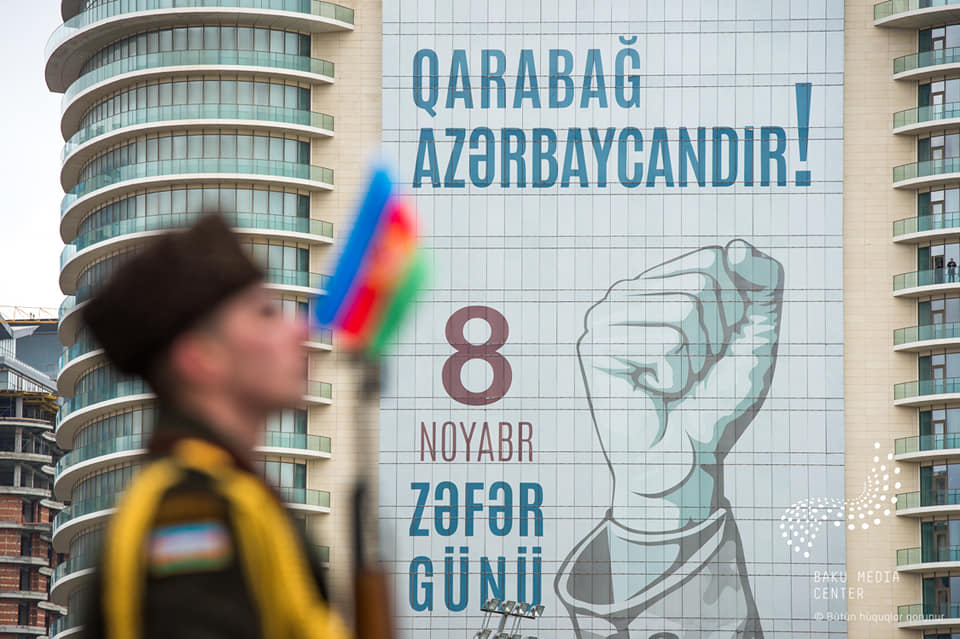
On the morning of September 27, 2020, the Armenian Armed Forces began a large-scale provocation and intensively fired at the positions and settlements of the Azerbaijani army on the front line from large-caliber weapons, mortars, and artillery. The command of the Azerbaijani army decided to launch a rapid counteroffensive along the entire front. As a result of the clashes on September 28, martial law and general mobilization were declared in Armenia, and martial law and a curfew were declared in Azerbaijan. The clashes quickly flared up and escalated into the Second Karabakh War.
As a result of the 44-day war with the Republic of Armenia, Jebrail was liberated on October 4, Fizuli on October 17, Zangelan on October 20, Gubadli on October 25, and Shusha on November 8. According to the agreement signed in Moscow from November 10 at 01:00 Baku time, hostilities were completed and fire ceased in the zone of the Nagorno-Karabakh conflict. The Republic of Armenia undertook to withdraw all its troops from the territory around Nagorno-Karabakh by December 1. It was announced that the construction of new transport communications connecting the two countries will be ensured.
Aghdam was liberated on November 20, 2020, Kalbajar on November 25, 2020, and Lachin on December 1.
The first decree of the President of Azerbaijan on the establishment of Victory Day in Azerbaijan was issued on December 2. According to this order, Victory Day was to be celebrated annually on November 10. However, given that November 10 in Turkey is the day of memory of Mustafa Kemal Ataturk, on December 3, President of the Republic of Azerbaijan Ilham Aliyev decided to change the date of Victory Day. Considering the historical significance of the city of Shushi and its liberation from occupation, it was decided to celebrate Victory Day on November 8 every year.
Note: since 2006, when a public holiday falls on a day off, the next business day is considered non-working.
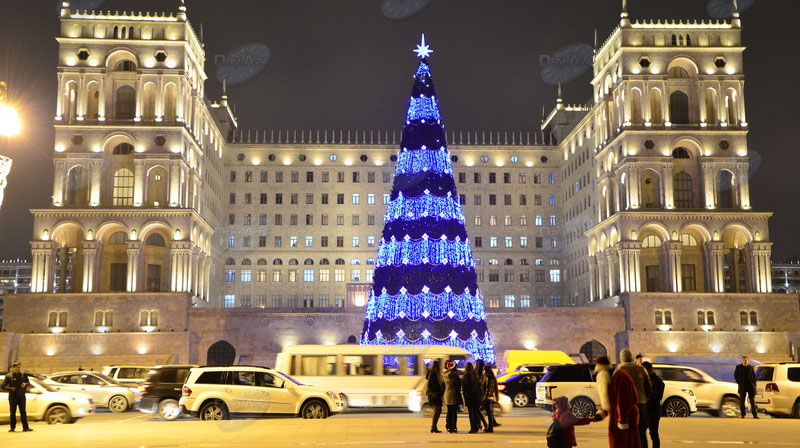
January (‘Janvarus’ in Latin), named in the honor of ancient Rome God Yanus, is the first month in the Gregorian calendar adopted in 1582. By the order of the Russian tsar Peter I, the Gregorian calendar was replaced by the Roman calendar. According to that order January — the date of the birth of Jesus, was declared the beginning of the year and the 18th century started from January 1st, 1701.
The calendar was officially adopted in the former Soviet Union by the decree of V.I. Lenin in 1918. If New Year started on the 13th day of each month till that period, now the matter settled and January the 1st determined New Year day and the day of the holiday.
The same calendar is still applied in the Republic of Azerbaijan even after it gained its independence and the 1st of January is a national holiday.
From 2006, January 1-2 count as holidays.
Note: since 2006, when a public holiday falls on a day off, the next business day is considered non-working.

The 8th of March is the international day of solidarity of women in the struggle for economic, social, and political equality. Celebration of the International Women Day was adopted with the proposition of K. Setkin in 1910 at the 2nd International Conference (at Copenhagen) of the socialist women. The first countries celebrating this day were Germany, Austria, Switzerland, and Denmark. In Russia, this day was celebrated in 1913 and in 1917 in Azerbaijan. Till 1914 the International Women Day was celebrated on different dates. Celebration of the Day on the 8th of March became a tradition after the women of Austria, Hungary, Russia, the USA, and other countries started to celebrate the day of their solidarity on that date.
Since that time the 8th of March is the day of solidarity for peace in the world. It is not working day since 1965 when the former USSR declared the 8th of March to be a holiday.
Even after it gained independence, Azerbaijan celebrates the 8th of May as International Women’s Day thus nobody works on that day.
Note: since 2006, when a public holiday falls on a day off, the next business day is considered non-working.
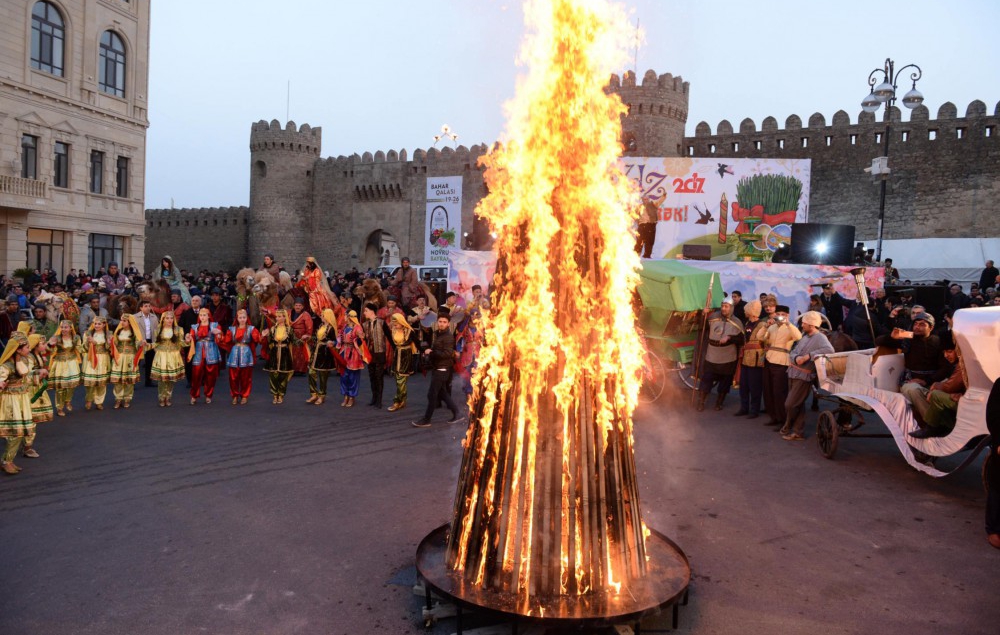
Novruz is widely celebrated in our country as the symbol of winter’s leaving and spring’s coming.
Novruz is celebrated on the first day of spring. The first day of spring on the calendar is determined by the annual circling of the sun.
According to scientists, the holiday has an ancient history. Scientific researches relate the Novruz holiday with the period of the prophet Zardush that dates 3500-5000 years back.
This holiday was celebrated in ancient Babylon for 12 days beginning in Nisan (March, April) 21. each of the 12 days had its ceremonies and enjoyment. According to the first inscription, the holiday of Novruz was established in 505 B.C.
Islam figures always try to explain this holiday from a religious point of view. But the prominent enlighteners Firdovsi, Rudaki, Avicenna, Nizami, Sadi, Hafiz and others proved that the age of Novruz is older. Nizami’s ‘Siyasetname’ and Omar Khayyam’s ‘Novruzname’ dedicated to Novruz holiday.
Novruz was unofficially celebrated in the Soviet period, for the reason that the government prohibited the celebrations and pursuit of people. Despite all that, each Azerbaijan family followed the hundred years old traditions and celebrated Novruz.
Nature starts to wake in Novruz and Azerbaijan people demonstratively celebrate it a month ago. On Tuesdays, we celebrate Su Charshabnasi (water — Tuesday), Odlu Charshanba (fire— Tuesday), Torpag Charshanba (land — Tuesday) and Akhir Charshanba (final or wind — Tuesday). According to the folk belief water in the first Tuesday purifies and stirs, fire on the second Tuesday, land on the third Tuesday and wind on the fourth Tuesday awaken nature, the trees begin to blossom; all this symbolize spring’s coming.
Noruz holiday is rich with ancient traditions and games. ‘Khidir Ilyas’ the symbol of productivity and blossom),’Kos-Kosa’- funny square game (the symbol of spring’s coming) and fortune-telling are among them.
Novruz also has Interesting traditions relating to water and fire. Being the land of the fire Azerbaijan has rich traditions relating to it. The fire is the symbol of purification and clarification. Bonfires are made in Novruz and before the holiday comes people in Akhir Charshanba, despite the age and gender, jump seven times over one, or once over 7 bonfires and say: ‘Give me your redness and take my yellowness.’ The fire is never put out by water; it burns down by itself. Young boys and girls take the ash of the fire and throw it far from the house. It is explained as follows: all the mischance of the family is thrown away with the ash.
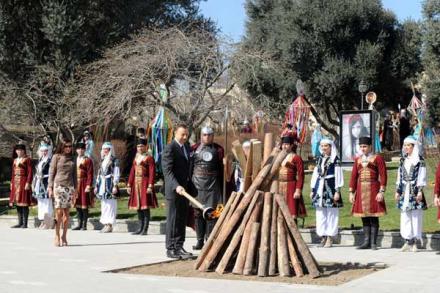
Purification by water is related to the real peculiarity of water. Traditions related to water symbolize New Year in Azerbaijan. Jumping overflowing water in the New Year one clears himself from his past year’s faults. The members of the family splash water on themselves before going to bed at night on the eve of New Year day. They say all flowing waters cease in Akhir Charshanba and everything bound to it, even trees bound down. Who drinks from this water on the evening of the New Year saves himself from all the diseases in the coming year.
The peak of Novruz is the time when the past year gives its turn to a new one. According to old traditions shootings from the pistols were heard in the honour of Novruz at that moment. In the N. Dubrovin wrote about it in the 19th century: ‘Shootings in the cities and the villages informed springs coming to Azerbaijan.’ Adam Oleary, the witness of Novruz holiday in 1637 wrote: ‘ Astrologer very often stood up his place and determined the height of the un with astronomic equipment and sun-clock and at the moment of equinox he said: ‘New year has come at the same moment shootings started, music heard at the towers and walls of the city. Spring holiday started.’
Azerbaijanis pay particular attention to the table laid for the holiday. There should be 7 varieties of food on the table the names of which starts with the letter ‘S’, for example, sumakh (a kind of spice), sirke (vinegar), sud (milk), samani (grown wheat), sebzi (fried meat with greens) etc. A mirror, with coloured eggs on it and candles should also be on the table. The candle is the symbol of fire and light(keeping a person from damage), the mirror is the symbol of happiness.
According to the tradition, all the members of the family should be at home on the first day of the holiday. People say: ‘If you are not at home on the day of the holiday, you will live without a home for seven years.’ The outer doors were kept open in the past. On the first day of the new year, the lights are kept turned on the whole night, for turned off light and fire is the symbol of misfortune.
Celebrating Novruz people in the villages determine the peculiarity of the coming year: whether it will be either arid or rainy and determine the degree of productivity. According to the tradition, the first day of Novruz symbolizes spring, the second day after it is summer, the third day is autumn and the fourth is winter. If the first day is windless and arid, so the spring is going to be favourable for agricultural works, and if it is rainy and windy so the spring is expected to be the same. On the rest of the days, they determined summer, autumn and winter.
Novruz is a fun and favourite holiday. Novruz is a holiday that embraces all of our people.
Note: since 2006, when a public holiday falls on a day off, the next business day is considered non-working.
Years of the II World War in the 20th century was the most difficult and terrible period for all mankind. Fascism born in Germany and Italy kept under danger not only those countries but also the whole of the world.
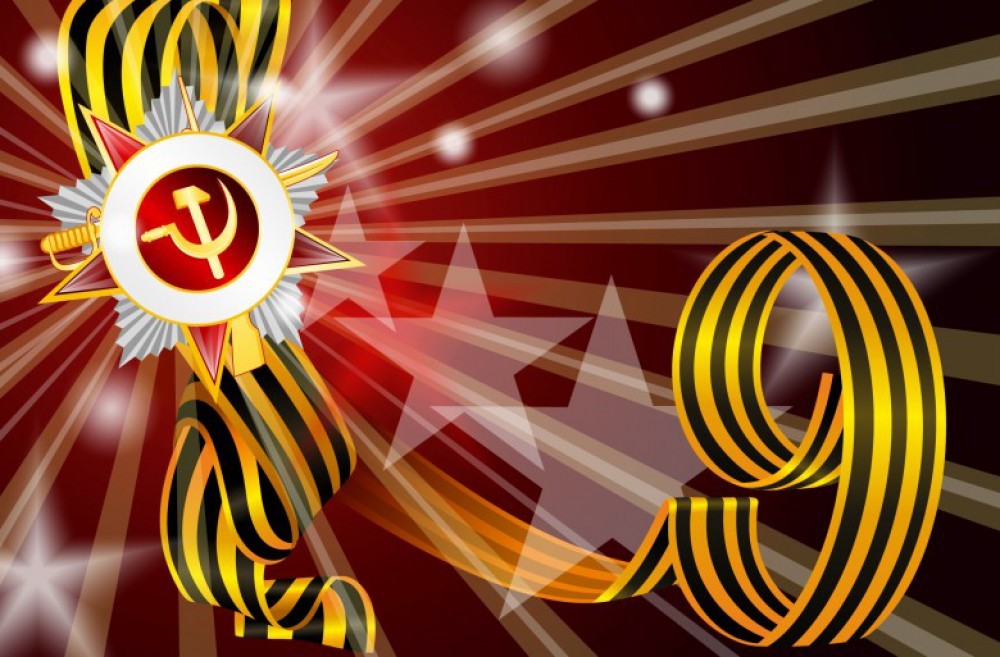
In the period of the II World War Azerbaijan, people showed courage and heroism not only in front lines but in the back front as well. A battalion of 87 plains-destroyers and 1224 self-protecting groups was established in the country in a very short period of time. More than 600 000 Azerbaijani young fellows and girls were sent to the front in 1941-1945. Divisions from Azerbaijan moved from the Caucasus to Berlin. About 130 of our compatriots deserved the name of the Hero of the Soviet Union, 30 deserved the order of Honour. 170 000 Azerbaijani soldiers and officers had been awarded various orders and medals of the USSR. Hazi Aslanov-twice Hero of the Soviet Union, the Heroes of the Soviet Union — Israfil Mammadov, Ruslan Vezirov, Adil Guliyev, Ziya Bunyatov, Garay Asadov, Melik Maharramov and Mehdi Huseynzadeh, general Mahmud Abilov, Akim Abbasov, Tarlan Aliyarbeyov and Hajibala Zeynalov and many others brought honour to the history of our people.
Much done with the purpose to direct the activity of the republic economy to the front. Light and food industries started to work for the front. In a small period of time, Baku turned into an important arsenal of fighting armies. Despite all the difficulties, oil workers worked hard and managed to supply the front and the economy with fuel.
Under the leadership of the academician, Yusif Mammadaliyev established new technology that produced aviation petrol. With the hard work of our oilmen, oil production in Azerbaijan reached its peak in 1941 that made 23.5 million tons. That figure comprised 71.4% of all the oil produced in the USSR. Azerbaijani oil workers gave 75 million tons of oil and 22 million tons of petrol to the country during the war years. It is possible to say that Baku oil was one of the main factors in the victory over fascism. Four of each 5 plains, tanks and motor cars worked with Baku petrol. The II World War was the next to prove of heroism and courage of the Azerbaijanis.
Note: since 2006, when a public holiday falls on a day off, the next business day is considered non-working.
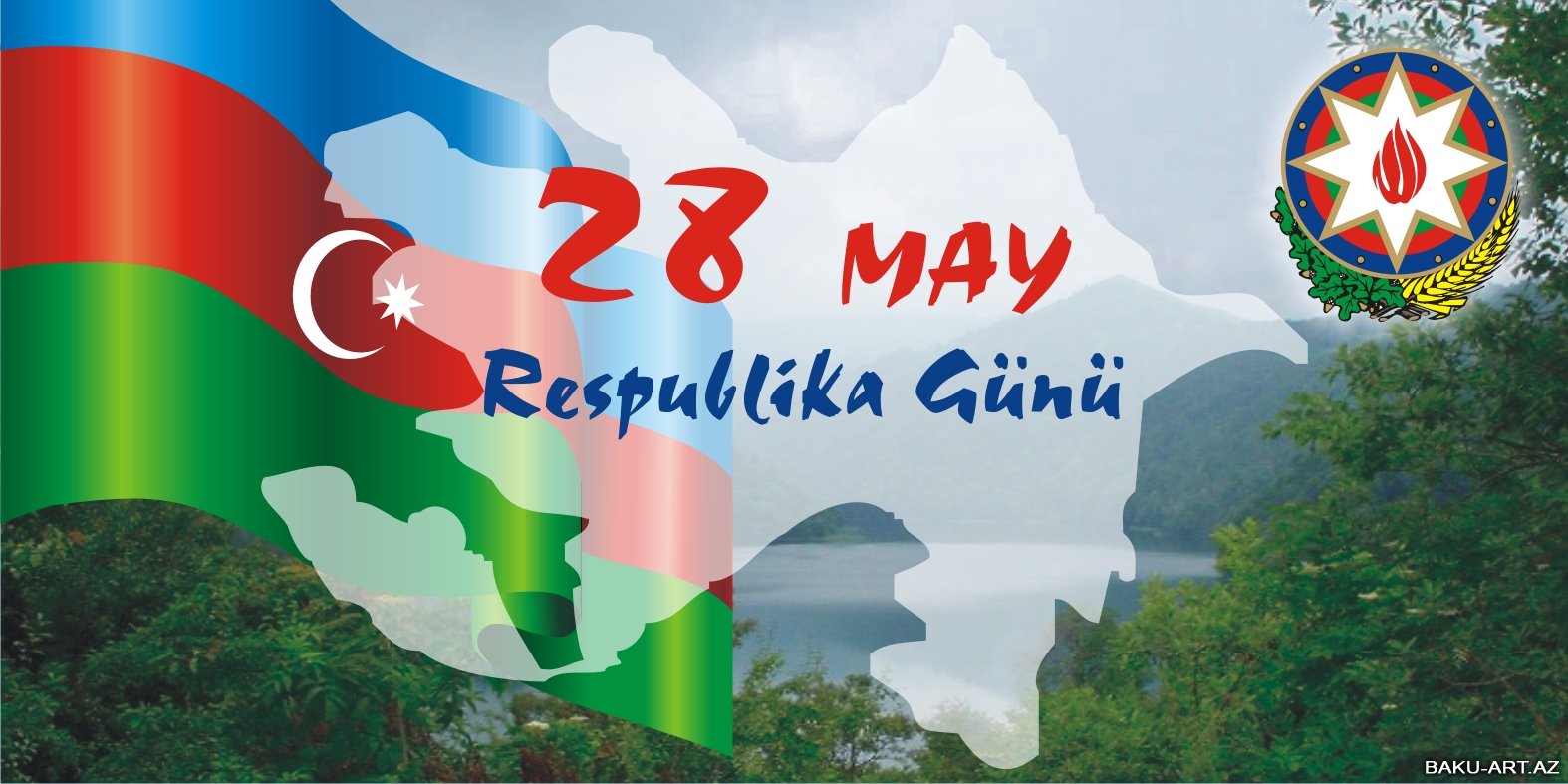
Azerbaijan was the colony of Russia for a long period of time. Azerbaijan people always struggled for freedom and independence.
The 20th century is known in history not only as of the Age of science and techniques but also the age of freeing of the people from the colon and the establishment of national states.
The revolution in 1917 in Russia put a cut-line to the ruling of the Romanovs family and the Russian Empire collapsed. Nations had to determine their faith. Using this opportunity, patriotic sons of Azerbaijan declared the Democratic Republic of Azerbaijan on May 28, 1918.
It was the first Democratic Republic in the whole East. ADR war a parliamentary state. It also had state attributes — the flag, the anthem, and the arms. Three colored flags symbolized Turkism, Islamism, and European tendency. The ADR existed only for 23 months. On April 28, 1920, the 11th army of the Bolsheviks occupied Azerbaijan and Republic collapsed.
The Day of the Republic- the day of regaining state independence has been celebrated as the state holiday since 1990.
Note: since 2006, when a public holiday falls on a day off, the next business day is considered non-working.
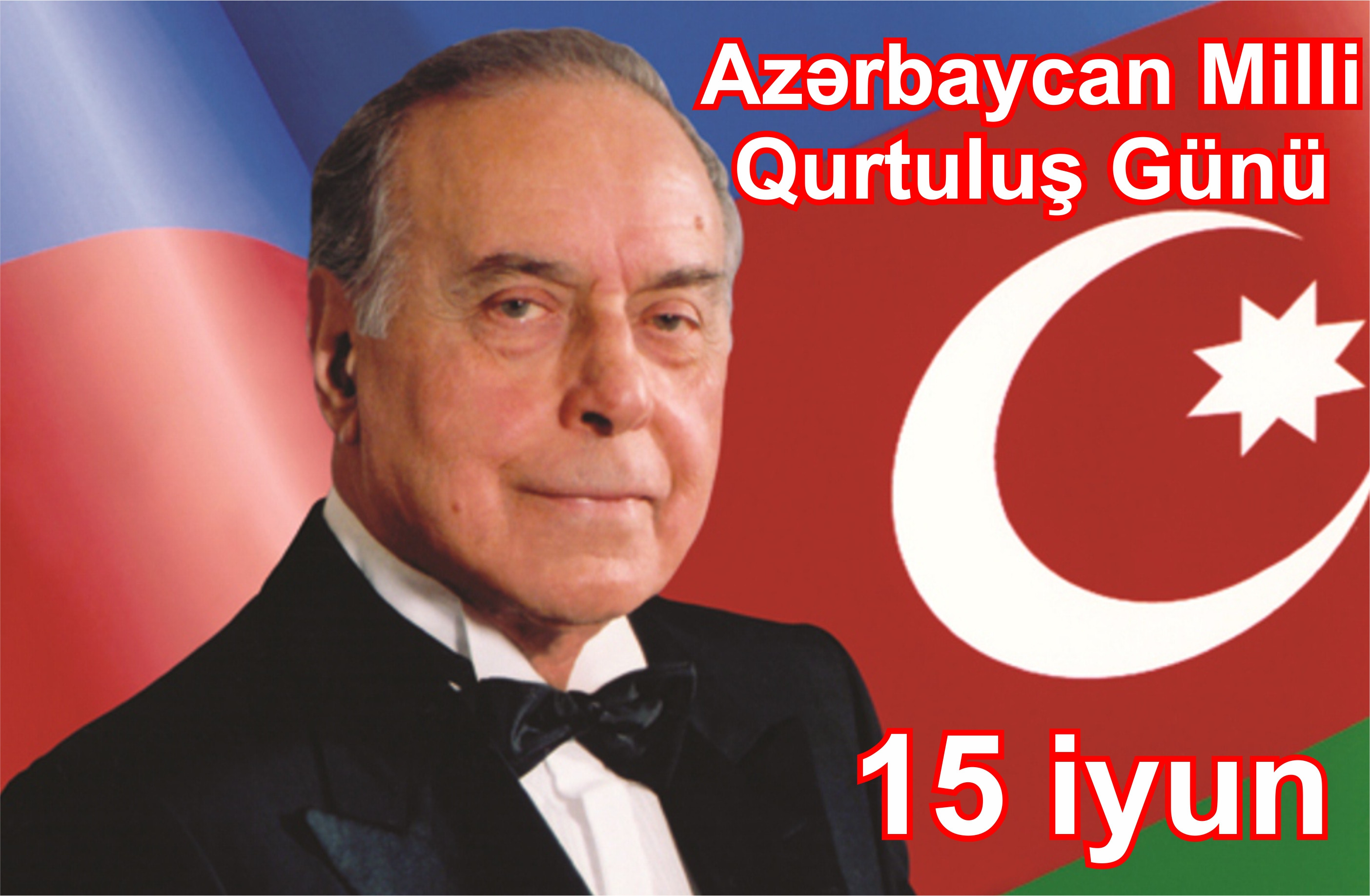
Azerbaijan got its independence in October 1991. The first years of independence are characterized by the crisis within the country and in the government. Chaos occupied all the spheres of social life. The case was more hard in the army, increased the quantity of desertion. Armenian increased their occupation day by day. Azerbaijan remained without ahead. Separate individuals and groups struggled among themselves for power in the young republic. National Front occupied the power of the state on May 14, 1992, and on the first days of its ill-determined ruling shower inability to lead the state. In 1993 Azerbaijan faced the danger of the civil war.
On such a hard period of time, people invited the prominent son of Azerbaijan Heydar Aliyev from Nakhchivan to Baku. With the insistence of the people and the authorities of the republic, he came to Baku on June 19.
In a short period of time, Heydar Aliyev prevented civil war in Azerbaijan.
On June 15, 1993, Heydar Aliyev was elected the chairman of the Supreme Soviet of the Republic of Azerbaijan and this date entered our history as the Day of National Salvation. With the insistence of the people in June 1997, Milli Mejlis (National Assembly) declared June 15 a holiday.
Note: since 2006, when a public holiday falls on a day off, the next business day is considered non-working.
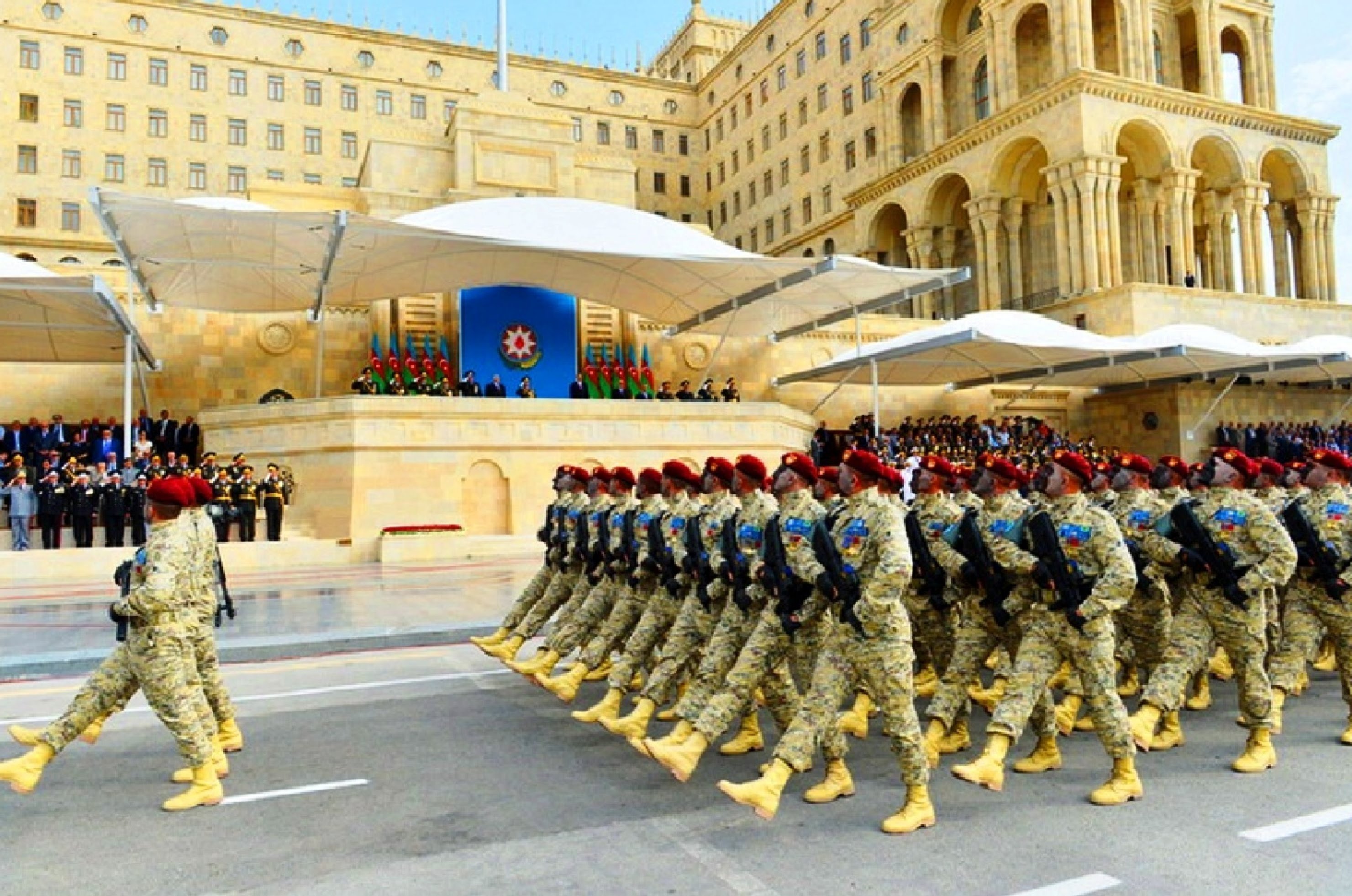
Much done in the country despite that Azerbaijan Democratic Republic established on May 28, 1928, existed for 23 months. One of them was carried out in the sphere of army creation. It is a very complicated process. The ADR had no national army when established. It is the fact that no state may live without an army. In addition to all the above mentioned, the condition was difficult. Bordering countries clearly expressed their wish to occupy the young Azerbaijan Democratic Republic.
Since the first day of the national state Armenia started to show serious armed attempts to extend its territories at the expense of Azerbaijan’s.
Under the decision of the government of the Azerbaijan Democratic Republic on June 26, 1918, established the first military unit-separate corpus. This decision gave the legal opportunity to the first democratic government of the Muslim East to establish its own army. Then followed the state decree about the military obligation-call to the army. The measures taken by the Azerbaijan government in the establishment of the national army showed their results very soon. Azerbaijan National Army could resist the Armenian army.
On October 9, 1991, the Supreme Council of the Republic of Azerbaijan adopted the decision on the establishment of the Army.
June 26 declared the Day of the Forced Arms according to the decision of the President of the Republic of Azerbaijan from May 22, 1998.
Note: since 2006, when a public holiday falls on a day off, the next business day is considered non-working.
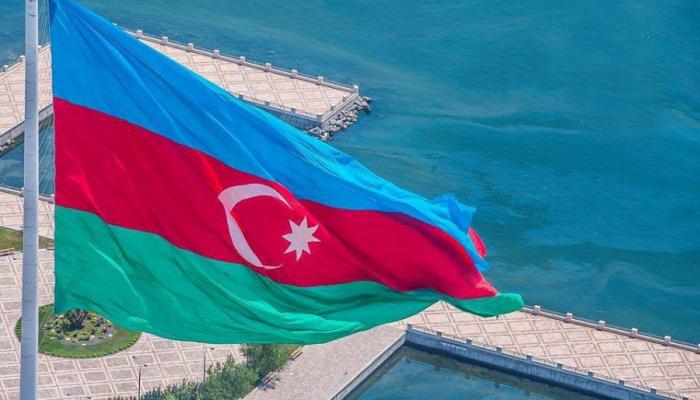
Thanks to the favourable historical condition established after collapsing of the Soviet Union in the late 20th century Azerbaijan people gained its independence in the 20th century for the second time. It was the second prominent achievement in the political history of our people.
Thanks to the activity of the democratic powers in Russia it was impossible to suppress non-subordination to the central power and wish independence in the republic. At the out of order meeting called under the will of the people on the 30th of June in 1991, the Supreme Council of the Republic of Azerbaijan adopted a declaration about the restoration of the state independence of the Republic of Azerbaijan.
At the session of the Supreme Council of the Republic of Azerbaijan on the 18th of October, 1991, adopted Constitutional Act ‘About the State Independence of the Republic of Azerbaijan’.
The referendum was held in the Republic of Azerbaijan on December 29th. The bulletin of the referendum reflected a question: ‘Do you support the Constitutional Act ‘About the State Independence of the Republic of Azerbaijan’ adopted by the Supreme Council of the Republic of Azerbaijan?’
Azerbaijan people unanimously supported state independence.
In May 1992 Milli Mejlis adopted the State hymn (music by Uzeyir Hajibeyov, words by Ahmed Javad) of the Republic of Azerbaijan and soon after it, three coloured flags and the state anthem in the form of an 8-point star with fire in the centre of it
Azerbaijan is an independent and sovereign state since October 18, 1991, which we celebrated as a holiday.
Note: since 2006, when a public holiday falls on a day off, the next business day is considered non-working.
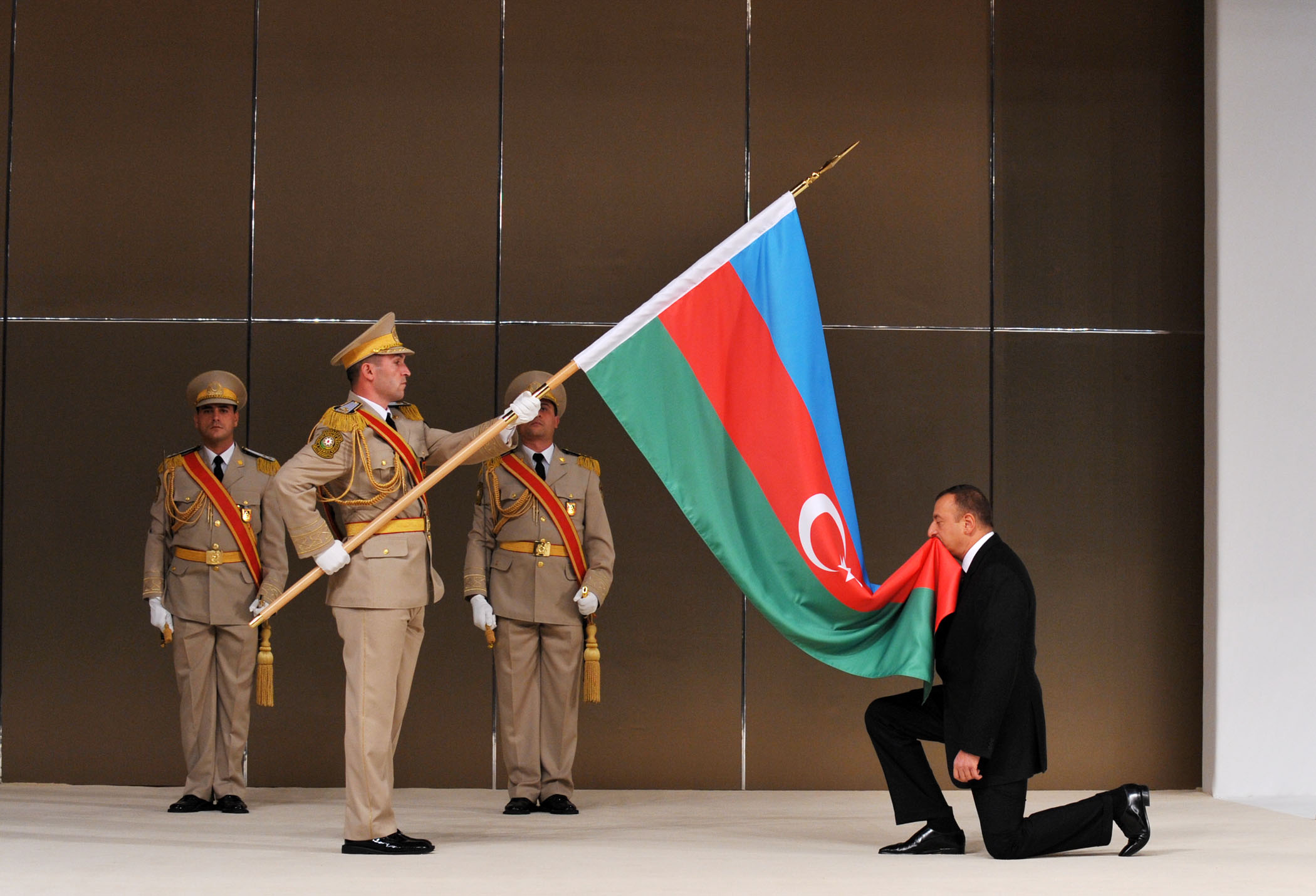
The three-color national flag of Azerbaijan was accepted by the government of the Democratic Republic of Azerbaijan on November 9, 1918. After the collapse of the Democratic Republic on April 28, 1920, and the establishment of the Soviet regime this flag was relinquished in Azerbaijan.
Yet the flag was restored by the order of the Supreme Mejlis of the Nakhchivan Autonomous Republic and was declared the national flag of the Autonomous Republic on November 17, 1990. At the same time, the Supreme Mejlis of Nakhchivan Autonomous Republic petitioned the Supreme Council of the Azerbaijan SSR for recognition of the three-color flag the national flag of Azerbaijan.
The Supreme Council of the Azerbaijan Republic considered the petition of the Supreme Mejlis of Nakhchivan Autonomous Republic and approved the three-color flag the national flag of the Azerbaijan Republic on February 5, 1991.
The national flag of the Azerbaijan Republic consists of three equal strips. The upper strip is of blue color, the middle of red, the lower is green. The blue strip designates the Turkish origin of the Azerbaijan Republic, the red color-its intention to create a modern state and develop democracy, the green strip-its relation to the Islam civilization. In the middle of the red stripe on both sides of the flag, there is a white-color crescent and an eight-point star. The relation between the width and the length of the flag is 1 to 2.
On November 17, 2009, President Ilham Aliyev signed an order on celebrating November 9 every year as the State Flag Day in Azerbaijan. This flag, which is the memory of the People’s Republic of Azerbaijan, was adopted on November 9, 1918, in the sitting of the Government of the People’s Republic. According to the order, November 9 every year is celebrated as the State Flag Day of the Republic of Azerbaijan. Order of the President of the Republic of Azerbaijan on establishing the State Flag Day of the Republic of Azerbaijan After the Republic of Azerbaijan restored independence, the State Flag of Azerbaijan has become one of the sacred attributes of statehood to all citizens of our country as the symbol of national sovereignty. As the memory of the People’s Republic of Azerbaijan, this flag demonstrates our devotion to the idea of liberty, national and moral values, and universal ideals.
The State Flag of the Republic of Azerbaijan was adopted in the sitting of the Government of the People’s Republic of Azerbaijan and possessed public status till April 1920. That flag was approved as the State Flag of the Autonomous Republic of Nakhchivan in the session held on November 17, 1990, at the initiative and under the leadership of Chairman of the Supreme Assembly of the Autonomous Republic of Nakhchivan, national leader Heydar Aliyev. On February 5, 1991, the Supreme Soviet of the Republic of Azerbaijan designated the flag as the State Flag, adopting the Law ‘On the State Flag of the Republic of Azerbaijan’.
With the Constitutional Act ‘On state independence of the Republic of Azerbaijan’ of October 18, 1991, the Republic of Azerbaijan restored the state attributes, including the State Flag of the Republic of Azerbaijan as its legacy. Adoption of Law of the Republic of Azerbaijan ‘On the rules for the use of the State Flag of the Republic of Azerbaijan’ on June 8, 2004, improved the legislative source in this field.
The State Flag is raised on the buildings of public agencies and diplomatic representations of our republic, personifies the national unity in influential ceremonies, assemblies, large-scale public-political meetings, cultural events, and sports contests. Order of the President of the Republic of Azerbaijan ‘On creation of the State Flag Square in Baku City, the capital of the Republic of Azerbaijan’ of November 17, 2007, determines the special place of the State Flag among the state attributes.
Taking into consideration that the State Flag of the Republic of Azerbaijan was for the first time adopted on November 9, 1918, to assure respect and honor to the state attributes of the Republic of Azerbaijan, I decide:
1. November 9 every year shall be celebrated as the State Flag Day of the Republic of Azerbaijan.
2. The Cabinet of the Republic of Azerbaijan shall solve issues related to this order.
Ilham Aliyev,
President of the Republic of Azerbaijan.
Baku, November 17, 2009.
Note: since 2006, when a public holiday falls on a day off, the next business day is considered non-working.
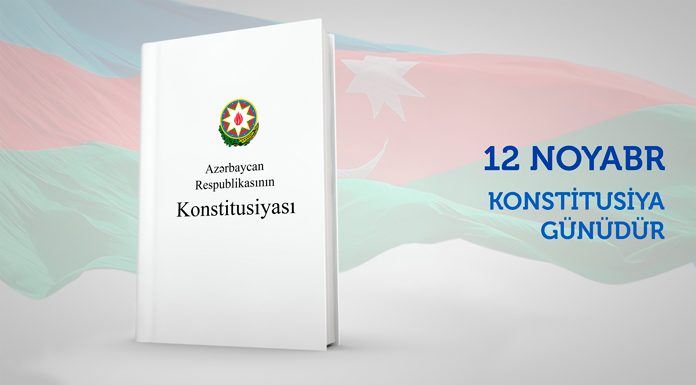
The Constitution of the Republic of Azerbaijan adopted in 1995 was the first Constitution of independent Azerbaijan. The Azerbaijan Democratic Republic existed for 23 months during 1918-1920 did not have the main Law of the state. The history of the Constitution of the Azerbaijan Republic mainly dates from the period when Azerbaijan was the Soviet Republic.
The first Constitution of Azerbaijan was adopted on the 19th of May, 1921 at the All-Azerbaijan Soviets Congress. A new variant of the Constitution of Azerbaijan SSR fitted to the Constitution of the USSR of 1921, adopted at the 4th All-Azerbaijan Soviets Congress on the 14th of March, 1925. The final Constitution of Azerbaijan SSR adopted on the 21st of April 1978, was fitted to the Constitution of the USSR like the previous.
After Azerbaijan got its independence appeared necessary to work out a new Constitution. A commission headed by Heydar Aliyev was established with this purpose. The project of the Constitution was presented to the referendum. The first Constitution of independent Azerbaijan was adopted with the referendum on the 12th of November, 1995.
The first Constitution of independent Azerbaijan put the basis of the state establishment of the Republic of Azerbaijan. The New Constitution of Azerbaijan is composed of 5 parts, 12 chapters, and 158 articles.
Beginning from that day we celebrate November 12 as the Day of the Constitution of the Republic of Azerbaijan.
Note: since 2006, when a public holiday falls on a day off, the next business day is considered non-working.
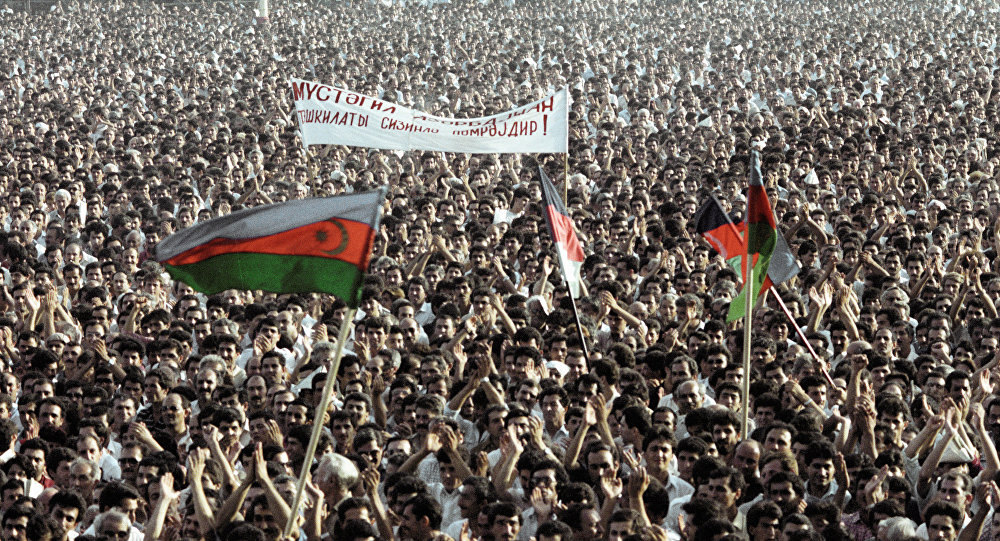
On the first days of 1988, Armenia started its evident attack against Azerbaijan. Basing on the indifferent attitude of Moscow and particularly of M.Gorbachov, the head of the USSR, Armenians started to plan mass deportation of Azerbaijanis from their native lands in Armenia under the direction of the Armenian government. Above 200 000 Azerbaijanis were deported from their homes, killed, and burned by the Armenians. There was no reaction to the Armenian vandalism by M. Gorbachov and his surrounding. In early February 1988 Armenians carried out revolts in the region Nagorny Karabakh of Azerbaijan and even raise a question to join those lands to Armenia.
The people of Azerbaijan expressed their protest to the government. Slogans, portraits, and flags carried by the Azerbaijani citizens proved their belief to Moscow and local authorities at that time.
But getting no serious answer from Moscow and the that-time government, people from every corner of the republic moved to Baku and gathered in Azadlig square (named Lenin Square at that time), they held meetings and evidently express their protest.
On the 17th of November, 1988 the society of Azerbaijan started meeting at Azadlig square in the protest of anti-Azerbaijan policy of the Soviet state. People gathered in a single power and started a movement for freedom. The soviet army destroyed the national meeting at the beginning of December. The abovementioned events are evaluated as the national movement in Azerbaijan and are considered to be important facts in the achievement of independence.
November 17 is celebrated as the Day of National Revival since 1992.
Note: since 2006, when a public holiday falls on a day off, the next business day is considered non-working.
More than 50 million Azerbaijanis live in the world today.
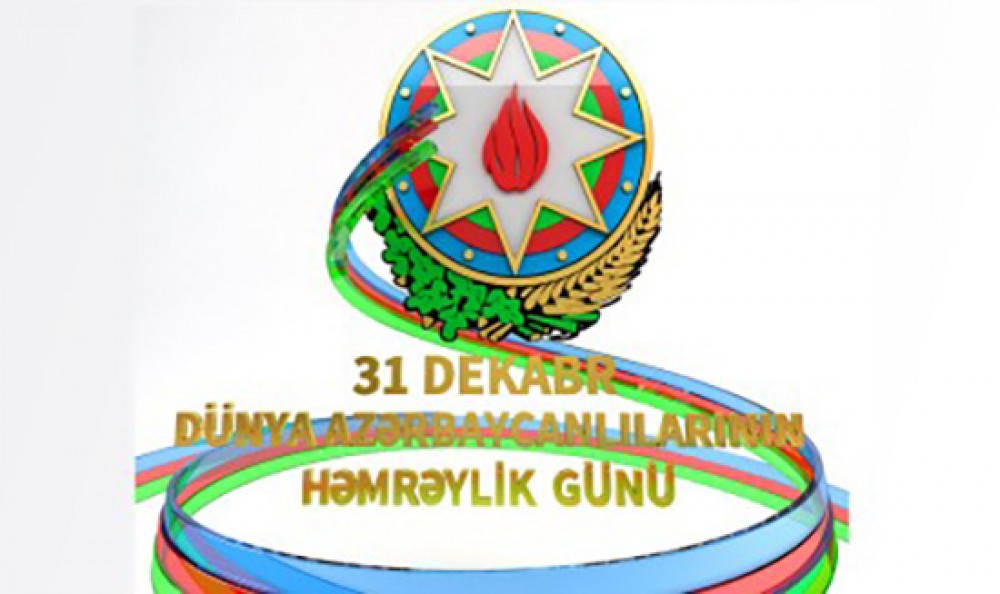
Azerbaijanis made great contributions to the world civilization living in the territory of Azerbaijan for thousands of years. Wars, revolutions, military conflicts, social-political processes in the world destructed Azerbaijan, some of the Azerbaijanis were urged to leave their lands, deported, left their country with the purpose to find work, and get an education and settled in different countries. Today Azerbaijanis live in every corner of the world.
Azerbaijanis who lived in their motherland had not an opportunity to meet with their compatriots and to create relations with them. Prohibitions of the Soviet Period created an obstacle between the relatives. In the late 1980s when the Soviet regime started to weaken people of Azerbaijan increased their attempts to re-establish relations with their compatriots.
The history of the Day of the Solidarity of the Azerbaijanis of the whole world starts from late December 1989 when the borders in Nakhchivan were destroyed (USSR-Iran borderline). Destroyed the frontier beams between Northern and Southern Azerbaijan ruined. The Conference of the Turkish-speaking countries held in Istanbul at that time decided to celebrate the day of the solidarity of the World Azerbaijanis.
On December 16, 1991, the chairman of the Supreme Assembly of Nakhchivan Autonomous Republic Heydar Aliyev took into consideration the importance of solidarity of Azerbaijanis and declared the 31st of December the day of the Solidarity of all the Azerbaijanis of the World. Thus being so near to all the Azerbaijanis, the 31st of December is celebrated as the day of the Solidarity of the Azerbaijanis in the World.
Note: since 2006, when a public holiday falls on a day off, the next business day is considered non-working.
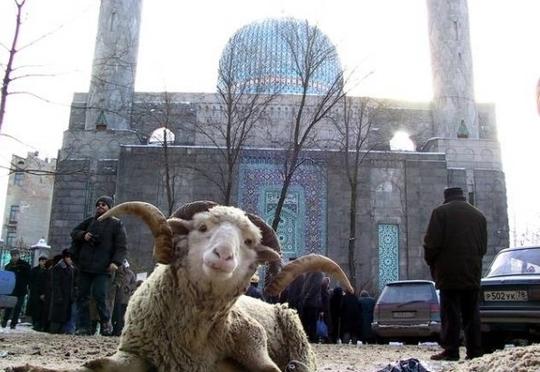
The holiday of Gurban (sacrifice) is one of the grandiose holidays of the Islamic world. Two holidays of Islam eydul-ezha (known as Gurban Bayram) and eydul-fitra (Orujlug — the holiday of fasting, a small holiday) are legalized. As the most important surmises of Islam Gurban Bayram is demanded by Koran.
This holiday is part of a Muslim’s pilgrimage to Mecca. The holiday of Sacrifice is celebrated on the 10th day of the 12th month — Zilhija of the Moslem calendar (Hijri-Gamari calendar) cutting scarifying animals in the period of pilgrimage to Mecca.
The holiday of Sacrifice is not peculiar only to Islam. The ceremony of sacrifice-giving was the tradition of many peoples of the world much earlier in Islam. For instance, the people of Carthage sacrifice their children to Molokhia, their God, to paying their debts. People of the east usually sacrificed their daughters.
The religion of the Excellency prophet Muhammed Islam made a revolution in beliefs and sacrifice to great Allah. Islam prohibits any kind of human sacrifice and says in the name of Allah that an animal should be sacrificed instead of a human. Islam determined the time of sacrifice giving, as before people did it any time they want. To give the holiday more respect it was determined to celebrate it once a year on the 10th day of Zilhija. Koran says: « Allah determined Beytulharam (Sacred house) Caaba, the month Bahram (Zilhije), tied and untied-neck (with and without signs on their necks) sacrifices brought to Caaba to be a way to put into order the lives (religious and world affairs) of the people » (Koran, Sure 5, Aye 97).
It is also possible to bring a sacrifice for the realization of some wish. Religion, religious ceremonies, and holidays were also the objects of criticism in the Soviet period. After Azerbaijan got its independence people again started to respect and follow its religion, national traditions, and national and religious holidays.
Gurban Holiday lasts 2 days.
Note: since 2006, when a public holiday falls on a day off, the next business day is considered non-working.
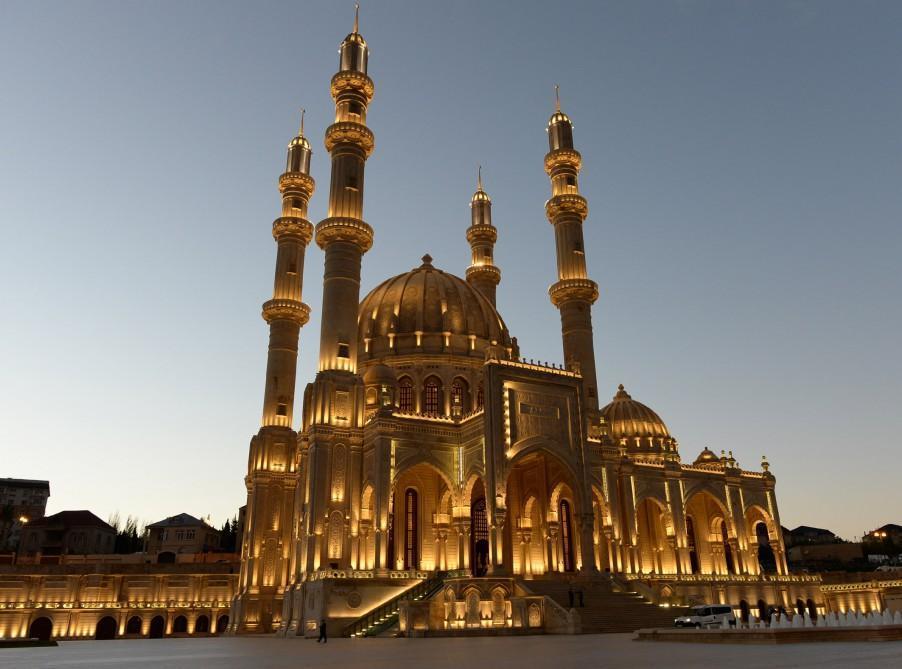
The sacred holiday Ramazan was determined for the Moslems in the second pilgrimage year (year 622). Ramazan teaches people how to love Allah, to test their will and patience, it makes people be clever and honest and is celebrating in the form of fasting.
The history of Orujlug (fasting) starts when the prophet Muhammed determined the month Ramazan for this holiday in Madina on the second pilgrimage year. Koran was given to us on one of the third 10 days of this month. As said, this might happen either on the night from 23rd to 24th or on the night from 26th to 27th. This night is called « Laylat alkadr »-meaning the great, powerful night. Koran says: « We really create power and grandeur on that night, that night is more grandiose among thousand of months, the angels low down on the earth and wait for orders from Allah, peace is brought to the world on this night till the sun-birth » (97:1-5).
It is prohibited to eat, drink, smoke, and engage in marriage duties in the light part of the day. The exception is given only to children, to the patients, the pregnant, fighting in the war, and voyagers (travelers). Fasting starts in Ramazan from the day when the new moon is seen and continues for 29-30 days. Koran says: « Eat and drink till you may distinguish white and black thread, then fast till it gets dark » (2:187).
Fasting existed before Islam. The ancient Arabians fastened for the sake of their Gods. Koran says: « Fasting ordered to you as it had been ordered to your predecessors ».
Fasting is completed with the holiday of « id al-fitr ». All the wealthy Moslems on that day should help the poor. All the members of the family should be taken into consideration while making fitra. Orujlug is celebrated officially since 1993.
Ramadan Holiday lasts 2 days.
Note: since 2006, when a public holiday falls on a day off, the next business day is considered non-working.
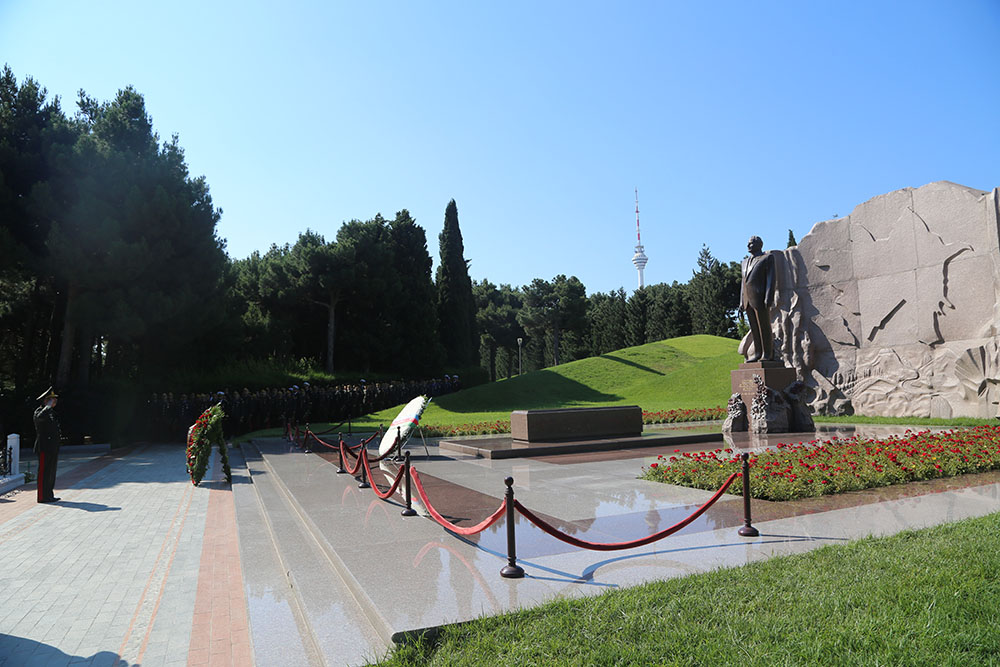
Azerbaijan is a unique country with ancient history, rich culture and specific statehood traditions. For important geographic-strategic position, Azerbaijan has always been on the junction of civilizations. In ancient times and Middle Ages Azerbaijan was one of the political, commercial and cultural centres in Near and Middle East. Because of this strong states having a big impact on political and ideal-cultural processes of East have historically been created in Azerbaijan.
Possessing specific place in world culture the people of Azerbaijan presented powerful geniuses to the universal civilizations. The vast majority of them lived in XIX and early XX centuries, some were our contemporaries.
Some of these people who have brought eternal fame to our people and Homeland have been buried in Honorary Cemetery located in the mountainous part of Baku. These are figures of science, literature, culture and art, those being awarded the title of Hero of Soviet Union for personal heroism shown in the fights during WWII (1939-45) against German fascists, top state officials during Soviet power, people of labour having worked in different fields of economy and agriculture and awarded the honour titles.
Of course, some of former Bolsheviks, party and soviet employees having supported the establishment and strengthening of the Soviet power also have been buried in Honorary Cemetery. But this is also our history and we should accept that as it is.
Besides, among those buried in Honorary Cemetery, there are persons that were not born in Azerbaijan but lived here and considered Azerbaijan as their second Homeland.
Honorary Cemetery was established upon Order 680 of August 27, 1948, of Ministers Soviet of Azerbaijan SSR. The same year construction of Honorary Cemetery started. According to the list enclosed to the Order, graves of outstanding figures of literature and culture Jalil Mammadguluzade, Abdurrahim bey Hagverdiyev, Najaf bey Vazirov, Hasan bey Zardabi, Huseyn Arablinsky, Suleiman Sani Akhundov, Ali Nazmi, Jabbar Garyagdy oglu, Rustam Mustafayev, Azim Azimzade and Huseyngulu Sarabsky had to be moved to Honorary Cemetery and gravestones set to them.
Upon that Order, gravestones had to be set to Molla Vali Vidadi in Gazakh, Seydi Azim Shirvani and Mirza Alakbar Sabir in Shamakhy.
Prominent persons died after the creation of Honorary Cemetery were buried there as a rule. So, Honorary Cemetery has become the frequently visited site.
On December 15, 2003, national leader of world Azeris, architect and constructor of the modern state of Azerbaijan, everlasting son of Azerbaijan Heydar Aliyev was buried in Honorary Cemetery. Since then, millions, including heads of state and government paying official visits to Azerbaijan, prestigious delegations, Azeris living abroad have visited Honorary Cemetery to honour the great leader.
Our people will always respect the blessed memory of its great persons.
BURIED IN THE HONORARY CEMETERY
Last name, first name, patronymic | Dates |
Aliyev Heydar Alirza | 1923-2003 |
Abbasaliyev Sabit Gasim | 1932-1982 |
Abbasov Akim Ali | 1911-1992 |
Abbasov Gurban Abbasgulu | 1926-1994 |
Abdulla Shaig (Talibzadeh Abdulla Mustafa ) | 1881-1959 |
Abdullayev Hasan Mammadbaghir | 1918-1993 |
Abdullayev Mikayil Huseyn | 1921-2002 |
Abramovich Mikhail Vladimir | 1884-1965 |
Adigozalov Vasif Zulfugar | 1935-2006 |
Agha Nematulla | 1896-1958 |
Aghamalioghlu Samad agha Hasan | 1867-1930 |
Aghayev Bahram Jafar | 1884-1956 |
Aghayev Boyuk Mammad | 1907-1965 |
Aghayev Musa Isgandar | 1914-1965 |
Aleksandrov Iosif Aleksandr | 1893-1968 |
Almaszadeh Gamar Hajagha | 1915-2006 |
Aydınbeyov Salam Mugtadir | 1912-1967 |
Babazadeh Baba Gurbangulu | 1911-1962 |
Baghirova Besti Mesim | 1905-1962 |
Bayramov Ali Bayram | 1889-1920 |
Bayramova Jeyran Shirin | 1896-1987 |
Bayramzadeh Alirza Bakhshali | 1911-1963 |
Behbudov Rashid Majid | 1915-1989 |
Belov Sergey Andrey | 1911-1967 |
Bedirbeyli Leyla Aghalar | 1920-1999 |
Bashir Seferoghlu | 1925-1969 |
Bokov İvan Vasily | 1879-1952 |
Bulbul (Mammadov Murtuza Mashadi Rza ) | 1897-1961 |
Bunyadov Bashir Nurali | 1895-1967 |
Bunyadov Ziya Musa | 1923-1997 |
Jabbarli Jafar Gafar | 1899-1934 |
Jabir Novruz (Novruzov Jabir Mirzabey ) | 1933-2002 |
Jahangirov Jahangir Shirgasht | 1921-1991 |
Jafarov Jafar Hashim | 1914-1973 |
Jafarov Jafar Huseyngulu | 1915-1957 |
Jafarov Saftar Mammad | 1900-1961 |
Jafarov Vagif Jafar | 1949-1991 |
Jalilov Afiyaddin Jalil | 1946-1994 |
Chikaryov Ivan Nikifor | 1881-1928 |
Dadashov Museyib Mirza | 1896-1981 |
Dadashov Sadig Alakbar | 1905-1946 |
Dashkov Aleksey Semyon | 1915-1965 |
Davudova Merziye Yusif | 1901-1962 |
Abdürrahmanov Fuad Hasan | 1915-1971 |
Abilov Ibrahim Maharram | 1881-1923 |
Abilov Mahmud Abdulrza | 1898-1972 |
Abulfaz Elchibay (Aliyev Abulfaz Gadirgulu ) | 1938-2000 |
Afandiyev Fuad Aladdin | 1909-1963 |
Afandiyev Heydar Khalil | 1907-1967 |
Afandiyev İlyas Mahammad | 1914-1996 |
Ahmadov Aghamirza Mirzali | 1905-1964 |
Alakbarov Alasgar Hajagha | 1910-1963 |
Alakbarova Shovkat Feyzulla | 1922-1993 |
Alasgarov Suleyman Eyyub | 1924-2000 |
Alasgarova Shamama Mammadkarim | 1904-1977 |
Ali Nazmi (Ali Mammadzadeh) | 1878-1946 |
Alibayli Anvar Aliverdi | 1916-1968 |
Aliyev Agil Alirza | 1926-2006 |
Aliyev Aziz Mammadkarim | 1897-1962 |
Aliyev Firudin Ali | 1936-1983 |
Aliyev Gulbala Aghabala | 1879-1971 |
Aliyev Hashim Bedel | 1892-1919 |
Aliyev Hasan Alirza | 1907-1993 |
Aliyev Kamil Museyib | 1921-2005 |
Aliyev Mahmud Ismayil | 1908-1958 |
Aliyev Mammadali Dostali | 1912-1965 |
Aliyev Mirzagha Ali | 1883-1954 |
Aliyev Tamerlan Aziz | 1921-1997 |
Aliyev Tofig Mammad | 1928-1993 |
Aliyeva Zarifa Aziz | 1923-1985 |
Alizadeh Masud Aghamehdi | 1932-1968 |
Aminbeyli Amin Hidayat | 1909-1949 |
Amirov Ali Jabbar | 1915-1979 |
Amirov Fikrat Mashadi Jamil | 1922-1984 |
Arablinsky Huseyn (Khalafov Huseynbala Mammad ) | 1881-1919 |
Asadov Mahammad Nabi | 1941-1991 |
Evez Sadig (Sadigov Abulfaz Ali ) | 1898-1956 |
Azimzadeh Azim Aslan | 1880-1943 |
Azizbayov Azizagha Meshedi | 1903-1966 |
Azizbayov Shamil Abdürrahim | 1906-1976 |
Azizbayova Puste Azizagha | 1929-1998 |
Azizov Tofig Museyib | 1932-1998 |
Fedorenko Stepan Aleksey | 1908-1972 |
Hajibayov Soltan Ismayil | 1919-1974 |
Hajibayov Uzeyir Abdulhuseyn | 1885-1948 |
Hajibayov Zulfugar Abdulhuseyn | 1884-1950 |
Hajibayova Maleyka Hasan | 1893-1966 |
Hajiyev Ahmad Jovdat Ismayil | 1917-2002 |
Hajiyev Husu Huseynali | 1897-1931 |
Hajiyev Nazim Mammadiyya | 1924-1962 |
Hajiyev Rauf Soltan | 1922-1995 |
Hajiyev Zulfu Saleh | 1935-1991 |
Hagverdiyev Abdurrahim bey Asad bey | 1870-1933 |
Heydarov Arif Nazar | 1926-1978 |
Heydarov Nazar Heydar | 1896-1968 |
Hamidov Mammadsharif Habibulla | 1917-1969 |
Huseynov Alasgar Nurali | 1928-1976 |
Huseynov Hajibaba Huseynali | 1919-1993 |
Huseynov Heydar Najaf | 1908-1950 |
Huseynov Ismayil Abbas | 1910-1969 |
Huseynov Kamran Asad | 1913-2006 |
Huseynov Mikayil Alasgar | 1905-1992 |
Huseynzadeh Arif Ismayil | 1970-1991 |
Khalafov Rafig Rasul | 1939-1998 |
Khalil Rza Uluturk (Khalilov Khalil Rza ) | 1932-1994 |
Khalilov Gurban Ali | 1906-2000 |
Khalilov Mammad Rza | 1917-1976 |
Khalilov Zahid Ismayil | 1911-1974 |
Ibrahimov Ajdar Mütallim | 1919-1993 |
Ibrahimov Ali Ismayil | 1913-1990 |
Ibrahimov Hajagha Khalil | 1923-1992 |
Ibrahimov Ibrahim Ibish | 1912-1994 |
Ibrahimov Mirza Ajdar | 1911-1993 |
Ibrahimov Zülfali Imamali | 1910-1972 |
Isgandarov Mammad Salman | 1909-1965 |
Ismayilov (Sultanov) Gasim Ismayil | 1885-1922 |
Ismayilov Rüstam Haji Ali | 1909-1972 |
Ismayilov Tofig Kazim | 1933-1991 |
Kazim Ziya (Kazimzadeh Kazim Jafar ) | 1896-1956 |
Kazimov Salahəddin Isa | 1920-1978 |
Karimov Latif Huseyn | 1906-1991 |
Kiselyev Aleksandr Arsen | 1907-1956 |
Kuleshov Ivan Zakhar | 1922-1964 |
Gafarova Elmira Mikayil | 1934-1993 |
Gandyurin Ivan Yegor | 1885-1982 |
Garayev Abdullah Ismayil | 1910-1968 |
Garayev Gara Abülfaz | 1918-1982 |
Garyağdı Jelal Maharram | 1914-2001 |
Gasimov Imran Hashim | 1918-1981 |
Gasimov Mirbeshir Fettah | 1879-1949 |
Gasimov Salim Gasim | 1907-1957 |
Gasimov Yusif İbad | 1896-1957 |
Gasimova Emilya Kondraytevna | -1949 |
Gasımzadeh Anvar Ali | 1912-1969 |
Gashgay Mirali Seyidali | 1907-1977 |
Gayibov Ismet Ismayil | 1942-1991 |
Gadimova Sara Babish | 1922-2005 |
Gadirov Abdulla Murad | 1916-1979 |
Gadri Fatma Gadir | 1906-1968 |
Gulam Yahya | 1906-1986 |
Guliyev Alovsat Najafgulu | 1922-1969 |
Guliyev Piri Dostmammad (Usta Piri) | 1869-1951 |
Guliyev Tofig Alakbar | 1917-2000 |
Guluzadeh Mammadpasha Piri | 1914-1994 |
Gurbanov Aghadadash Gulmammad | 1911-1965 |
Gurbanov Shikhali Gurban | 1925-1967 |
Gurbanova Hokuma Abbasali | 1913-1988 |
Levin Semyon Samuil | 1904-1972 |
Lambaransky Alish Jamil | 1914-1999 |
Makovelsky Aleksandr Osipov | 1884-1969 |
Magomayev Jamaleddin Muslum | 1910-1977 |
Magomayev Muslum (Abdulmuslum) Mahammad | 1885-1937 |
Magsudov Faramaz Gazanfar | 1930-2000 |
Mehdi Huseyn (Huseynov Mehdi Ali ) | 1909-1965 |
Mehdiyev Shafayat Farhad | 1910-1993 |
Melnikov Mikhail Pimen | 1871-1924 |
Majidov Rashid Asad | 1908-1970 |
Maharramov Malik Malik | 1920-2004 |
Malikov Firuz Ali | 1902-1965 |
Mammad Araz (İbrahimov Mammad İnfil ) | 1933-2004 |
Mammad Arif (Dadashzadeh Mammad Arif Maharram ) | 1904-1975 |
Mammad Jafar (Jafarov Mammad Jafar Zeynalabdin ) | 1909-1992 |
Mammad Rahim (Huseynov Mammad Rahim Abbas ) | 1907-1977 |
Mammadaliyev Yusif Heydar | 1905-1961 |
Mammadguluzadə Jalil Mammadgulu | 1866-1932 |
Mammadguluzadeh – Javanshir Hamida khanum Ahmad bey | 1873-1955 |
Mammadli Gulam Mammad | 1897-1994 |
Mammadov Jalil Farzali | 1910-1953 |
Mammadov Abulfat Heydar | 1898-1957 |
Mammadov Mehdi Asadulla | 1918-1985 |
Mammadov Mammad Huseyn | 1939- |
Mammadov Mammadagha Ahmed | 1926-1971 |
Mammadov Rafig Mammad | 1933-1991 |
Mammadov Veli Huseyn | 1931-1991 |
Mammadova Shovkat Hasan | 1897-1981 |
Mammadyarov Mammad Mammadgulu | 1875-1933 |
Mardanov Mustafa Hashim | 1894-1968 |
Mirgasimov Mirasadulla Miralasgar | 1883-1958 |
Mirzajanzadeh Azad Khalil | 1928-2006 |
Mirzayev Osman Mirza Huseyn | 1937-1991 |
Musayev Safiyar Beyler | 1935-1999 |
Musavi Mirfattah Ali | 1891-1919 |
Mustafayev Khidir Hasan | 1905-1975 |
Mustafayev İmam Dashdemir | 1910-1997 |
Mustafayev Rustam Mammad | 1910-1940 |
Naghiyev Murtuza Fatullah | 1908-1975 |
Namazaliyev Gurban Huseyn | 1947-1991 |
Neqreyev Vsevolod Fyodor | 1900-1967 |
Nabi Khazri (Babayev Nabi Alekber ) | 1924-2007 |
Najafov Huseyn Hummat | 1907-1967 |
Najafov Niyazi Najafgulu | 1922-1991 |
Nasrullayev Nasrulla Hidayat | 1920-1978 |
Nikolsky Vasili Aleksey | 1882-1967 |
Niyazi (Taghizadeh-Hajibeyov Niyazi Zulfugar ) | 1912-1984 |
Ordubadi Mammad Said (Ordubadi Mammad Said Hajagha ) | 1872-1950 |
Pirimov Gurban Baxshali | 1880-1965 |
Pishavari Seyidjafar Seyidjavad Javadzadeh (Khalkhali) | 1892-1947 |
Plavsky Igor Aleksandr | 1939-1991 |
Poladov Mohsun Musa | 1905-1966 |
Protokovets Yevgeny Georgy | 1931-1989 |
Rasskazov Vladimir Grigory | 1927-1969 |
Rafiyev Najafgulu Rajabali | 1912-1970 |
Rahimov Sadig Haji Yarali | 1914-1975 |
Rahimov Suleyman Huseyn | 1900-1983 |
Rahimov Shamsi Nuru | 1924-1994 |
Rasul Rza (Rzayev Rasul Ibrahim ) | 1910-1981 |
Rasulbayov Huseyn Jumshud | 1917-1984 |
Rasulov Majid Latif | 1916-1993 |
Rustamov Nabi Rustam | 1911-1964 |
Rustamov Said Ali | 1907-1983 |
Rzayeva Hagigat Ali | 1907-1969 |
Sabit Rahman (Mahmudov Sabit Karim ) | 1910-1970 |
Sabsay Pinkhos (Pyotr) Vladimir | 1893-1980 |
Sadigzadeh Natig Sahib | 1942-1988 |
Safonov Ilya Moisey | 1909-1967 |
Sarabsky (Rzayev) Huseyngulu Malik | 1879-1945 |
Seyidzadeh Baghir Gasim | 1912-1968 |
Safarov Fariz Majid | 1920-1964 |
Samad Vurghun (Vakilov Samad Yusif ) | 1906-1956 |
Sardarova Ruba Salman | 1897-1965 |
Sidgi Ruhulla (Akhundov Ruhulla Fatullah ) | 1886-1959 |
Sultanov Shamsaddin Gurban | 1917-1976 |
Suleyman Nuri | 1895-1966 |
Suleyman Rustam (Rustamzadeh Suleyman Aliabbas ) | 1906-1989 |
Suleyman Sani Akhundov (Akhundov Suleyman Rzagulu bey ) | 1875-1939 |
Shikhli Ismayıl Gahraman | 1919-1995 |
Shushinski Seyid Mir Mohsun Agha Seyid Ibrahim | 1889-1965 |
Taghizadeh Ali | 1883-1966 |
Tkachenko Konstantin Vladimir | 1906-1969 |
Topchubashov Mustafa Aghabey | 1895-1981 |
Vahid (Isgandarov Alagha Mammadgulu ) | 1894-1965 |
Veysov Mammad Karim | 1900-1974 |
Vakilova Leyla Mehed | 1927-1999 |
Veliyev Ali Gara | 1901-1983 |
Vezirov Suleyman Azad | 1910-1973 |
Yagubov Ahad Alekber | 1908-1979 |
Yusif Samadoğlu (Vakilov Yusif Samad ) | 1935-1998 |
Zaytsev Grigory Alekseyev | 1915-1966 |
Zeynalov Hajybaba Mammad | 1909-1969 |
Zeynalova Nasiba Jahangir | 1916-2004 |
Zardabi (Malikov) Hasan bey Salim bey | 1837-1907 |
Zuvanov Vladimir Pavlov (Heybatov Heybat Heybat ) | 1898-1959 |
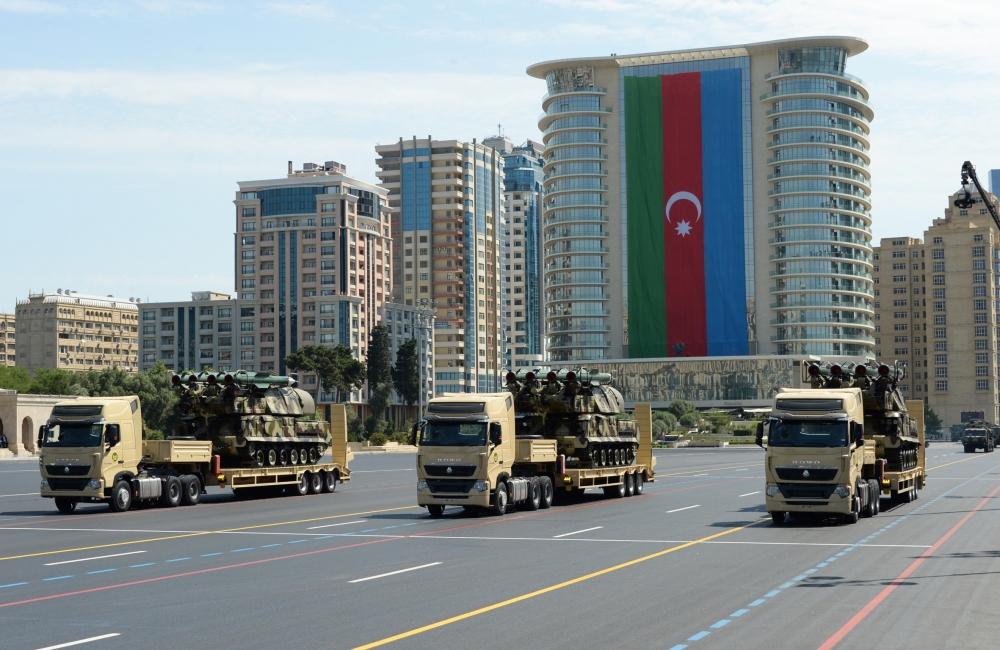
The people of Azerbaijan have for centuries fought for liberty and statehood along with its ancient and complicated history. Because of rich natural resources and strategic geopolitical position our motherland has always undergone pressures and military aggression by strong states. However, our people have protected its existence, heroically fought the strongest troops of enemies. Commanders and statesmen such as Javanshir, Babek, Shah Ismayil Khatai have created an entire chronicle of the history of the heroism of Azerbaijan. Glorious life and actions of such heroes have strengthened love of people for the homeland, liberty and statehood, changing it to the most important goal of our life. Valuable traditions started by them were successfully continued during centuries, including the last one.
After the collapse of the czarist Russia in 1918, the first democratic republic in the East – the People’s Republic of Azerbaijan was created. During its 23-month existence, the Republic founded all attributes of independent state, including the national army. Fighting the occupant policy of Armenians and Bolsheviks the government of the Republic declared the martial law in the territory of Azerbaijan on June 19, 1918. The decision was made on June 26 on the creation of the military corps with the status of division and cornerstone of the national army in Azerbaijan was laid. In 1918-1920, national army units with high-level military training and discipline were formed under the leadership of our outstanding generals such as Semed bey Mehmandarov, Aliaga Shykhlinski. Formation of the National Army of Azerbaijan began by decree of June 26, 1918. The Military Ministry of the Republic was founded on August 1. Talented general Semed bey Mehmandarov and lieutenant-general Aliaga Shykhlinski were appointed on December 25 military minister and deputy minister respectively. For a short time, the National Army, together with Caucasus Islam Army of the Ottoman State, saved Baku and nearby provinces of occupation of Armenians and Bolsheviks. These military units were distinguished in suppressing rebellions against the national government in Mugan and Esgeran completely destroyed the Armenian regular army units breaking the Azerbaijan frontier in Gazakh. At the time, the Azerbaijan army consisted of talented generals as Huseynkhan Nakhchyvanski, Ibrahim aga Usubov, Hamid Gaytabashy, Kazim Gachar, Javad bey Shykhlinski, Habib bey Selimov.
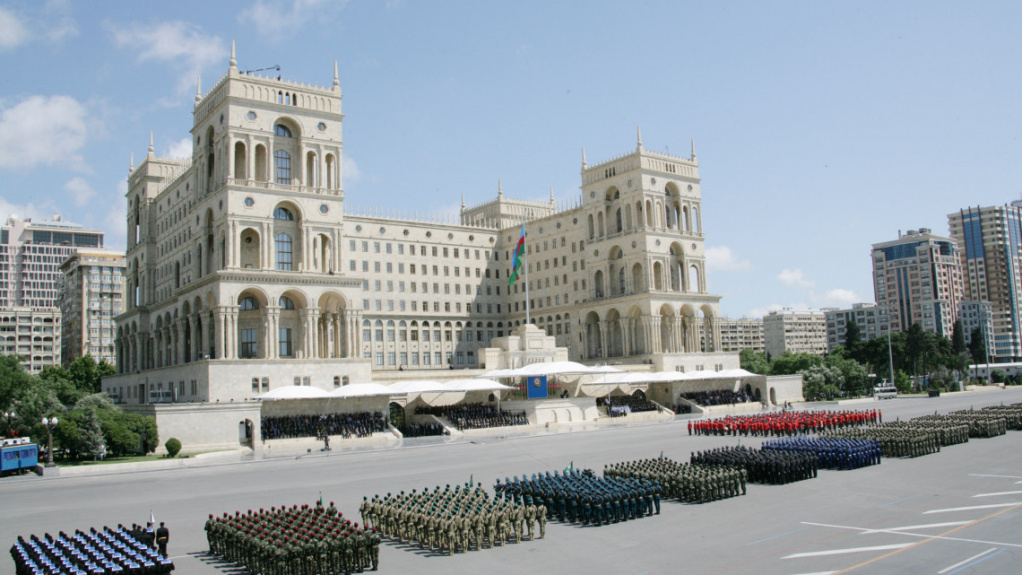
Law ‘On founding the Frontier Defence of the Republic of Azerbaijan in connection with customs’ was adopted in the session of Azerbaijan parliament held on August 8, 1919. Article 1 of the 8-article law envisaged: ’ Ninety-nine (99) frontier posts consisted of nine hundred and ninety-two (992) guards shall be founded according to the added dislocation points along frontiers of Azerbaijan to protect frontiers of the Republic of Azerbaijan from illegal trade and fight to smuggle…’
Unfortunately, the national army units – one of the most important attributes of independence were abolished after Azerbaijan was occupied by the Bolshevik Russian army. While Azerbaijan existed within the Soviet Union, the Union’s leadership always created artificial obstacles purposefully to the formation of national officer corps, promotion of Azerbaijanis in high military offices.
But all those obstacles did not shake military traditions and battle spirit of Azerbaijanis. WWII proved this truth once again. Devoted to its rich military and historical traditions the people of Azerbaijan showed real heroism in this war, Azerbaijan divisions traversed a glorious path of battle from the Caucasus to Berlin. Heroes of Azerbaijan as Hazi Aslanov, Mehdi Huseynzade, Ziya Bunyadov, Israfil Mammadov, Geray Asadov, Melik Maharramov displayed courage and heroism in this war and due to their heroism, glorious military traditions of Azerbaijan were successfully continued in XX century too.
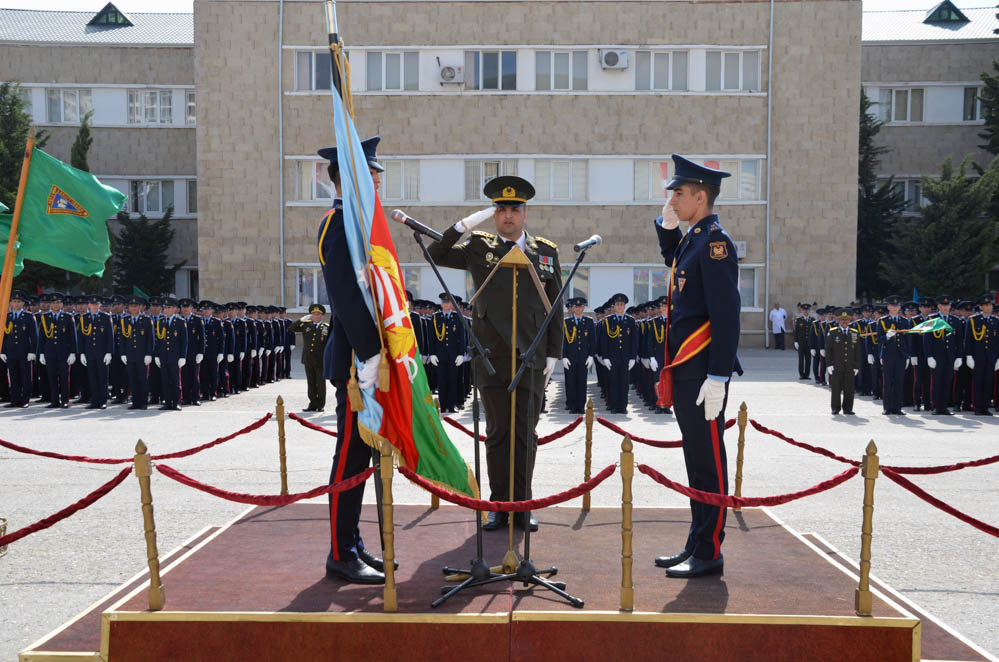
After the war till 1969 the Union leadership was still jealous about military personnel training in Azerbaijan. Only during the leadership of national leader Heydar Aliyev in the republic formation of an army, training of national officers was on the agenda. In 1971, due to big efforts, Heydar Aliyev achieved the creation of the school preparing military personnel in Azerbaijan – military lyceum named after prominent commander Jemshid Nakhchyvanski. At the time, Azerbaijan used to send about 60.000 youth to the army yearly, however majority of them were included in building divisions. There were a few Azerbaijani officers in military units. So, the opening of such a military school in Baku was of huge significance.
Heydar Aliyev achieved admission of Azerbaijani youth to the Baku High United Command and Baku High Navy schools, also other military schools in USSR on preferential terms. So, 20 years before Azerbaijan gained independence national leader Heydar Aliyev provided the high-level basis for training of the national military personnel. After the independence was gained this military school was indeed the basic support to the formation of the national army.

Despite the decision on the establishment of the Ministry of Defense on September 5, 1991, after Azerbaijan regained its independence and the law on the establishment of the Armed Forces by the Supreme Council of the Republic of Azerbaijan on October 9, 1991, the leadership of the Republic did not make any effort to implement these decisions. The protection of lands remained only in the hope of voluntary detachments operating in retail. There were also separate uncontrollable armed groups serving personal interests. All this was put to an end only after national leader Heydar Aliyev came to power again in 1993. As the Supreme Commander-in-chief of the Armed Forces, Heydar Aliyev also managed to recover in the military sphere. Having eliminated armed formations operating under the guise of local self-defense and volunteer battalions, he created an army of order organized in a unified command system. The fact that the Supreme Commander-in-chief visited the front line and met our fighters in the trenches and inspired them to fight gave real results. It was not long ago that a successful military operation was carried out against the enemy in the direction of Horadiz settlement of Fuzuli region in early 1994. After the ceasefire was declared on May 12, 1994, the process of building a regular and modern army in Azerbaijan started with great confidence. Regular army building began to take shape in the country.
Based on the principle of succession, June 26 is celebrated as the day of the Armed Forces by the order of national leader Heydar Aliyev dated May 22, 1998.
The process of Army building in independent Azerbaijan entered a completely new stage during the reign of President Ilham Aliyev. Thanks to the attention and care of the president, Supreme Commander-in-Chief Ilham Aliyev, who successfully continued and developed the policy of Army building of the Great Leader, the professionalism of the servicemen increased, the fighting spirit and morale and psychological training of the personnel, the supply of the Armed Forces with the most modern weapons and equipment was always at the forefront. It was thanks to the attention and care of President Ilham Aliyev that the Azerbaijani armed forces became the most powerful army in the region in a short time. Not surprisingly, in a report prepared by the authoritative center Global Fire Power based on 55 indicators, the Azerbaijani army participates in the world’s first army in the South Caucasus.
By the Order of President Ilham Aliyev, the military industry has also been established in Azerbaijan. More than a thousand military products are produced in Azerbaijan. Azerbaijan’s military products are demonstrated at the world’s leading international exhibitions.
The military power of the Azerbaijani army was demonstrated at the military parade held on June 26, 2011, in Baku on the occasion of the Armed Forces Day and the 20th anniversary of the restoration of independence with the participation of the Supreme Commander-in-chief of the Armed Forces, President Ilham Aliyev.
Our brave Army once again proved its strength in April 2016. In response to the provocations of the Armenian army on April 2, the Azerbaijani army defeated the enemy in a rapid counter-attack operation, freeing more than 2,000 hectares of the occupied territories of Fuzuli, Jabrayil, and Tartar districts. Also, thousands of hectares of land were passed to full control of the Azerbaijani army. With the four-day April battles, the Azerbaijani army once again gave our people the joy of victory.
Another success of the Azerbaijani army was achieved with the victory of Gunnut two years after the April battles — in May 2018. As a result of this successful operation, more than 11 thousand hectares of the territory of the Nakhchivan Autonomous Republic and Gunnut village of Sharur region were liberated from the enemy and favorable positions were taken under the control of the Azerbaijani army along the state border. Thus, the operation of moving the front line of the National Army’s defensive line to favorable positions along the state border was successfully concluded and the goal was achieved.
Having bravely prevented the provocations committed by the enemy in the direction of the Tovuz region in July 2020, the brave Azerbaijani army soon gave our people the joy of the most glorious victory in its history. In the Patriotic War, which began on September 27, 2020, the Glorious Victory, won by the President of the Azerbaijan Army İlham Aliyev Supreme Commander-in-Chief, established important traces not only in the history of Azerbaijan but also in the history of world military science.
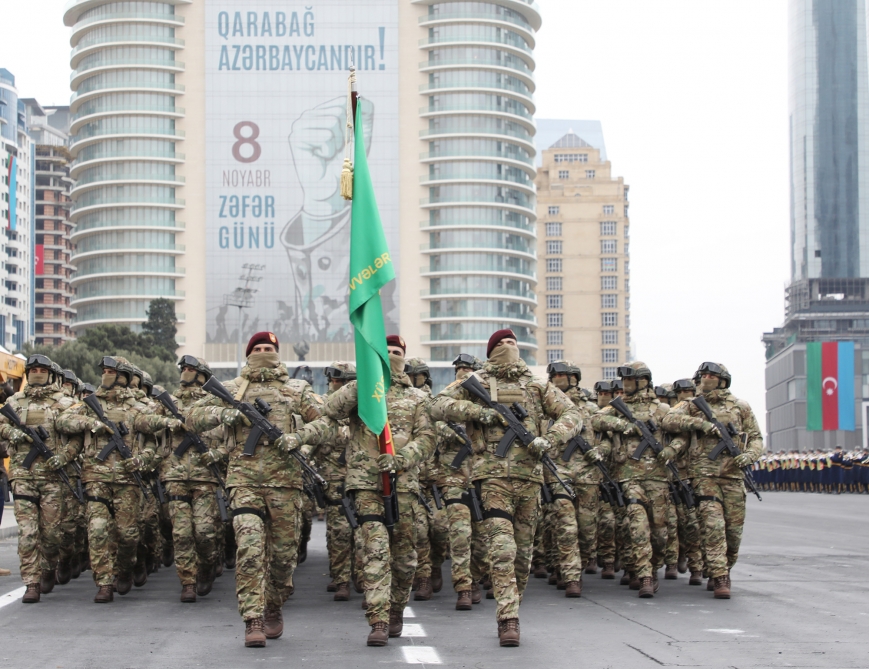
The Azerbaijani army, which is constantly ready to order the liberation of our lands, began a large-scale counteroffensive operation-The patriotic war by order of the president, the victorious commander-in-chief. The Azerbaijani army, without retreating a single step, dealt a crushing blow to the enemy and in 44 days — until November 9 — liberated 5 cities, 4 villages, and up to 300 villages from occupation. The war, which resulted in the complete defeat of the enemy, ended on November 10 when the Azerbaijani President, the Prime Minister of Armenia, and the Russian President signed a statement on the complete cessation of fire and all military operations in the conflict zone. According to the statement, Aghdam, on November 20, Kalbajar and Lachin districts were handed over to Azerbaijan on November 25.
In honor of the glorious Victory on December 10, Baku hosted the solemn Victory Parade with the participation of Azerbaijani President İlham Aliyev and Turkish President Recep Tayyip Erdogan. Along with modern weapons and equipment owned by the Armed Forces of Azerbaijan, weapons and military equipment destroyed or seized as loot was demonstrated at the parade.
In order to promote the Great Victory in the glorious Patriotic War, the Military Loot Park, which was established in Baku, displays weapons, equipment, and combat flags taken from the enemy, reflecting the Azerbaijan Army’s impressive success over the enemy. At present, the Azerbaijani state successfully continues international military cooperation, which meets national and state interests, benefiting from the new geostrategic and geopolitical trends created in its region. Military analytical centers of the world analyze the victory of the Azerbaijani Armed Forces in the 44-Day War, defense structures of many states study the combat experience gained by our army in war and earn on military tactics.
Azerbaijan, located in such a complex geopolitical region as the South Caucasus, and at the intersection of the interests of various states, carries out international military relations within the framework of mutual interests with the military structures of foreign states and international organizations. International military cooperation is carried out in connection with the Ministry of Foreign Affairs and other relevant state bodies, departments, organizations, and enterprises, on the basis of military doctrine and “concept of international military cooperation of the Ministry of Defense of the Republic of Azerbaijan” by the Ministry of Defense.
The goals and directions of international military cooperation are determined in accordance with the national interests of the Republic of Azerbaijan.
One-sided, bilateral, and multilateral cooperation with foreign countries, Euro-Atlantic structures, international organizations, and leading countries’ defense industry sectors is one of the main directions of the international military strategy. Azerbaijan, along with Turkey, Georgia, Russia, Ukraine, Belarus, USA, UK, Pakistan, Israel, etc. military, military-technical and military-political cooperation with the countries.
In the international military relations of our country, cooperation with Turkey, Russia, Pakistan, the İsrail states, the NATO bloc is of particular importance.
Azerbaijan’s most important military partner is the brotherly Republic of Turkey. Military cooperation between Azerbaijan and Turkey is of great importance not only in terms of strengthening the Armed Forces of Azerbaijan but also in terms of ensuring peace and security in the region as a whole. Analysis of the new geopolitical landscape of the South Caucasus with the victory of the Azerbaijani army in the 44-Day War reveals the role and importance of military cooperation between the two brotherly and friendly states.

The “agreement on strategic partnership and mutual assistance between the Republic of Azerbaijan and the Republic of Turkey” signed on September 15, 2010, laid the foundation of a new stage in the development of Azerbaijan-Turkey military relations. With this agreement, a High-Level Strategic Cooperation Council of Azerbaijan and Turkey was established. According to article 2 of the treaty, when one of the parties is subjected to an armed attack or military aggression by a third State or group of States, the parties, including the use of military capabilities and abilities to exercise the right of private or collective self-defense recognized by Article 51 of the Charter of the United Nations, will provide mutual assistance to each other with a view to taking all necessary measures within the limits of available capabilities. In fact, this document can be regarded as a military alliance agreement between the two fraternal countries. The historical visits of Azerbaijani President Ilham Aliyev and Turkish President Recep Tayyip Erdogan to the city of Shusha on June 15, 2021, and the Shusha declaration signed here are of great importance in terms of increasing the military power of Azerbaijan. The Shusha declaration reveals the importance of Turkey’s military involvement in ensuring a strategic balance of power and security in the South Caucasus. The new priorities of military cooperation are the raising of military relations between Azerbaijan and Turkey to the level of cooperation, the establishment of political and legal ties, the holding of joint meetings of security councils of Azerbaijan and Turkey with the Shusha declaration. At official meetings and speeches, President of Azerbaijan İlham Aliyev stressed the importance of further deepening the integration of the armed forces of the two fraternal countries for security and stability in the region, expressing the prospect of military cooperation between Azerbaijan and Turkey.
Cooperation in the planning of joint activities of the country’s armed forces, operations, as well as numerous joint exercises is important area of unity and cooperation. Relations of great importance in the field of the defense industry are also one of the main directions of military cooperation between Azerbaijan and Turkey. Speaking about cooperation in the defense industry, the importance of the Bayraktar UAV produced by the Turkish military industry in the victory of the Azerbaijan Army during the Second Karabakh War should be emphasized. Azerbaijan’s introduction of cooperation methods with Turkey as a joint production in the defense industry is a promising military cooperation project.
Azerbaijan also contributes to the establishment of international peace and security in the framework of cooperation with NATO. In this direction, the professionalism of Azerbaijani servicemen in peacekeeping operations should be especially emphasized. The peacekeeping contingent of the Azerbaijani army has been involved in peacekeeping operations since 1999.
Azerbaijan’s most important area of cooperation with NATO is within the framework of the Partnership for Peace program. Every year, within the framework of this program, officers of the Azerbaijani Armed Forces participate in up to 500 training and seminars. At present, the “Partnership for Peace” Center under the training center of the Ministry of Defense of Azerbaijan is functioning. It should also be noted that since 2003, NATO has been involved in the financing of the summer school in Baku. From year to year, the scope of programs expanded and as a result, NATO International School was established in Azerbaijan in 2005.
Azerbaijan, which implements the measures envisaged in the framework of the Plan of Operations for Individual Partnership with NATO, the Planning and Analysis Process, also has serious ties with Russia in the military sphere. Russia has a special place among the countries where the Azerbaijani army cooperates extensively in terms of supplies of military equipment and weapons. The participation of Russian peacekeepers in Karabakh in order to establish security and stability in the South Caucasus after the victory of the Azerbaijani army in the II Karabakh war constitutes a new stage in military-political relations between the two countries.
One of the important partners of Azerbaijan in military and foreign policy is the Islamic Republic of Pakistan. Pakistan always supports us in the international arena and openly declares that it always stands by Azerbaijan. The « plan of bilateral military cooperation » signed between the Ministry of Defense of the Republic of Azerbaijan and the Joint Staff of the Islamic Republic of Pakistan also creates the effect of the military alliance between the two countries.
Military cooperation with the state of Israel occupies an important place in the international military strategy of Azerbaijan. In recent years, military cooperation with this country has been developing dynamically. Azerbaijan buys modern UAVs, radars, missile systems, and coast guard vehicles from Israeli defense industry companies.
At present, the Republic of Azerbaijan sets out the development of military infrastructure in accordance with international standards as a necessary condition in order to have a stronger military potential and maintain bilateral, trilateral, and multilateral military cooperation with the world’s leading states and international military organizations.

